

Driving to Spain from UK: Best Routes & Driving Tips
This post may contain affiliate links, from which we earn an income.
The Best Routes to Spain from the United Kingdom
Are you desperate for some Spanish sun but don’t want to fly? With great routes across Europe, it’s easy to drive to Spain from UK by car, arriving refreshed and unstressed from the comfort of your own vehicle.
As Brits travelling in Europe, we’ve driven to Spain numerous times; in a car, motorhome and on a motorbike. We’re sharing the best routes with costs and comparisons plus tips about driving once you’re there. Our Spain from UK guide will help you decide which is the best route for your driving trip to Spain, so you can get there relaxed and ready to go!
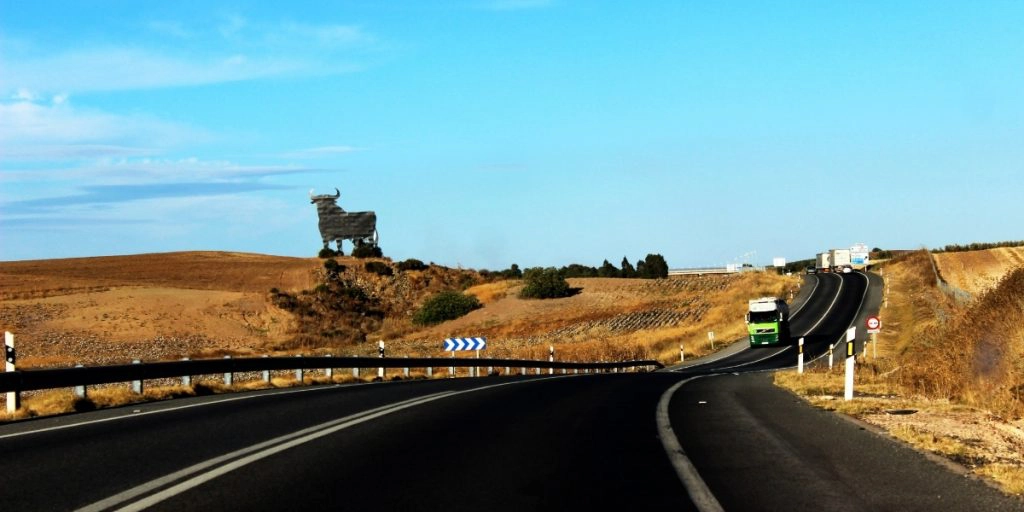
Summary of the best routes to Spain from UK
- The quickest route is Calais – Rouen – Le Mans – Tours – Bordeaux – Irun
- The most scenic route is Calais – Paris – Orleans – Clermont-Ferrand – Millau – Beziers – Perpignan – Barcelona
- The cheapest route is Calais – Rouen – Chartres – Poitiers – Angouleme – Bordeaux – Irun . Don’t forget to set your sat nav to avoid tolls .
- The alternative route is Calais – Rouen – Le Mans – Tours – Bordeaux – Somport Tunnel – Zaragoza
- The ferry route is Portsmouth – Santander Book it here!
Crossing the Channel
Eurotunnel le shuttle.
The fastest channel crossing route is using the Eurotunnel Le Shuttle from Folkstone to Calais. The crossing under the channel takes 35 minutes, and with a slick check-in and loading/unloading process, you can be in France proper in an hour.
This crossing is ideal if you are driving to Spain from UK with a dog or just want to get to the other side as quickly as possible.
Dover to Calais
The quickest way by ferry is undoubtedly the Dover-Calais route, on which both P&O and DFDS operate up to 40 crossings between them a day in July and August. Taking just an hour and a half, you’ll have time on board for a meal or drink and perhaps a quick snooze.
Getting on and off can take a while though, as they have to piece all the vehicles together like a jigsaw puzzle. Not as quick as the shuttle, but very possibly a bit cheaper, especially if you can be flexible with crossing times.
Portsmouth to Caen / Cherbourg
More expensive and quite a bit longer than the Dover-Calais route, the Brittany Ferries crossings from Portsmouth may prove to be cost-effective in fuel and toll costs if you don’t live in the southeast of England.
The Caen route operates three crossings a day, one of them overnight, meaning you’ll arrive in France refreshed (but will have to book a cabin or reclining seat) and ready for a full day’s driving.
The Cherbourg route crosses at least 12 times a week and uses a fast catamaran service, taking just three hours port to port.
Other Popular Crossings
There are a handful of other routes out of Newhaven, Folkestone and Poole which are also worth exploring. You could also consider sailing to Le Havre or St Malo from Portsmouth or Dunkirk from Dover.
The key here is to be flexible with dates and times to get the best deals…this is where you may just find a bargain.
England to Spain
One of the simplest ways of getting to Spain is to miss France altogether and get a ferry crossing to Spain from UK, sailing from Portsmouth or Plymouth to Santander or Bilbao in northern Spain.
The catch is that the UK to Spain ferry crossings take a long 33 hours and you’ll need to spend a night (or two in winter) onboard. The boat gets booked up quickly and can be expensive, even taking into account the costs of tolls and fuel prices in France.
The long journey is also notoriously rough in the winter months, so you may want to find ways of avoiding seasickness if you choose this route!
However, if you don’t enjoy driving in Europe , have a pet with you or just want to take things a little more slowly, then taking a boat from UK to Spain may well be the best option.
Is this your first time visiting France and Spain? Get all the information you need in our France Travel Guide and Spain Travel Guide including what to pack, the best time of year to go, getting there and practical tips to help you have the best trip!
The Best Routes Through France to Spain
Uk to spain driving routes map.
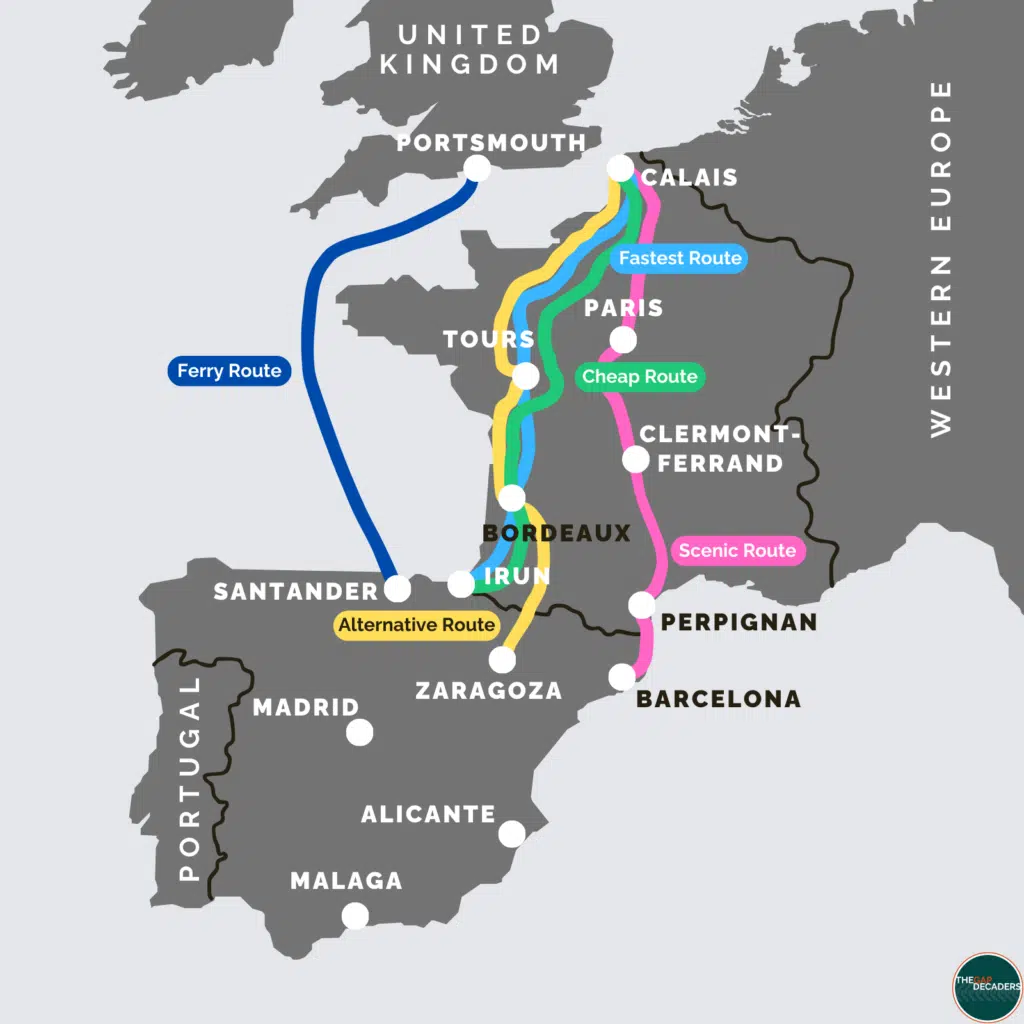
The Quickest Route
All routes assume travel from Calais to Spain in a 2.5l diesel car. Costs updated November 2023. Find your car’s toll costs and fuel consumption here .
Calais – Rouen – Le Mans – Tours – Bordeaux – Irun
- Distance: 1059km
- Driving Time: 10 hours 40 minutes
- Toll Costs: €94
- Fuel Costs: €113
Whether you cross into Calais, Caen or Cherbourg, the quickest road to Spain is down the western side of the country via the A28 and A10. You’ll miss the major high ground in the middle of France and be able to travel on autoroutes pretty much all the way.
From Calais, head for Rouen, then Le Mans, Tour, Bordeaux and down to the border at Irun. For those arriving in Caen or Cherbourg, head for Le Mans and pick up the remainder of the route there.
You could barrel all the way down to the Spanish border in a day if you were sharing the driving, but we would suggest an overnight stay in Tours if coming from Calais before a second stop in San Sebastian in Spain. If coming from Caen or Cherbourg, Bordeaux makes a perfect stopover. If coming from Caen or Cherbourg, Bordeaux makes a perfect stopover.
Be aware that if you take the route shown on our Google Map, you will need a Crit’ Air sticker, as the whole of Rouen is covered by a low-emission zone. There are also several low underpasses on the route which will decapitate a motorhome or car with bikes on the roof. You can avoid these by taking the street-level side road next to them, just be aware!
RELATED POST: 19 Helpful Long Distance Driving Tips
Make sure you have travel insurance you can trust when visiting France and Spain . We recommend True Traveller for their 5-star TrustPilot reviews, variety of cover options, best activities cover as standard, great prices, and excellent service.
The Most Scenic Route
Calais – paris – orleans – clermont-ferrand – millau – beziers – perpignan – barcelona.
- Distance: 1321km
- Driving Time: 12 hours 40 minutes
- Toll Costs: €91
- Fuel Costs: €142
Driving from UK to Spain by car doesn’t have to be boring. This great route will take you through some of France’s most spectacular scenery and across the Massif Central via the A71 and A75 roads.
From all the ports, head for the Paris ring road and follow your sat nav judiciously…you really don’t want to end up in inner-city Paris! Perhaps stop off, find a good hotel and take in one of the most beautiful cities in the world before heading south.
Next up is Orleans on the banks of the Loire River and home to Joan of Arc. From here, head south Clermond-Ferrand, surrounded by dramatic extinct volcanoes and authentic French countryside villages, perfect for a few days hiking before you hit the road again.
Make for Millau and cross the highest road bridge in the world en route, the incredible Millau Viaduct.
Your next stop is Beziers, home to the Canal Du Midi and its’ famous nine locks. This often-overlooked city makes a great pit stop.
Finally, you’ll reach pretty Perpignan where you can enjoy the last of France before crossing the border into the north of Spain and driving to Barcelona, the perfect city in which to stop for a day.
You will be able to find great hotels in all these destinations, allowing you to enjoy a slower pace and see some off-the-beaten-track France .
Perhaps take the scenic route to Spain and take the fast route for the return journey, when you’ll be looking forward to getting home.
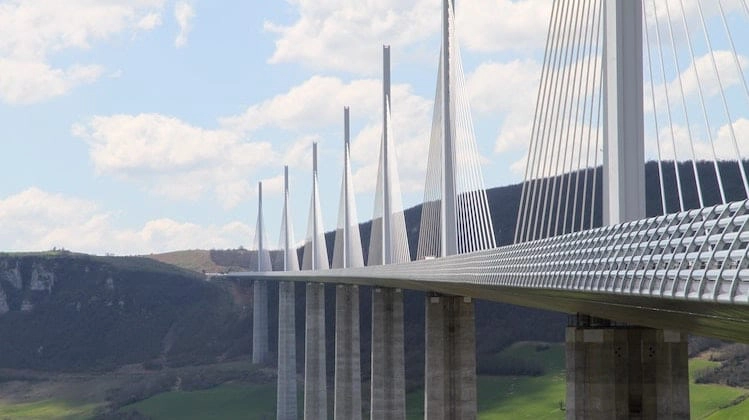
The Cheapest Route
Calais – rouen – chartres – poitiers – angouleme – bordeaux – irun.
- Distance: 1060km
- Driving Time: 15 hours 10 minutes
- Toll Costs: €0
- Fuel Costs: €122
Driving to Spain from UK avoiding tolls is very possible. You will still travel down the western side of the country, with the route relying heavily on the A28, N10 and A63 toll free roads. Make sure to set your sat nav to avoid tolls .
Although this is a good route for those travelling on a budget, not all stretches are dual carriageways and you risk slow-moving vehicles, and traffic jams, especially on the approach to larger cities. This choice of route is likely to take longer than the stated 15 hours.
Be aware that if you take the route shown on our Google Map, you will need a Crit’ Air sticker , as the whole of Rouen is covered by a low-emission zone. There are also several low underpasses on the route which will decapitate a motorhome or car with bikes on the roof. You can avoid these by taking the street-level side road next to them, just be aware!
RELATED POST: Road Trip on a Budget: 36 Tips to Save Money in Europe
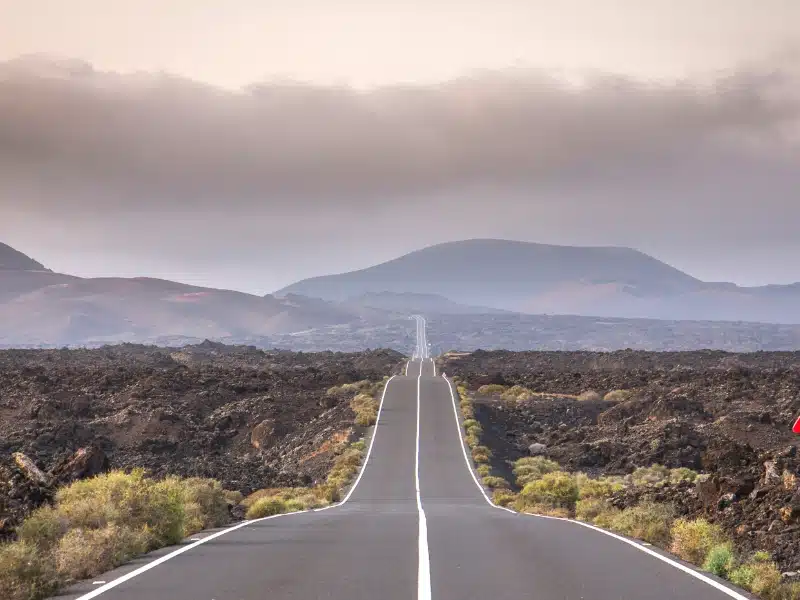
The Alternative Route
Calais – Rouen – Le Mans – Tours – Bordeaux – Somport Tunnel – Zaragoza
- Distance: 1261km
- Driving Time: 17 hours 30 minutes
- Fuel Costs: €145
Using the fast A28, N10 routes south before veering east at Bayonne for the Túnel de Somport cuts out the border at Irun and the long drive down to Zaragoza. This alternative route works well if you’re heading for Spain’s east coast, the capital city of Madrid or the south of Spain.
Unbelievably, the 5.3km of the tunnel is toll free, although this route can be affected by bad weather in winter and carrying snow chains is a must.
Looking for the best SIM card deals in Europe for your trip? Check out our guide to the best data SIMs in Europe and get the best deal for your trip to France and Spain.
Visiting France & Spain
Thankfully, there are some common laws and regulations across most European countries for visitors from the UK and elsewhere. Make sure to carry the correct documentation and understand EU driving rules.
- You must have at least three months remaining on your passport (issued in the past ten years) at your intended date of departure.
- You must have at least 3rd party insurance for your vehicle. Update August 2021 – you no longer require a green card to prove you have vehicle insurance cover when travelling in Europe.
- From 28th September 2021, you will have to display a UK sticker on the rear of your vehicle, instead of a GB sticker, unless you have a new style UK numberplate which displays the Union Jack flag.
- You must have a valid UK licence. This allows you to drive in all EU countries for up to six months. If you only have a paper driving licence or a licence issued in Gibraltar, Guernsey, Jersey or the Isle of Man then you will need an International Driving Permit .
- Headlight beam converters must be in use unless you can adjust your headlights automatically.
- Seat belts must be worn by the driver and all passengers in all the countries of the EU.
- It is illegal in all countries of the EU to use a mobile phone when driving. In addition, in France, you are not even allowed to use a mobile phone using a hands-free device, which you are permitted to do in Spain and the UK. On the spot fines are applicable in all countries if you are caught using a phone at the wheel.
- Every EU country apart from Ireland drives on the right-hand side of the road. This means that when you’re at a junction or roundabout, the vehicle approaching from the right has priority over the one coming from the left unless other signage is in place.
- Both France and Spain are members of the Schengen Area, meaning borders between both countries are open. However, you may find that random roadside checks are in place at border crossings due to the number of undocumented migrants travelling through Europe. Make sure to have your passports to hand when approaching country borders.
- If you have an accident you’ll need to complete the EU Accident Statement, which you can find to download in English in our free resource library if your insurer hasn’t provided one. Stop safely and use your hazard lights and warning triangle to alert other drivers. Exchange details (a translate app comes in handy here) and take lots of photos to add to your form when you submit it to the insurers. If the other party won’t give details or there has been an injury, you should call the police on 112.
RELATED POST: Driving in Europe – Everything You Need to Know
Driving in France
Driving from UK to France and through the country is easy, with well-maintained roads and generally considerate and well-mannered drivers.
On the downside, France is one of the most expensive countries in which to drive and travel in Europe due to the high fuel costs and expensive tolls, especially if you’re travelling in a larger vehicle like a motorhome .
There are also regular disruptions and fuel blockades due to political tensions, so make sure you check the current situation when you leave home.
Follow these tips for a safe and easy transit through France on your road trip to Spain from England.
- In recent years there has been a significant increase in speeding fines issued by French authorities to British citizens. Many get home from a holiday or road trip to a nasty surprise in the post. Be aware and stick to the speed limit when driving in France.
- You must carry at least one reflective jacket within the passenger compartment of your vehicle and must put it on before you get out in an emergency or breakdown situation You must also carry a warning triangle.
- France has very strict drink driving laws compared to the UK. The UK maximum legal limit is 0.8 mg/ml and the French maximum is 0.5 mg/ml of alcohol per litre in your blood. If you are tested and found to be over the limit, you may face up to 4,500 euro fine and have to appear in court, and possibly even be given a prison sentence.
- From 1st January 2021, all vehicles over 3,500kg are required to display infographic ‘angles morts’ or blind spot stickers . Stickers must be visible on both sides and at the back of the vehicle and must be placed between 0.90m and 1.50m above the ground. Stickers must be placed in such a way that they don’t cover the vehicle’s regulatory plates and inscriptions, or any of the lights or signals, and don’t hinder the driver’s field of view. Find out more about motorhome driving in France here .
- As of January 2013 the French government announced that the introduction of an €11 fine for not carrying a breathalyser/alcohol test had been postponed indefinitely. However, the law still states that drivers must have an alcotest ready for use in their vehicle even though no penalty will be imposed if they cannot present one during a police road check.
Mountain Law in France
On 1 November 2021 the Loi Montage II or ‘mountain law II’ came into force in 48 French mountainous departments within the Alpes, Massif Central, Jura, Pyrenees, and Vosges regions.
Anyone travelling in a vehicle through one of these areas between 1 November and 31 March will be obliged to fit four approved winter tyres or carry at least two snow chains or socks in the vehicle. You can find out more about France’s mountain law here .
Motorway Breakdowns in France
French motorways are privately managed and you’re not allowed to request your own assistance company to attend to you if you break down.
If you do break down, you should use the orange emergency telephones that are situated every 2km along French motorways to call the police or the official breakdown service operating in that area. Alternatively, if no orange telephone is available, you should call the emergency services by dialling 112.
You will be towed to a safe designated area where you can make onward arrangements for your own breakdown insurer to assist if you have it. Otherwise, the towing company will be able to provide support or signpost you.
Charges for assistance on a motorway are fixed by the government and are reviewed and revised each year. Many of the government-appointed towing services allow large insurers to pay them directly, but this is at their discretion and will depend on who your European breakdown cover is with.
If this is not the case, you should pay directly and then seek recompense from your insurer.
Motorway Tolls in France
Driving through France can be hideously expensive if you only use toll roads, but they do allow you to travel through the country to your destination quickly.
You may want to consider carrying an electronic toll tag, like EMovis or Bip&Drive (both of which cover you in Spain and Portugal as well as France) that deducts the fees from a credit card automatically, meaning you don’t have to stop at a booth or barrier.
Crit’Air Vignettes
France has introduced ‘clean air’ windscreen stickers as a legal requirement in many of its cities, towns and their peripheries, to identify a vehicle’s emissions levels and to restrict access in order to improve air quality.
This six-category sticker system is designed to identify what emissions vehicles produce, and are categorised based on your vehicle’s Euro emissions standard. These are known as Crit’Air stickers and you may need one for your vehicle, depending on where you visit or stop as you transit through.
If you intend to travel close to a city or use its ring road, it’s worth getting the sticker, which costs €4.61 from the official website. The transitional period during which violations will not be fined ends on 31st December 2023. Find out more and purchase Crit’Air stickers from the official certificat-air.gouv.fr website.
Don’t forget your road trip essentials! Our free road trip checklists help you remember everything, including road trip snacks , podcasts , and road trip songs for the journey!
Onward Travel in Spain
You’ve arrived! Spanish motorways and roads are typically well-maintained, and the drivers are considerate and relaxed.
Some of the best roads in Spain are in the interior, where you will have long stretches of sweeping Autopista (motorway) and Autovía (dual carriageway) to yourself. The trade-off is the Costas where traffic ramps up and tailbacks are frequent.
Depending on where you are heading, you’ll find a good network of Autopistas, with the AP7 from Barcelona enabling driving through Spain from north to south before heading west to Malaga, one of the warmest places in winter in Europe . From this road, you can head inland to Madrid or across to Portugal.
Alternatively, take one of the western routes from Irun or Santander and explore beautiful green Spain before dropping down into Portugal.
Spain Travel Inspiration
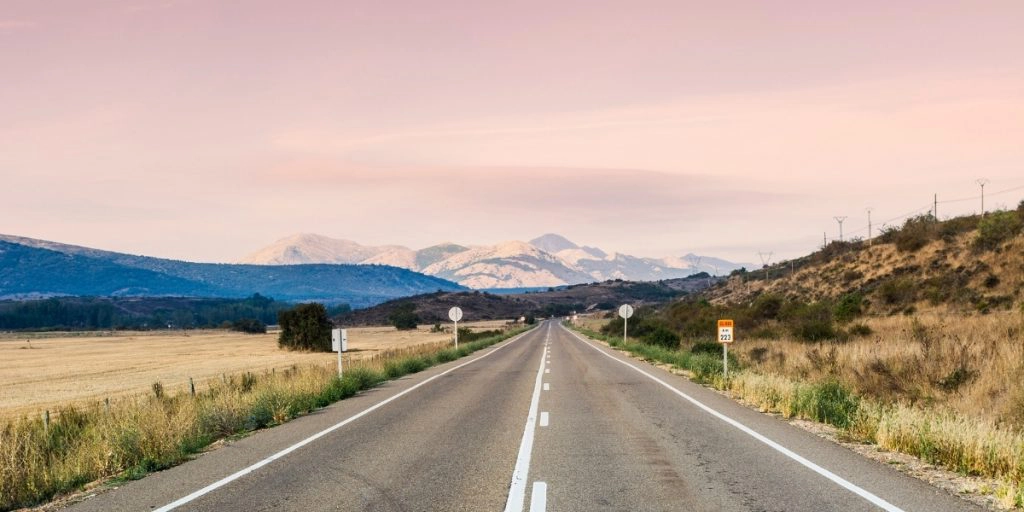
Spain Road Trip: 8 Amazing Routes for an Epic Trip
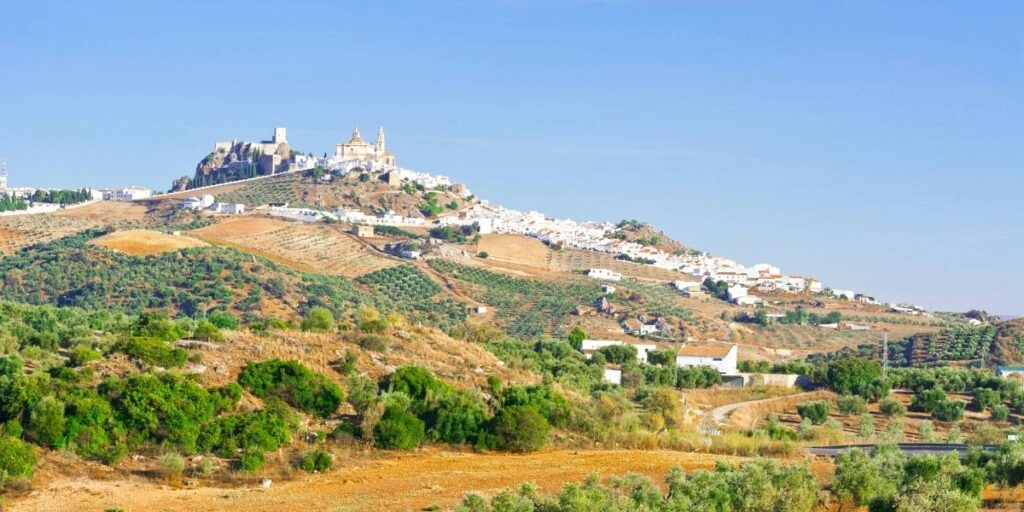
The Perfect Andalucia Road Trip: Itinerary, Map & Tips
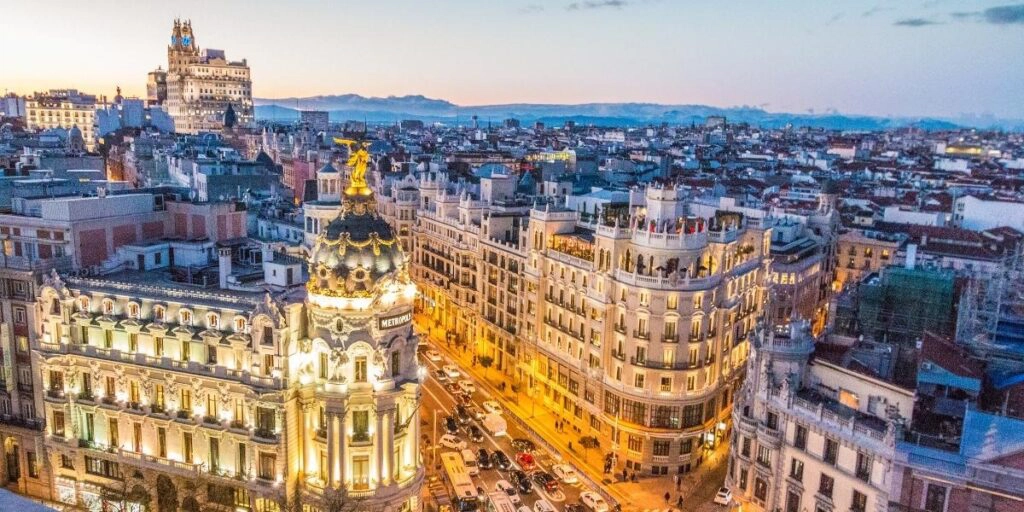
Madrid in One Day – Itinerary, Map, Tips & Guide
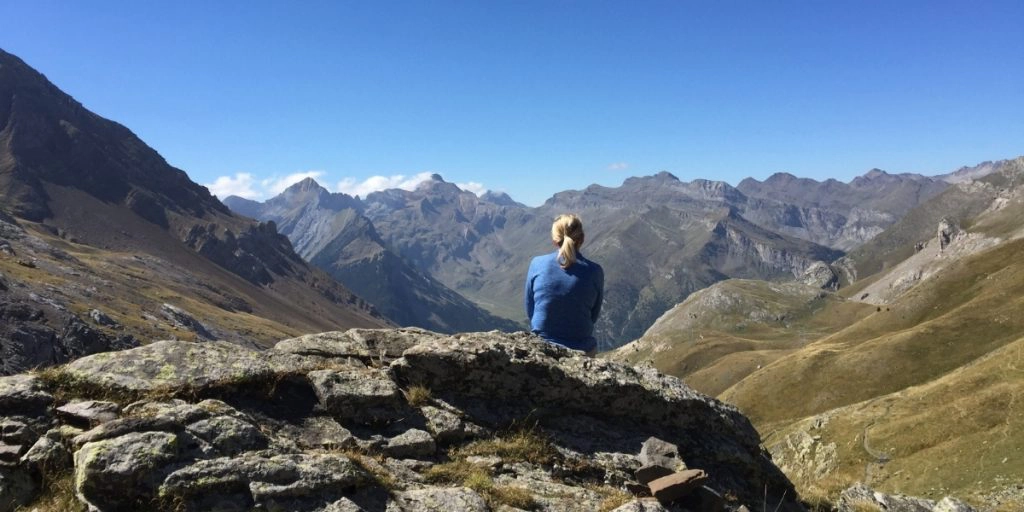
A Seven Day Pyrenees Hiking Tour

One Day in Barcelona – Itinerary, Map, Tips & Guide
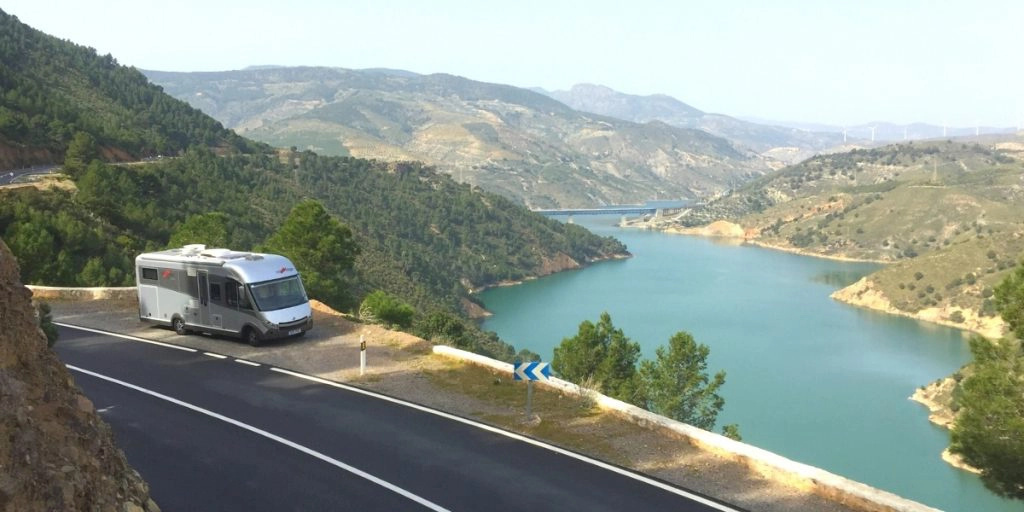
Motorhoming in Spain: Your Complete Guide for 2024
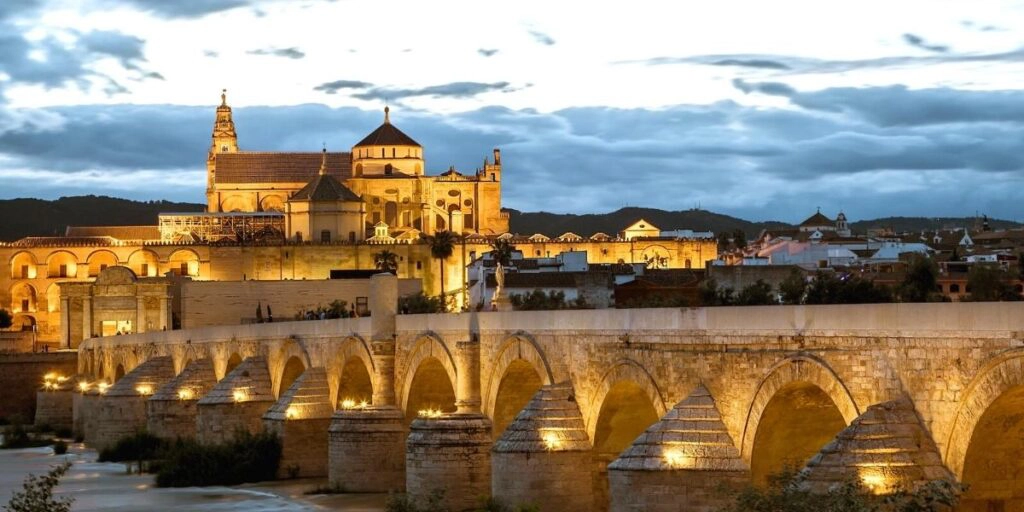
Cordoba in One Day – Itinerary, Map, Tips & Guide
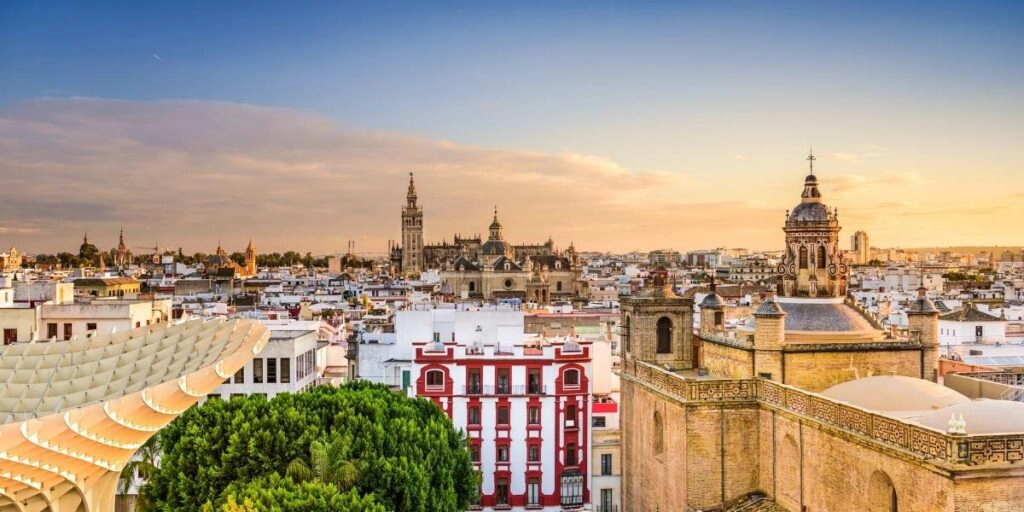
One Day in Seville – Itinerary, Map, Tips & Guide
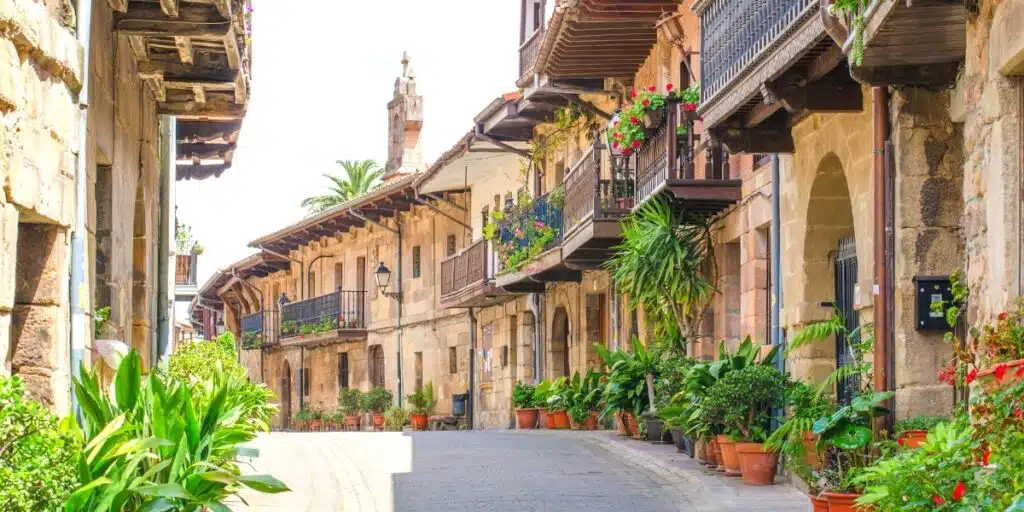
North Spain Road Trip: Itinerary, Route & Tips
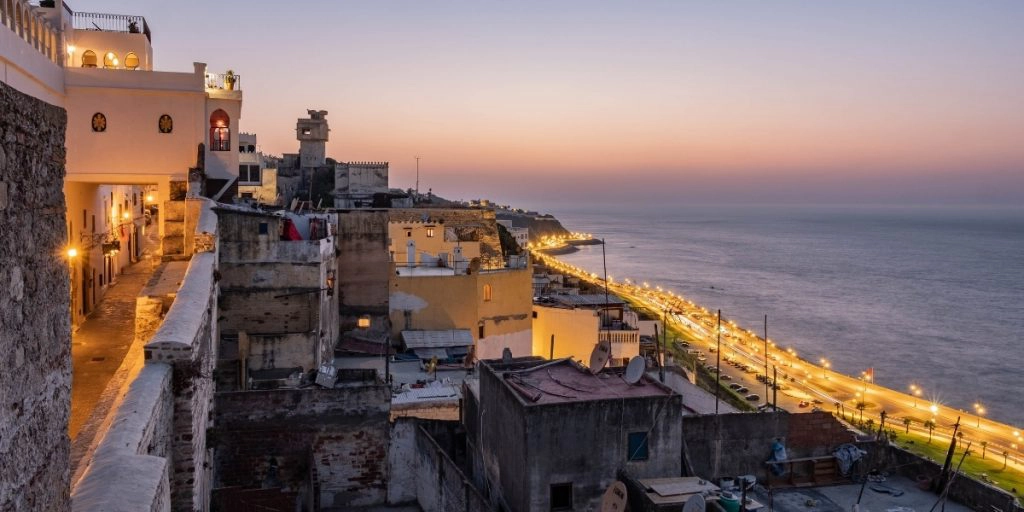
Tarifa to Tangier: Tips & Tricks for a Day Trip to Morocco
Driving in spain.
Follow our guide for safe driving in Spain and enjoy your holiday!
- You must carry two warning triangles for the front and rear. These warning triangles are now being phased out and from 1st July 2021, a new law requires that a V16 flashing emergency light is used, although both means of advising other traffic will be legal until the end of 2024.
- You must also carry reflective jackets for the driver and all passengers, a spare wheel and the tools to change a wheel or a tyre repair kit.
- You must carry a spare pair of spectacles if you wear glasses.
- The use of winter tyres in Spain is regional. Look out for traffic signs indicating that winter tyres or snow chains are compulsory where you are.
- Anything with a screen (television, video, DVD etc.) which could distract you when driving should be positioned where you can’t see it. This doesn’t apply to a sat nav but you must not touch or program your sat nav unless parked in a safe place.
- Using radar detection equipment is prohibited under Spanish law and new regulations from January 2021 mean that it will also be illegal to be in possession of such equipment.
- On roads with single carriageways in built-up areas the speed limit established may not be exceeded by more than 20 km/h when overtaking.
Toll Roads in Spain
Toll roads are pay-as-you-go and are very reasonably priced, with some charges being abolished by the Spanish Government in early 2020 and more in September 2021. These free motorways cover the eastern route south from Perpignan as far as Alicante. You can pay with cash or a credit card or use an electronic toll tag like Emovis or Bip&Drive .
Due to the huge swathes of nothingness in the interior, the toll roads are definitely worth taking if you are trekking from one side of Spain to the other. The AP7 on the Costa Blanca and Costa del Sol retains some charges, but they are minimal.
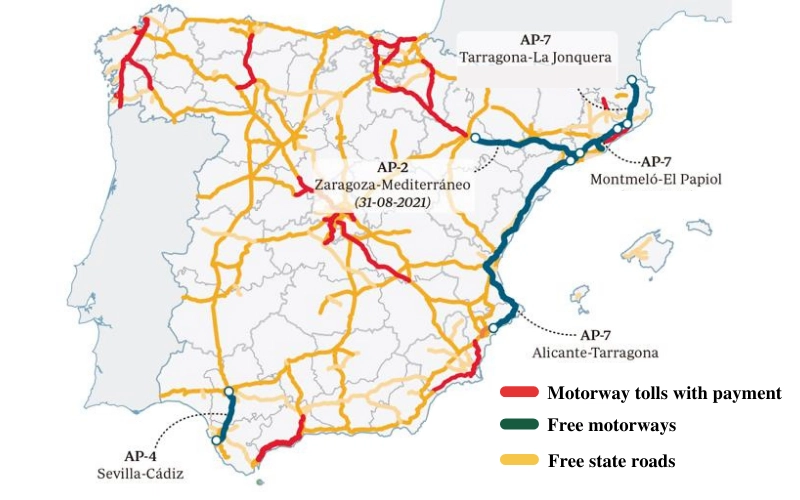
Low Emission Zones in Spain
At the start of 2023, there were 16 low emission zones in Spain and municipalities with more than 50,000 inhabitants have to implement a LEZ by the end of 2023.
Spanish registered cars will be registered and receive a sticker, but currently, foreign vehicles can’t buy stickers although they have to meet the required standards.
If you are stopped, you may be able to do this with your V5C, Certificate of Conformity or LEZ sticker from another country. The only exception is in Barcelona, where you will need to register your vehicle in order to drive within the LEZ here .
Driving to Spain FAQs
How long does it take to drive to spain.
It can take anywhere from around 11 hours to 17 hours to drive to Spain depending on which route you choose, the traffic conditions and your driving style.
Can you take your car from UK to Spain?
Yes, you can drive your own car from UK to Spain. You must have a driving license, and a minimum of third-party insurance and your car must be legally registered and taxed in the UK with a valid MOT.
How much does it cost to drive to Spain from UK?
You need to take into account the cost of the ferry or Eurotunnel, the cost of fuel, tolls and any additional cost for EU insurance for your vehicle. You may also want to factor in EU breakdown cover, overnight stops and food to eat along the way, as well as wear and tear on the car.
With the cheapest channel crossing and the most cost-effective route, plan to spend at least £300/€343 for a one-way road trip to Spain.
Is it cheaper to fly or drive to Spain?
If you can get a bargain low-season flight at 5am, don’t mind a seat at the back and don’t need to carry much more than a toothbrush, it might be cheaper to fly than drive to Spain. But we’ve noticed in this post-pandemic era that those flights are becoming less and less and often, driving seems a better option.
Can UK tourists drive in Spain?
Yes, UK tourists can drive in Spain for up to 6 months on their UK license. As you can only stay in Spain for 90 days before applying for residency, and only stay in the entire Schengen Area for up to 90 days in every rolling 180 days, it’s unlikely that you’ll reach the limit.
Are you looking for more road trip inspiration? Check out these top posts…
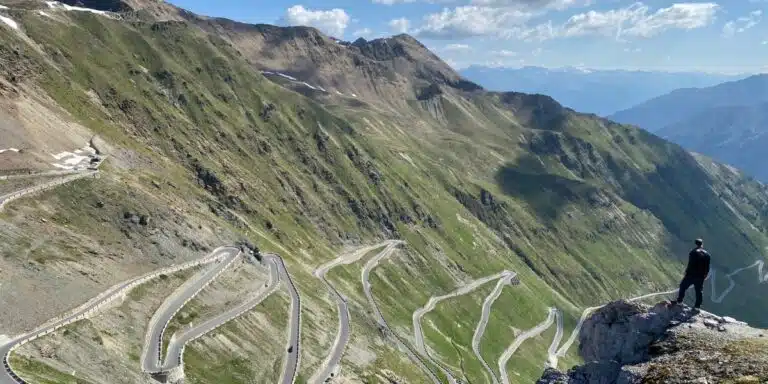
Stelvio Pass: The Best Mountain Road in Italy?
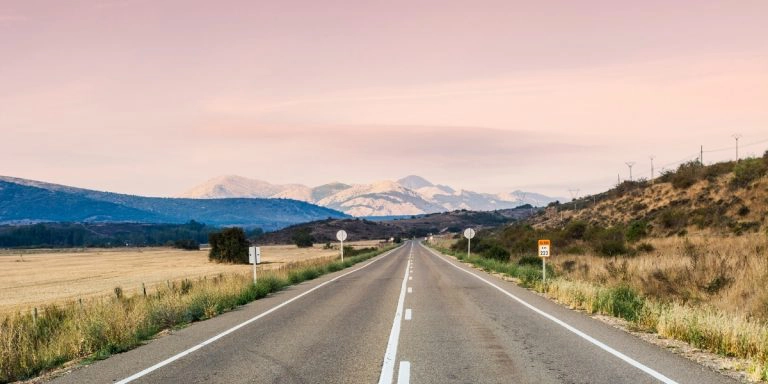
Croatia Road Trips: Five Incredible Routes
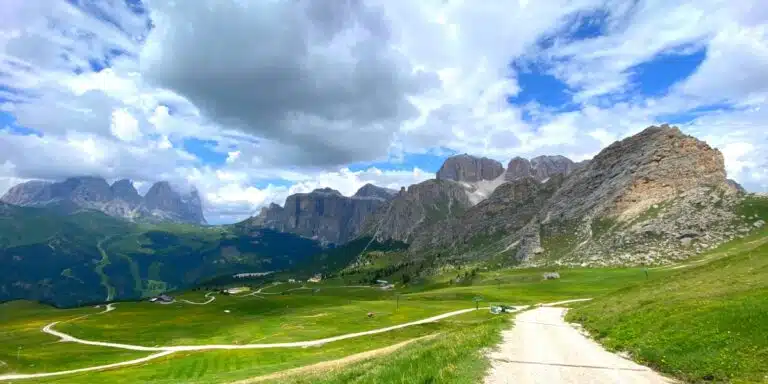
Dolomites Road Trip: Explore the Best of Northern Italy
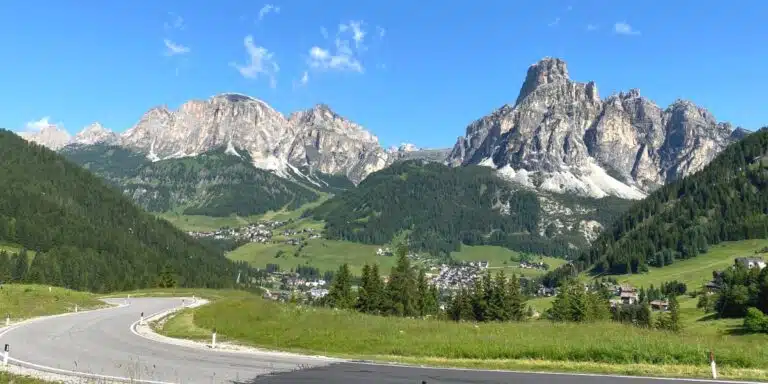
Great Dolomites Road: Absolutely Everything You Need to Know!
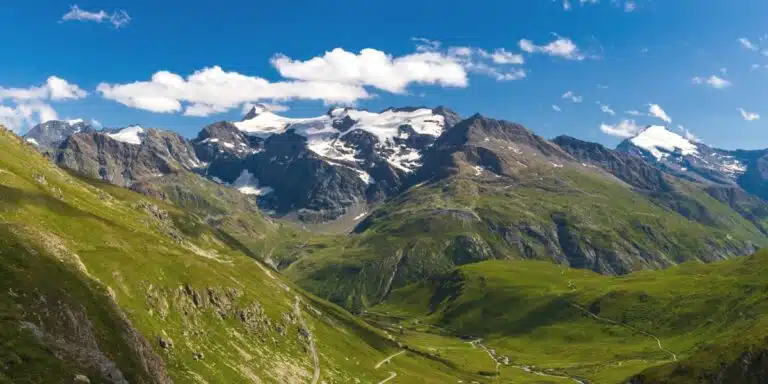
Route des Grandes Alpes: An Epic French Road Trip
Love it pin it.
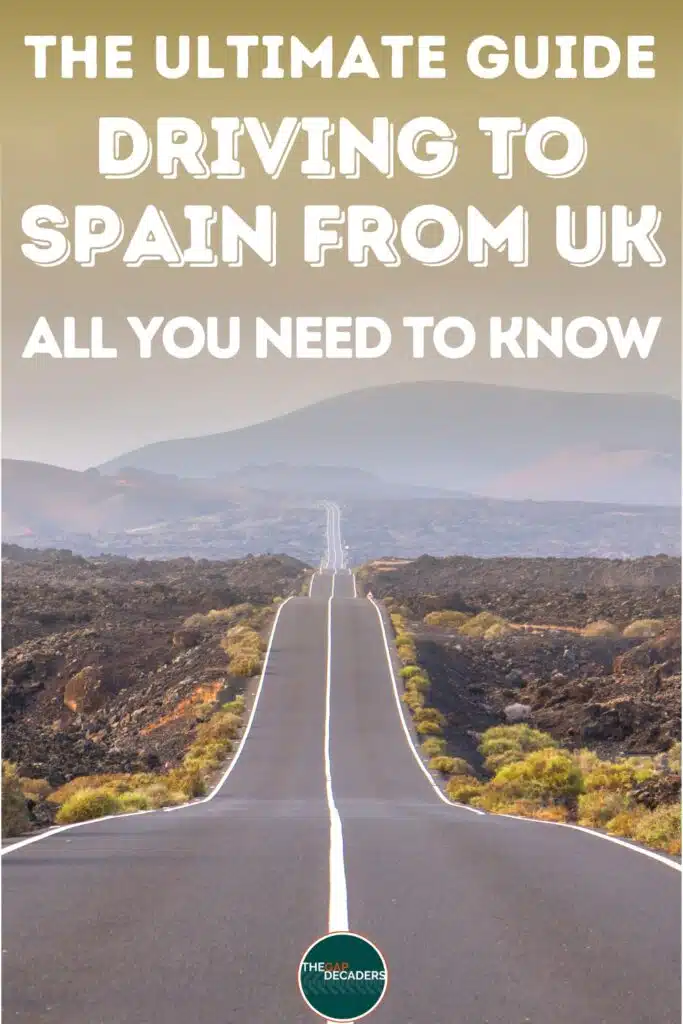

- Czech Republic
- Northern Ireland
- United Kingdom
- El Salvador
- South Africa
- Work with me
- Cookie Policy
- Privacy policy
United Kingdom , Spain
Tips for driving from the uk to spain.
Last updated: June 2020
Have you ever thought that driving from the UK to Spain will be a great route for a road trip? Or are you moving to Spain and thinking to drive down your car as well? Here are some tips on how to make your journey easier and what to expect from an over 2000+km drive.
The Channel Crossing:
Depending on how much you want to drive and which area of the UK you are starting your journey from, there are a few options on which is the best route to take, as the UK is connected to France from quite a few cities along the coast. My recommended options would be the following 4 routes:
Dover to Calais
If you start your trip from London, this route might be the easiest for you. The drive to Dover takes only around 1,5 hours and the crossing is very fast as well. If you choose to cross via the Eurotunnel , you will get to France in about half an hour. If you choose to cross via the ferry, then your journey will be longer (but cheaper).
Portsmouth to Santander/Bilbao
This is the most direct route to Spain but also the longest, as you will have to spend 28 hours on the ferry. The crossing can be quite rough, especially during the night, when the ferry sails over the Bay of Biscay. Overall however, this is the best route if you are not keen on driving very long distances and if you want to save money on petrol as well.
Poole to Cherbourg
With only a 4 hours crossing and good sailing times, Poole is another great place to start your journey from. The ferry leaves every morning at 8AM, arriving to Cherbourg at 12PM (1PM local time). You can properly wake up while having a good breakfast and coffee before embarking on the drive to Spain.
Plymouth to Roscoff
The advantage of choosing either the Poole to Cherbourg or Plymouth to Roscoff routes is that you will save time by avoiding Paris and reaching the motorway towards the North of Spain faster. The Plymouth to Roscoff crossing is an overnight one, takes 8 hours and arrives in France at the early hours of the morning.

Depending on which route you take, the ferries will have more facilities than others. For example, the least comfortable route, in my opinion, is the Dover – Calais crossing. The ferries don’t have enough seats and I ended up sleeping on the floor.
For longer crossings, such as the Portsmouth to Santander or Bilbao, you will have to book a cabin as well, otherwise you won’t be able to buy a ticket. And it’s understandable, for 28 hours of crossing. All ferries have restaurants on board, usually a self-service one and a bar. There will be a daily menu with a few dishes to choose from. The price of a meal is around £10, and from my experience, the food is very good. My favourite was the coq au vin, from Baie de Seine ferry – on the Portsmouth to Santander route. The chefs on the boats are all French (as most of the routes are operated by Brittany Ferries ) and they cook the food in big quantities. It might not look good on the plate but it’s delicious!
How to score a cheap ferry to France ticket
The South of England ferry routes to France are operated exclusive by Brittany Ferries, and it might seem impossible to get a cheaper ticket. But it’s not. Brittany Ferries has plenty of offers, especially for return ferry crossings to France but also to holiday trips to Spain. Here’s how to find cheaper ferry tickets to France:
First of all, do not check the ferry comparison websites as they will give you the full price you would pay directly with Brittany Ferries, if not more. Access the Brittany Ferries website but don’t use to booking engine that you will find on the home page. Instead, access their special offers page, which you can find by clicking on this link . Click on the offer you are best interested in and use the booking form that loads on the offer’s page.
You will not get any offer if you book directly on the homepage. I have booked many tickets to cross the channel as I used to go to France quite often. Living right next to the harbour in Poole made it very attractive for me to go to France to buy wine and cheese. And macarons!
The Best Routes to drive from England to Spain
I have drove from England the Spain quite a few times, and these are my recommended routes. I will set Malaga as the destination because that was my personal experience.
Poole to Cherbourg to Malaga
Depending on when you are travelling, there is a fast and a slow ferry from Poole to Cherbourg. In winter, the ferry goes to France during the day time and returns over night. It goes very slow, so expect a journey time of approximately 8 hours. In summer, the same ferry leaves Poole in the morning, at 8:30AM, arrives in Cherbourg at 12PM and returns to England later on, arriving at 10PM.
When you drive from Cherbourg to Malaga, expect to spend 2 nights in hotels, one in France and another one in Spain, due to the timings of the ferry.
The road out of the Cotentin Peninsula is quite straight forward and very good. Cherbourg is a small town and it won’t take long to join the motorway towards Bordeaux. You have about 50 kilometres until you can join the fast motorway on which you can drive with 130km/h. The 337 kilometres from Cherbourg to Nantes take approximately 3 hours and 30 minutes, on a day without traffic incidents.
Your first night will be in Nantes. As it is quite a long trip, I won’t recommend driving in the dark, once the sun has set. You will be tired and it’s harder to concentrate. Stay in a hotel close to the motorway, just outside Nantes, so you avoid the incoming traffic in the morning. Some recommendations are: Le sequoia apartment , La Vertabelle bed and breakfast and Au Gré du Hasard B&B ( read reviews here ). All of them are very close to the motorway and offer great value for money. And a good night’s sleep. Click on the names to read the reviews, see pictures and check the latest prices per night.
The next day will be long, with a 700 kilometres drive, from Nantes to Vitoria-Gasteiz, in Spain. This is the day where you will spend the most money on tolls as well, mostly in France. The motorways in France are good, but the ones in Spain are much better. Once you cross the border between France and Spain you will enter this spectacular scenery, with the road sinuously passing through long tunnels which exit on high viaducts and bridges. It’s a beautiful scenic drive.
The second night you will stop in Vitoria-Gasteiz, a small city in the North of Spain. I stayed at AC Hotel General Alava ( read reviews here ), which is part of the Marriot group, for only 60 euros a night. I had a gorgeous large room with a recently renovated bathroom that was pretty much the same size as the bedroom. Just around the corner from the hotel there is a typical Basque food restaurant which serves delicious fish dishes. It’s called Mesa jatetxea.
The third day is the longest, so plan to leave Vitoria Gasteiz early. It will take a little bit over 9 hours to cross Spain from North to South, but the roads are in great condition and not busy at all. The only part where you will spend some time will be passing through Madrid. Make sure you had some coffee before you arrive in Madrid, as you will need to concentrate quite a bit as there are many lanes and many merges. Once you pass Madrid, the journey becomes enjoyable again.
Plymouth to Roscoff to Malaga
Due to the overnight sailing, the trip from Roscoff to Malaga only takes two days. Roscoff it located in the Brittany peninsula and it does take a while to get onto the motorway: about 2 hours of slower driving. The scenery however is very pretty, the road passing through forests and traditional French stone villages.
You will spend the first night in this journey in Irun, a town just across the border, in Spain. I recommend the Ibis Hotel ( read reviews here ), which is conveniently located and quite modern. I paid 40 euros a night for a double room. They have an onsite restaurant as well which serves basic food. I didn’t notice any other restaurants around, as it’s quite an industrial area.
From Irun the trip to Malaga is pretty much the same as in the above section. From Irun to Vitoria Gasteiz there’s another hour’s drive.
Portsmouth to Santander to Malaga
This route is the easiest if you are not keen on driving through France. The ferry arrives in Santander in the evening, so you will need to look for a hotel pretty much as soon as you get off. I recommend Hotel Mirador de Gornazo ( read reviews here ), as it’s just off the motorway and outside Santander, so you don’t have to deal with the morning rush hour. There are no restaurants nearby, but the gas station in front serves some really good, cheap food. I paid 35 euros for a night here.
There is a highway from Santander all the way to Madrid, so you don’t need to worry about slower roads on this route. Be prepared though as they do cross mountains at a higher altitude, where in winter you might encounter snowy conditions. Make sure you have the proper tires for your car.
Car essentials
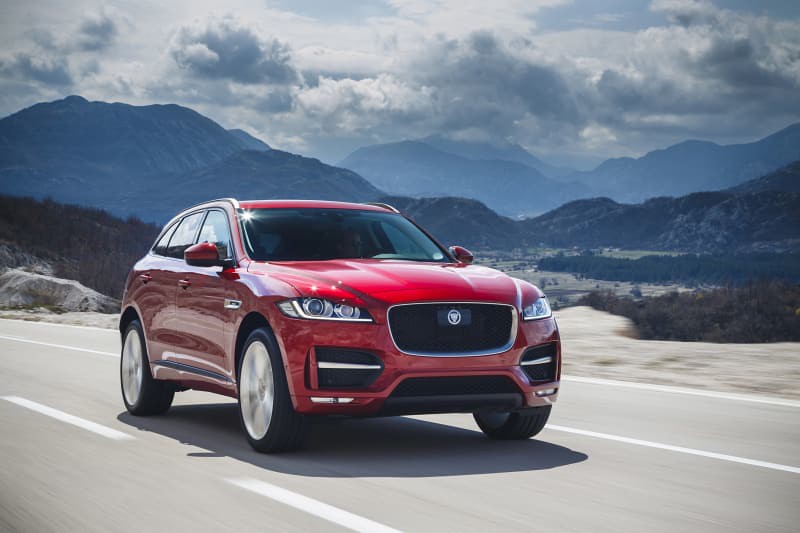
Driving from England to Spain is not your usual journey to the supermarket and back, so you need to make sure that your car is in good shape to do the trip. Check the oil of the car, the engine coolant, your lights and your tyres.
Is your car fit to do such a long journey? Driving over 2000km is not easy in a small car, such as a Fiat 500 for example. Small cars might be great for cities, but don’t try to take them for long journeys. The lack of space and the inability to be comfortable behind the wheel will make this drive more of a hell than an enjoyable road trip. Does your car have cruise control? This helps a lot, especially on motorways. If you are planning to do this trip often, consider investing in a car that will be easy to drive.
Toll roads and speed limits

Avoiding toll roads in France will take you back about 6 hours, so it’s better just to bite the bullet and use the high-speed motorways.
In Spain you do have an option to avoid the toll roads and still be on fast motorways. The only difference is that the toll roads are usually empty, whilst in France is not the case.
The speed limit on the motorway in France is 130km/h. Make sure you don’t go over as the radar systems in France measures the average speed on a section of the road and not just in a single point where they are installed. If you speed you will get a fine in the post.
In Spain, the speed limit is 120km/h on motorways.
Toll costs for driving from the UK to Spain (as of May 2020):
My last trip driving from the UK to Spain was in July 2019 , so I gathered the exact toll road costs for the journey. These amounts are for Malaga – San Sebastian – Bordeaux – Cherbourg – Poole and Portsmouth – Santander – Madrid – Malaga routes.
In France, from Nantes to the border with Spain, there are 7 tolls. The first one is the largest one, 29.40 euros. In total, the 7 tolls add up to 44.8 euros .
In Spain there are 2 tolls from San Sebastian to Vittoria Gasteiz, coming to a total of 16.38 euros .
My last trip from Spain to the UK was in May 2020 , from Malaga to Calais. I avoided all tolls in Spain, as the roads are very good and there is no need to pay for faster ones. From Irun to Calais, via Le Mans, there are 9 tolls that add up to 85.30 euros .
If you are traveling on the UK to Spain ferry, following the Santander route, you have the option to take the toll road around Madrid. The cost of this toll road is 6 euros . From Granada to Malaga there is another short section on which you can choose if you want to go on the toll road or on the old road. The toll costs here 5.20 euros . I recommend taking the normal road though, as this route is never busy, and I don’t really justify paying for the toll road for just around 15-20 kilometers.

How much does it cost to drive from the UK to Spain?
Depending on what car you are going to drive and which route you are going to take, the average fuel consumption will be around 3 full tanks from England to the South of Spain. Fuel is more expensive in France so try to fill up in England and in Spain if you can. There is a fuel station right at the border, when you cross from France to Spain, but it’s off the main road. The next one is 6 kilometers away. As a comparison, during my last trip, one litre of petrol in France was 1.6 euros, whilst in Spain it was 1.1. In France you can find cheaper fuel if you exit the motorways (1.3 instead of 1.6 euros per liter). If you drive from Calais, you will pass through Rouen, and that is a good place to stop and fuel up, I noticed the price per litre was 20 cents cheaper than on the motorway service stations.
My car, a Ford Fiesta, has a small tank and, from Calais to Malaga with a boot loaded with luggage, the cost of petrol is 210 euros.
Be very careful when it comes to gas stations in France. Avoid at all costs the ones which ask you to authorize your card at the pump before allowing you to put petrol in the car (Total Stations in particular). They will try to block 150 euros on your card and you will have to prove to your bank that you did not spend that much money on petrol, to get it back. If you need to refuel in France, usually BP is a safe choice.
A one-way ticket for the ferry crossing, depending on the time of the year, will cost you between £100 and £800, plus the cost of the cabin. This ranges between £40 – £110 in low season and £70 to £165 in high season, for an overnight crossing. For a day crossing the prices are between £26 and £70, depending on how many beds are inside and the comfort of the room (size, location on the ship and facilities inside). It is always cheaper the buy a return journey than a one way trip.
The most expensive ferry is the Portsmouth to Santander/Bilbao one, but if you look at the whole picture, you are saving money on fuel and get a day’s worth of relaxation on board.
If you have plenty of money to spend however, you can always choose to sail with Brittany Ferries’ flagship cruise ferry, Pont-Aven , which features a pool, a five-deck high atrium with panoramic lifts, a cinema, evening entertainment and luxurious cabins.
You also have to add to the costs the night you will spend in a hotel. I would not recommend driving by night and for such a distance you do need a good bed to rest. From my experience, the best place to stop for the night is the North of Spain.
Recommended Hotels Along the Route
These are some of the hotels I stayed at and which I recommend stopping by along the route. I usually book budget hotels which are close to the motorway so that I don’t have to get too far away from my route.
Ibis Hotel, Irun: This is a very good value for money hotel, with the same standards as any other Ibis Hotel. It is located in an industrial park, very close to the border with France. They have their own restaurant where they serve set menus – there are no other nearby restaurants around. You can check the reviews on Tripadvisor or click here to book directly on Booking.com
Fasthotel, Le Mans: This is a chain of budget hotels that you will find all over France. The rooms are small, with very compact bathrooms (if you’ve ever stayed at an EasyHotel – just like those), but the beds are usually comfortable. The rooms are cheap, and the hotel accept pets for a 5 euros fee. The hotel is located outside of Le Mans, next to the motorway. Around, walking distance, you will find plenty of restaurants and a big Auchan supermarket. The hotel will offer you a discount voucher for some of the restaurants around. They do serve breakfast, but I thought it was expensive so I skipped it. You can check the reviews on Tripadvisor or click here to book directly on Booking.com
Hotel Arena, Saint-Jean-de-Luz: This is a very convenient located hotel, with its own private parking. The room was very comfortable, with a fantastic shower. They do have a restaurant on site, but during my stay here it was closed because of the pandemic. This is a pet friendly hotel. You can check the reviews on Tripadvisor or click here to book directly on Booking.com
Auberge de la Selune, Ducey: When my car broke down in the middle of nowhere in France, in winter, during heavy snow, this hotel was a life saviour. I spend the night here whilst the car got towed and repaired at the garage in the village. The owner couldn’t be nicer, opening the hotel just for me, and overheating the room – which was a blessing after spending so many hours in the snow. He even brought me a bottle of wine. I had such a comfortable sleep here and, in the morning, I noticed how beautiful the village was as well. If you are stopping by to visit Saint Mont Michel on your way to Spain, this is the hotel to stay at, wonderful hospitality! You can check the reviews on Tripadvisor or click here to book directly on Booking.com
Hotel Mirador de Gornazo, Santander: This hotel was my choice when my ferry to Santander arrived in the evening. It’s 15 minutes’ drive from the harbour, just off the A67 motorway towards Madrid. As I arrived quite late, the restaurant was closed. However, on the other side of the parking there is a petrol station with a café that serves very large portions of food, very cheap. You can click here to book directly on Booking.com
AC Marriot General Alava, Vitoria Gasteiz: This hotel was a treat, mainly because I managed to book it for 60 euros a night. It is a four stars hotel, in the centre of Vitoria Gasteiz. The rooms are very modern, with very large bathrooms. The restaurant’s menu wasn’t that attractive to me, so I ended up at the restaurant around the corner, which serves amazing fish dishes. I forgot my tablet here and they were kind enough to mail it back to me. You can check the reviews on Tripadvisor or click here to book directly on Booking.com
Hotel Reina Isabel, Medina del Campo: This small hotel was my stop over when the ferry to Santander arrived in the afternoon. It is a few hours drive from Santander, and one hour away from Madrid. It’s a very simple budget hotel with a free secured gated parking, in the courtyard. It is located five minutes’ walk from the main square in Media del Campo, where you will find plenty of restaurants for tapas and dinner. The town is not touristy at all and the prices reflect that. You can check the reviews on Tripadvisor or click here to book directly on Booking.com
Hotel Montermoso Aranda de Duero: This hotel was very surprising. For a motorway hotel, it is very modern, with beautiful spacious rooms and private parking. They have a restaurant attached where you can sample the local cuisine. It is located just off the Madrid – Burgos motorway. They also sell cheap Ribera del Duero wine at reception, which makes a great gift when you return from Spain. You can check the reviews on Tripadvisor or click here to book directly on Booking.com
How long does it take to drive to Spain?
To drive to Spain from the UK it can take anywhere between 1.5 to 3 days, depending which route you take. For example, driving to Madrid, through France, takes about 1.5 days if you cross the English channel with a night ferry.
How long does it take to drive through Spain from North to South?
From Santander to Malaga it takes roughly around 14 continuous driving hours.
Is it safe to drive in Spain?
It is very safe to drive in Spain, especially on the motorways. The roads are in great condition, a pleasure to drive on. The roads I would avoid, especially in summer, are the ones around the most popular coasts. For example, the A7 which follows Costa del Sol, becomes a nightmare to drive on in summer due to the amount of rented cars and inexperienced foreign drivers who don’t know where they are going. Driving through Madrid is also a challenge, every time I’ve crossed it I encountered very heavy traffic.
Can I drive to Spain using my UK driving license?
Yes, you can. An International Driving Permit is not necessary if you own a British driving license.
Can I drive in Spain if the car does not belong to me?
You need to check this information with your insurance company. In Spain, the car is the one insured and not the driver.
How long can I drive your UK registered car in Spain?
You are only allowed to drive a UK registered car in Spain for 6 months.
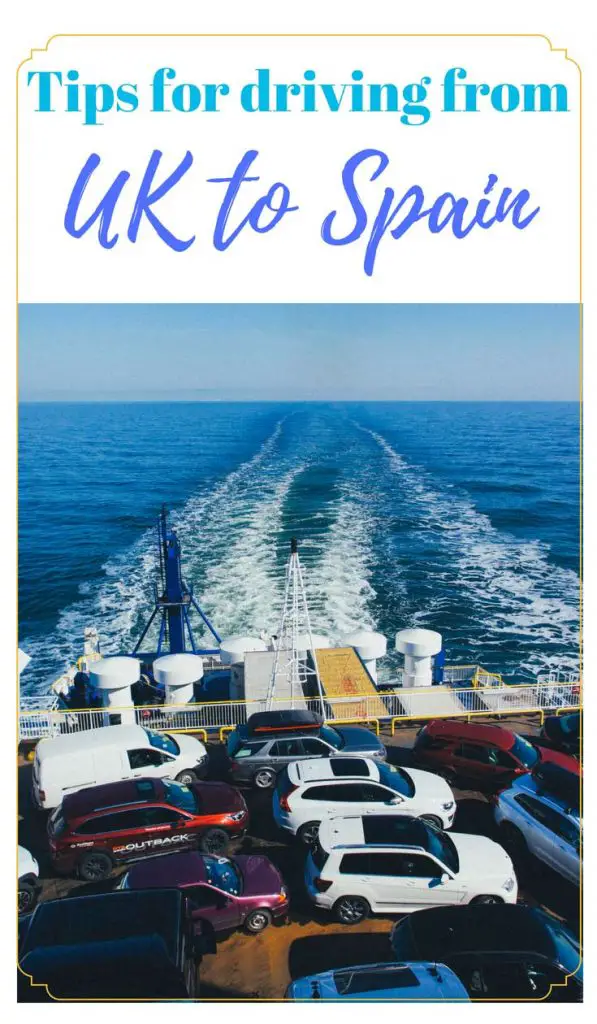
Some of the links on this website are “affiliate links.” This means that if you click on the link and do a purchase, I will receive an affiliate commission at no extra cost for you. This helps me keep my website running and continue to share my traveling knowledge with you. I thank you for booking your flights or hotels using the links on my website. Regardless, I only recommend products or services I use personally and believe will add value to my readers.
Related Posts:

Traveler. Dreamer. Cat lover. Wondering around the world with my backpack and my camera. Contributing to make the world a better place.
55 thoughts on “ Tips for driving from the UK to Spain ”
A word of warning ,travelling from the shuttle to Gandia in Spain. First time driving to Spain with 2 dogs. Unaware we were targeted by having a tyre burst while we stopped at an aire north of Lyon . Got out of that by changing the wheel in a brightly lit lorry park,still unaware until Google searched later on . Next one north of Valencia stopped for a toilet break at a service station I went to the toilet while wife stayed with the car and dogs.she was distracted by a couple in hi viz vests ,pretending to wash car windscreens and pick up litter while accomplice steals the bag from footwell containing (everything ) ,did not even realise until we were 20 mile further on. Travel insurance even bigger rip off ,bag and glasses covered but not apparently passports or replacements or pets passports, phones ,tablets , cards,or cash with bank receipt . Keep valuables in the boot, take out gadget insurance check it out ! UK sticker ,you are easy targets. Travelled in March 2022.
thanks for sharing all this information, i am planning on going from scotland to marbella with my dogs 2 kids , do you generally do your trips on your own? find it quite safe? i will be probably doing this on my own just feel a bit nervous but up for a challenge
Hi Nichola,
I have just returned from a month long road trip around Europe, on my own, and I had no issues at all. The route from Scotland to Marbella is quite straight forward and safe. The roads in Spain are great. In France I always stumble upon to odd road works, on the toll roads. But in both countries, the roads are much better than in the UK 🙂 If you are the only driver, make sure you plan plenty of stops to rest and also maybe add a couple of more over night stops. There are plenty of beautiful towns along the way. Also, make sure you get a European breakdown cover and insurance, just in case.
Really well written and informative. We are doing the reverse trip to you for a few months. We live in Marbella and have a small Dachshund. He may be small but he´s a big part of our family, so can´t leave him for that amount of time. We haven’t seen our family for over a year because of Cv19, so have booked a trip back to the Uk. I am looking at the Caen – Portsmouth route, from what i have read its better than passing Paris. Any one done that trip? Thanks again Joanna
I have crossed through Caen only once. You can probably do the entire trip with only one overnight stay, either around Vitoria-Gasteiz, or, if you don’t mind driving a little bit more and cross into France, Biarritz. Last time I drove to the UK from Fuengirola all the hotels in Spain were closed so I had no choice but to stop in Biarritz for the night. There are a few hotels there, close to the motorway, that will accept pets for a small fee. Make sure you check what documents you need to cross with your little Dachshund, as pets requirements have changed since Brexit.
I thought that your whole article was excellent and very detailed. I will definitely be doing this journey when things return to some kind of normal. The only thing I found missing was food and toilet breaks were they easy to find and plentiful. And also petrol stations are they on the main routes?. Thank you for your wonderful detailed routes.
I usually stop at petrol stations to buy snacks for the road as many of them have small cafes attached, where you can get hot food. All the petrol stations in both France and Spain have clean toilets which you can use without buying anything. In Spain there are petrol stations every few miles. In France, on the main motorways, they are spaced out every 20 miles or so. I hope this helps 🙂
Thank you for your reply. I will find this very useful when planning my trip. Stay safe and well
Good Tips !! We are thinking of doing this chunnel to my friends in Albir and coming back on the Bilbao ferry to mix it up. Let us know about your journey this month.
I will update the post as soon as I do the next trip. 🙂 I’m driving to the UK towards the end of January or beginning of February and I am planning to take either the Santander or the Bilbao route, to skip the bad weather in France.
Joanna this is an amazing guide! I found so much useful info in here to help plan our upcoming trip to Spain with my family. That’s a great tip about the special offers page for the Ferries, I am hoping to be able to use that. Thanks for such an informative article, everything I wanted to know was here!
I hope you will have a beautiful trip to Spain and I am happy that my guide helped you 🙂 I will be doing the trip again in January. 🙂
Thank you for a really interesting post about travelling to Spain by car. It’s not something we’d think about while the kids are so young. We’re just on our way home from Devon ( we love near Nottingham) and that seemed far enough with a 6 and 10 year old in tow! Something to consider in the future though!
Oh wow I’ve never driven abroad before but its definitely something that I’d like to get my confidence up to do xxx
This is super helpful as its something I would love to do with the family and our touring caravan My other in law is currently driving route 66 in America
Leave a Reply Cancel reply
Your email address will not be published. Required fields are marked *
This site uses Akismet to reduce spam. Learn how your comment data is processed .

10 Epic Spain Road Trips - Maps, Itineraries and Tips
Want to experience an amazing Spain road trip but not sure where to go? Choose from these 10 stunning routes for your road trip in Spain with our guides, detailed itineraries and insider tips.
Whether you're looking to relax in the mountains off the Costa del Sol, navigate the narrow streets of Toledo or take a stroll down Barcelona's Las Ramblas, we can help you plan the perfect Spanish road trip for you.
Best Spain road trips comparison
We have driven up and down and across Spain a lot of times over the past 15 years. Before we dive into the ideas, here's the complete list of the best road trip routes with key information. Scroll down to see more detail on each one.
Whether you want a relaxing drive along the coast or drive around the entire country of Spain, here are the 10 amazing options for a Spain road trip to pick from.

1. Andalucia road trip
A perfect way to explore Spain is to drive around Andalucia . If you love the sun, beaches and perfect mountain hideaways overlooking the sea, Andalucia is the place for you.
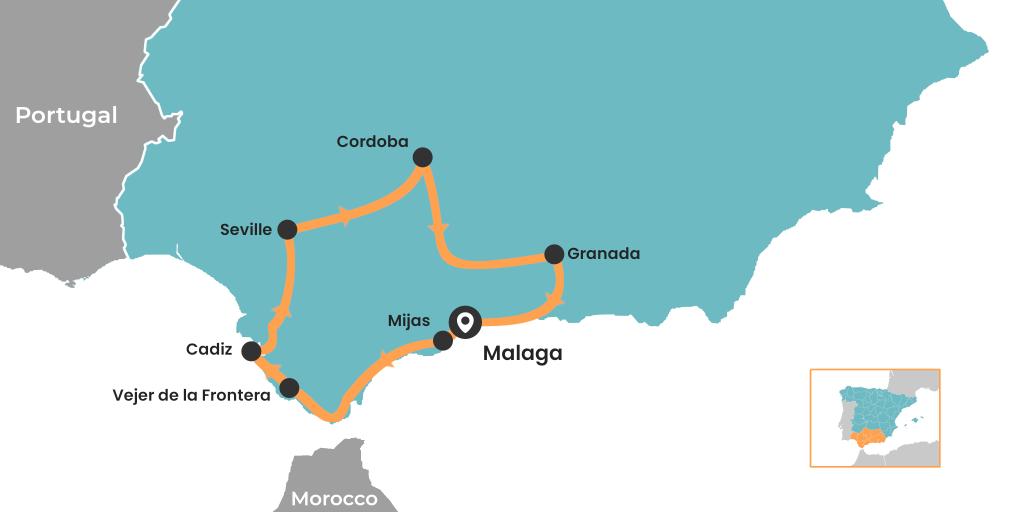
If you are more into culture and love grandiose cathedrals, medieval fortresses and jaw dropping architecture, Andalucia is also a place for you.
If, however, you just want to walk around historic towns and love traditional hearty Spanish food, you guessed it - Andalucia is your perfect destination.
The perfect Andalucia road trip will take you on a loop including coastal destinations such as Nerja, Malaga, Marbella, Gibraltar and Cadiz before going inland to discover Ronda, Seville, Cordoba and Granada.

This drive will scale mountains with breathtaking views and take you to the mesmerising Mezquita cathedral in Cordoba and the unique Moorish Alhambra complex in Granada.
You'll relax in the world famous Andalucian white villages of Mijas, Benahavis and Casares and mingle with new money in Puerto Banus' marina full of expensive supercars, people with too much plastic surgery and the world's biggest yachts.
Road trip length: 11 days
Total distance: 518 miles
2. Drive Spain's Mediterranean coast
Spain's Mediterranean coast is perfect for a Spanish road trip - just make sure you put sun screen on your left arm if you're driving - the sun gets hot!
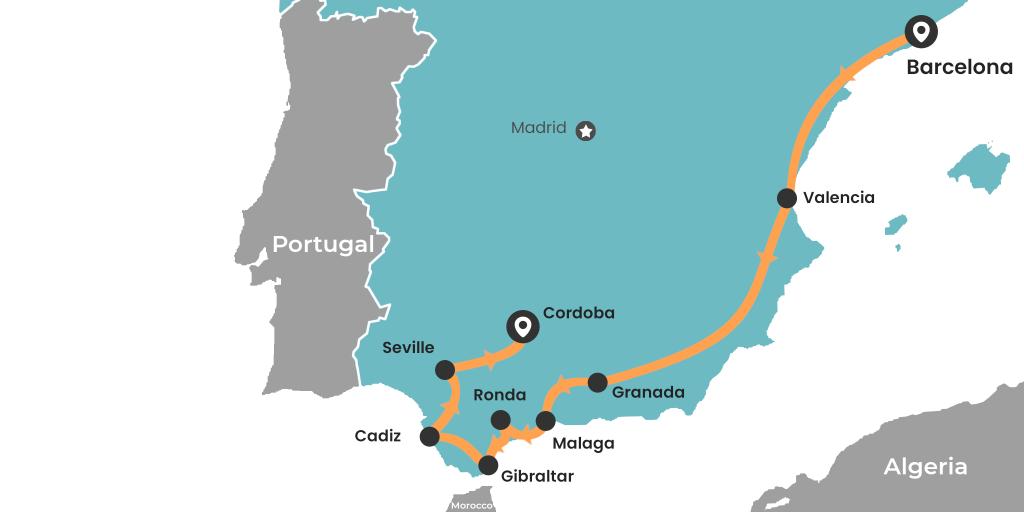
Start your road trip with a mini-break in Barcelona where you can visit sights such as La Sagrada Familia, Las Ramblas and unique buildings designed by Gaudi. There are few cities that offer as much as Barcelona so it's a perfect start to the Mediterranean coast trip.
Next leg takes you south to Valencia - a seriously underrated Spanish city that offers culture, food and sunshine aplenty with an amazing historical centre.
Once you've crossed over the Sierra Nevada mountains, your trip continues to Granada, Costa del Sol, Seville and Cordoba.
You will do an abridged version of the Andalucia road trip above, but get a much broader view of Spain having driven from one corner to another.
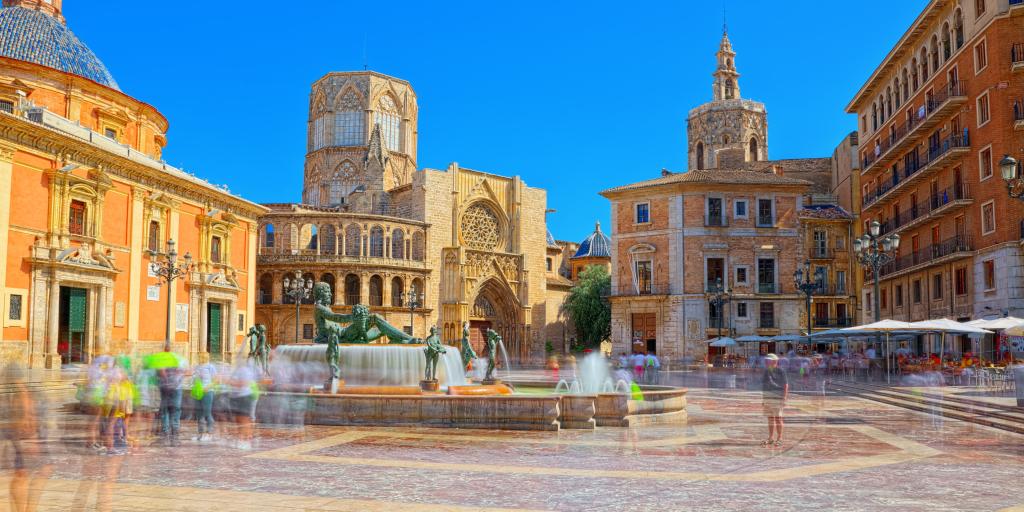
Hugging the coast for virtually the entire trip means that you are always a few minutes away from a beach - something that can provide welcome distractions on your way.
This road trip is a perfect mix of culture and relaxation so if you want to blend the two, give it a go. You will see the world's finest architecture in Barcelona, La Mezquita in Cordoba, the Seville Cathedral and Granada's Alhambra fortress but have time to relax in Puerto Banus, lay on the beach in Nerja and roam the narrow streets of Andalucian white villages.
Road trip length: 14 days
Total distance: 1,385 miles
3. Castille Leon - visit the heart of Spain
If you're flying in and out of Madrid, the Castille and Leon road trip can be an amazing way to explore Spain without having to drive all the way to the coast or spend weeks on the road.
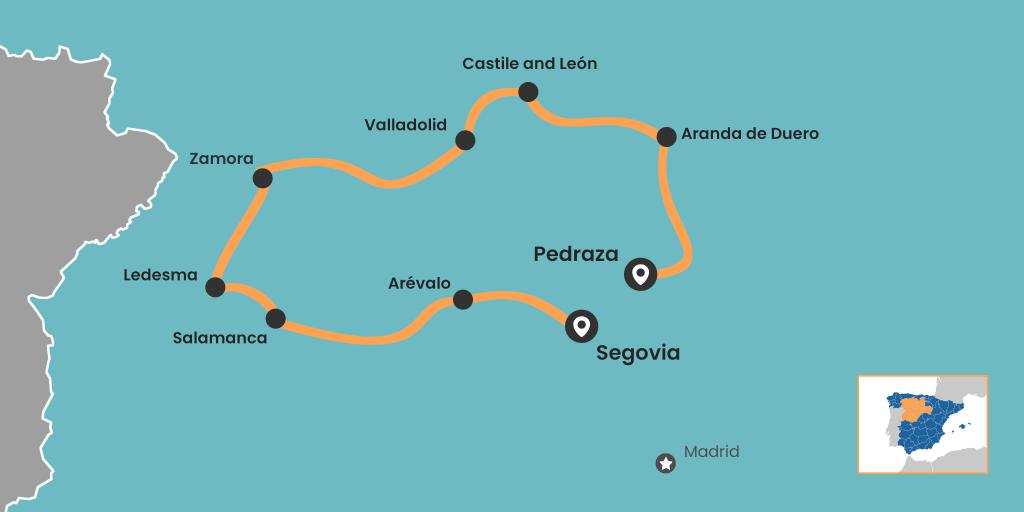
This road trip through Spain's heartland comes in a loop that starts and ends in the Segovia province.
You will start in the historic city of Segovia itself - famous for some of Spain's best architecture and declared a UNESCO World Heritage site.
After a day of exploring, the route heads west towards Salamanca via Arévalo. Arévalo is a small historic town famous for its Mudejar architecture and art giving it a special protected status in Spain and Salamanca is an ancient city with two cathedrals - the New one (it is actually called that) began construction in 1513!
From Salamanca, you can check out other beautiful historic towns of Ledesma and Zamora before a stop in Valladolid - the assumed capital of the Castille and Leon province. Its medieval history can be seen throughout the city - the Spanish Monarchy even made Valladolid their home in the 17th century!
After a visit to the city that shares its name with the Castile and Leon region, the trip ends with a drive through the Ribera del Duero wine region - hugely underrated relative to Rioja and the Portuguese Douro wine further down the same river valley.
The end of the trip gets you to Pedraza back in the Segovia province before taking a short drive back to Madrid's airport.

You can extend this road trip to include the historic Spanish cities of Leon and Burgos in the north of the province, but that will add a lot of mileage and time to your trip and southern Castille and Leon has a huge amount to see already - you can easily spend 2 weeks exploring this part of Spain and see new places every day.
Road trip length: 7 days
Total distance: 345 miles
4. Northern Spain road trip
So often overlooked in favour of Costa Brava, Costa del Sol or Costa Blanca, Spain's northern coast makes for an amazing road trip exploring the mix of cultures, fantastic food and rocky shore scenery.
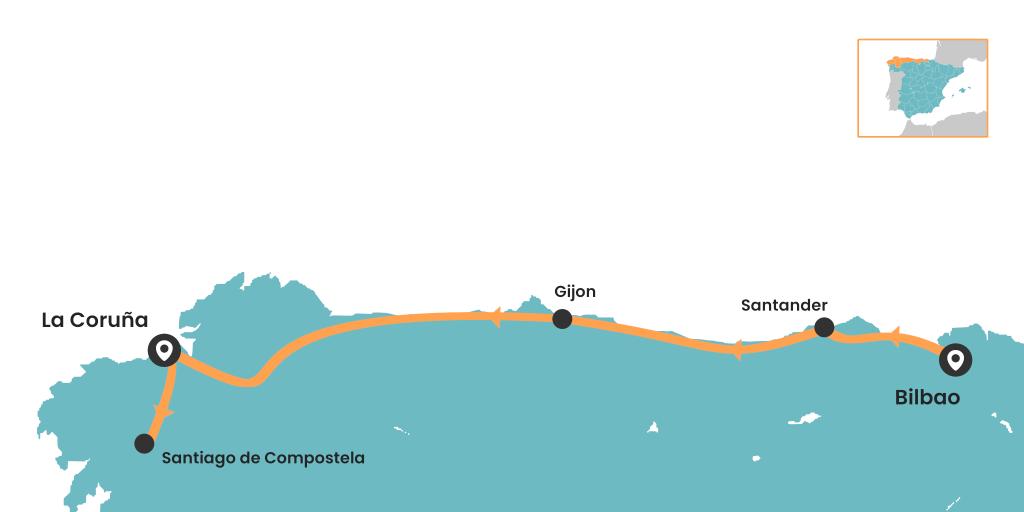
The road trip starts in the capital of Spain's Basque country - Bilbao. This is a place worth spending a couple of days in to explore its old historic centre, the surrounding mountains and the spectacular world-famous Guggenheim museum.
There is something for everybody in Bilbao with superb pintxos in street bars and michelin-starred restaurants, medieval streets and modern boulevards.
The road trip then moves west along the coast to Santander, before further stops in Santillana del Mar, the Picos de Europa national park and Gijon.

This trip includes a mix of beaches, historic Spanish cities and exploring nature - a perfect mix for a Spanish road trip!
Once you've hiked amazing gorges and filled yourself with pastries, it's time to hit the road and drive on to Oviedo and La Coruna.
Finishing off with a day trip inland to Santiago de Compostela, you will travel the entire length of Spain's Bay of Biscay coastline with everything to see along the way.
Depending on your flights, you might have to do a drive back along the coast to Bilbao or down to Porto or Madrid - this is one heck of a trip that you won't find in many recommendations or guides!
Road trip length: 10 days
Total distance: 737 miles
5. Basque country and Pyrenees
Spain's north-west corner lying on the Bay of Biscay and bordering France is full of history, tradition and... mountains.
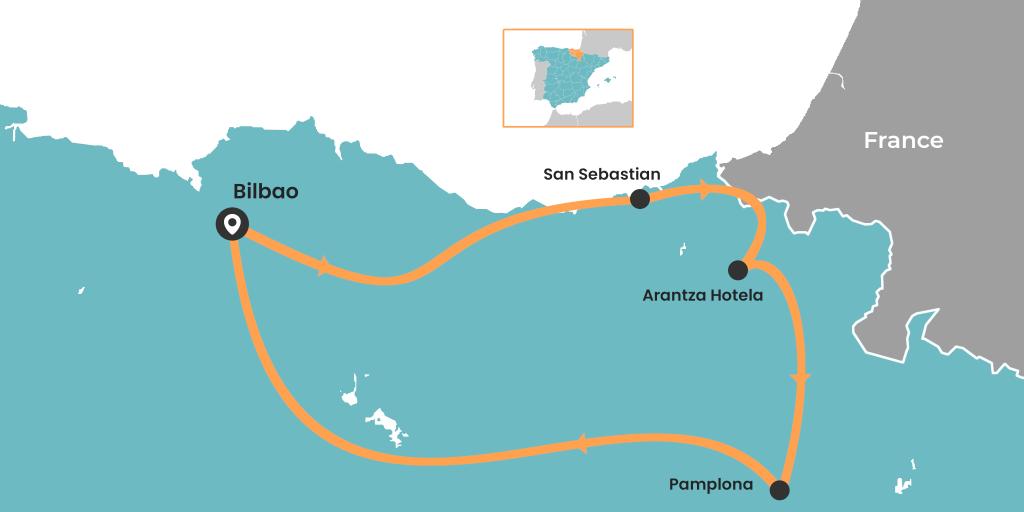
The Basque country is a unique part of Spain - they have a prominent local language, cities that make up two prominent medieval kingdoms (Basque and Navarre) and a unique link to the Pyrenees. In medieval times, Basque country spanned the mountain range, including parts of France on the other side.
Today the region fervently focuses on its culture. As you travel in major cities such as Bilbao, San Sebastian and Pamplona, you will get to try the local pintxos tradition. In some ways similar to tapas popular in the rest of Spain, pintxos are smaller bite-size snacks served in bars and charged by number or by plate.
If you get out of the tourist areas, you will find local pintxo bars where the snacks are free as long as you keep buying the drinks!

The Pyrenees are an amazing mountain range that is not high on many tourists' radars.
Often overlooked in favour of trips to the Alps or even Sierra Nevada further south in Spain, the Pyrenees are an older mountain range with a lot of peaks over 3,000m above sea level.
The roads through the Pyrenees are fantastic and can make for really great road trips with the added bonus of hardly any other cars as you drive around. There are some fantastic hotels if you want to really relax and go off the grid for a few days - we have stayed at The Arantza Hotela in the foothills of Pyrenees and cannot recommend it highly enough - it is expensive but super luxurious and worth it!
A small number of rooms have stunning views of the surrounding hills with morning fog climbing towards the peaks and you can relax in a jacuzzi looking out over the landscape before having an amazing dinner in the hotel's gastro restaurant.
After a few days of luxuriating, it's time to drive down from the mountainside and make your way to Pamplona - a historic city famous for its July bull running festival has far more to offer than the medieval tradition. Narrow streets, beautiful stone buildings and fantastic local coffee shops are great for unwinding in late morning.
The drive back to Bilbao airport is a little under 2 hours to get you back home!
Total distance: 240 miles
6. Driving tour of Catalonia
There is a whole lot more to Spain's Catalonia region than Barcelona. You can spend weeks travelling around the area and still not see dozens of amazing villages, secret beaches, mountain waterfalls or quirky museums.
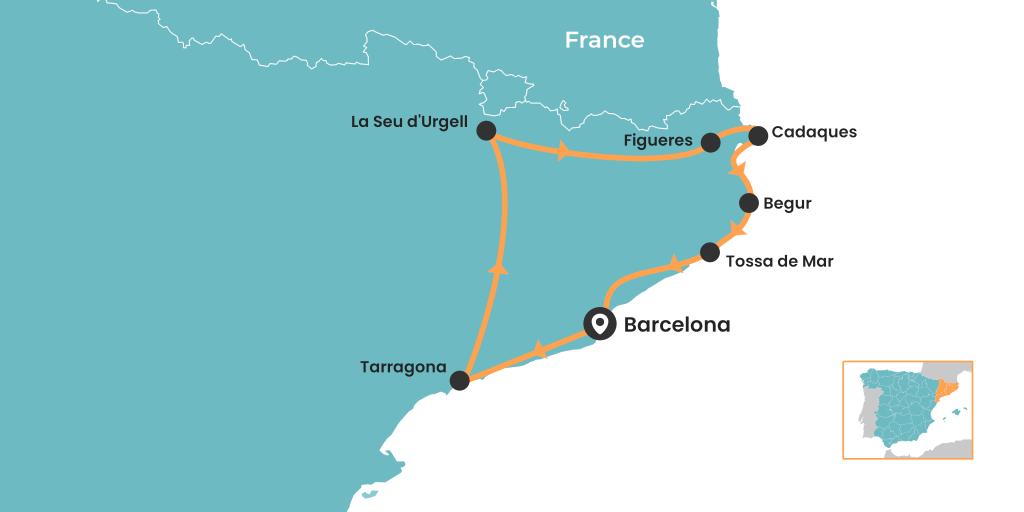
If you want to base yourself in Barcelona, instead of going on a road trip, check out our 40 day trips from Barcelona for inspiration on where you can get to!
A great route around the region can start and end in Barcelona to make it easy with flights.
From Barcelona, head south along the coast to Tarragona with a stop in Sitges and the option of relaxing in one of a few great beaches along the way.
From Tarragona, this trip goes inland towards Montblanc and all the way to La Seu d'Urgell in the Pyrenees via Solsona.
On your route across the north of Catalonia, you are spoilt for choice with the Garrotxa volcanic national park and the village of Santa Pau worth visiting, a detour into Andorra and towns like Besalu and Castellfollit de la Roca all great options before you arrive in Figueres.
After some cultural sightseeing, head on to Cadaques on the coast - there are some great beaches and a Salvador Dali House Museum.
The rest of the road trip follows the Costa Brava back down to Barcelona. There are tonnes of great places to stop including Roses resort, the canals of Empuriabrava, L'Escala and Begur. A drive inland to Girona is optional before you make it down to the relaxation end of the journey with beach stops in Tossa de Mar and Lloret de Mar on the menu.
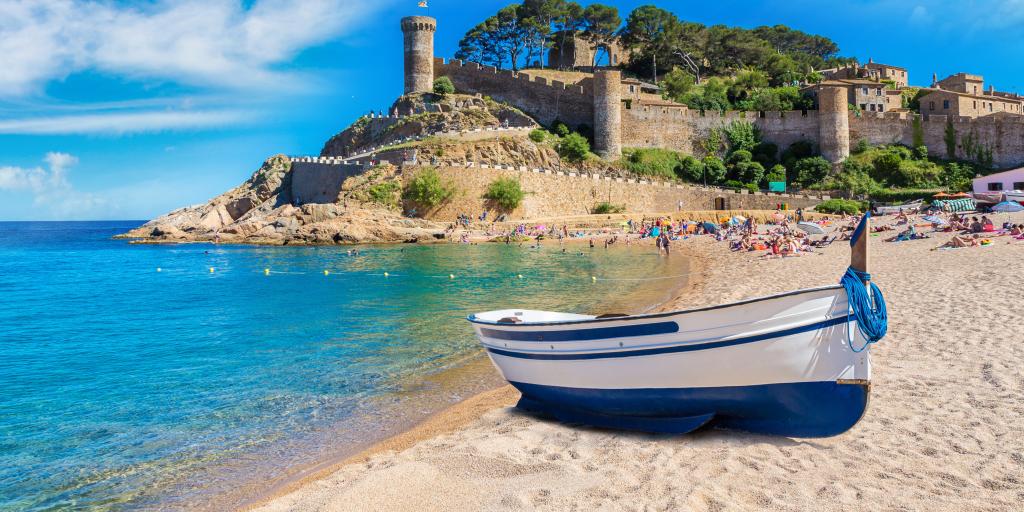
There are few parts of the world which have so much to see in such a compact region both culturally and in nature. If you love the mountains, hiking and being off the beaten track, a road trip around Catalonia is definitely the best choice in Spain.
Road trip length: 9 days
Total distance: 520 miles
7. Historic central Spain - Castilla-La Mancha
Castilla - La Mancha is one of the largest regions of Spain and also one of the least well known by tourists.
Hidden away in plain sight right next to Madrid, it stretches almost as far as Valencia and Murcia in Spain's south east.

Exploring this region brings a mix of natural sights and beautiful historic Spanish cities. As with the Castille Leon trip, it's easy to start and finish in Madrid if that's where you can get easy flights to.
This Spain road trip starts in the most famous city in the La Mancha region - Toledo. Toledo is famous as a blend of Christian, Muslim and Jewish religions and cultures. It was the capital city of the Visigoth Empire, Spanish Moors and later of Spain at some points during the course of history.
After a couple days of sightseeing, it's time to hit the road and head on south to Ciudad Real via Consuegra and Daimiel.
There is a lot to see in this part of Spain including the infamous windmills made famous by Miguel de Cervantes' Don Quixote. The majority of the region is set on a plateau with occasional barren hills.

The trip continues east to Cuenca and Siguenza - both stunning towns but in completely different ways and both very different from a lot of typical Spanish destinations.
If you're feeling adventurous, there are a number of national parks on the way where you can stretch your legs on a hike or just take a scenic detour.
Total distance: 380 miles
8. Galicia road trip
Getting to and from the region can be tough so you might have to adjust the route depending on where you're travelling from.
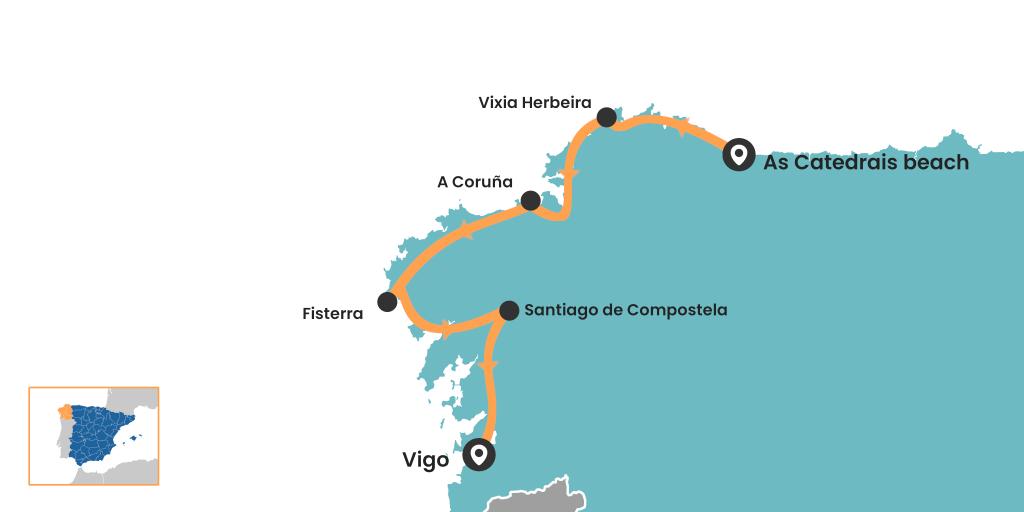
The plan with this road trip is to go all the way round the Galician coastline starting from As Catedrais beach. If you don't know it by name, you've definitely seen pictures of giant rocks and archways on the sandy beach before.
Although this trip is only 5 days long, you'll spend a few of these driving along small coastal roads. Our tip is to ignore the navigator which will send you inland along faster roads. Keep the sea to your right as you go and you're unlikely to go too far wrong.
After passing the Vixia Herbeira cliffs, you'll arrive in A Coruña. Other than the Hercules Tower, the main sight here is the light house. Naturally.
Take a day to see the city and its surroundings - seafood here is amazing as it's a functioning port supplying much of the region and beyond.
The trip then continues around the coast to Santiago de Compostela. You can take the direct short cut but you will miss out on a whole lot of stunning scenery, ocean-facing cliffs and spectacular locations for light houses - on the shoreline, on cliffs and even on their own islands.
After exploring the historic and religiously important city, the route goes back towards the coast and passes Pontevedra on the way to the pretty town of Vigo.
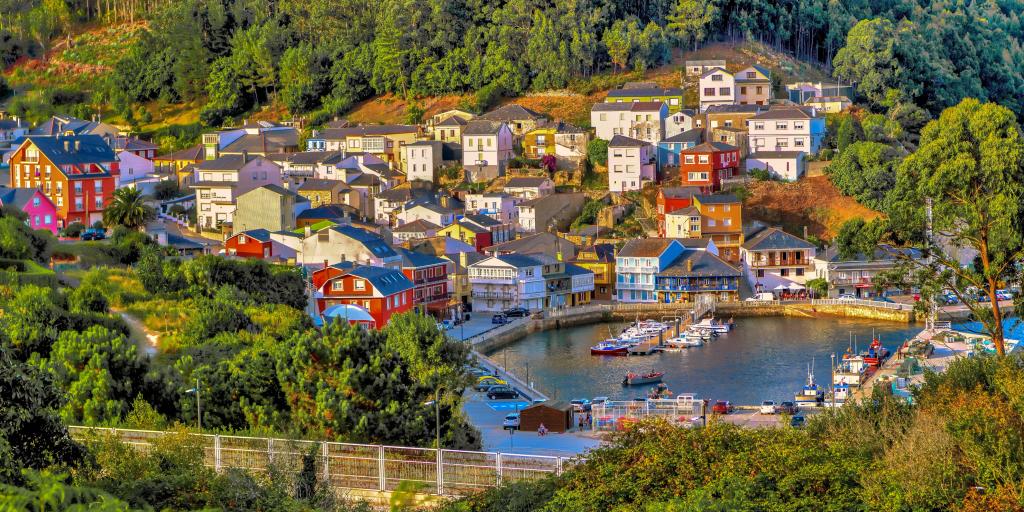
This might not be so much of a Spanish road trip as a gentle breeze along the coast (and there will be a lot of breeze!), but it's definitely one to keep in mind if you want to unwind and keep yourself away from the tourist traps around Spain.
Road trip length: 5 days
Total distance: 322 miles
9. Road trip around Mallorca
Many don't associate Mallorca with a road trip, but the island has a huge amount to offer beside the beaches and clubs.
Flying in and out of Palma means that's a great place to start and finish your trip.

Palma is the capital and often overlooked by visitors who go straight from airport to their preferred corner of the island. The city actually has a lot to offer so it's great to spend the first or last night here depending on your flight times.
Make sure you check out the huge Cathedral (you really can't miss it) and the part of the city around the market (only open in the morning).
Once you set off, the best way to see the island is to drive all the way around.
Start by heading along the narrow cliff roads along the coast to Valdemossa and Soler - the two very popular destinations to the north of Palma. After that the road trip continues all the way to Port de Pollença before heading across the island to Cala Mesquida.
Once you've navigated the tourists, a short drive down the coast takes you to Cala Agulla where the beaches are empty and the sun is just as hot for some relaxation.

To wrap up the trip, you've got to stop off at the resort town of Cala d'Or before making your way back to Palma.
A short trip with a lot of breathtaking views and cliffs in the north and resorts with fantastic beaches on the south can be the perfect way to unwind on a short break!
Total distance: 175 miles
10. The full circle - A complete road trip around Spain
If you have time on your hands and feel adventurous, a road trip around the entirety of Spain can be an amazing way to delve into the culture, see all the corners of this amazing country and really get immersed.

One key disclaimer is that while this one sits high on our list of bucket list trips, we haven't actually done the full trip - it's a long drive!
But if you're brave enough, you can start wherever along the route you like as you it goes in a loop.
Barcelona and Madrid are likely to be the best hubs for getting in and out of Spain and the route cycles down through Valencia to an Andalucian tour before heading back north from Cordoba.
After exploring central Spain with stops in Toledo and surrounding towns and a tour of Madrid, the drive continues into Spain's Duero valley, Valladolid and on to Galicia's Vigo, Santiago de Compostela and A Coruna while taking in breathtaking views of ocean-facing cliffs and huge waves.
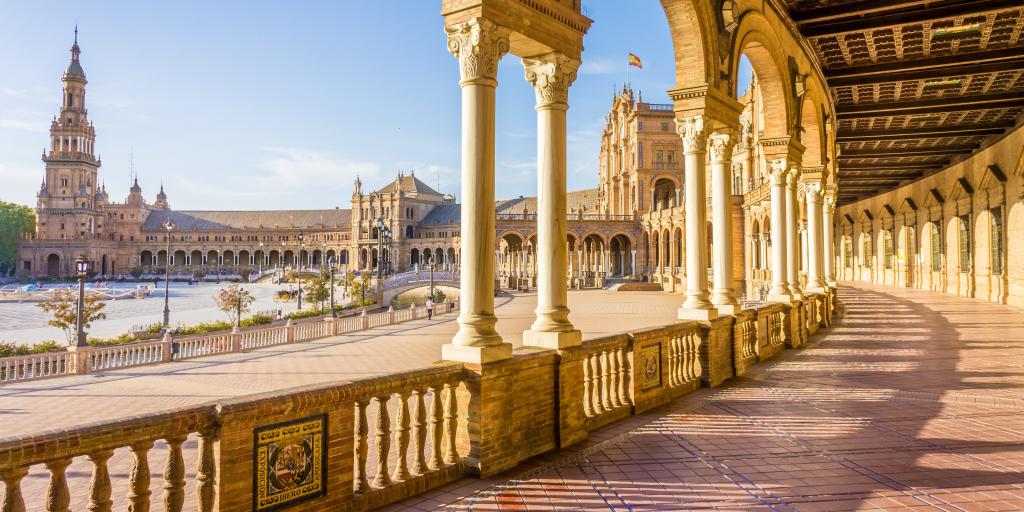
The trip continues along the north coast stopping off at Santander, Bilbao and San Sebastian before detouring off into the Pyrenees and the historic cities of Pamplona and Zaragoza. A mini Catalonia tour to end the trip wraps up the route that will take at least a month to complete if you want to do things other than driving.
If you do end up doing this one, please let us know! We'd love to see how you get on!
Road trip length: 35 days
Total distance: 2,800 miles
Join our email list!
By joining our email list, you give LazyTrips permission to use your email for sending you newsletters, emails and updates including for marketing purposes. Your email will not be provided to third parties.
Related posts
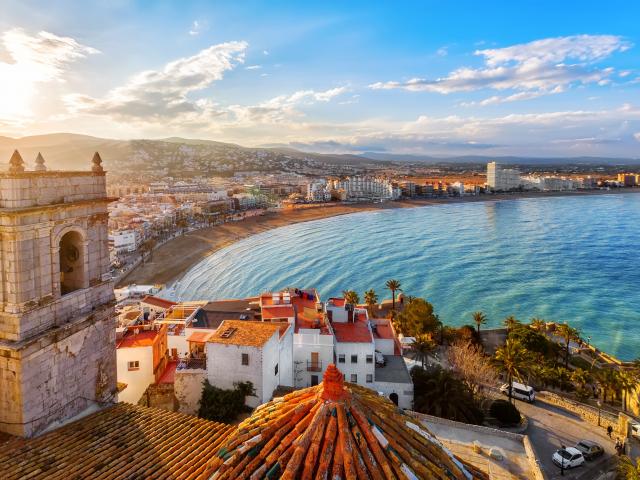
- Part exchange
- Archived cars
- Archived listings
- Report a purchase
- Communication preferences
- Browse in-stock new & used cars
- Browse leasing deals
- Sell your car
- New car reviews
- Car reviews
- Aston Martin
- Audi electric cars
- Audi hybrid cars
- BMW electric cars
- BMW hybrid cars
- Citroen electric cars
- Ford hybrid cars
- Honda hybrid cars
- Hyundai electric cars
- Hyundai hybrid cars
- Hyundai SUVs
- Jaguar SUVs
- Kia electric cars
- Kia hybrid cars
- Lamborghini
- Lexus electric cars
- Lexus hybrid cars
- Mazda hybrid cars
- Mercedes-Benz
- Mercedes-Benz electric cars
- Mercedes-Benz hybrid cars
- Mercedes-Benz SUVs
- MG electric cars
- MINI electric cars
- Nissan electric cars
- Peugeot electric cars
- Peugeot hybrid cars
- Porsche electric cars
- Porsche SUVs
- Renault electric cars
- Rolls-Royce
- Skoda electric cars
- Smart electric cars
- Toyota hybrid cars
- Toyota SUVs
- Vauxhall electric cars
- Vauxhall hybrid cars
- Vauxhall SUVs
- Volkswagen electric cars
- Volkswagen hybrid cars
- Volkswagen SUVs
- Volvo electric cars
Not sure what you want? Find your perfect car with our Car chooser
- 7-Seater Cars
- Automatic Cars
- Convertible Cars
- Crossover Cars
- Electric Cars
- Estate Cars
- Executive Cars
- Family Cars
- Hot Hatches
- Hybrid Cars
- Luxury Cars
- Medium-sized Cars
- Most Economical Cars
- Motability Cars
- Saloon Cars
- Sports Cars
- Audi A1 Sportback
- BMW 1 Series
- Cupra Formentor
- Ford Fiesta
- Honda Civic
- Hyundai Ioniq 5
- Hyundai Tucson
- Hyundai i10
- Kia Sportage
- Land Rover Defender
- Mercedes-Benz A-Class
- Nissan Juke
- Nissan Qashqai
- Peugeot 2008
- Peugeot 208
- Peugeot 3008
- Range Rover
- Range Rover Evoque
- Skoda Karoq
- Tesla Model 3
- Tesla Model Y
- Toyota Aygo X
- Toyota Yaris Hybrid
- Vauxhall Corsa
- Vauxhall Mokka
- Volkswagen Golf
- Volkswagen Polo
- Volkswagen Tiguan
- Nearly new cars
- Car chooser
- Compare cars side-by-side
- New car delivery times
- Fuel chooser
- PCP calculator
- How we test cars
- Used Abarth cars
- Used Alfa Romeo cars
- Used Alpine cars
- Used Aston Martin cars
- Used Audi cars
- Used Bentley cars
- Used BMW cars
- Used Citroen cars
- Used Cupra cars
- Used Dacia cars
- Used DS cars
- Used Ferrari cars
- Used Fiat cars
- Used Ford cars
- Used Genesis cars
- Used GWM Ora cars
- Used Honda cars
- Used Hyundai cars
- Used INEOS cars
- Used Infiniti cars
- Used Jaguar cars
- Used Jeep cars
- Used Kia cars
- Used Lamborghini cars
- Used Land Rover cars
- Used Lexus cars
- Used Lotus cars
- Used Maserati cars
- Used Mazda cars
- Used McLaren cars
- Used Mercedes-Benz cars
- Used MG cars
- Used MINI cars
- Used Mitsubishi cars
- Used Nissan cars
- Used Peugeot cars
- Used Polestar cars
- Used Porsche cars
- Used Renault cars
- Used Rolls-Royce cars
- Used SEAT cars
- Used Skoda cars
- Used Smart cars
- Used SsangYong cars
- Used Subaru cars
- Used Suzuki cars
- Used Tesla cars
- Used Toyota cars
- Used Vauxhall cars
- Used Volkswagen cars
- Used Volvo cars
- Used Peugeot 108
- Used Kia Picanto
- Used Citroen C3
- Used Volkswagen Polo
- Used Ford Fiesta
- Used Renault Clio
- Used MINI 3-Door Hatch
- Used SEAT Arona
- Used Ford Fiesta Active
- Used MINI Paceman
- Used Vauxhall Mokka
- Used Fiat 124 Spider
- Used Honda Jazz
- Used Skoda Karoq
- Used Toyota Yaris Hybrid
- Used Volkswagen Golf
- Used Toyota Corolla
- Used BMW 2 Series (2014-2021)
- Used Nissan Qashqai
- Used Lexus UX
- Used Range Rover Evoque
- Used Discovery Sport
- Used Mercedes-Benz C-Class Saloon
- Used Audi A4 Avant
- Used Mercedes-Benz GLA
- Used Toyota RAV4 Hybrid
- Used Audi Q5
- Used BMW X1
- Used BMW X3
- Used Jaguar F-PACE
- Used Volvo XC90
- Used Mercedes-Benz GLC
- Used cars in Aberdeen
- Used cars in Birmingham
- Used cars in Bristol
- Used cars in Cardiff
- Used cars in Doncaster
- Used cars in Dundee
- Used cars in Edinburgh
- Used cars in Glasgow
- Used cars in Leeds
- Used cars in Leicester
- Used cars in Lincoln
- Used cars in Liverpool
- Used cars in London
- Used cars in Manchester
- Used cars in Milton Keynes
- Used cars in Newport
- Used cars in Northampton
- Used cars in Norwich
- Used cars in Nottingham
- Used cars in Plymouth
- Used cars in Sheffield
- Used cars in Southampton
- Used cars in Stoke-on-Trent
- Used cars in Swansea
- Car history checker
- Car leasing
- Business car leasing
- Abarth lease deals
- Alfa Romeo lease deals
- Audi lease deals
- BMW lease deals
- BYD lease deals
- Citroen lease deals
- Cupra lease deals
- Dacia lease deals
- DS lease deals
- Fiat lease deals
- Ford lease deals
- Genesis lease deals
- GWM Ora lease deals
- Honda lease deals
- Hyundai lease deals
- Jaguar lease deals
- Jeep lease deals
- KGM Motors lease deals
- Kia lease deals
- Land Rover lease deals
- Lexus lease deals
- Maserati lease deals
- Mazda lease deals
- Mercedes-Benz lease deals
- MG lease deals
- MINI lease deals
- Nissan lease deals
- Peugeot lease deals
- Polestar lease deals
- Porsche lease deals
- Renault lease deals
- SEAT lease deals
- Skoda lease deals
- Smart lease deals
- Subaru lease deals
- Suzuki lease deals
- Tesla lease deals
- Toyota lease deals
- Vauxhall lease deals
- Volkswagen lease deals
- Volvo lease deals
- 7-seater car lease deals
- Electric car lease deals
- Estate car lease deals
- Hybrid car lease deals
- Small car lease deals
- SUV lease deals
- Ford Fiesta lease deals
- Vauxhall Corsa lease deals
- Volkswagen Polo lease deals
- Nissan Juke lease deals
- Audi A1 Sportback lease deals
- Skoda Kamiq lease deals
- Peugeot 2008 lease deals
- Ford Puma lease deals
- Nissan Qashqai lease deals
- Volkswagen Golf lease deals
- Audi A3 Sportback lease deals
- Volkswagen T-Roc lease deals
- Ford Focus lease deals
- Kia Sportage lease deals
- BMW 1 Series lease deals
- Mercedes-Benz A-Class lease deals
- Toyota C-HR lease deals
- Hyundai Tucson lease deals
- Ford Kuga lease deals
- Mercedes-Benz A-Class Saloon lease deals
- BMW 2 Series Gran Coupe lease deals
- Volkswagen Tiguan lease deals
- Volkswagen ID3 lease deals
- Volvo XC40 lease deals
- Mercedes-Benz GLB lease deals
- Volkswagen Golf GTI lease deals
- Tesla Model 3 lease deals
- BMW 3 Series lease deals
- Volkswagen Golf R lease deals
- Range Rover Evoque lease deals
- Jaguar F-PACE lease deals
- Range Rover Velar lease deals
- Discovery lease deals
- Audi Q7 lease deals
- Range Rover Sport lease deals
- New car deals
- Abarth Deals
- Alfa Romeo Deals
- Alpine Deals
- Citroen Deals
- Cupra Deals
- Dacia Deals
- Genesis Deals
- GWM Ora Deals
- Honda Deals
- Hyundai Deals
- INEOS Deals
- Jaguar Deals
- KGM Motors Deals
- Land Rover Deals
- Lexus Deals
- Lotus Deals
- Mazda Deals
- Mercedes-Benz Deals
- Nissan Deals
- Peugeot Deals
- Polestar Deals
- Renault Deals
- Skoda Deals
- Smart Deals
- Subaru Deals
- Suzuki Deals
- Tesla Deals
- Toyota Deals
- Vauxhall Deals
- Volkswagen Deals
- Volvo Deals
- Dacia Sandero Deals
- Dacia Duster (2017-2024) Deals
- Vauxhall Corsa Deals
- Volkswagen Polo Deals
- Peugeot 2008 Deals
- Ford Puma Deals
- Volkswagen Golf Deals
- Nissan Qashqai Deals
- Nissan Leaf Deals
- Kia Sportage Deals
- MINI Cooper Electric Deals
- Mercedes-Benz A-Class Deals
- Hyundai Tucson Deals
- Ford Kuga Deals
- Volkswagen Tiguan Deals
- Cupra Formentor Deals
- Peugeot 3008 Deals
- Vauxhall Mokka Electric Deals
- Volvo XC40 Deals
- Tesla Model 3 Deals
- Volkswagen ID4 Deals
- Hyundai Ioniq 5 Deals
- Range Rover Evoque Deals
- Kia Sorento Deals
- Volvo XC60 Deals
- Jaguar F-PACE Deals
- Volvo XC90 Deals
- BMW M2 Deals
- 0% car finance deals
- No deposit car finance deals
- Cars with cheap insurance deals
- Immediate delivery deals
- Quick delivery EV deals
- Sell my car
- Part exchange my car
- Value my car
- Sell my van
- Electric cars
- Best electric cars
- Cheap electric cars
- Most efficient electric cars
- Longest range electric cars
- Electric family cars
- Electric SUVs
- Fastest electric cars
- Small electric cars
- Used electric cars
- Audi Q4 e-tron
- Ford Mustang Mach-E
- Hyundai Kona Electric
- Jaguar I-PACE
- Kia Niro EV
- Lotus Eletre
- Nissan Ariya
- Peugeot e-208
- Skoda Enyaq
- Toyota bZ4X
- Carwow electric
- Compare electric car costs
- EV range calculator
- EV charging stations map
- Electric car statistics
- Tesla charging stations map
- Automotive news
- carwow newsroom
- Going electric
- Choosing a car
- Buying a car
- Financing a car
- Owning & running a car
- Selling a car
- Grants & discounts
- Driving rules and laws
- Automotive glossary
- YouTube and videos
- Miscellaneous automotive topics
- Congestion charge checker
- Fuel price checker
- MOT history checker
- ULEZ checker
- Clean air zone checker
- Vehicle Tax checker
Driving to Spain from the UK: top tips
December 16, 2022 by carwow staff

Spain offers great beaches, fantastic weather and for Brits, it is pretty affordable. No wonder that it tops the list of countries we love to head to the most. With over 18 million visitors travelling there from the UK each year between 2017 and 2019, it’s almost twice as popular as France.
Now, with pandemic restrictions and entry limitations finished, Spain is very much open for business, and it’s also often cheaper to drive than fly. We take a look at how the rules have changed since Brexit and all the things you need to know before embarking on a road trip to Spain.
Our top tips for driving to Spain
- Have the right documents
- Check what has changed since Brexit
- Be familiar with French road rules, as you’ll also be driving through France
- Work out the best route
- Be familiar with Spanish driving laws
1. Have the right documents
Getting your documents in order should be the first step in preparing for a journey abroad, you should be aware of the following points when traveling to Spain:
- Make sure your car insurance covers you outside of the UK – keep proof of this with you
- If your vehicle is registered in the UK, it needs a ‘UK’ sticker on it when driving abroad. The older ‘GB’ stickers are no longer valid
- Ensure your UK driving licence is valid – an international driving permit is not required
- The V5C document proving your car is registered to you is required
- Carry some form of identification- usually your passport
In summary you will need your:
- Driver’s licence
- V5C registration doc
- Proof of Insurance
2. Check what has changed since Brexit
There have been a few changes since the UK left the EU. All vehicles registered in the UK now need to display a ‘UK’ sticker instead of the older ‘GB’ sticker when traveling overseas.
The UK is also not bound by the EU cross-border directive anymore, meaning that EU countries can no longer pursue speeding offences committed by UK drivers abroad.
UK residents can travel to Spain (or any European country) for a period of up to 90 days in a 180-day period without requiring a visa, however, from May 2023, UK travellers will need an ETIAS (European Travel Information and Authorisation System) visa waiver to enter EU countries.
If you have been vaccinated for Covid, keep proof of this with you.
3. Be familiar with French road rules, as you’ll also be driving through France
Driving to Spain will take you through a large section of France (something for which we have a dedicated guide ), so it’s important to bear a few things in mind:
- Most large French cities now have low emission zones – Zone à Faibles Emissions (ZFE). You will need to apply for a Crit’Air sticker on the official website, this will determine which zones your vehicle is allowed in. The cost is €3.11 + €1.40 postage outside France.
- Display a ‘UK’ sticker on the rear of a UK-registered car
- Your UK driving licence is valid in France – you do not need an international licence
- You cannot take meat, milk or dairy into France
- You are not allowed to use your radar detector while driving through France – even navigation systems displaying fixed speed cameras are illegal
- Fruit and vegetables can be taken into France if you have them inspected beforehand
- You will need to either manually adjust your headlamp or use deflector stickers to avoid dazzling oncoming traffic
- The national speed limit is 130km/h (80mph) on motorways, dropping to 110km/h (68mph) in inclement weather conditions
4. Work out the best route
All routes to Spain involve a trip across the English Channel to Calais, you can take the ferry from Dover which is about 1hour 30 minutes or use the Channel Tunnel, which is around 35 minutes, but costs more. There are many ways to drive through France and we list a few options below. Bear in mind that the estimated time and distance starts from Calais.
The quick route: Calais – Rouen – Tours – San Sebastian
- 685 miles, 10 hours 20 mins est.
- Includes tolls
- Channel tunnel to Calais
- Calais to Rouen on A16/A28
- Rouen to Le Mans and then Tours on A28
- Tours to Bordeaux on A10
- Bordeaux to Biarritz and then San Sebastian on A63
This route is mostly on the motorway and includes a number of tolls.
The cheap route: Calais – Rouen – Le Mans – Poitiers – Bordeaux – San Sebastian
- 669 miles, 13 hours 51 mins est.
- Ferry to Calais
- Rouen to Le Mans and then Poitiers on D347
- Poitiers to Bordeaux on N10/A10
- Bordeaux to San Sebastian on A63
This route avoids all toll roads; however it will take at least 3 hours longer than the quickest route and will involve areas of single lane roads which can significantly slow progress.
The scenic route: Calais – Paris – Limoges – Bordeaux – Bilbao
- 771 miles, 13 hours 26 mins
- Calais to Pairs on A26/A1
- Paris to Limoges on A10/A71/A20
- Limoges to Bordeaux on E606
- Bordeaux to Bilbao on A63
The scenic route is longer and slower than the most direct options, so an overnight stay in Limoges (see the medieval houses and stunning porcelain and glass products) or Bordeaux (to stock up on fine wines) is a great way to break the journey.
5. Be familiar with Spanish driving laws
- You are not allowed to use your radar detector while driving through Spain, however, navigation systems displaying fixed speed cameras are legal
- You must carry a high-vis jacket and warning triangle in the car
- You can use your UK driving licence in Spain
- The national speed limit is 120km/h (75mph) on motorways
Driving to Spain from the UK FAQs
How long does it take to drive to spain.
The quickest route from Calais to San Sebastian can be done in just under 11 hours. The ferry from Dover to Calais takes 90 minutes, while the Channel Tunnel takes 35 minutes. Budget at least 14-15 hours for the entire journey if you live in the southern parts of the UK and plan to travel further inland than the Spanish border.
How far is Spain from the UK?
The distance from Dover to San Sebastian is 732 miles.
The distance between the two capitals, London and Madrid, is 1,070 miles.
Can I drive in Spain with a UK licence?
Yes. Your UK licence is legal in Spain
Do I need an IDP to drive in Spain?
No. If you have a photocard driving licence you do not need an IDP (International Driving Permit). If this isn’t the case for you then check this government portal to see what the requirements are.
What do I need to drive in Spain after Brexit?
From May 2023, UK travellers will need an ETIAS (European Travel Information and Authorisation System) visa waiver to enter EU countries. You will need to display a ‘UK’ sticker on the rear of any UK-registered car.
Do I need extra insurance to drive to Spain?
You will need to confirm with your insurance company that you are covered for travel abroad.
What side of the road do they drive on in Spain?
The Spanish drive on the right side of the road, and so should you.
Do I need a Green Card to drive in Spain?
No. A Green Card is proof that you have car insurance and it is necessary to have this in some countries, but neither France nor Spain is one of these.
How much does it cost to drive to Spain from the UK?
With fuel prices fluctuating, and cars varying wildly in their fuel consumption, your best bet is to plot out a route on Google Maps or similar, see how many miles your desired trip is, and work out the cost of fuel based on how much your car typically uses.
You’ll want to factor in the cost of meals and an overnight stay, too, and again this is ‘how long is a piece of string’ territory. Sleep in your car and eat packed lunches and it’ll cost you buttons, while by contrast some of the most expensive hotel run to €10,000 a night or more.
Are there any good driving roads in Spain?
Yep, plenty, and many have mighty good views as well. Take in the Andalusian tunnels, enjoy the coastal roads by Santander, or just go exploring: chances are you won’t be far from good roads, let alone good food and good scenery.
Compare cars using Carwow
- Compare cars using Carwow.
- View offers from local and national dealers.
- Buy with confidence on Carwow.

Related articles
Sign up for our newsletter TODAY!

Subscribe to Likelovedo
Driving To Spain From The UK
Driving to Spain from the UK is easier than you may think. Right now driving is a good option for travelling abroad if wish to avoid flying . Driving To Spain From The UK In your own car means you can plan your route and take your time, thus helping you to arrive to your destination without stress.
AD | I have been compensated, or could be compensated, if you click on a link in this post via a cash payment, gift or something else of value for writing this post. See our full disclosure policy and privacy policy for more details.
But how do you go about travelling through france such a long distance from the UK to Spain ? As a family with a home in the UK as well as Spain, we have driven numerous times from the UK across Europe in our car and also our new motorhome . So let us show you the best routes, cost’s and what you need to plan before you drive across Europe.
Everything you need to know about driving to Spain from the uk in 2024
Travelling in Europe by car involves booking a channel crossing to France, accommodation in France and Spain, stopping for petrol, eating on route and going through tolls. Theres is a lot to book and work out but it is relatively easy and can be great fun. Think it as an extra part of your trip!
This guide covers all you need to know before you arrange your road trip to Spain and the best routes to drive to Spain.

Can I drive to spain from uk now?
Can I drive to spain from uk? Yes, you can drive from the United Kingdom to Spain. The most common route involves taking a ferry or the Eurotunnel from the UK to mainland Europe and then driving through France and potentially other countries, depending on the specific route you choose. The journey involves crossing the English Channel and traveling through France to the border of Spain, which are connected by an extensive road network.
What documents do I need to drive to Spain or france?
With different countries having different rules you will need to check with the country you first enter before driving.
When driving from the UK to Spain or France, you need to ensure you have the necessary documents to comply with legal requirements. Here is a general list of documents you may need:
- Valid Passport: Ensure that your passport is valid for the duration of your trip.
- Driving License: Bring your valid UK driving license. If you have a paper license, it’s advisable to also bring a photo ID.
- International Driving Permit (IDP): While it’s not always a legal requirement, an IDP can be useful and is sometimes recommended, especially if your driving license is not in English or if you have an older paper license. Check the specific requirements of the countries you’ll be driving through.
- Vehicle Registration Document: Bring the original registration document (V5C) for your vehicle.
- Insurance Documents: Carry proof of vehicle insurance that is valid in the countries you’ll be visiting. Some insurance policies automatically cover European travel, but it’s essential to confirm and, if necessary, obtain a Green Card.
- Travel Insurance: While not mandatory, having travel insurance that covers medical emergencies and other unforeseen events is highly recommended.
- Breakdown Cover: Consider European breakdown cover to ensure assistance in case your vehicle experiences mechanical issues.
All information changes so always check these governments website prior to travel.
Check these website before you drive so you know what you need;
The UK Government website for France
The Uk Government website for Spain
The French Government website
The Spanish Government website for travel restrictions
Do I need to fill out a Spanish Health form if driving to Spain?
This is no longer required.
Is it easy to drive to Spain through France?
It is very easy to drive to France and Spain. Obviously you will driving on the right hand side in both spain and france and it really is not hard once you get used to it. The roads are clear and wide and there are plenty of service stations on route. The main motorways roads through Spain are often not as busy as the UK. However main towns can be busier.
You can choose a variety of ways to cross the Channel by ferry or by Euro tunnel into Calais, Cherbourg, St Malo, Caen, Roscoff or Bilbao.
This post contains affiliate links. If you purchase through these links, I may earn a small commission at no additional cost to yourself.

Is it cheaper to drive to Spain or fly?
It is not always cheaper to drive to Spain. This really depends on the time of year in which you wish to go. How much does it cost to drive to Spain in 2024? You need to take into account these costs when driving to Spain;
- Channel crossing cost
- Food and drink costs
- Petrol or diesel costs based on your milage
- Toll costs ( our route is around €125 each way)
- Hotel or bed and breakfast cost
- Pet travel and passport
You can fly to the likes of Alicante or Malaga for as little as around £80 return in the winter. In the summer when the flights go up it becomes much more expensive sometime £400 return flight.
You need to weigh up the cost of petrol, stopping at a hotel or B & B, food, Tolls and the amount of people in your car. The most people in the car the cheaper it could be in comparison to flying.
This would be a lot cheaper for a family of 4 to drive to Spain than fly at certain times of the year.
Petrol prices as of 2022 in Spain and France
Petrol and fuel prices have drastically increased currently in France petrol is around €1.90 a litre. In Spain the petrol is around €1.70 but you get a discount with a QR code from the government after filling up of 20 cents per litre making it slightly cheaper.
How long does it take to drive from UK to Spain?
How long does it take to drive to Spain ? It can take anywhere between a day and a half to 3 days to drive to Spain. This depends on the route you take and the amount of hours you wish to drive. For instance you can choose to stay over one night with more driving in between, catch an overnight ferry, or break it up in to a few days. Typically you are looking at spending one or two nights in hotels or bed and breakfasts along the route.
Break down your journey from UK to Spain
These are some approximate driving times from France to Spain, Obviously these need to be broken up and not driven all at once. These trips can easily be broken down with an over night stay.
- From Calais to Malaga is approximately 18 hours.
- Calais to Alicante driving time of around 16 hours
- Calais to Barcelona around 12 hours driving time
- Cherbourg to Malaga is around 17 and half hours driving
- Roscoff to Alicante takes around 15 hours to drive
- Bilbao to Malaga takes around 8 and half hours of driving.
What should I prepare for the drive to Spain?
You should prepare a few things for your car on your drive to Spain;
- Check your car is safe for the journey such as checking your tyres
- Buy a European driving car kit
- Pack fresh food and drink
- Pack a first aid kit
- Arrange your european travel insurnace
- Arrange european breakdown cover
- Have a valid driving licence.
- Driving incense green card
Spain and France have legal driving requirements check these before you start driving to Spain. You can purchase a car travel kit for your journey to cover you in France and Spain.
To drive to France you will need in your car:
- Reflective jackets
- Spare bulbs for your lights
- A Breathalyser kit
- Warning triangle (compulsory in every vehicle with four wheels or more)
- Headlamp beam deflectors (Depending on your car these can be deflector stickers or adjust the head light beams manually)
- You will also need a UK Sticker
- Yellow fluorescent jacket . All vehicles driving on French roads are obliged to carry one to be put on if the driver has to get out in an emergency. (In Spain, it’s one per passenger). The jacket must be stored in the car, not in the boot and failure to comply may lead to an instant fine of up to 130 Euros.
To drive to Spain you will need in your car:
- UK Sticker or UK plates
- Yellow fluorescent jacket (Hi Vis ) All vehicles driving on Spain roads are obliged to carry one to be put on if the passengers need to get out in an emergency. (all passengers must have one ) The jackets must be stored in the car, not in the boot and failure to comply may lead to an instant fine if stopped by the polic.
Do I need a GB or UK sticker for driving in Spain?
As of the 28th September 2021 the national identifying mark displayed on vehicles which were registered in the UK that are driven abroad will changed from GB to UK.
This means that United Kingdom vehicles must display the letters “UK” clearly on the car when driven in Europe.
GB or European plates identifiers are no longer permitted.
Do I need An insurance green card for driving in Europe?
As of the 2nd August 2021, drivers are longer required to obtain an insurance green card for taking or driving their vehicles in Europe.
Choose how to travel from the UK to France
Crossing the channel in to france.
Depending on which area of the UK you are starting your journey from there are a few different options for your route across the channel from the UK to France. These options take different times and cost different prices. You can cross the channel in the following ways;
Drive to Spain via the Eurotunnel
The Eurotunnel is our preferred way to drive to Spain, It is quick easy and safe. Using the Eurotunnel to drive to Spain is also a great option for those that are travel sick or are taking dogs on a pet passport.
You book your tunnel before you go, and then turn up 2 hours before you cross. You can have a well earned break in the Le shuttle terminal where they have shops, duty free and restaurants. After boarding the train whilst staying in your car the crossing is around 35 minutes. Once in France you will drive directly off of the Euro shuttle train and continue your road trip.
Eurotunnel cost
The Euro tunnel cost has gone up significantly and you can no longer purchase in bulk the frequent traveller tickets. If you are taking your dog you have to pay £30 each way per dog.
You can also go by Ferry to France from the Uk Using these crossings;
- Ferry from Dover to Calais
- Portsmouth to Santander or Bilbao ferry when driving to Spain
- Portsmouth to La Havre, Caen, Cherbourg or St Malo
- Poole to Cherbourg or Santander Ferry route driving to Spain
- Plymouth to Roscoff or Santander
- Ferry from Portsmouth to St Malo
From Ireland you can also get a ferry to France on these routes;
- Rosslare to Roscoff or Bilbao
- Cork to Roscoff
Obviously with longer ferry journeys you would need to book an over night cabin, such as Portsmouth to Santander or Bilbao.
How long is it safe to drive for in Spain?
It is typically suggested that 9 hours is about the limit to drive safely in one day. The first thing you need to do is work out how long you wish to drive for. However you need to plan to stop at least once whilst driving and as well as over night. So take this in to consideration when booking your trip.
What routes to Spain from the UK?
When driving to Spain from the UK there are many different routes to take. Here are some ideas of the best itineraries to drive from the UK to Spain through France
Here are some good routes to drive to Malaga and the Costa Del sol. When we are travelling to Spain we tend to stop in Normandy first then work out how many hours driving in between stops for the next one. We have a Tesla as well so we look for superchargers that are often at major towns.
We have never done the same route twice and look at a few days travel to our destination in the Coast del Sol. It is lovely to break down the journey in to your vacation as well. there are so many routes and steps you could take along the road trip.

Routes to try when travelling through Spain;
Travel through Normandy to Malaga via San Sebastian.
The Quickest Route from Calais to drive to the sunny Costa del so l is through Rouen on to Bordeaux , San Sebastian and then on to Malaga . You can stop as many times as you like depending how long you wish to drive. You also need to bear in mind how long your journey to the crossing is in the Uk when you factor in driving distances in France and Spain.
For instance ; If your drive to the your chosen channel crossing in the UK is around 4 hours you may not wish to drive long in France so may need to stay closer to Calais such as in Rouen.
Straight from Calais to your first stop in France near Nantes in Brittany could be, Calais to Nantes 5 hrs 30mins, Then Nantes to San Sebastián is 5hrs 16 mins. This would then leave you around a 9 hr drive to Costa del Sol on the following day.
We stayed at this beautiful Hotel in San Sebastián which had some parking spaces. The Hotel Zenit Convento San Martin was originally an old Convent!

Other towns to stop in France on the first part of your journey to Spain are;
Where to stay when travelling by car to Spain second stop
For the second stop we like to head down to the border of France and Spain to Bordeaux or in Spain the Basque Country or Navarre . Bear in mind where you first stopped and count the hours as you may be able to travel further on to Madrid .
Second stop of your trip through France on your drive to Spain you could stop at;

We personally love staying at the pretty coastal town of Biarritz as one of our stops in France .
We Stayed in the Bright T2 with balcony and sea view in Biarritz. It was walking distance to everything and had parking and a stunning view of the lighthouse.

If stopping in Spain on the second part of the journey you could call at;
- San Sebastian
- Logroño – We like the AC Hotel La Rioja by Marriott in Logrono.
- Tudela – We stayed in the AC Hotel Ciudad de Tudela by Marriott
When we are driving to Spain we like to visit and stay in Logroño which is the tapas area of Rioja in the bustling streets of Calle Del laurel.

Travel to Malaga via Alicante
If you are travelling down to Alicante in Spain your journey may be slightly different. You can follow a similar starting route on one of the previous first stops but then veer off through Catalonia and stop along the coast there. Alternatively you can drive down to Alicante through the east of France and visit one of these places
- Champagne region of Reims
If you need to stop a second time you can stop at one of these Spanish coastal cities or even the stunning Valencia region which is one of my favourite cities in Spain;
- Montpellier
- Carcassonne ( we stayed in and old Convent, Le Couvent – Hostel which also has rooms for 2 and 4 )
- Barcelona ( we last stayed in Barcelona Hotel Colonial with amazing views of the city )
- Valencia ( we stayed in AC Hotel Valencia by Marriott near the City of Arts )

How much are the tolls driving through Spain and France
Can you drive to Spain from uk avoiding tolls? Avoiding the toll roads in France and Spain will make you lose quite a few hours and is generally pointless as you will eventually come to one or have to go a long way out of your way. We always go the toll route to make it easier. Each route will differ slightly and could be a total of around €100 euros by the time you reach your destination.

How do you pay for the tolls in Spain?
There are three ways to pay for Spanish and French tolls;
- Electronically
You can pay with a card or cash manually, or electronically with a dart tag called Emovis. On the toll road you will be required to take a ticket from a booth when you enter the motorway. You are charged for your journey at the motorway exit.
Where can I get a tag for Spanish and French motorways?
You can get a tag for the Spanish and French tolls so you don’t have to stop and queue to pay or worry your card will not work. The Emovis tag from Bip and Go works in both Spain and the UK. You will need one motorway toll tag for France and one toll Tag for Spain . When you approach the toll it will automatically read your tag and let you through. This means you can use the fast 30 KPH lanes too.
There is a minimum yearly fee and they invoice you once you use a toll. Then the money comes directly out from your bank .
Can you travel with pets to spain?
Yes you can to take a dog, cat into Spain, the pet must have:
- Be vaccinated against rabies with a valid vaccine at the time of travel and included in the passport.
- Have a European pet passport or an AHC ( animal health certificate in the Uk )
- A vet check with wormer treatment 1 to 5 days before going back in to the UK
If travelling with a pet it’s important to check hotels that accept dogs as well as travel arrangements on ferries for dogs too.
Can you get the Train to Spain?
Yes you can! should you wish to take the train to the Costa del Sol in Spain the route would be;
- UK to Paris
- Paris to Barcelona
- Over night stay in Barcelona
- Train to Malaga
More reading
Check out how one family got on when they drove to the South of France here.
Where to go in Malaga?
When you are in the Costas why not try visiting these beautiful Andalusian towns.
Juzcar is the Smurf village that is entirely blue!
Antequera is steeped in history and only minutes from Malaga.
Puerto Banus is the millionaires playground but so much fun to visit
Fancy a beach club? check out these Marbella and Puerto Banus Beach Clubs
Thank you for reading this How to Drive in Spain post I hope you enjoy your trip.

Donna, an accomplished author, call’s Essex home and resides on the outskirts of the vibrant city of London. She is the creative force behind various websites, with Likelovedo being the foundation. Donna loves to explore, tell a story, and has a passion for travel, craft, and, of course, London. You can find Donna at Likelovelondon.com, a brand-new London website, and Cruising With Kids, where her work has also been published by various news publications.
View all posts
Similar Posts

Harry potter studios tours! Part 1

Halloween Layered Creepy SVG

Covent Garden for Kids at Christmas

Why I Still love The Twilight Zones Tower Of Terror!

Edinburgh Royal Botanical Gardens

Disney World Christmas Tips
15 comments.
Antequera is more like an hours travel from Malaga, certainly not minutes. And there are far better places to visit in Andalucia rather than the overated glitzy Marbella and Puerta Banus.
Hi It is a figure of speech in a link to another post. Antequerra is 50 minutes from Malaga and there are many places to visit in the area I agree! I have visited many places in Andalusia I just haven’t written about these places yet.
Great write up and thank you for the clarity! Interesting enough, we have a Tesla model 3 and have been trying to defer the journey on the basis of sparse information on chargers in Spain. We do have an apartment on the Coast of Malaga but no charging access.
Any advice will be helpful.
Hi sorry I missed this! Ahh no problem I am just about to release my Tesla post on driving to Spain. We have had a changing unit installed at out destination in malaga. The super charger is 20 mins from us in Benalmadena so we always used to fully charge there before we had the charger. Ill pop the post on this week feel free to ask any questions. x
Hello, thank you for all the info provided. Have you ever travelled on a ferry to Bilbao from Portsmouth? If yes, how comfortable did you find the overnight journey? (If one has to do that with kids)
I haven’t done the over night ferry for quite some time sorry
Hi There. I will be travelling from Calais to Vera. me my parents and 2 kids, possibly the dogs. 16ish hour drive. just working out where to stop.
Hi, I would maybe stop in Bordeaux or possibly the Bayonne area? I think that would be about half way? And would be good to avoid going through Paris.
Hi, we are driving to our villa in Alicante for the first time in late March 2022, we will be taking the tunnel and hopefully getting into Spain for our stop before carrying on to our villa the next morning. Do we have to do an locator form for France if we are just travelling through. If there any other information you provide which will help us on our travels.
Hi, sorry I have only just noticed this. We drive to Alicante a lot! Yes you will need to follow the rules for France the link is in the post. This may change by then. I will be updating this post soon with any additional info. As it stands I believe the border through the Pyreennes is closed. We do normally make two stops but we are now doing one with shared driving.
Hello, we are heading for mojacar in February, hoping to do it in 2 days. Do you know of any apps that would be helpful cheers john
Sorry not really for driving. We use waze mostly for navigation and traffic. We also sometimes go in a Motorhome so use apps for that. Have a fun drive.
Many thanks for writing this. I used it as a blue print for our journey and we arrived in Marbella last night, no issues at all.
The journey for us was the whole point of the trip so we took our time and did it over 6 days.
For the return journey I will be driving by myself in a RHD and the logistics of going through all the tolls without a tag wouldn’t be appealing, so I am getting the ferry from Santander. Anyone reading this travelling by themselves in a RHD my advice is to get the tag.
Thats great to know thank you for your comment! I hope you enjoyed the trip!
What a fantastic and helpful post, thank you for taking the time to write it. We set off from Calais to Spain in a few weeks and this has really helped with planning. Thank you
Leave a Reply Cancel reply
Your email address will not be published. Required fields are marked *
This site uses Akismet to reduce spam. Learn how your comment data is processed .
Search the Site

- Accommodation
The Ultimate Spain Road Trip Itinerary
A road trip in Spain – just the mere mention conjures up images of scrumptious tapas, ambrosial wine , affectionate and fun-loving people, pristine beaches, stunning landscapes, and architecture that spans pretty much all ages.
Today, we take you on a journey from Andalucía in the South of Spain all the way up to Figueres in the North-East with a suggested itinerary for a Spanish road trip that will let you savour the best of what Spain has to offer. Expect to see sights like this:

I would like to add that this was a “birthday trip” for Savi, so the idea was to hit as many carnivals and festivals in Spain as possible. Besides having tons of fun, this also made us see the real Spain and helped us understand local culture.
Spain Road Trip Itinerary
- Day 1: Fly from London to Malaga and pick up rental car
- Day 2 – 4: Malaga and some gems of Andalucia
- Day 5: Drive to Valencia via Granada
- Day 6 – 7: Explore Valencia and get bruised by tomatoes in Bunol and coloured by red wine in Valencia
- Day 8: Drive to Figueres
- Day 9 – 11: Explore Figueres and the surrounding areas
- Day 12: Fly back to London from Barcelona
Total distance : Approximately 2,000 Kms including the day-trips

Malaga and Costa Del Sol (4 days)
Malaga is a party-hub and a popular beach-side resort on the Southern coast of Spain. Popular with British tourists, it’s quite cheap to get to Malaga from London. To avoid the commotion, we opted to stay in an adjacent village called Benalmádena – great choice. The beach was quieter and nicer as compared to the one in Malaga and it was just a short drive from the centre of Malaga.
A major reason for us to fly into Malaga was to attend the annual carnival in Malaga, also known as Feria De Malaga. People take to the streets and the Feria grounds as early as 10 in the morning. There’s wine, there’s tapas, there’s dancing, and there’s a lot of happy people. We spent the entire day and the evening partying with the locals.
Read more about our exploits at the Feria De Malaga (opens in a new tab).
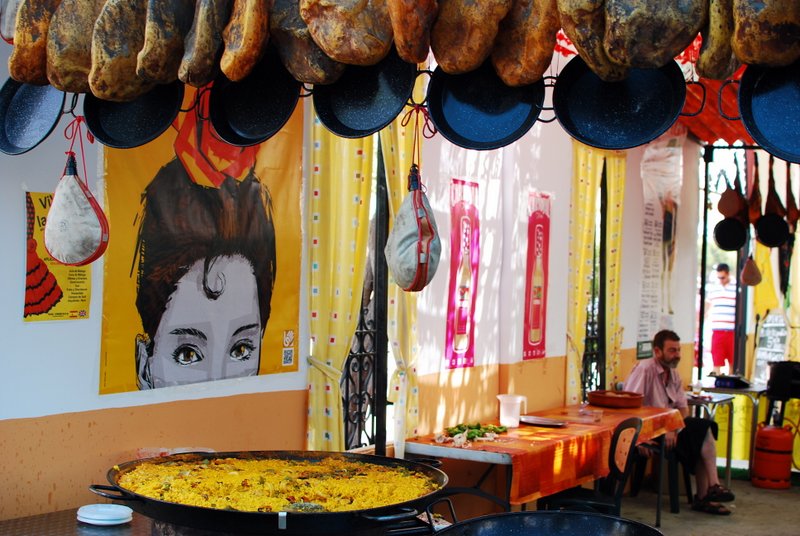
The following morning (what with the hangover!) we decided to enjoy a leisurely Spanish breakfast coupled with a strong cortado (espresso with little milk) and make friends with some locals. Morning well spent, we got into our car, put on our favourite road trip playlist over at Argus, and off we went to explore the surreal rock formations near the quaint village of Antequera. The layered rocks are a sight to behold and the neighbouring village of Antequera is right out of a Spanish fairy tale – cobbled streets, majestic churches, street side cafes, and a towering castle.
Read more about our adventures at the surreal rock formations in Antequera (opens in a new tab).

It’s not possible to visit South of Spain and not visit the mighty Alhambra. Make a day trip out of it, and instead of taking the highway, opt for what is now called the “old road to Granada”. The serpentine road will take you through vineyards, rustic houses, treacherous mountains, and our favourite, Rio Frio, a tiny hamlet which is known for Trout fishing. We’ll be writing a detailed post on this day trip soon, so watch this space.

Accommodation in Malaga
Like we mentioned before, we stayed in Benalmádena , a 20 minute drive from Malaga. The village and the beach were definitely quieter than Malaga, especially in the carnival season. You can compare and book a hotel here .
Valencia and Bunol (3 days)
Valencia is a bustling city and it’s easy to spend a couple of days just walking around countless Plazas (squares), sampling tapas in hidden tapas bars, and sipping on the local drink, Horchata, a traditional beverage made of ground almonds. The highlight of this segment of our road trip, however, was the day we spent in the tiny village of Bunol, made famous by the annual Tomato throwing festival, La Tomatina. Thousands of visitors descend upon this otherwise sleepy village to partake in the biggest food fight in the world. How could we have stayed behind? We can safely say we came out with a lot of bruises and an aversion to tomatoes, at least for the next couple of days. If you can, definitely plan your Spanish road trip so that you can enjoy the madness in Bunol. La Tomatina festival takes place on the last Wednesday of August each year.
If you do make it to Spain during the last week of August, don’t miss out on the wine fight that happens in Haro near Valencia . Participants pour wine all over each other using water pistols, glasses, and buckets at the La Batalla del Vino festival. Expect unending dancing and revelry.
Recommended Reading : Our experience at the Tomato throwing festival, La Tomatina (opens in a new tab).

Accommodation in Valencia / Bunol
We would recommend staying in Valencia instead of Bunol – Bunol is a tiny village and accommodation options are limited. Valencia has tons of places to suit all budgets and needs. You can compare all hotels and book here .
Figueres and Costa Brava (3 days)
Figueres is known for the The Dalí Theatre-Museum , which is the largest surrealistic object in the world and houses the largest collection of Dalí’s paintings and sculptures. It’s easy to spend an afternoon in the museum. Owing to the popularity of the town, accommodation is sometimes difficult to come by, so it’s best to set base in one of the neighbouring quaint villages like St. Miquel De Fluvia.

There is no dearth of picturesque towns in the Catalonian region, Cadaques being one of the most popular ones. For us, however, the medieval town of Besalu and the seaside town of Begur stole the limelight. This region boasts of some of the most spectacular drives and scenery in Spain, not to forget vast expanses of sunflower fields.

On the last day of our road trip, we spent the entire afternoon lazing on one of the hidden ‘Calas’ (coves) that are commonly found in Costa Brava. Looking back on the last 10 days, we realised that we had seen so much, met such amazing people, eaten some of the best tapas, and sampled lush wine. The following day we drove to Barcelona to catch our flight back to London.
Accommodation in Figueres / Cadaques
We stayed in a tiny village called St. Miquel De Fluvia. To be honest, you won’t go wrong if you choose any village/town to stay in this region. If you don’t mind the crowds, then definitely go for Cadaques . If you’d like to be in a quieter place, then look for a hotel or apartment near Figueres .
The next road trip to Spain, this time through central Spain, is currently being planned as we pen this post 🙂

- We opted for self-catering apartments in Malaga, Valencia, and Figueres. The cost was roughly £15 per person per night on an average. You can find more details in our Where To Stay In section .
- Car rental in Spain is cheaper than other European countries. We paid £15 per day for a 5-door economy car from Hertz. There was NO one-way drop-off fee when renting with Hertz.
- There are two kinds of highways in Spain – Autopistas and Autovias. The former are mostly toll roads, so if you want to save some money, use the Autovias which have a lower speed limit.
- All towns and cities are well connected by road and it’s easy to drive in Spain. As always, it’s handy to have a GPS during your road trip, especially if you like to take detours to discover hidden gems like we do.
- For your visit to The Alhambra, book in advance as the tickets run out fast. The combined ticket to Alhambra, Generalife, and the Nasrid Palaces costs around 14.50 Euros per person. Keep in mind that you have to choose the time of your visit to the Nasrid Palaces when booking the ticket, so plan your day-trip accordingly.
- Entrance to The Dalí Theatre-Museum is 12 Euros per person, but in summer, there is an option of a night time visit, which comes highly recommended from us. Tickets for the night time visit cost 13 Euros per person. It’s strongly advised to book in advance.
We have been to Barcelona and Madrid on city-breaks in the past, so we wanted to do a road trip that would take us to some offbeat places in Spain, and this particular itinerary did not disappoint. From grand palaces to barren deserts, from windy beaches to the snow-capped mountains of Sierra Nevada, we saw it all.
If you are planning a road trip in Spain, you can read all our posts about Spain here (opens in a new tab).
If you love driving as much as we do, you should definitely check out our epic Iceland road trip (opens in a new tab). We can guarantee you that you will be tempted to pack your bags and leave for Iceland 🙂
Drop us a line if you have questions about planning and places to visit – we’d love to help. If you have done a road trip in Spain already, share your tips with us in the comments below 🙂

Previous Post
Offbeat London – Alternative Things To Do In London

Visiting Saigon’s China Town – Travel Fashion in Vietnam
151 thoughts on “ the ultimate spain road trip itinerary ”.
I haven’t done a road trip in Spain, but watching “Spain: On the Road Again” has made me long to go on one to last for weeks, driving, photographing, eating (rinse & repeat). Fantastic! I’ll have to keep your post in mind!
Wouldn’t that be amazing ? We would love to spend 3-4 weeks (or more) driving through Spain. We absolutely love Spain !
Hi is Spain a good idea in January around 19-26th jan.. I’m planning to travel for my anniversary
Yes. Spain will be nice in January too, albeit a bit cold.
Spain Spain Spain !!! I so badly want to be a part of the Tomatina festival some day 🙁 🙁
You should go in 2014 – you’ll love La Tomatina. Maybe you can do a similar road trip to what we did 😉
Planning a similar list part of our bucket list.A bit older but looking forward to the adventure
Tell us how it went 🙂
Great job guys! I’ve been longing for Spain for a few years now and have it on my list for the next few years. Will definitely keep this in itinerary somewhere safe for future. Can I ask, how did you find driving in Spain vs driving in the UK?
If you haven’t driven in Europe before, then you might find driving on the other side a bit tricky to begin with. But you soon get used to it. Driving in Spain was fine as long as you stay out of busy cities. Spanish countryside is very beautiful 🙂
Well done! I will add this into our “to-do” list. Looking at all these road trip posts, I am desperate for one. Have you guys ever done a road trip through French alps?
Hey Snigdha,
We love driving wherever we go – we have driven in the South of France in the French Riviera but didn’t go further north. That post will be up on the site soon )
Yes, this is on my to-do list so badly! Great idea for a road trip, thanks 🙂 I’ll be looking to do something like this in the next year or so.
We are sure you’ll have an amazing time in Spain. Everything about the country is gorgeous.
Ooh, fun! Where are you planning to go for your central Spain road trip? I lived for three months in Merida, the capital of Extremadura, a town full of Roman ruins which receives so few tourists it’s almost like you have them all to yourself most of the time. And I had no idea car rental was so cheap there…if only I could remember how to drive!
Car rental was in fact super cheap. So much so that we had to check twice that the rental agency hadn’t made a mistake 😉 We’ll go to Madrid, Salamanco and Toledo. Merida sounds amazing – we’ll definitely factor that in. Cheers for the tip !
In 2008, I met my then 21 year old son at the Madrid Airport. We rented a car and did a 4 night trip that was a loop with stay-overs in Segovia, Salamanca and Toledo (with a day stop in Avila). Between Avila and Toledo, we drove through the Gredos Mountains. This was a reasonable itinerary for the amount of time we had. My son did the driving. I thought it was because he liked to drive. I only learned later that the only thing he hates worse than driving is the thought of me driving.
That is quite a funny story. I’m sure you guys have a good laugh about it now. The places that you visited sound so amazing – we will be covering those on our next road trip in Spain 🙂
Gadhe !Awesome website! Just started going through it to plan my trip to Spain in end-of-June/first-week-of-July for work+leisure.. Too bad I will miss both the bull run and tomatina, but can’t change my travel dates.. 🙁 Expect a lot of queries from my end! :))
Thanks a lot 🙂 Of course – let us know what all questions you have and we’ll help you plan an amazing itinerary for Spain 🙂
and this post goes in my Life’s top 10-to-do list !!!
Priyadarshini that’s a good choice for a top-10 list. It was definitely one of the best road trips we have done.
What’s so great about Spain is that you never run out of things to do. Most of the great stuff is hidden in the small towns anyway! My favorite villages are Mondoñedo (Lugo), Cangas de Onís (Asturias), Garganta la Olla (Cáceres) and my boyfriend’s hometown, San Nicolás del Puerto. Pueblos have the cheapest food, the best fiestas, and the cutest grandpas!
All the villages you mention sound amazing. For our next road trip through Spain, perhaps 😉 I completely agree about the cutest Grandpas 🙂
We love Malaga too – The Carnival of Malaga should not be confused with the Feria which you went to in August. Carnival is in February – Both are great parties!!!
Thanks guys ! Your tips came in very handy. Yes, we are also planning a trip to Malaga during the Carnival in February:) Absolutely loved Malaga and the Feria
I love Spain!! You guys should definitely try going to Seville and Ronda sometime. They’re both beautiful and for Ronda, you can even do just a day trip. We drove from Granada to Seville and took a 4 hour break in Ronda.
We have been to Seville – way back in 2009. We were completely bowled over by the city. It’s one of our favourite places in Spain. We really wanted to visit Ronda on this trip, but since we had to go up north and attend the La Tomatina Festival in Bunol, we had to give Ronda a miss this time. Will definitely go there next time. Thanks for the heads-up 🙂
savi and vid awesome job. Spain has been on my mind for a long long time and this is how we’d exactly want to do it. I am going to keep this bookmarked for future use 🙂 Love the name, the content everything about this site. Thumbs up from me !!
Thanks Sneha 🙂
We loved this road trip through Spain and are planning another one for next year 🙂
Hi guys, great post! I did a 6 day road trip a few years back starting in Malaga and going to Ronda, Marbella, Casares, Granada, Gibraltar, Las Alpujarras and Nerja. I loved Analucia – definitely my favourite part of Spain. The moorish history, mountain towns, hiking and white washed buildings were incredible. Looking forward to reading about your next trip!
Your trip sounds amazing Katie. We love Spain 🙂
the name says it all . Spain seems to be definitely ultimate.. !!! everything from tomato fight to scenic beaches .. all looks amazing !!! 🙂
What a great itinerary, and beautiful pictures! Was the first European country I visited, so it has a special place in my heart. I only went to Valencia and Madrid, but I’ve been dying to go back ever since. Hopefully one day I’ll be able to do a trip as cool as this!
Hannah Spain is one of our favourite countries. We’ve taken a number of trips in Spain, but this road trip itinerary ranks right up there as our favourite one 🙂
What was the total cost incurred during the road trip? Was communication ever a problem?
Hey Anmol, the cost of a road trip in Spain depends on the place you’re flying from and the accommodation you choose. Just drop us an email with the details and we’ll get back with an estimate of costs 🙂 Communication isn’t a problem. One can get away with English in most places
An indepth exploration of Spain (beyond Barcelona, which we’ve visited) is high on our travel wishlist. The Alhambra and Grenada (and Seville and Madrid) is calling to us! But we’d prefer not to deal with the stress of driving. Hopefully Spain has a good train system like the rest of Europe?
Spain does have a decent rail system but it’s possible to explore a lot more with a rental car. The Alhambra and Granada are gorgeous – you must explore them soon 🙂
I haven’t done a road trip in Spain (yet), and after reading this post, it’s now on my bucketlist!
Spain is one of our favourite countries for a road trip Valerie – one is almost guaranteed perfect weather, scrumptious food, and picture perfect villages in every corner of Spain 🙂
I was planning a 10 days trip to spain with friends.We have for 5 places in mind.Barcelona,madrid,valencia,ibiza and formentera.Could you please suggest best road trip possible from these 5 places.I was thinking of barcelona to madrid..
We’d suggest driving from Barcelona to Malaga (along the coast, via Valencia) and then flying to Ibiza. To be honest, 10 days might not be enough to enjoy all these things, but if you must, drive from Barcelona to Malaga over 6 days and spend 4 days in Ibiza and Formentera.
This looks like a perfect itinerary for a road trip!! I will be going to Spain in Winter with my family and I think theres a high probability of us using your suggested itinerary. Too cool to be missed! 🙂 Thank you for this!
Nurin a couple of our readers have followed the exact same itinerary and they loved it. We hope you have a great time too 🙂
Great post! I’m planning to do a coastal road trip similar to yours but in the last week of dec and into January. Have you been to Spain during those times? I heard the winter on the Mediterranean side is quite mild. Any advice would be appreciated. Thanks! Ps did you pass by any vine regions on this road trip?
Thanks ! Glad you like it. You’ll have a great time in Spain. We have never driven there in December, but I’m certain that as long as you don’t go up the Sierra Nevada, you should be fine. Winter will be mild (around 15 degrees Celsius). We once went to Seville (south of Spain) in December and it was amazing. As for vine regions, we did see some near Almunecar – initially we had planned to visit Bodega of Horacio Calvente (very close to Almunecar) but thanks to my constant stops for taking pictures, we had to skip the detour to the vineyard since we had to drive a long way to Valencia that day.
Have a great trip and let me know if you have any other questions 🙂
Hey guys – Enjoyed reading your travelogue. One question though – Do you guys have an international driving license or will the Indian driving license work for car rentals in Spain? I am planning to follow the same itinerary in Q1-2015 🙂 Cheers!
Hey Akash – the Indian driving licence works well 🙂 Have fun in Spain
I recently discovered your blog and I am honestly addicted to it! I love travelling so much… I just wanted to ask you, I am planning a holiday to Spain as I have never been, which one city would you recommend? I love your pictures with the sun flowers and beautiful postcard beaches, but ideally would like to go somewhere with a lot to do (kid friendly things) as I will be going with my family and we all like different things. Your response will be much appreciated! 🙂
Hey Shazia – we’re sorry for the late response. If it’s your first time in Spain, then Barcelona is a great city to begin with. The city itself offers lots of kid-friendly activities and the sun-flower fields that you love are just an hour’s drive away 🙂
Hi guys, I’m from India and live in Delhi. My wife and I are planning a short road trip in spain around end May 2015. I would really appreciate it if you could share your email or telephone number with meso that I could connect with more details. My email is [email protected] thanks guys
Hey Sanjeev – drop us an email using the ‘Contact Us’ button you see on the top right 🙂
Hey Guys, great job on the blog!
Me and my future wife are gonna be travelling to spain for my honeymoon. Were renting a car and wanting to hit all the hot spots and gems in southern spain. Any ideas on where we should be going? We originally planned on flying into Barcelona and driving south but Im thinking we should be flying into Malaga first. Is there a language barrier in the large/small towns. My fiancée has celiac disease (gluten-free), do you think it will be difficult for us/her at restaurants. If so what option/route should we go? Thanks Tony
Hey Tony – English is widely spoken (and understood) in Malaga. Communicating gets a bit harder as you go deeper into the countryside, but it’s nothing a few fervent hand gestures can’t solve 🙂 There are a few speciality restaurants in bigger cities but it might be hard for your fiancée to find food in restaurants in smaller villages. But there are always supermarkets and there’s nowhere better than Spain for dozens of picnics in the countryside 🙂 Hope you have an amazing honeymoon
Hi guys, We did a Spain road trip as well.. And your blog really helped us. We wouldn’t have discovered cadaques without you guys! I am completely hooked to your posts !
Aww thanks Shilpa – so good to know! We hope you continue to enjoy our adventures around the world 🙂
Hey Savi Vid,
Am I glad that I found this post 🙂 we are three families with teenage children from India planning a road trip in Spain in the second half of June. We have 7 days with us and plan on doing Barcelona to Valencia to Madrid.
Can you recommend if hotels are a better option or apartments ? Also the area which is central and good to stay. Also the absolutely must visit places in these cities ? Will appreciate your inputs !
Hey Reena – I think apartments are always better when you’re travelling as a family 🙂 We booked some great ones through Air B&B and GoWithO. You can check out detailed reviews of all our accommodation in Spain in our ‘Accommodation’ section here: https://www.bruisedpassports.com/category/where-to-stay-in
I’m so glad to chance upon your site as your experience would hopefully help me with my itinerary. I am planning to rent a car in Madrid and drive up to Barcelona and then back, with a stopover at Zargoza.
Here’s the thing that makes me think twice about driving. Is it really that bad to drive in the city? Understand parking will be bad but i’m searching for apartments via airbnb that offers free parking space. Is it advisable to drive in the city to places of interest or should i just park my car and use their public transport? Hear from you soon!
In places like Barcelona and Madrid, it can be tricky to drive in the city, especially in office hours. Many of the places in Madrid and Barcelona are well connected by public transport so you should just use that when you can. For driving a bit out of town or for day trips, you can use the car 🙂
He, we are planning to visit Spain and start from Barcelona for about 10-12 days and mostly a road trip… What are ideal days to be at each location.. Cities which we want to cover are Barcelona, Valencia, Seville, Costa Brava, Madrid Ibiza and granada.. Please help
You shouldn’t try to visit all these places in one trip – Ibiza is an island so you will have to take flights to and from. We would recommend 2 days in Seville, 1 day in Granada, 3 days in Madrid, 2 days in Barcelona, 3 days in Costa brava. You can leave Valencia and Ibiza from this trip or it will become too hectic.
Hope this helps.
I’ve been planning to do a roadtrip like this one…seems amazing!! I have finally a starting point in Spain and you made it easy for me to want to go. I’m portuguese and I’m planning to start in Portugal and go to Spain through the South. Since I have time I want to continue and go through the north to Pamplona, San Sebastian Vigo and back to Portugal. Do you have any recommendations to these areas? Are you considering to do a roadtrip in Portugal? We have amazing places that you would enjoy also.
Hey Pedro – we loved driving around in Portugal but we’re yet to write about it (we visited Portugal before we had our blog, so it’s one of those stories that never got written!). Pamplona is a great area, less touristy and every bit as amazing as the rest of Spain. Try to rent a cottage/apartment in the countryside – it makes for a perfect base to explore the area
Savi & Vid – if you like the occasional nature tour, check out SpainBirds, they offer several different guided tours (in English) to national parks or wilderness areas in Spain to spot local birds and if you are lucky to see an Iberian lynx. They also go to Morocco…cool! A thought for your next trip to Spain. You can learn more about SpainBirds and other eco tour companies by country destination on my new directory website, EcoTourLinQ.com. also @EcoTourLinQ Cheers!
Hi Savi & Vid,
This road trip looks enchanting. I was planning to go to Spain with my family and 6 month old nephew. Since we have never been to Spain before, is it possible to add Madrid and Barcelona to this itentiary? Do recommend.
Madrid might be a bit out of the way (or not if you have 4-5 extra days) but Barcelona can definitely be added – it was on the way from Valencia to Figueres but we didn’t stop there this time as we have been there before 🙂
Hope you have a great trip.
Amazing.. I also read ur Iceland trip.. Thanks a ton.. Now.. I m planning Spain by road in September.. 15 days.. Starting around Sevilla.. Upto barcelona.. Ibiza for a couple of days.. Harley or car? What do u suggest Thanks again
Whatever floats your boat, Tarun 🙂 We really can’t comment on that – depends on your tastes and travel style. All we can say is that irrespective of what you choose, you will have a great time in Spain 🙂
Hi Savi and Vid,
Nice post there. I am visiting Barcelona for four days in the first week of September along with a friend. We have already booked a car (a convertible BMW, thanks to much cheaper rental prices than other countries!) and would like to do some rugged road trips instead of just spending time within the city. So we were planning to drive all the way down to Valencia with little stops here and there and then of course come back to Barcelona as we have our return flight from there. (I might get to meet a friend at Valencia, so can’t change the route)
So I have come across names like Sitges, Montserrat, Tarragona, Peñíscola, etc. What stops would you suggest me? We could do some onward and some on our return.
Any kind of suggestion for this driving route would be really helpful. Thanks buddy.
Warm regards, Lalit
We didn’t stop at many places in that stretch because we wanted to get to Figueres from Valencia. We had lunch at Peniscola and it was nice.
Have a great trip – with that car and the sea on one side, it can’t really go bad 😉
Hello, coming all the way from Australia and planning to travel around Spain and Portugal for about 18 days, starting probably in Madrid or Barcelona. Must see San Sebastian and would like to see the coast,places of beauty, not toooo touristy. What would you recommend? We are in our late 50’s, fit and healthy, can get around but don’t want to ride pushbikes! We would prefer to drive, stop, look around, have a bit of lunch, drive some more, look around some more, stop again, settle for a night or two in palace of interest and then go again. Many thanks, Sue
Perhaps you could start in Barcelona, spend a few days in the city, rent a car, drive to Cadaques or a neighbouring village, spend a couple of nights in Costa Brava. Then drive to Zaragoza or Girona depending on what you prefer and on towards San Sebastian. We haven’t explored the northern part of Spain so won’t be able to comment much.
We definitely recommend Costa Brava though 🙂 Some parts might be touristy, but some are absolutely amazing. We really enjoyed Besalu and Begur. Just rent a car and explore – you’ll definitely come across a hidden gem – Spain is full of those 🙂
Hope this helps. Have a great trip in Spain 🙂
hey guys…great post !!! I think you guys can help me out. Me and my wife are landing to Valencia in early feb. We have 3 days of work there. After that we want to extend our trip for another 6 days to other parts of spain. Now we should add Barcelona side to it or go for andalucia and Marbella/Malaga. We are more interested in spanish culture, food and wines. We will prefer a self driven car with scenic beauty and stopovers at beautiful villages. What do you suggest.
Hey Nitin – both areas have their pros and cons but you should choose Andalucia and Malaga if you enjoy scenic drives and culture 🙂 There are tons of incredible villages and gourmet tours along the way
Hi guys, Have just discovered your website whilst looking for a good guide book to Spain. My husband and I are planning a road trip through Spain, driving down from France and heading to the south of Spain as quickly as possible(although I am tempted to get some info on flights and hire cars after you saying how cheap that is) We spent 4 days in Seville just before Christmas and loved it, and we are particularly interested in places that have had major peninsular war connections. Any suggestions woud be gratefully received! Alison
How about driving down the eastern coast of Spain – Girona, Costa Brava, Valencia, Almeria, Granada, and Malaga. To really enjoy this stretch, you will have to dedicate close to 10 days or so 🙂
Hi! Can we drive around with an Indian license?
Hey Richa – yes you can drive in Spain with an Indian driving license 🙂
I dont think you can drive with an Indian Driving Licence. Right now I am in Spain only for holidays and have got my International Driving Permit. I came to this conclusion after too much of search and gather info from so many people. Some car companies like sixt dont care what licence you have but if you would caught by the cop then you will have to pay hefty fine. According to my information, only EU countries issued licences are valid to drive in Spain.
Hey Nitin, an International Driving Permit is nothing but your licence translated into English. Since all driving licenses in India are already in English, we don’t think it should pose a problem. However I’d like you specify that we’ve never been stopped by the cops, so we can’t base this on experience. It’s best to verify this with local authorities before renting a car 🙂
Hey Savi Sid
I have rented a car from Gold car and specifically asked if IDP is necessary. Their reply was that the car rentals just required the regular licence in English but if in case you get caught by the cops then you will be in trouble. So I would recommend to get IDP to avoid the problems and Richa getting IDP is not a big deal in India. I got it in one day only with the validity of one year. The one thing I found strange that the Gold car rental company asks for atleast one year driving experience. Otherwise they dont give you the car.
Where is the first picture taken? I am looking into a road-trip through the south of Spain and want to go to as many beach towns as possible.
Hey Lizzy – the first photo is from Cadaquez 🙂 Have fun in Spain
Need Help in building by itinerary for spain in may. its a 10 day trip..please help. i will land and depart from madrid
Hey Vineet – you’ll find all our favourites above. Just pick and choose the towns/cities you find interesting and cover those in the 10 days you have 🙂 Cheers
Hey guys !! We are planning for Road trip through Spain this July August. Will really appreciate the guidance for Route, Things not to be missed, must visits, and accommodations… Trip duration is no bar for us… We can spend put o 3 weeks !!
Hey Sriram – we’ve written everything about our favourite route, things not to be missed in Spain and the accommodation in our articles. Just go through them when you have a moment 🙂 Here’s the link: https://www.bruisedpassports.com/category/spain
Hi We are planning a road trip spain and love the idea of road trip . how did u guys get the driving permit for spain .we r from delhi and dont have international driving permit . Althou we did a road trip thru new zealand 4 years back but they accept indian driving licences. Please help.Plan to go in sept . Also did u do skydiving and scuba if so …please share ur experience
Hey Rashmi – we used an Indian Driving License in Spain. It worked ok 🙂 September is a great time to go to Spain. We didn’t go skydiving or scuba diving in Spain.
Thanks a ton …ur blog is super cool and inspiration for travel adventures . Mite keep bugging u guys till I go to Spain .but just wondering if Ibiza and Majorca will be worth a visit in sept. Also is staying in Marbella as a base in Malaga a better option.
Thanks Rashmi – hope you have an amazing time in Spain. Ibiza and Majorca are great during September – however do beware it is still tourist season, so they will be quite busy. As for the better base out of Malaga/Marbella, that depends purely on what you have planned for your time in Spain 🙂
Hey Savi, do u advise a road trip from Malaga to Barcelona with a one night stop ever in between , maybe at valencia
Hey Rahul – you could definitely do that but do beware that you’d be driving for the majority of the time. This itinerary won’t leave you with any time to explore the places along the way
Hi I just came across your link while trying to plan a road trip to Spain.may be you can suggest what is the best wat to plan it we are planning to leave from NJ to Barcelona on sept 1st & return on Sept 7th.we would like to see Barcelona,Valencia,Sevilles,Grenada not sure if we have enough time to do Madrid also. I am open to suggestions & alternate cities if it comes highly recommended. Thank You
Hey Poonam – think that’s a LOT to fit in a week. You’ll end up spending most of it in transit. We’d suggest sticking to Barcelona, Valencia, and Costa Brava (gorgeous beaches). If you want, you could add Zaragoza to your itinerary instead of Valencia. Hope this helps 🙂
Hiiii guys.. love love your blog. Thank you for all the information you provide, so helpful!! We are planning a trip to Spain in December and were planning to do Madrid – Seville – Granada – Valencia – Barcelona. We were thinking of driving from Seville – Granada – Valencia. Would you recommend the drive? Is it beautiful or should we rather take the AVE?
Thank you in Advance! Manika
Hey Manika – that’s a great drive. Try driving by the coast as far as you can and you’ll love it 🙂
Thank you! Let me check Maps, i think i saw AP7 being the coastal route 🙂 Thanks Again!!
But, is December a good time to drive here? Wouldn’t it be windy and hence too cold, to be at the beaches? Thanks.
Yes December will be a bit cold for the beaches – we did this road trip in August!
Hey, just came across your link , very interesting and inspiring to do a road trip , just wanted to check how safe it is to drive around in Spain and do u think Madrid can be included in a 10 -12 day trip Thanks
It’s absolutely safe to drive around in Spain. Yes, of course you can definitely include Madrid on this trip 🙂
Hi, I sent a private message few days back, don’t know if you received it.
Hey Payal – we wrote back to you. Hope you got it ok
Hi Savi Vid,
glad that i found your trip internery ,, just let me know how about parking facility in spain ..can we park nearby attraction we visit?
Hey Jaya – parking varies from place to place. Generally parking in larger Spanish cities is expensive but plentiful. Hope this helps 🙂
Thanks so much for your detailed blog! My friend and I are planning a trip to Spain this April. I have a few questions!! My first two questions are about the Andalucia region specifically, because this is where we will be renting a car! 1) How is the terrain in the countryside? Is it steep/mountainous? We’re a little scared to drive in mountainous areas, especially if there’s no fence on the side of the road! 2) How are the drivers (in both the city and the country)? We’re from the states and drivers here are pretty tame, so we do not have much experience driving with aggressive drivers. 3) We are thinking of driving from Granada to Gaucin/Ronda/Grazalema area (to do some hiking). Then from there to Jerez de la Frontera. And finally from Jerez to Seville. Any general suggestions about the itinerary?
Next I wanted to ask about Costa Brava. My friend and I are thinking of renting a small boat to navigate around the coves. Is there a lot of boating traffic in this area? Would you say this is a good and safe way to get around the coves, or do you guys have any other suggestions? Thanks!!
The terrain is not very difficult to drive on, even when driving through the mountains. The drivers are absolutely fine and drive in a sane fashion. Your route sounds fantastic – try and drive on the old road to Granada (I believe your friend Divya messaged regarding that on another post).
As for Costa Brava, we didn’t hire a boat to explore the coves so can’t comment on that. Sorry 🙂
Have a great trip
hey hi how much did this road trip in spain cost?
Hey Anchal – the cost depends on the kind of hotels you choose and the place you’re flying from. But once you’re there expect to spend around $100 per day on fuel, car rental, food, activities etc
Hello! Thank you for your post. We are six friends travelling to Spain in May 2017. We land in Barcelona and take from Madrid. After spending 5 nights in Barcelona we plan to hire a self-drive a car to costa brava. There we are staying for a night and doing scuba diving next morning and spending the day there. Next Morning we plan to leave south for Valencia and drop the car there. From Valencia we would like to go to Seville. Since we are in our early 20’s and not having much experience in driving we want to avoid driving for long distances.
My questions are. 1. How much will car rental from Barcelona to Valencia cost which can accommodate 6 adults with 6 suitcases and handbags? Which car can you suggest? From where in Barcelona should we rent a car?
2. Is it a good idea to go to costa brava only for scuba diving?
3. How is the journey from Costa Brava to Valencia? Is it a costal drive?
Hey Yash – I don’t think most cars would accommodate would that much luggage with 6 adults unless it is a mini van. I’d suggest renting 2 4X4s. We use a price comparison engine to get the best prices. Here’s the link: http://www.economybookings.com/?lang=en&btag=bruisedp
Costa Brava is great for Scuba Diving and Costa Brava-Valencia is a beautiful costa drive.
Thank you for sharing your post! This is so very helpful as I’m currently trying to plan a road trip down the coast of Spain. I was wondering how long in advance you booked your car rental through Spain? It caught my eye that you didn’t pay a one-way fee, which is rare and something I was hoping to jump on as well. Any tips on renting a car? I have a rather large group of 6 that I’m planning for, so it’ll be an adventure!
You’re welcome 🙂
We booked the car 6 weeks before our trip and were happy that we didn’t have to pay a one-way fee. A lot of car rental agencies have these offers from time to time as they need to relocate the vehicles so they’re happy to waive off one-way fees 🙂
Hope you have a great trip 🙂
Hola Savi-Vid, Lovely pics there. What time of the year did you make this trip? We are contemplating if August is a good time for a road trip on the southern coast. Gracias!
We did this road trip in the carnival season – end August. As you can see, we had a great time. It can get really hot in places in August, but overall it was amazing!
We are planning a road trip to Spain this July 2017, So could you help us in brief the places we should cover, we are there for 9 days with both start and end point in Madrid. Barcelona is a must in our list. Also if you could suggest us a good festival/carnival around that time as we are going to miss La Tomatino.
Hey Rahul – we’ve mentioned all our favourite carnivals and places in Spain in this itinerary. You can pick and choose the ones that suit your interest. July isn’t carnival time, so there are a few going around.
Hi Guys! First visit to your site by searching for Road Trips to Spain. Interesting stuff here. Nice to see what you guys are doing. We are 4 adults & are planning a Spain holiday. Were looking at 2 days driving in Spain and then flying to Ibiza & Barcelona. For 2 days, what area of Spain you would recommend; to do a road journey? Though seeing your above Road trip itinerary: THE ULTIMATE SPAIN ROAD TRIP; I feel like just copying & pasting it. But people in the group want to do Ibiza.
Hi Anubhav,
Thanks for dropping by. To be honest 2 days isn’t a lot to enjoy a road trip in Spain. However, you could rent a car in Barcelona and drive up to Costa Brava and spend a couple of days driving around that area – it’s beautiful 🙂
Have a great trip.
Hey guys! Really liked the site. can you please tell me more about Valencia to Barcelona road trip? Like if it has scenic roads and sea side roads? or its just normal drive!
You can opt for the coastal route – it’s a great drive but I wouldn’t call it spectacular. You should drive to the north from Barcelona (towards Cadaquez) – that’s an amazing drive!
Hey! Loved yoour post and have aleady started planning a road trip. I understand that yoou’ll stayed at Benalmadena and did day trips in your car to Malaga, Antequera, Granada and the beaches. Could you please tell me what the car parking scene was like in these various places (Malaga, Antequera, Granada (Alhambra) and the various beaches)? Is it possible find free parking and if not, how much should one expect to shell out for parking? Also, diid your apartment in Benalmadena offer free parking? I understand that staying away from Malaga city would be comparitively cheaper and would offer parking as well.
Hey you can find free parking in quite a few places but even if you don’t it’s not so expensive (around a euro per hour if it’s not bang in the town centre). Even in Malaga city you can find many apartments with free parking 🙂
Hey guys! This is the first time I have visited your site at the recommendation of a colleague. I have been wanting to do Spain for the longest time and this post has really gotten me excited. However, would you recommend doing an 8 days trip instead of a 12 days road trip? Also, is it safe to drive around with a 3 year old?
Yes, it’s safe to drive in Spain as long as you pay heed to simple rules and common sense 🙂
Yes you can definitely do an 8 day road trip – just cut out the places that don’t tickle your fancy 🙂
Is valencia better or Ibiza? Planning for Sept. Please recommend.
They’re both very different. Of the two we like Ibiza better
Hi guys, is there an entry ticket to the feria in Malaga? Also how good was it? Should I be mentally prepared for over priced food/drinks?
Hey there – no entry ticket to the street parties. A small entry fee for the actual Feria and drinks etc are priced a bit more than usual but not crazy overpriced!
Hey Guys. I am biggggg fan. Getting married in Nov. was planning a road trip to Portugal and Spain from end Nov to mid dec . Do you think it will be a good idea ?
Yes a road trip in Spain and Portugal is always a good idea 🙂
Hi guys, We are going to Spain and Lisbon for 8 days on our honeymoon, the entry point is Madrid and exit from Lisbon. We were hoping if we can do the road trip in Spain but don’t know if it would be possible in such a short duration. Can anyone please suggest any itinerary?
Hey you can always tailor the drive according to your preferences and days at hand 🙂
Spain v/s East Europe? Your pick? (For a vegetarian adventurous crazy foodie)
Spain is better as vegetarian food is more accessible
Hello We are a family of 7 traveling to Barcelona on April 1 and leave April 10, 2019. We are interested in driving from Barcelona to Gibraltar then back to Barcelona. Can you help with best route And stops so we get to see as much as possible. Also what is a good company to rent vehicle in Barcelona
Hey unfortunately we haven’t driven that route, so will be unable to advise!
Hello Savi and Vid!
Please keep inspiring us with your stories!! We are planning a trip to Spain this summer (Barcelona, Ibiza, Granada and Madrid). Can you help us with any specific not to miss things/food/places around? It would be great if you can direct us to any of your blogs on these places 🙂
Hey Reemki – instead of particular restaurants I’d suggest trying some fun local dishes. You can find suggestions here: https://www.bruisedpassports.com/wheres/best-things-to-eat-in-spain
First of all, I love your blog and have been following it for quite a while! 🙂
I am planning a trip to Spain in May and would love to have your inputs/suggestions.
My itinerary currently looks like this – Barcelona (4 nights) -> Malaga by flight (2 nights), which would include a day trip to Granada -> Seville by road (1 night) -> Madrid by road/train (2 nights)
Have a few questions for you guys:
1) What do you think of the itinerary? Do you guys think 1 night would suffice in Seville and 2 nights in Malaga? 2) Is driving around in Spain easy, if you’ve never driven in Europe? 3) Where did you guys stay in Spain? Do you recommend booking an Airbnb or a hotel? 4) Is Madrid worth the drive? FYI I’m traveling to Spain for the first time
Sorry for bombarding you guys with so many questions, but I would love to hear out your suggestions on the points above. Please let me know! Would really appreciate it.
Cheers! Aashray
Here you go: 1) Looks good. I’d say spend 2 nights in Seville and 2 in Malaga especially if you;re going to Granada 2) Yes it is. Just get used to it on the first couple of days 3) We’d suggest AirBnB 4) Yeah why not? Madrid is nice
Hope this helps 🙂
Hi Savi and Vid – Thank you for sharing the guide, so informative . Trip looks so satisfying.
I am actually looking out for Spain + Portugal guide for the months Nov – Jan If you can share any listing of festivals around the this time that would be great.
Looking forward.
Hey Shivani – unfortunately most festivals happen during summer months, so you will only find Christmas Markets in the bigger towns around that time 🙂
Hey Savi and Vid, Hope you are enjoying at home in Delhi.
I am a avid follower and you are my first travel blog I refer to before travelling anywhere. Going to Spain in July, and this is my first trip to Europe. I wish to see Madrid, Barcelona and will surely follow this road trip (duh?!). Can you suggest something where I can include Madrid and Barcelona also and what all to cover there? If you have an itinerary for there as well.
Hey Prerna – you can easily include Barcelona and Madrid in this itinerary. However would suggest renting a car on your last day in Barcelona as it is really hard and expensive to find parking in the larger cities 🙂
we are planning a road trip in Spain in the last week of October, what would you suggest ?
Great time to go – the tourist hordes have calmed down. The only con is some of the beaches might be quite chilly to swim etc
- Pingback: How To Prepare For A Road Trip In Spain
Leave a Reply Cancel reply
Your email address will not be published. Required fields are marked *
Yes, add me to your mailing list.

Campfire Magazine is supported by its readers. When you purchase through links on our site, we may earn an affiliate commission. Also, as an Amazon affiliate, we earn from qualifying purchases.
Driving To Spain From UK – Our Tips & Routes
Nowadays when you think about travelling abroad, your head immediately jumps to flying there.
The first thing you consider is reputable flight companies that don’t charge a bomb and different flight schedules that could allow you to enjoy as much time as possible overseas.
But one mode of transport that you might not immediately consider is driving.
Driving in foreign countries can seem slightly daunting at first, but when you think about all the incredible views you will be able to enjoy, that you wouldn’t see on a plane, it becomes an obvious choice.
*Please note this article was written pre Covid times so before planning your trip please make sure you check current restrictions around travel and Covid-19.
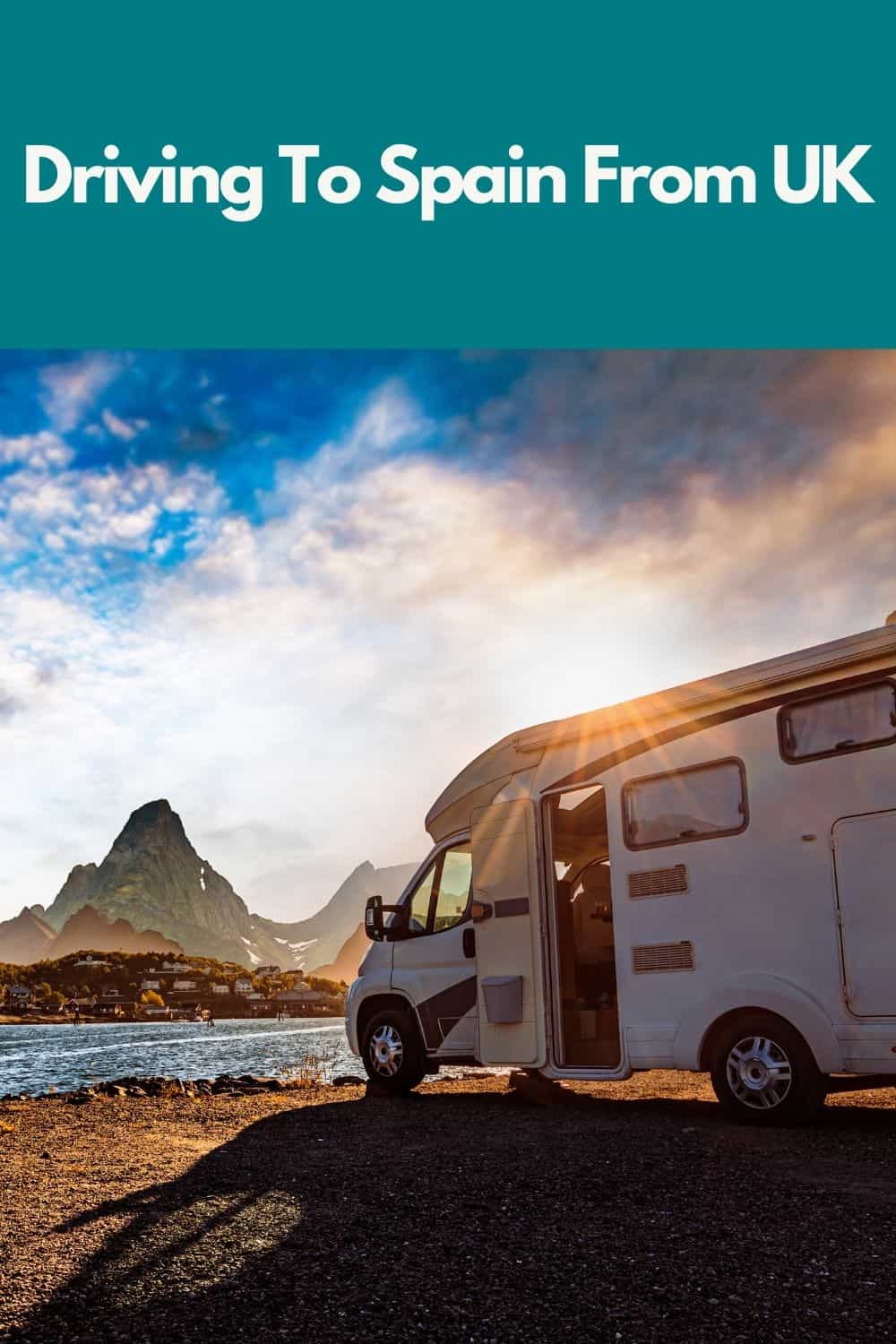
One of the most popular holiday destinations for people travelling from the UK is Spain, and understandably so.
Spain might seem like a long distance from the UK, but the drive is actually pretty easy, and it allows you to see all the beautiful sights that you would have otherwise missed out on.
In this guide, we’ll be taking a look at some of the best routes from the UK to Spain and plenty of tips to ensure that your journey goes smoothly.
Leaving the UK
The first part of your drive from the United Kingdom to Spain will require you to leave the island that we call home.
There are a couple of ways that you can do this, so let’s have a look at some of the options you have for crossing the channel.
Dover to Calais
Perhaps the most famous way to travel from the United Kingdom to mainland Europe is via a ferry crossing from Dover to Calais.
It has inspired many a song and is a great way to cross the channel as during the summer months up to 40 crossings of the channel are scheduled a day.
While it is not the quickest route to France, it is still fairly short as it only takes one hour and a half, which is just enough time for you to grab a bite to eat before you return to your spot behind the steering wheel.
This is one of the cheaper ways to cross the channel, and an excellent choice if you are trying to save your pennies for when you get to Spain.
It can be a bit time-consuming and does require waiting around while the staff controlling the ferry navigate getting all the necessary cars and vans aboard.
But it is an easy route and a great choice if you want to be able to relax as you cross the channel.
Portsmouth to Caen
If you want to cross the border via ferry, but fancy a change from the white cliffs of Dover, you can instead cross the ferry from Portsmouth to Caen.
This is a great choice if you live in the South East of England as it will require less time travelling here in the UK. But be warned, the ferry crossing from Portsmouth to Caen is more expensive than the crossing from Dover to Calais.
This point of crossing is a pleasant change from the most popular crossing point, however, it is more difficult to get a spot on this crossing.
In comparison to the 40 crossings made between Dover and Calais a day, the ferry crossing from Portsmouth to Caen only crosses three times a day. Once in the night and twice during the day.
So when you choose between Dover and Portsmouth, you should consider the time of the day that you want to travel and whether or not the Portsmouth crossing can do this for you.
The next choice you have is by far the fastest way to cross the channel from England to France, and that is, of course, the Eurotunnel.
Formally known as ‘Eurotunnel Le Shuttle’ this route is the fastest way to get across the channel as it takes only 35 minutes to get from Folkestone in England to Calais in France.
This route does require you using the tunnel that travels below the body of water that makes up the English Channel, so it might not be the best choice if you are claustrophobic.
But it is the fastest way to get across and is a great choice if you don’t want the hassle of trying to load your car onto a ferry.
It is a great choice if you are taking your dog on the journey with you, or if you have young children who are likely to grow bored during the crossing.
But be warned, it can get very warm during the journey through the tunnel, so wearing layers is key if you choose this option.
A Ferry to Spain
Alternatively, you may choose to cut out France completely and instead take a ferry directly to the Spanish border.
This is perhaps the simplest way to get from the United Kingdom to Spain if you want to drive once you reach Spain, but be warned as it does take a lot longer than the ferry to France.
You have a few options for crossing to Spain, some ferries run from Portsmouth and others run from Plymouth and they primarily take you to Bilbao or Santander in Spain.
This can be an expensive choice, and understandably so when you realise that this method of crossing the channel takes approximately 24 hours to do.
Few people choose this method of crossing as the 24 hours journey can seem off-putting, but it is a popular choice among those who want to limit their driving to just the UK and Spain.
Similarly, this is a popular method with those who would rather take it slow and reach Spain when they get there, rather than worrying about the time that it takes.
Other Ways to Cross
While we have already covered the main crossing options that you have from the UK to mainland Europe, there are some more obscure choices you can make.
These choices are great if you want to make your journey to Europe an adventure, and are happy to travel the road less travelled.
But bear in mind that if you choose one of these options you will have to be flexible as they run much less frequently than the crossings at Dover and Portsmouth.
Across the border of the South of England, you will find multiple smaller towns which run ferry crossings from their town to France. These towns include Poole, Newhaven, and Folkestone (where the Eurotunnel can be found).
From these towns, you will often find yourself entering France in someplace other than Calais, in smaller towns including Dunkirk, Le Havre, and St Malo. While you have to be flexible if you choose one of these options, it can be a great way to get a good deal.
So if you want to travel to Spain on a budget, you should consider choosing the road less travelled.

Driving through France
A lot of people choose to drive in France, and it is easy to understand when you look at the excellent conditions of the roads out in France.
The roads in France also travel through some beautiful areas, ensuring a scenic route whichever way you go.
But be warned, driving in France is expensive, especially if you are doing so in a caravan or motorhome .
You will also find that there are often disruptions which you will face during the journey through the country due to political tensions.
Here are some quick tips for driving in France:
- Watch your speed as there has been an increase in speeding fines issued to British drivers in France.
- Get an Electronic Toll Pass to avoid manually paying the tolls at every gate.
- Consider the weather, snow chains are a legal requirement in France for snowy weather.
- The drink driving laws in France are much stricter than the UK so remember this if you consider a glass of wine with food.
- You will need at least 6 months of validity left on your passport to drive through France.
The Best Routes for…
With these tips in mind, let’s take a look at some of the best routes for driving from France to Spain.
We have given you three options which have 3 main influences: price, views and speed.
First, let’s take a look at the best route with cost in mind. As this route keeps cost as the priority, you will notice that it will take slightly longer than other routes.
This is primarily because this route is designed with absolutely no tolls so that the money you are paying to drive to Spain is limited to fuel.
This route travels down the left-hand side of the country and a lot of this is made up of country roads rather than the dual carriageway which you might expect.
It relies heavily on the A28 and N10 toll-free roads to keep costs down, and because of this, there is a good chance that you will encounter traffic on the journey.
A lot of people choose this route to keep costs down and due to this regular traffic jams as you near the larger cities is common. On paper, this journey should take 15 hours, but due to traffic, you should be prepared for this to take longer.
This journey will take you from Rouen to Chartres to Poitiers to Bordeaux to the Spanish border area of Irun. From there you can then begin your journey to the area of Spain you desire to go to.
Next, let’s take a look at the best route if you want to encounter beautiful views while you drive.
This route isn’t boring and it will take you through some of France’s most beautiful cities before heading South and then across to Spain.
This journey begins with you travelling from wherever you crossed into France across to Paris. Paris is beautiful, and if you want to include some French areas on your Spanish holiday, Paris is a must.
You only have to watch a TV show or film based in France to see how daunting the prospect of driving through Paris can be. But don’t worry, there are plenty of places on the outskirts where you can stop off on your journey.
From there, this route takes you to Orleans which was once home of Joan of Arc and south through the beautiful French countryside and small villages including Clermont-Ferrand, Millau and Beziers.
The last place you will visit in France on this route is Perpignan which lies not far from the Spanish border. From there you can easily travel to Barcelona and begin your journey through Spain.
Finally, let’s take a look at the best route through France to Spain if speed is your priority.
For some people the views and cost do not matter, they simply want to reach their final destination in Spain as soon as possible.
With speed in mind, the fastest route to get to Spain from France is down the Western coast. This ensures that you miss the mountainous terrain of central France, and only use the roads that are easy to travel.
This route is by far the fastest, and it ensures that you can make the entire journey through France without needing to stop at any point if more than one person can take to the steering wheel.
This journey requires you to travel from the place that you entered France across to Rouen.
From there you can travel down to Le Mans, through Tours, and down past the French city of Bordeaux.
From there you can easily cross the Spanish border into the Irun area of Spain before travelling onto the location you choose in Spain.
Without traffic, you will be able to make this journey through France into Spain in just 10 hours.
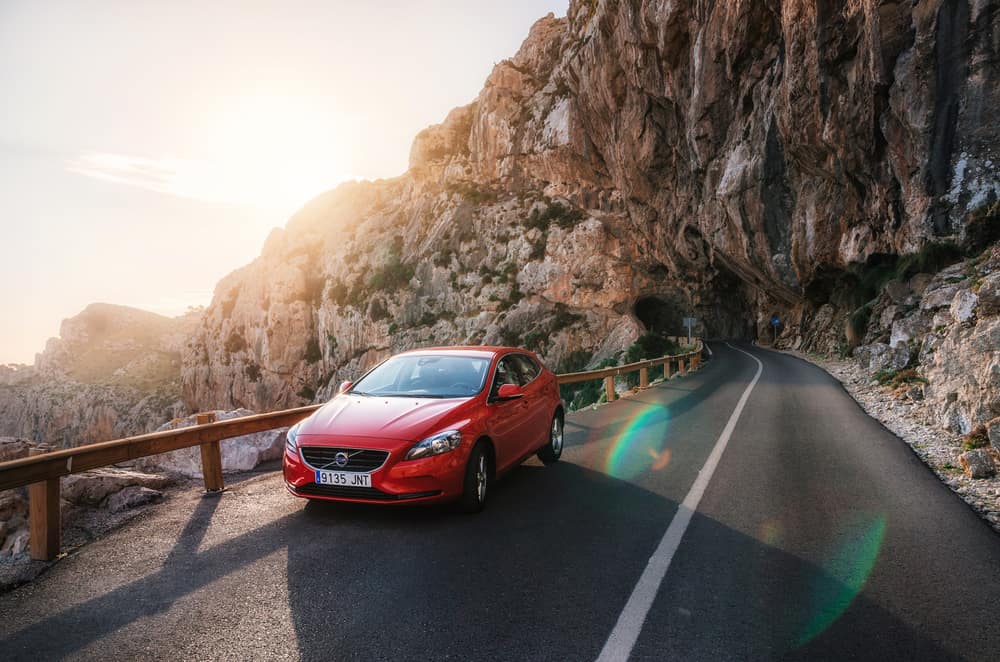
Driving through Spain
Once you enter Spain, you have reached your destination! In the same way that French roads are great to drive on, Spanish roads are also usually well maintained which should make your journey a breeze.
The best roads in Spain can be found in the centre of the country, but even the roads on the coast are perfectly safe to travel on.
Driving in Spain is incredibly relaxed, and you will often find that you are the only car on the road which is a big change from some of the traffic you will encounter when driving through France.
The roads in Spain are well networked, and you will find that it is very easy to get to the area of Spain that you plan on staying in.
Fuel in Spain is usually cheaper than both the UK and France, and the cost of tolls is much less pricey. So travelling in Spain is easy.
Here are some tips for driving in Spain:
- You must always carry your driving license when driving.
- You will need a green card to prove that you and your vehicle are ensured.
- Check the safety requirements for driving in Spain and what you will need to meet these.
- All screens must be kept out of the view of the driver (excluding sat navs).
- There is no need to avoid tolls as they are always reasonably priced.
In short, if you want to travel from the UK to Spain, you have lots of options on how to get there.
I n this guide, we’ve taken a look at the different options that you have and lots of different tips that will make driving to Spain easy.

Sign up our mailing list to claim your FREE Ultimate Camping Checklist PDF
I don't need to see this again, thanks.


The Ultimate Spain Road Trip Itineraries: Routes, Sights, Guides, Maps And More
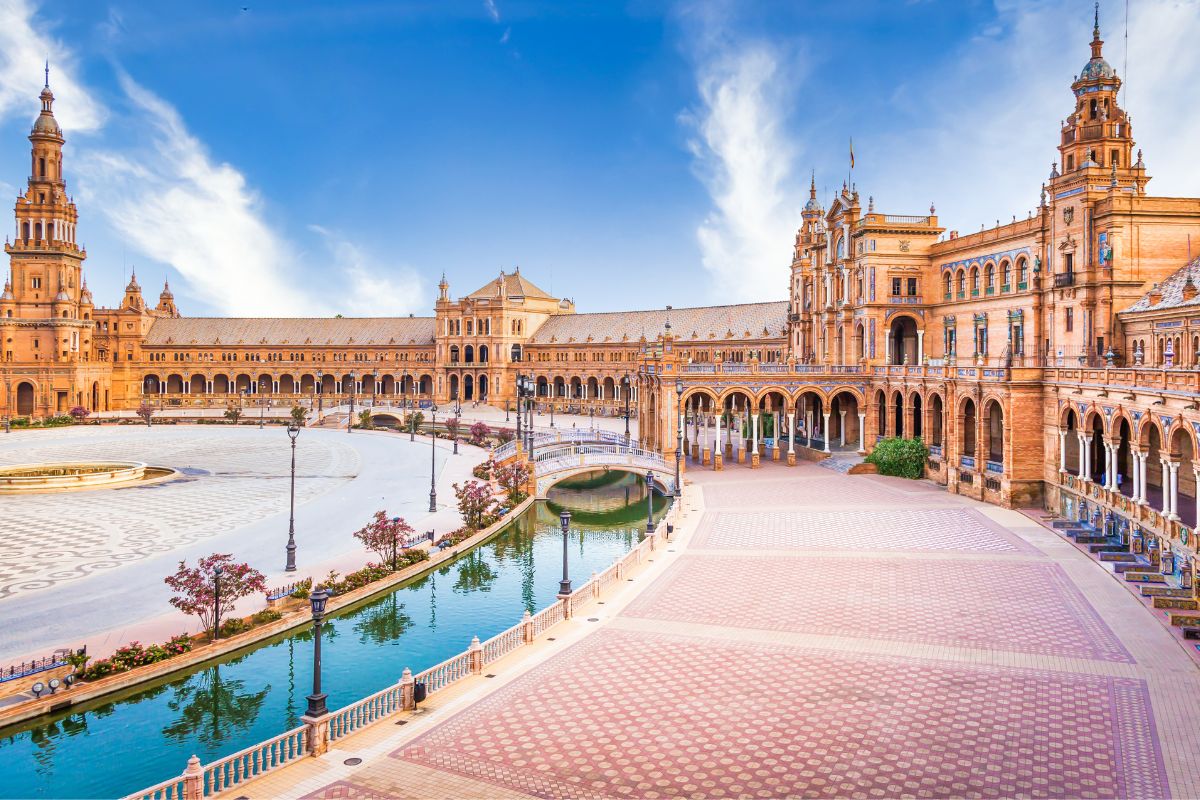
From San Sebastian’s world-famous food scene and the attractions of Barcelona, to the incredible museums of Madrid, history of Granada and beaches on the Costa del Sol, this Spain road trip has it all!
Road tripping past perfect beaches, huge mountains and ancient monuments sounds like a pretty perfect holiday doesn’t it? If you’ve dreamed of exploring Spain, this guide is guaranteed to help you plan your trip.
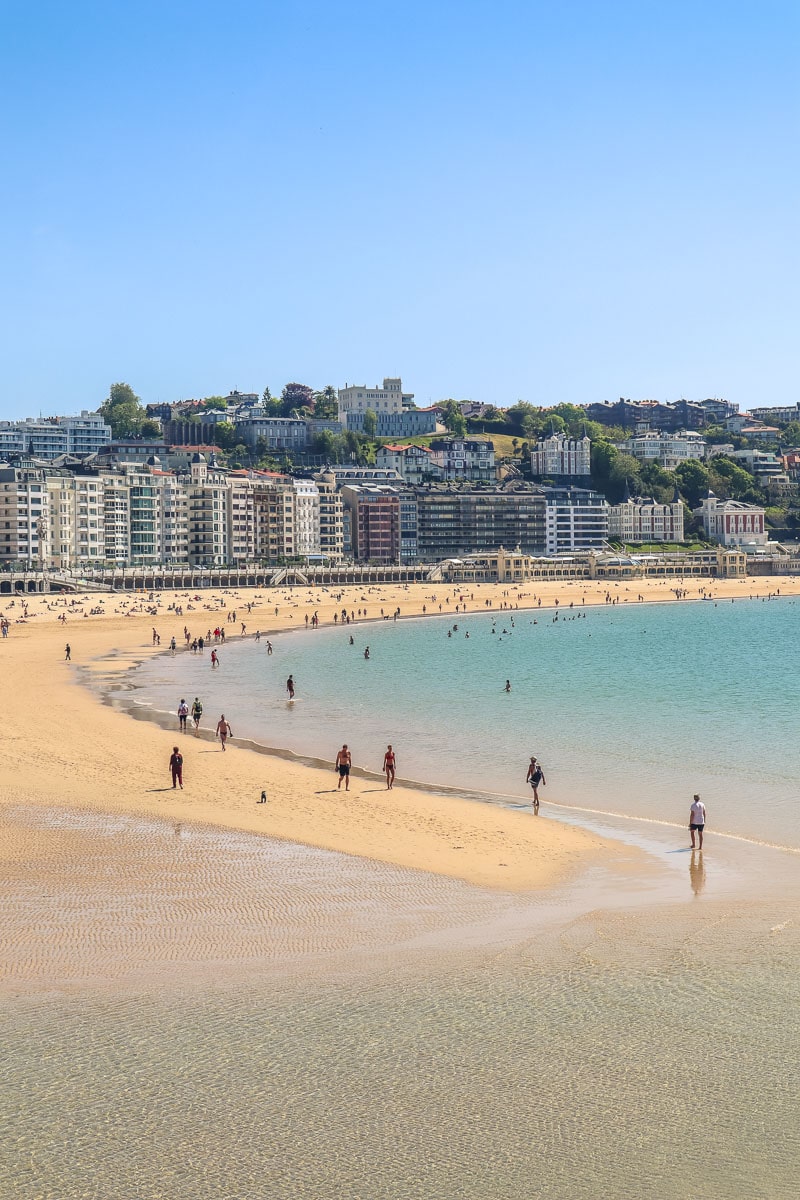
It’s the country I’ve visited the most in the world. Why does it keep me coming back for more? Because it’s so varied. I love the fact that you can spend mornings exploring pretty Medieval cities, lunchtimes feasting on plates of tapas, afternoons on the beach and evenings enjoying the nightlife.
In the south of Spain you can even ski in the morning in Sierra Nevada and then hit the beach on the Costa del Sol in the afternoon – how amazing is that?
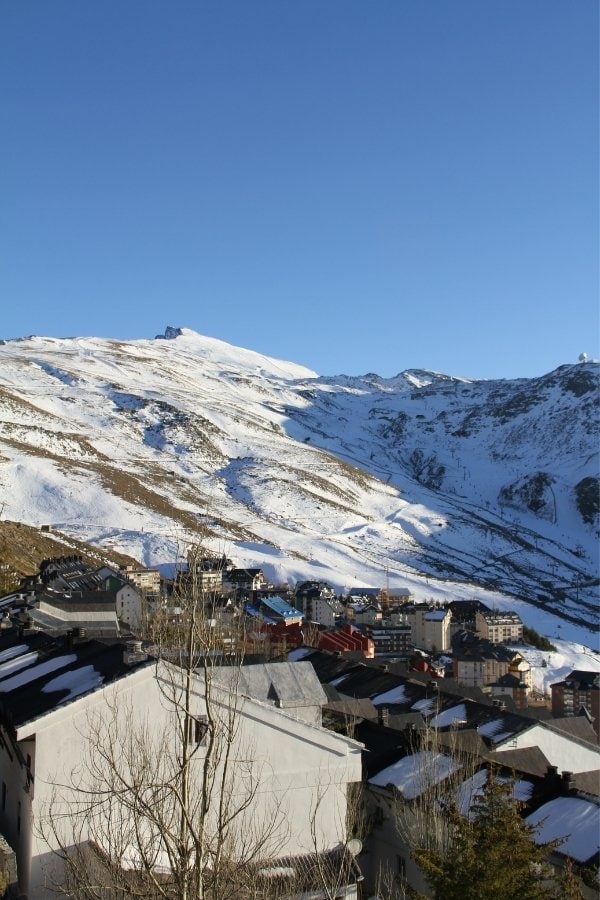
Whether you’re interested in art, architecture, history, food or fashion, a trip to Spain will no doubt appeal.
If you’re interested in art, you’ll enjoy visiting Barcelona’s Picasso and Miro Galleries, the architectural wonder that is Bilbao’s Guggenheim Museum, Madrid’s impressive art collection at the Prado Museum and the modern artworks in Malaga’s Pompidou Centre.

If you enjoy the great outdoors there are plenty of beautiful landscapes in Spain . You could hike in Ordesa y Monte Perdido National Park in the north, explore Valencia’s Turia Gardens, explore Murcia’s weird and wonderful sandstone wonders at Bolnuevo or even ski in Sierra Nevada.
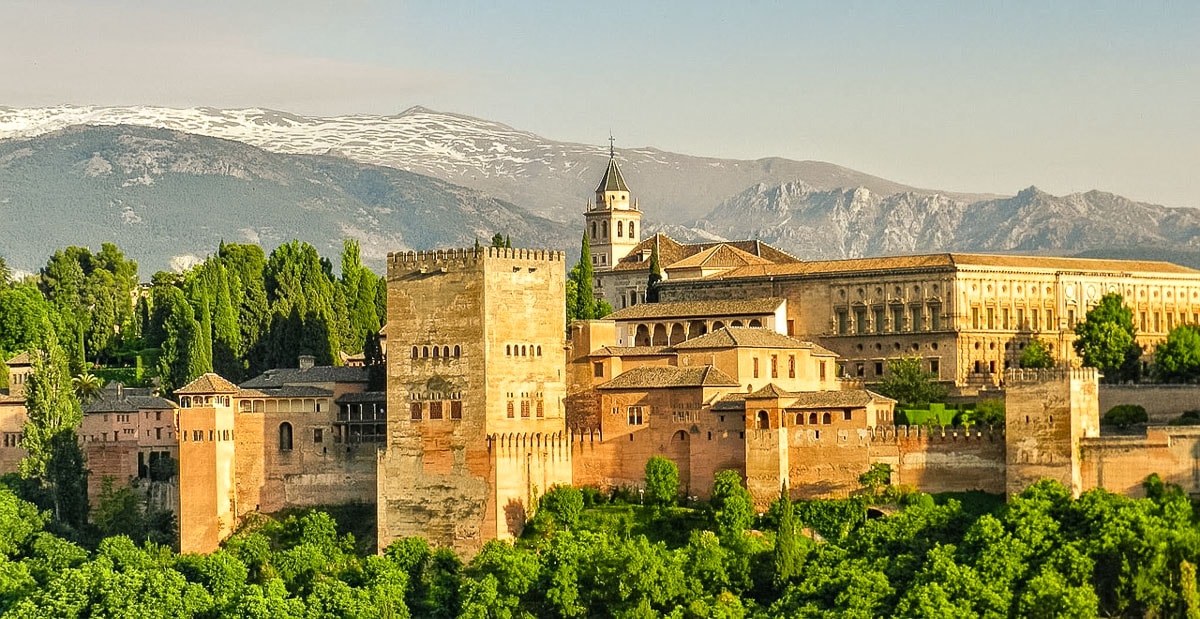
I’m a firm believer that the best way to get to know a country is through its cuisine, and in Spain, you’re in for a treat! San Sebastian in the Basque Country has the most Michelin-starred eateries per capita in Europe. There’s a great culture across this region for pintxos – small dishes often showcasing local ingredients.
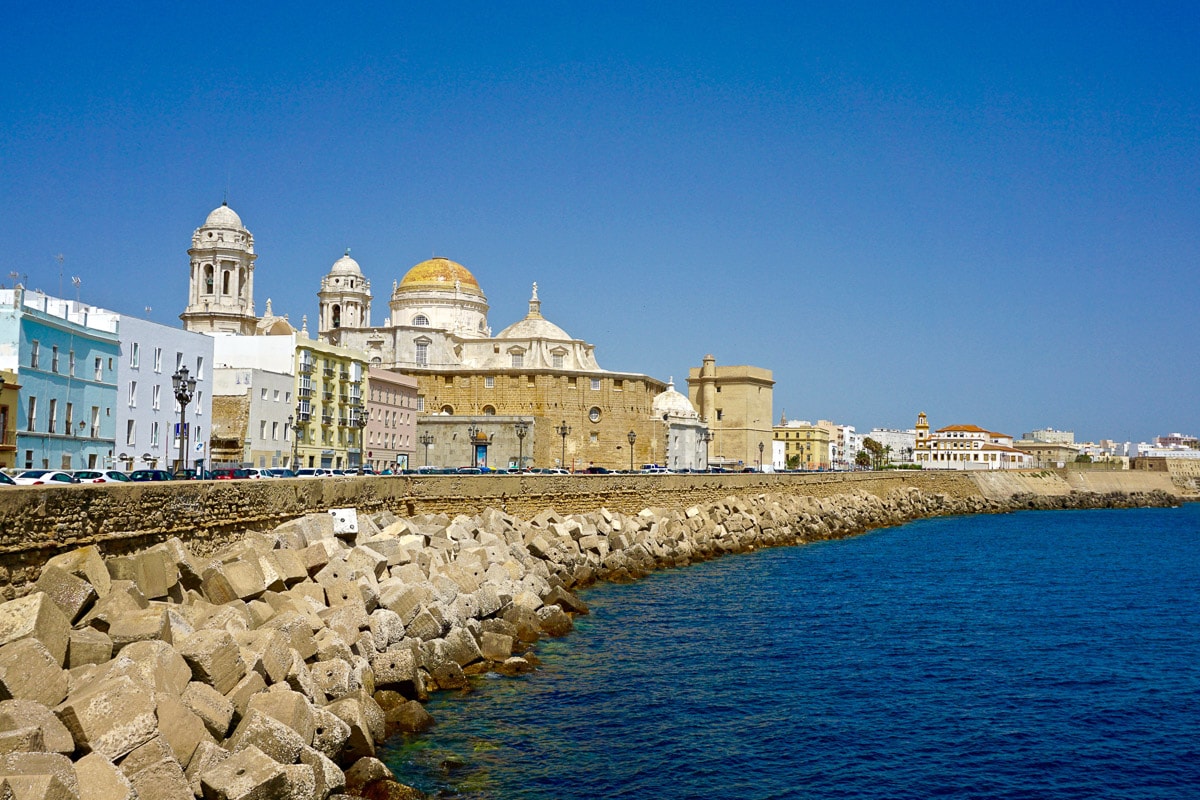
Head south and you’ll enjoy plates and plates of delicious tapas. From Spanish hams and cheeses, to griddled peppers, calamari and fresh fish, there’s so much to taste along the way,
And the best part about a Spain road trip? The freedom! You don’t have to stick to the obvious routes. I’d 100% encourage veering off course from time to time.
Often it’s when you decide to travel slowly and go off the beaten track, you start stumbling across hidden gems. You’ll take a wrong turning and end up in an authentic Spanish town that isn’t in any of the tourist guide books!
Spain is often associated with summer beach holidays, but it’s worth remembering that many of the interior parts of the country offer just as much natural beauty, with vineyards, mountains, canyons, olive groves and whitewashed towns.
So, rather than create one epic Spain road trip, I’m diving it in tow: a northern Spain road trip and a southern Spain road trip . That way you can just pick one and break the country up into manageable chunks. If you’ve got a while, then simply join the two up and continue on from Salamanca to Madrid.
Click through to take a look at each itinerary, and figure out which one is right for you…
The Ultimate Spain Road Trip Itinerary
From sampling some of the best Spanish food in the Basque Country and enjoying the vibrant colours of Barcelona, to visiting the Alhambra in Granada and relaxing on the beautiful beaches on the Costa del Sol, it's time to plan the ultimate Spain road trip!
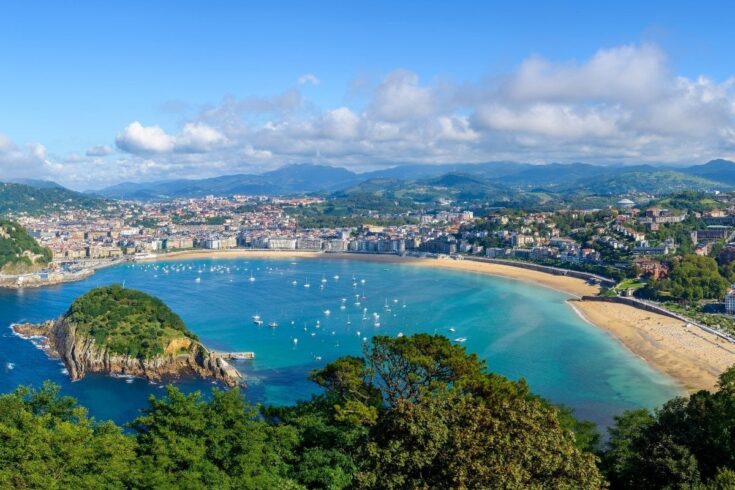
The Ultimate Northern Spain Road Trip: Routes, Sights, Guides, Maps And More
From Catalonia’s unspoilt coastline and Aragon’s scenic architecture to quaint cities in the Basque Country, this northern Spain road trip offers something for everyone.
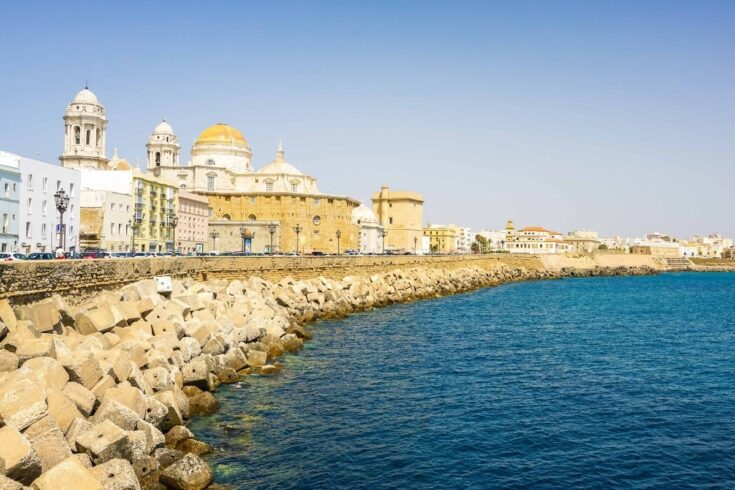
The Ultimate Southern Spain Road Trip: Routes, Sights, Guides, Maps And More
From the historic cities of Seville and Cordoba, to the natural beauty of Ronda and the spectacular beaches of Cadiz and Valencia, this southern Spain road trip offers something for everyone.
When Is The Best Time To Visit Spain?
You might think that Spain has a Mediterranean climate, but that’s only true for the southern parts of the country. Spain’s location and geography means that the north has a cooler climate and the east around Murcia has a more arid climate. Obviously the mountainous areas in the Pyrenees and Sierra Nevada are completely different too.
Temperatures vary greatly by region, but as a quick example, you can expect temperatures as low as -10 in around Sierra Nevada (in the mountains near Granada) in January, and as high as 40°C in July in cities such as Seville. Temperatures in the south remain mild in winter, making destinations along the Costa del Sol including Malaga and Marbella, great options for a winter holiday.
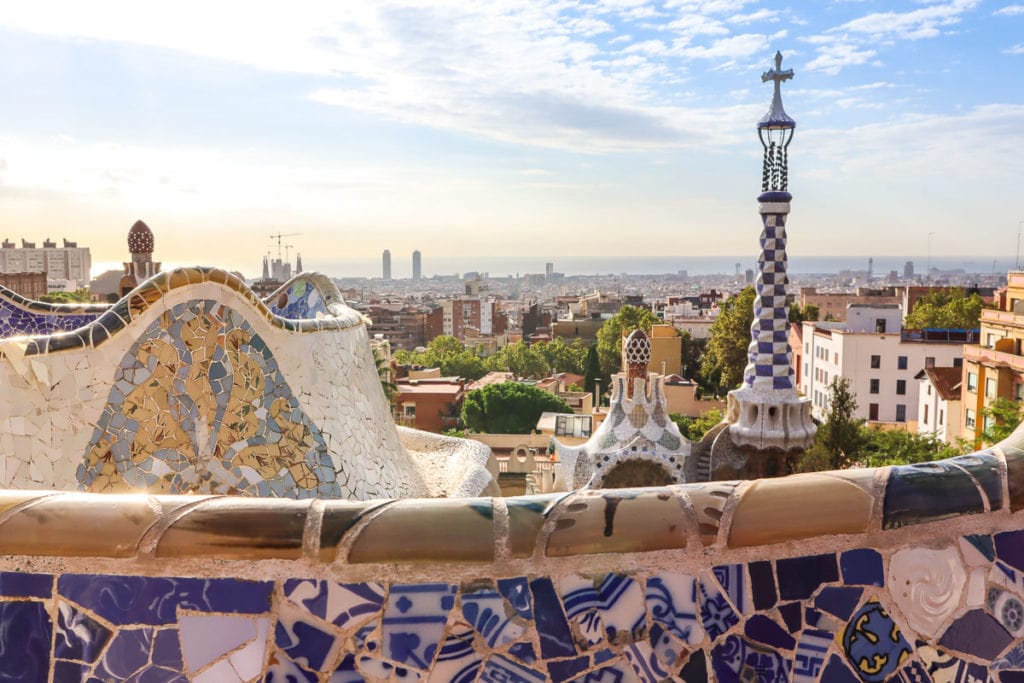
If you’re wondering when is the best time to visit Spain, I’d suggest planning a trip between April and June, or between September and October, just after the peak summer season.
The weather tends to be consistent in these months and you’ll skip the peak season so should benefit from lower prices and fewer people.
What to pack for your road trip
If you’re wondering what to pack for your trip, this guide to road trip essentials has you covered. From portable chargers to ways to stay entertained on long journeys, it’ll help you create your road trip packing list.
I hope you’ve enjoyed checking out my Spain road trip itineraries. Let me know where you decide to go and what your highlights are!
Chloe Gunning
With a passion for food, fun and adventure, Chloe is the content creator behind one of the UK's top travel blogs Wanderlust Chloe. From volcano boarding in Nicaragua, to sailing around Sicily and eating her way around Japan, her travels have taken her to some of the coolest spots on the planet. Named Travel Influencer of the Year in 2022, Chloe regularly works with a number of tourism boards, producing inspirational travel content across multiple platforms. Find out more about Chloe here.
Leave a comment Cancel reply

The Best Road Trips in Spain and Their Self-Drive Itineraries
March 11, 2021

From rocky volcanic coasts to medieval city charm, driving in Spain can be an absolute joy. After years on the road as a travel writer and resident, I bring you the best road trips in Spain, plus the ultimate Spanish road trip itinerary. Bucket lists at the ready? Let’s go! Updated 2021.
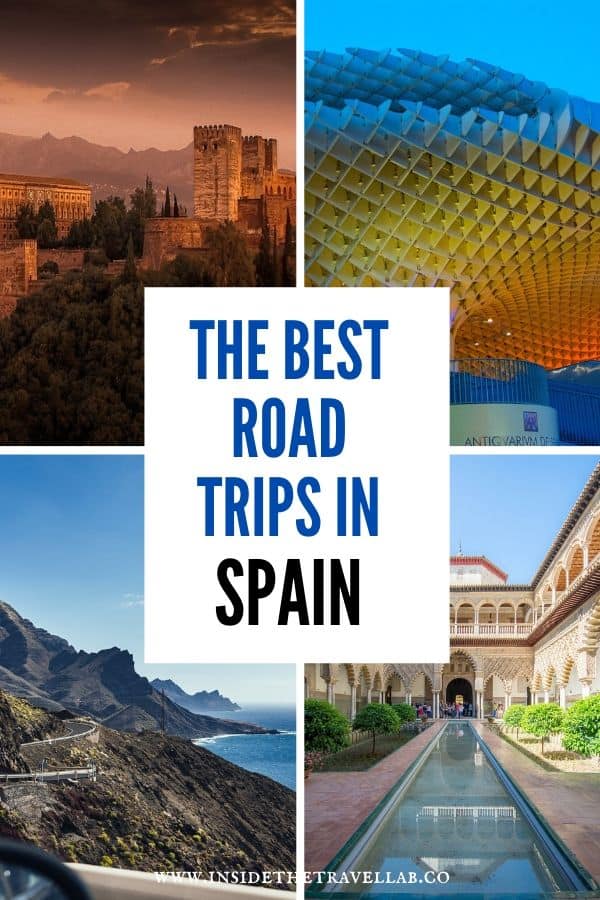
Table of Contents
THE BEST ROAD TRIPS IN SPAIN
If walking is one of the best ways to see a city, then driving is one of the best ways to see a country. Driving in Spain has brought me deep, deep joy, rising through the red dust of Andalusia and plunging through the deep green of Galicia.
You can find the separate road trip itineraries through Spain dotted throughout the article, but this article focuses on the best road trips in Spain.
- Download your free road trip essentials list and road trip packing list.
- Download the road trip planner and toolkit here.
Recommended
I love sharing the best travel resources I can find.
- I never book a flight without looking on Skyscanner first
- My favourite one stop shop for airport transfers, food tours & excursions is Get Your Guide
- Out of the big accommodation machines, I use Expedia and Booking.com the most
- I’ve hand-picked useful travel gear and tools for you in my Amazon shop . Never leave home without a travel adapter or collapsible water bottle . I’d also recommend these soft ear plugs and a sleep mask .
- Access all our planners and budget spreadsheets in the Travel Toolbox ©
- Plan the perfect road trip with our Road Trip Planner & Toolkit ©
- Use these packing cubes to make life so much easier on the road.
- Save on mobile phone roaming charges with an eSIM from Airalo .
TRAVEL SPAIN BY CAR
We start with the ultimate Spain road trip itinerary, taking in the mainland for first time visitors. But don’t forget Spain’s islands, not to mention delving deeper into the regions to find a richer, more authentic experience when you have more time.
Whether you call it fly-drive, self drive or want someone else to help you travel Spain by car, this is the collection of the best road trips in Spain.
Happy planning!
The Ultimate Spain Road Trip Itinerary
If all you have is two weeks, then this is the best Spain road trip itinerary for you. This two week self-drive Spain itinerary brings you the highlights of the country at a reasonable, but not relaxed, pace.
However, I’d always advise that you take is slow if you can. It’s far more enjoyable to spend more time out of the car than in. With that in mind, check out some of the other regional road trip ideas below.
Of all the places in the world, Spain is disinclined to rush. People here like to take their time and savour the joys of everyday life. Racing to fit your busy schedule does not usually rank highly in that regard.
The Ultimate Spain Road Trip Itinerary At a Glance
- Day 1: Arrive Barcelona
- Day 2: Barcelona
- Day 3: Girona and the Pyrenees
- Day 4: Valencia
- Day 5: Valencia to Madrid
- Day 6: Madrid
- Day 7: Madrid to Toledo
- Day 8: Toledo to Granada
- Day 9: Granada and the Alhambra
- Day 10: Alpujarras Mountains
- Day 11: Seville via Cordoba
- Day 12: Seville
- Day 13: Cadiz via Doñana National Park
- Day 14: Malaga to fly home
Historical city centres in Spain were designed for pedestrians and, at a stretch, horses. They were not designed for cars! Be careful when following SatNav instructions into steep, old towns. You can find yourself unable to make some tight turns and then somehow need to reverse backwards down a narrow road. Stick to the main roads in town!
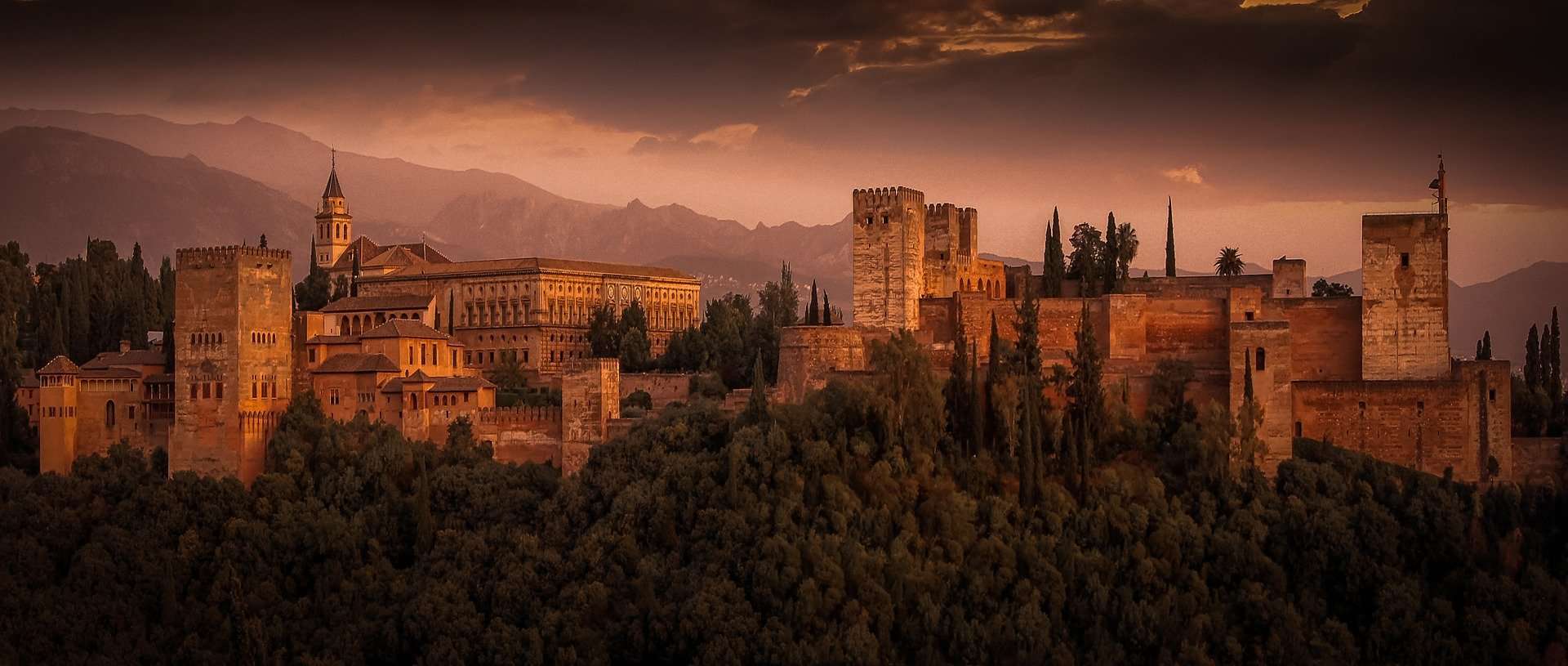
Southern Spain Road Trip Through Andalusia
A road trip through Andalusia, Spain’s biggest region, unsurprisingly covers a lot of ground. This passionate place is the home of flamenco, jamon and sherry, as well as staggering, world-renowned monuments.
You can easily fill two weeks with UNESCO World Heritage Sites like the Alhambra in Granada, the Real Alcazar in Seville and the unbeatable mosque turned cathedral in Cordoba.
But a self-drive road trip through Spain allows you to visit off the radar places and explore local traditions like joining the olive oil harvest in the mountains. From the beaches to the snowy peaks of the Sierra Nevada, driving through Andalusia really is one of the best road trips in Spain.
Andalusia Road Trip Itinerary At a Glance
- Day 1: Arrive Malaga.
- Day 2: Drive to Cadiz
- Day 3: Cadiz to Seville via Doñana National Park
- Day 4: Seville
- Day 5: Seville to Granada via Cordoba
- Day 6: Granada & Alpujarras Mountains
- Day 7: Back to Malaga to fly home. Find the complete southern Spain road trip itinerary here.
- Malaga is the biggest international airport but you can also fly into Seville and Granada with relative ease.
How about the Madrid to Seville drive?
With so many international flights arriving in Madrid, you may be wondering whether or not you should drive from Madrid to Seville or take the train instead.
A Madrid-Seville Road Trip can pass through many off the beaten path destinations, like Zafra and Merida, but in my opinion, it’s not one of Spain’s best road trips.
If you are short on time, I’d highly recommend taking the extremely fast and efficient Madrid-Seville train and then picking up your rental car in Seville to tour Andalusia.
It’s also possible to drive from Madrid to Granada by car, swerving up and down the Alpujarras Mountains, but again, I’d suggest picking up your wheels in Andalusia instead.
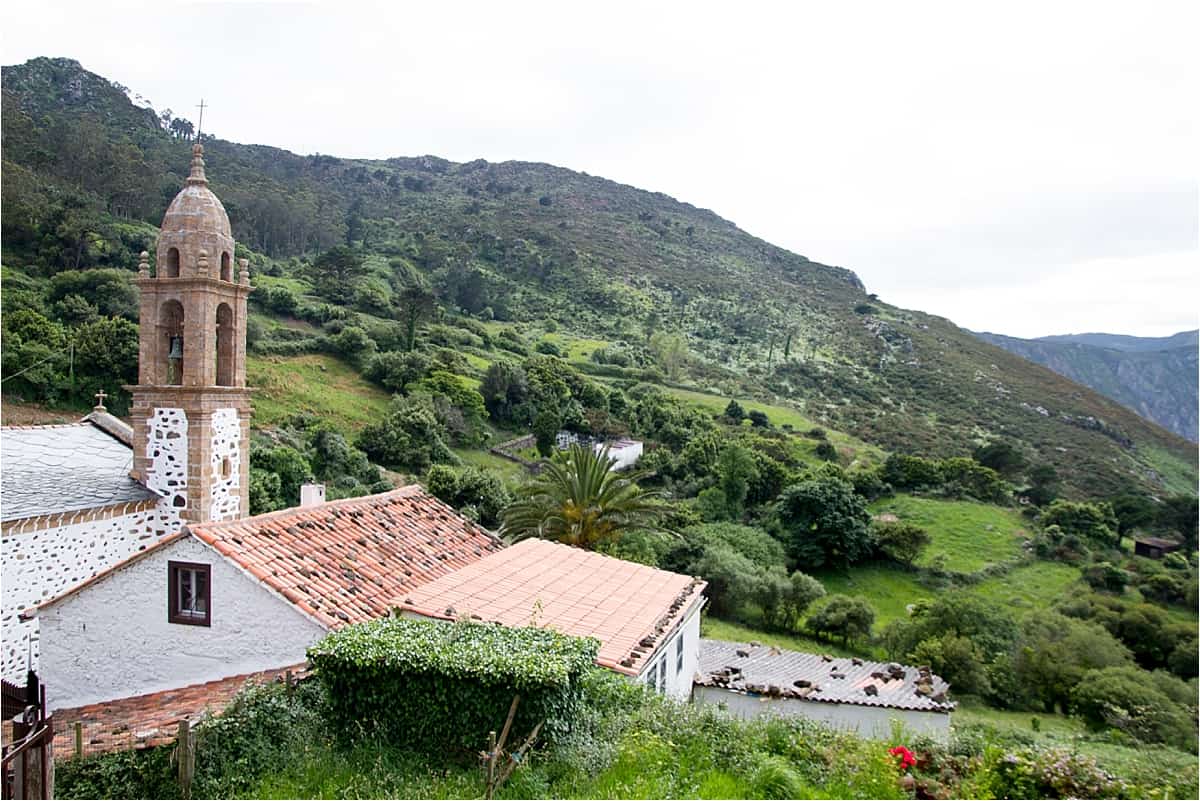
The Sanctuary of Dismembered Wax Body Parts
Northern Spain Road Trip Itinerary
Prepare to be surprised when you find out what makes this one of the best road trips in Spain.
The northern area of Spain swaps dry plains for rocky coves, and bull rings for lighthouses and salt marshes amid the green. Famed for its seafood and as the finishing point for the Santiago de Compostela pilgrimage route, this northern Spain road trip itinerary will show you a different side of the country.
- Want more detail? Explore this Galicia road trip itinerary.
Northern Spain Road Trip Itinerary At a Glance
- Day 1: Arrive San Sebastian
- Day 2: San Sebastian to Bilbao
- Day 3: Bilbao to Aviles
- Day 4: Aviles to A Coruña
- Day 5: A Coruña to Santiago de Compostela
- Day 6: Santiago de Compostela to Vigo
- Day 7: Back to San Sebastian to fly home
Recommended reading: Road Trip Galicia, Spain; The Undiscovered Northern Coast
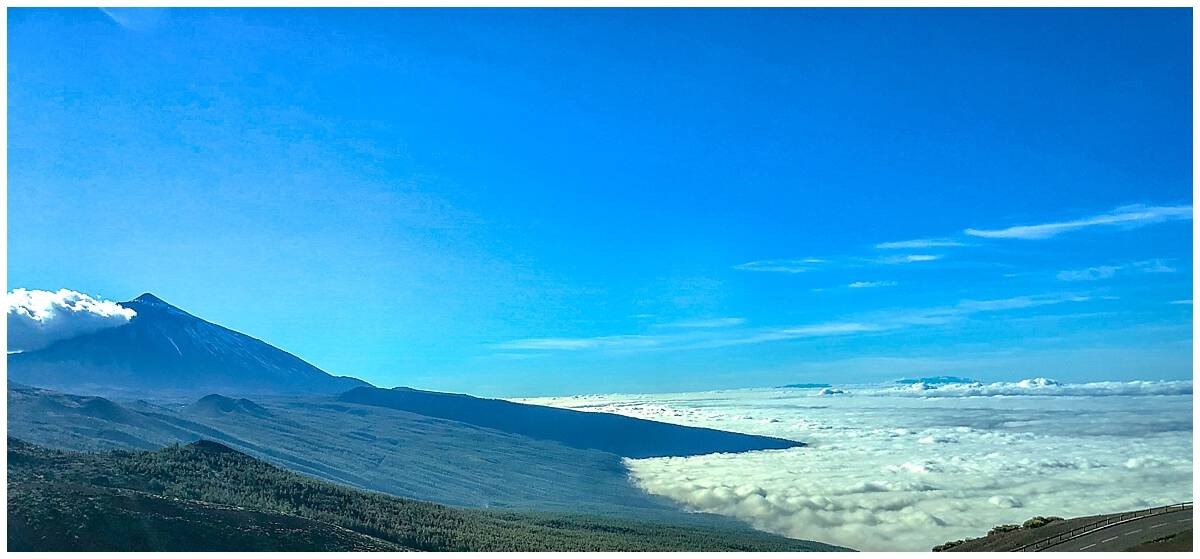
View above the clouds on El Teide in Tenerife
Road Trip Through Tenerife (Canary Islands)
As the largest Canary Island off the northwest coast of Africa, Tenerife is famous for its fly and flop beach holidays. But there are so many unusual things to do in Tenerife , from UNESCO World Heritage cities like Laguna to primitive biosphere reserves in Anaga. It’s a hiking paradise and if tight turns and steep roads don’t phase you, a great wild landscape awaits.
Driving through Spain takes on new and heady heights when you’re bounding over black volcanic stones and watching the clouds appear beneath you. This is one of the best road trips in Spain because it is also one of the most beautiful.
It’s also easy to combine with staying in one place and organising a series of day trips around the island. So if packing and unpacking on a road trip becomes a chore for you, try this instead.
Road Trip Through Tenerife at a Glance
- Day 1: Arrive and stay in UNESCO World Heritage La Laguna
- Day 2: Drive El Teide Volcano
- Day 3: Los Gigantes for a whale watching excursion
- Day 4: Hiking in Anaga National Park
- Day 5: Orotava, Icod de los Vinos and Garachico
- Day 6: Pyramids of Guimar
- Day 7: Explore La Laguna and fly home

Casa Mila: worth it on any Barcelona itinerary
Road Trip Through Catalonia (Catalunya)
Barcelona is the most famous part of Catalunya but to see more of the Catalan character, get behind the wheel and enjoy one of the best road trips in Spain.
Travel by car in Spain to discover the curious city of Girona, the sandy coast of Costa Brava and the smoky peaks of the Pyrenees.
Costa Brava offers volcanoes, sleepy coves and some of the best restaurants in the world. That’s not a boast. That’s actually a validated claim (read more about that here. )
You’ll also find flamboyant artwork from local household name Salvador Dalí, a great spot for a hot air balloon ride and a renewed appreciation for the difference between Catalan and Castilian Spanish.
- How to spend three days in Barcelona, an inside guide
- Unusual things to do in Barcelona
Road Trip from Barcelona At a Glance
- Day 3: Barcelona to Girona
- Day 4: Figueres and Cadaques
- Day 5: Garrotxa Natural Park
- Day 6: Tarragona
- Day 7: Return Barcelona to fly home
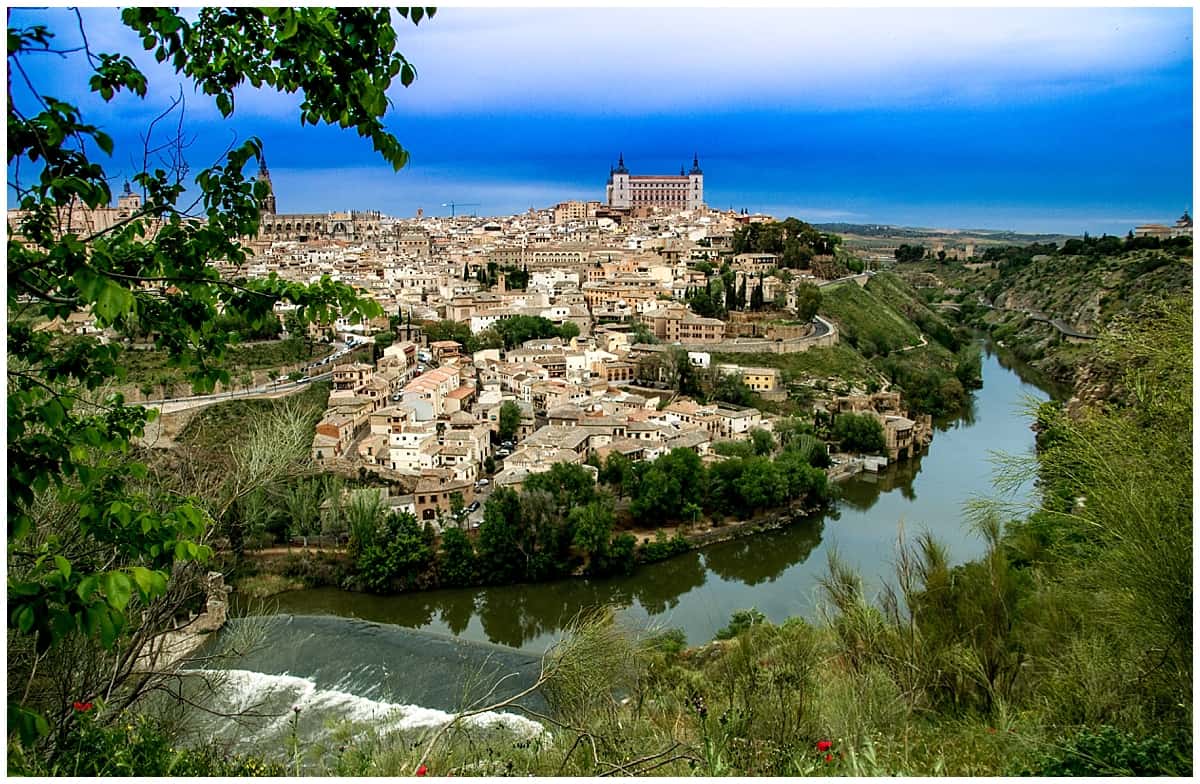
Road Trip Through Central Spain
Treat yourself to a literary, gastronomic and thoroughly authentic journey through this central part of Spain, the region of Castilla La Mancha. It’s one of the best road trips in Spain for hidden gems and a sense of exploration.
Take in Toledo, the former capital and UNESCO World Heritage Site. Search the hills for the windmills made famous by Don Quixote. Hike through one of the best bird reserves in the country. And relish taking your time amid small Spanish villages, far from the crowds.
Road Trip Through Central Spain at a Glance
- Day 1: Arrive Madrid
- Day 2: Madrid
- Day 3: Madrid to Toledo
- Day 4: Toledo
- Day 5: Don Quixote Countryside
- Day 6: Hike through the Tablas de Daimiel
- Day 7: Return Madrid to fly home
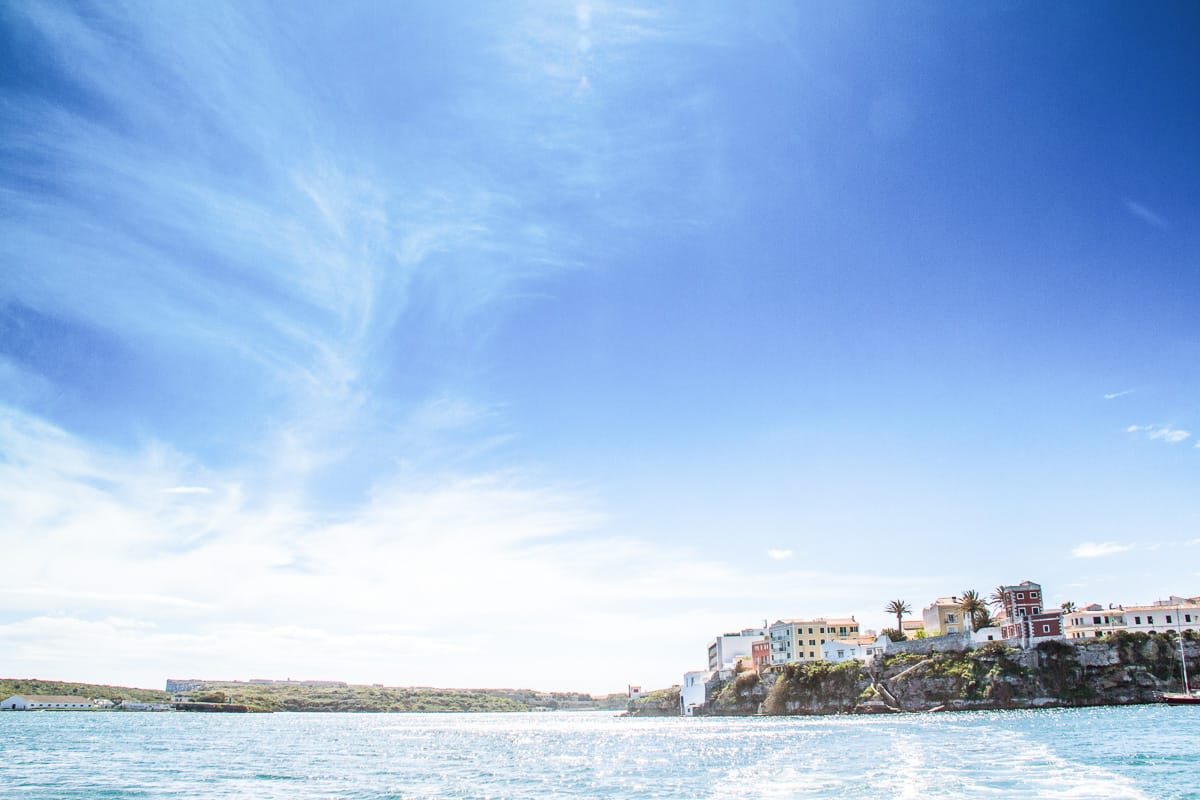
Both islands have stunning coastlines (but this place is Menorca!)
Driving the Balearic Islands
One of the best road trips in Spain involves flying to one of her smaller islands and taking a laid back approach to plans and itineraries all together. Mallorca and Menorca are the two main Balearic Islands and each has a distinctive character. Mallorca has party spots, UNESCO World Heritage and wild hiking routes. Menorca specialises more in family beaches, quiet streets, small towns and an awful lot of gin.
- Menorca or Mallorca for your Balearic Island holiday?
Set yourself up with one home base for a week and take a series of day trips to explore either island.
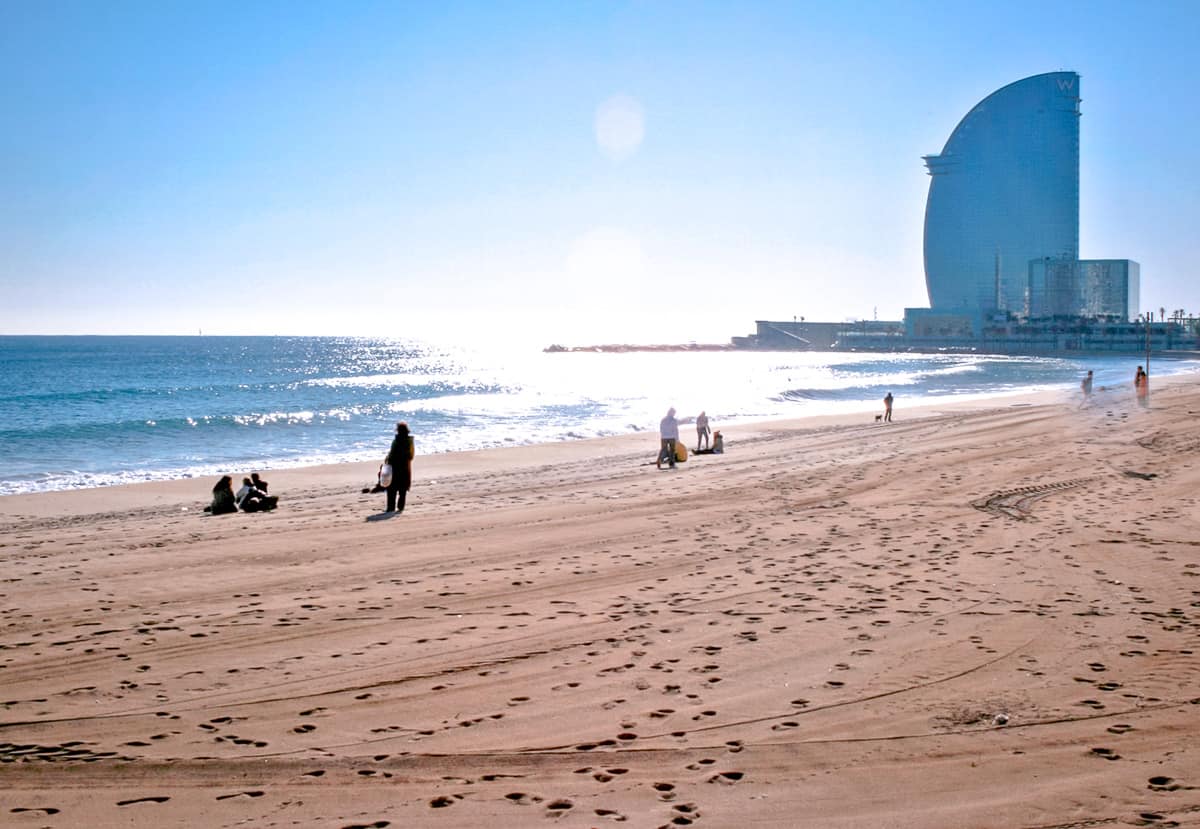
One of the best things about Barcelona is that it leads right onto a sandy beach…
Road Trip Along Spain’s East Mediterranean Coast
Drive from Barcelona to Valencia to experience two of Spain’s most interesting cities and her sparkling coastline as well. Find the Roman amphitheatre at Tarragona and the rice fields that gave us paella outside Valencia. If you have more than one week to ten days, continue south to the Moorish fortress in Amería as part of a road trip through Andalusia.
Road Trip Through the East Coast of Spain At a Glance
- Day 2: Barcelona and Girona
- Day 3: Valencia via Tarragona
- Day 5: Alicante and the Costa Blanca
- Day 6: Almeria and Cabo de Gata
- Day 7: Back to Barcelona to fly home (or to Malaga)
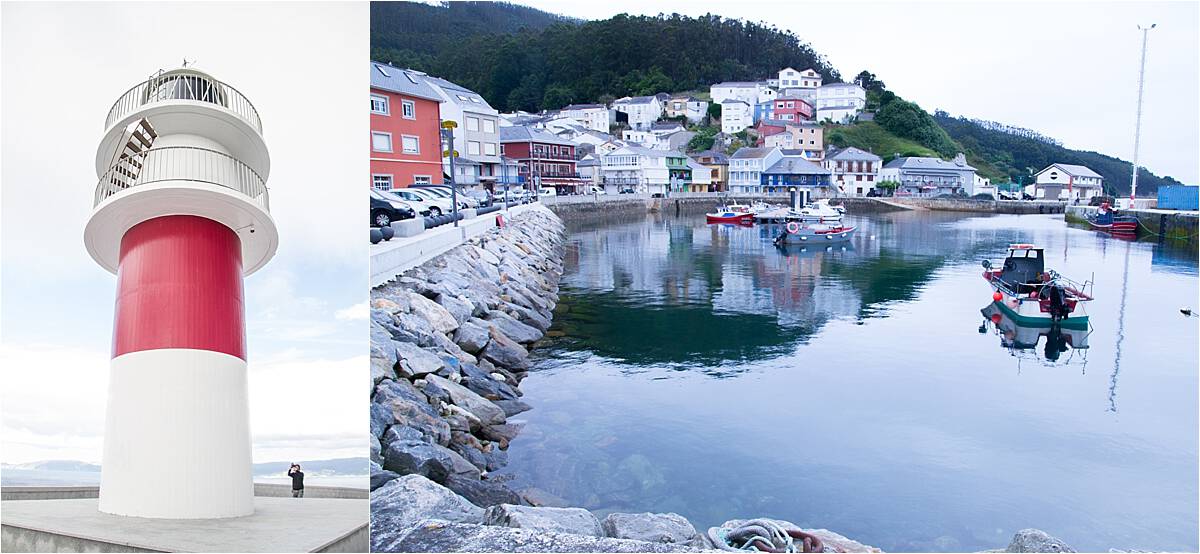
Road Trip Across Galicia
Decked out in deep green hues and bursting with salty seafood, a road trip through Galicia provides a completely different experience of Spain.
With a coastline more reminiscent of the rugged, craggy inlets of Ireland than the white sand of the south, it’s no surprise that Galicia offers seafood to make even the uncertain smile. Expect lighthouses, green fields, great walking routes and great food.
- A Galicia Road Trip: Northern Spain’s Rugged Green Coast
Road Trip Around Galicia at a Glance
- Day 1: Arrive La Coruña
- Day 2: Pontedeume and Redes
- Day 3: Porto do Barqueiro & Viveiro
- Day 4: Praia das Catedrais
- Day 5: Torre de Hercules Lighthouse & home

Road Trip Around the Basque Country
Link up San Sebastián, Bilbao and Santander for an epic road trip through Spain’s Basque country. Taste arguably the best food in the country in the pintxos bars in San Seb and take in the curls and swirls of the Guggenheim in Bilbao.
Add in secluded coastal curves and surprise museums, like the Balenciaga museum in Getaria , and you will find yourself with an unforgettable Spanish Road Trip.
Road Trip Through the Basque Country at a Glance
- Day 1: Arrive Bilbao
- Day 2: Bilbao
- Day 3: Bilbao to Logroño via Pamplona
- Day 4: Logroño to San Sebastian
- Day 5: San Sebastian
- Day 6: Hiking in Getaria
- Day 7: Back to Bilbao to fly home
What to know if you travel Spain by car
Cars drive on the right and you’ll need a full and valid driving license.
Tips for Spain Road Trip Itineraries
If you book through these links, we may earn a small commission at no extra cost to you. Cheers!
Typically, it’s best to pick up a vehicle at at the airport unless you have your heart set on exploring an historic city centre first. Bring your full driving license and book in advance. I’d highly recommend booking your car rental through Hertz.
Planning in Detail
I rely on the AA Route Planner to give me times and directions in Spain. Make sure you check for:
- Tolls (or factor them into your budget anyway)
What You Need to Drive in Spain
For a robust rundown of what you need to drive in Spain head to the Government website . From here you can check the latest recommendations and legal requirements, including information on an international driving permit.
Booking Hotels
Many smaller, boutique hotels in the centre of cities will not have parking options. It’s best to either park on the outskirts of town and walk in (in some places, such as Seville, taxis will struggle to get in as well) or if that’s too difficult for you then book a hotel on the outskirts of town and use their transport to travel in.
Highlights of Driving in Spain
Travel Spain by car and you’ll find all the following benefits.
While the big cities can get the pulse racing, for the most part, driving in Spain is a beautiful experience. Here are five reasons why:
1) THE ROADS ARE EMPTY
Outside the main cities that is. Gleaming wide main roads covered with smooth tarmac are the rule rather than the exception. Drive from Granada to Seville or Segovia to Merida and you’ll hardly see another car for miles.
2) THE SCENERY IS STUNNING
Low swirling mist rising over olive groves, intense sunshine hugging the contours of rust-red rock. Sparkling coastlines and white-washed towns with church towers spiking out of scorched plains. The green cloaked mountains of Galicia, the almond-scented mountains of Alpujarras and the Catalan curves of the eastern Pyrenees. Unlike driving in some countries, these views are visible from the windscreen of the car – you don’t have to wait until you park and get away from the roads.
3) GIANT BULLS ON THE HORIZON
Not real ones, of course. But building-sized, black, one-dimensional bull cutouts. Apparently, these first appeared as part of an advertising campaign for sherry. They were due to be removed until people clamoured for them to stay. Now, they add to the fun, as you never quite know when the next one will appear.
4) FRESH TAPAS AT SERVICE STATIONS
Forget about crisps, biscuits and overpriced coffee. Most petrol stations along the road in Spain are family run affairs with a chef on site. Coffee costs less than a euro while a plateful of patatas bravas, chocos, gambas or more is only a few minutes away. And if you’re feeling too hot? Try refreshing gazpacho instead.
5) FREEDOM AND GETTING OFF THE BEATEN TRACK
For reasons I’ll never quite understand, Spain has a reputation as a sand-and-sea destination and that’s about it. Visitors tend to cling to the coast and never realise just what they’re missing. Hiring a car and hitting the roads is the first step towards fixing that. Stop off in one of Andalucia’s pueblos blancos, for example, and you’ll probably be the only foreigner in town.
And that’s just for starters.
What is the best way to travel across Spain? Road trip or by train?
Great question. And the answer is: it depends.
Driving through Spain is an absolute joy, once you are out of the cities. Road tripping through Spain allows you to reach hidden villages and hike through unspoilt landscapes. It also makes life much easier if you are travelling with your children.
If you mainly wish to city hop between the big cities like Madrid, Barcelona and Seville, then the train is the better option. If you want to get off the beaten track and explore, go for a road trip.
Tools & Planners for the Best Road Trips in Spain
You’re in road trip heaven here, as we have everything from a full list of road trip essentials to the Ultimate Road Trip Planner for people who love freedom and hate spreadsheets.
And just for fun, we have the best road trip quotes and some road trip questions and games to help everyone get along.
Also, check out our road trip planning series on YouTube:
- The 5 biggest road trip planning mistakes people make (and how to fix them)
- The 7 best road trip planning tools.
1 thought on “The Best Road Trips in Spain and Their Self-Drive Itineraries”
The scenery is stunning indeed. I didn’t have to go driving to notice that. It’s wonderful!
Comments are closed.

Five Practical Routes from UK to Spain

Travel may be a full-time commitment for us, although each country offers its own special road-trip. We love exploring new territory and despite in our early days chasing the sun, now we have much slower-paced journeys; even if it is snowing and freezing temperatures. We’ve come to appreciate that it is only through slow travel that we get a real sense of a country and uncover its authenticity and cultural uniqueness.
Over the three years we’ve been on the road, Spain has been our choice for winter and spring. And our road-trips in and out of Spain have varied. Sometimes we have crossed the border from France and sometimes we have started in UK. So we thought we’d put together our routes that have taken us into and out of Spain.
We have chosen to focus on routes and POI rather than time and costs. In part because, having done the exercise a number of times, there is little difference in the total cost whether you cross the Bay of Biscay or the Channel. Unless your ferry price tag is over £600 as was quoted for us in January 2019! By the time you have taken into account diesel, travel time, food, LPG, weather uncertainty through France (if travelling in winter) and of course the unseen costs of wear and tear on the vehicle and additional miles on the clock, the Spanish ferry often works out better in many ways.
We hope that our routes offer you some options for your next road-trip, where we feature plenty of off-the-beaten track routes on quiet roads that seem to be populated more by vultures and cattle than vehicles. With a list of related blogs, places we’ve called home, co-ordinates and photo albums, you can explore how your next road-trip to Spain might pan out.
Road-trip 1 – 2016, Santander south
On our maiden road-trip to Spain, we took the ferry from Plymouth to Santander. After an overnight with some elephants, we then headed south towards Cadiz taking in the sights of three UNESCO Cathedrals en route. After a bit of meandering east we finally hurtled our way up the west coast to Roses before we launched ourselves into our French road-trip. Our highlights that year were Segovia, Monfragüe National Park in Extremadura, El Rocio on the south west border with Portugal, Denia on the south west coast and Valencia. Here’s our Maiden Voyage Interactive road-trip map. Click on icon on the top right of the map to enlarge it.
Road-trip 2 – January 2017, Bilbao to Dénia
After Christmas in UK this second road-trip was the infamous ‘ Storm in Denia ‘ moment. If you haven’t seen Myles two weather report videos, then they’re worth a watch. Weather Report from Spain 1 and 2 .
This was a speedy trip south from Bilbao to Dénia, our favourite ‘go to’ place, so not a very exciting offering, although if you need to get south quickly from the ferry, this is how we did it.
Road-trip 3 – December 2017, Carcassonne to Dénia
After housesitting in Carcassonne and St. Gaudin in France, we headed south across the border for Christmas and a rendez-vous with my mum. We took a gorgeous road-trip through the Pyrenees, which included our highlights of Lourdes, Estacion Canfranc – the largest station in Europe which is now sadly abandoned and Albarracín in Aragon. Such a great route, check it out below. Denia is a great Spanish town that you could easily while away a couple of weeks.
Road-trip 4 – February 2018 – UK Bound for MOT
The back end of that same trip took us north towards the ferry for Caen in preparation for our first MOT. And because we were in no immediate hurry, we tootled north taking an inland route and found some amazing spots, like Girona, Besalú and Peralada.
Road-trip 5 – January 2019, Caen to Dėnia
Our most recent trip to Spain has brought us south from Caen this time. We had some serious fixes that were required, so we had a two month stint in UK over Christmas. Scoobie went in for a little Spa Retreat to get his repairs done and we had time with friends and family. Unfortunately because we didn’t have a fixed date for returning to Europe, by the time we were ready to book, the ferry fares to Spain were extortionate at over £600, one way. So we decided on our favourite Caen route and to drive through France. We had some corking stopovers and had an absolute blast through unchartered territory. We meandered for 12 days from door to door and took in Bilbao and the Guggenheim museum, Castroveijo rock formations in the Duruelo forest and the natural thermal springs of Montanejos close to Valencia. What a great road-trip this was. Check out our road-trip below.
Thanks again for all your hard work putting this together. It’s great and really useful. We’ve only done North West Spain, which is fabulous but will hopefully head south another time. Happy Denia days.
You’re very welcome Maggie. Happy travelling.
These are fabulous Myles And Karen……such a help. Thank you x
Very welcome Wendy
Submit a Comment Cancel reply
Your email address will not be published. Required fields are marked *
Save my name, email, and website in this browser for the next time I comment.
Submit Comment
Navigate between all posts
To the blog
You can find us on social media, different channels for different content.
Are you sure you want to delete this route?

Route planner
Create your own plan for your trip to Spain with a route to suit your requirements
- +34955292261
- Due to Corona we have taken safety measures & ask travelers to check country regulations before booking

- All Adventure Tours Food Tours Gift Voucher Granada Granada Day Trips Merchandise Romantic Seville Seville Day Trips Seville for Kids Transfers Walking Tours Workshops
No products in the cart.
- Seville Blog
- Motorbike Blog
- Food and Drink
- Things to Do
Best Family Road Trip Itinerary through Spain from the UK

Do you want to take your kids on a road trip, but don’t know where to begin? No idea about journey times or how to rent a car? Maybe you’re worried that you won’t be able to keep the kids entertained. These are all common concerns, but a road trip is an excellent way to ensure a holiday is specifically tailored to your needs and desires. That’s why we’ve designed the best family road trip Itinerary through Spain from the UK with all the little details taken care of. We’ll help you hire a car and plan a trip that is fun and friendly for all the family. Sit back and relax as we take you on the holiday of a lifetime!
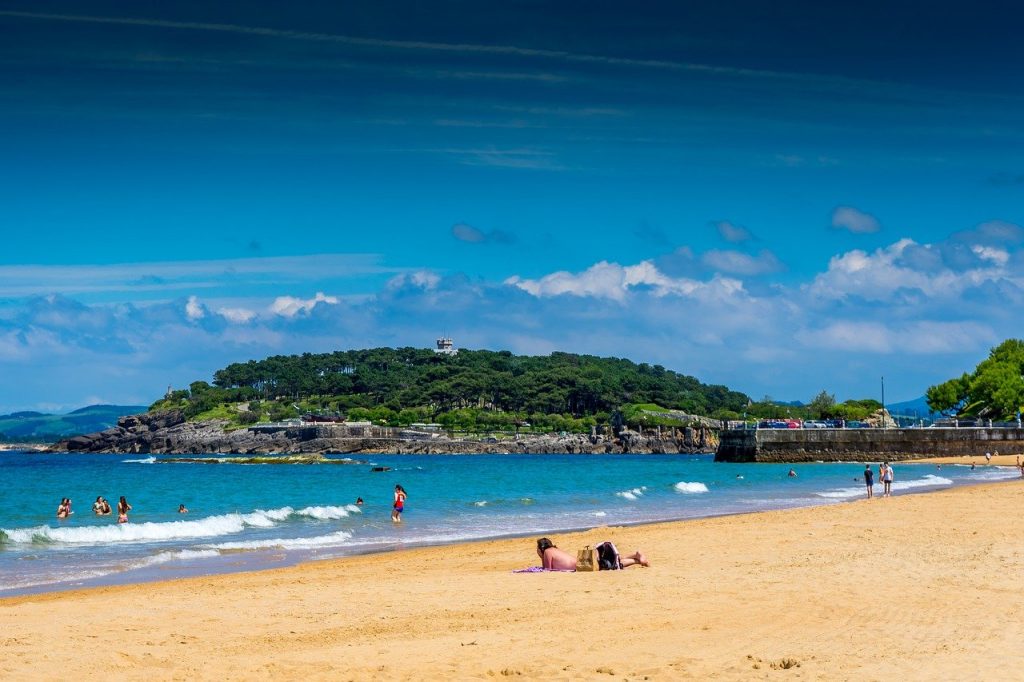
Fly from London to Santander
Starting off in the north of Spain, we will arrange a car hire for you so that you can begin your trip. We recommend staying in Santander overnight to get your bearings before you journey onwards. Santander is a lovely city to begin getting to know Spain as you can enjoy its beautiful beach Playa del Sardinero, its famous palace (Palacio de la Magdalena) and a plethora of museums. The museum of Prehistory and Archaeology is also ideal for younger kids, with plenty of archaic monuments and artefacts to wonder at. Santander is an excellent first stop for an introduction into Spain’s culture and will have you itching to move on to the next stop of the tour!
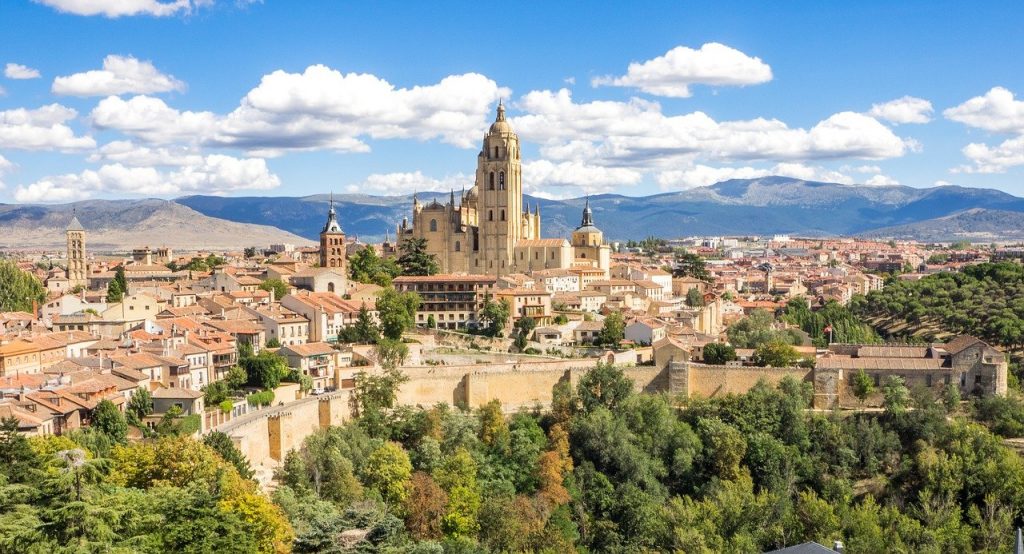
Drive to Segovia
From Santander, you can drive 3hr 35 minutes to the enchanting city of Segovia . Due to its fairy tale beauty, Segovia is sure to be a firm favourite for all the family. The history lovers can marvel at the impressive Roman aqueduct dating back to the first century. The Alcazar of Segovia is unlike any other in Spain, looking like a Disney palace, younger kids can enact their favourite stories. For the adults, wander through Calle Real de Segovia, a succession of pedestrian streets that lead to the old Jewish quarter. Here, you can enjoy the romantic atmosphere by sampling the finest local restaurants and bars. This is the perfect place to either stop off to stretch your legs or stay overnight to take things slow. The beauty of the road trip is that you can take everything at your own pace!
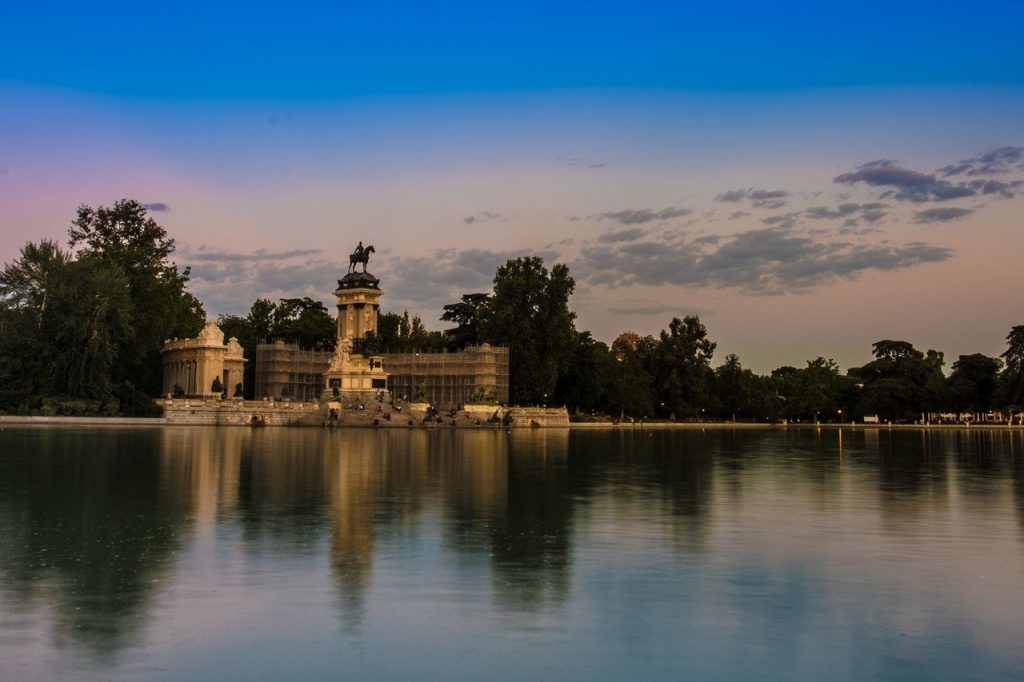
Spend two days in Madrid
After Segovia, enjoy the short one hour drive to Madrid! This city needs no introduction. The best family road trip itinerary through Spain has to include Madrid. Spain’s diverse capital has a wide variety of entertaining activities for kids, teenagers and adults alike! For the young ones, visit the adorable Casa Museo de Raton Perez. Spanish children don’t give their teeth to the tooth fairy, instead Perez the mouse collects them! This museum is a fascinating and engaging way for young children to learn about a new culture. The Prado Museum is one of the most famous attractions in the city, but did you know they also have a guided kids tour? You can discover grand works of art altogether without anyone getting bored!
On Day two, prioritise the outdoors! Madrid’s zoo in Casa de Campo and Retiro park are great places to spend time together. Take a picnic or a gentle cruise down the lake in a picturesque rowing boat. If you’d like something more active, why not try a bike tour? We can easily arrange these for you! Bike tours are a great way of getting to know a big city quickly as well as providing a fun opportunity for family races. As well as these activities, make the most of the thriving food scene! Try the famous Madrid Stew or Calamari Sandwich. If your kids are at the picky eating stage, we’re sure you’ll be able to satisfy them with some yummy churros! We guarantee you’ll have happy memories for a lifetime from this wonderful, vibrant city.
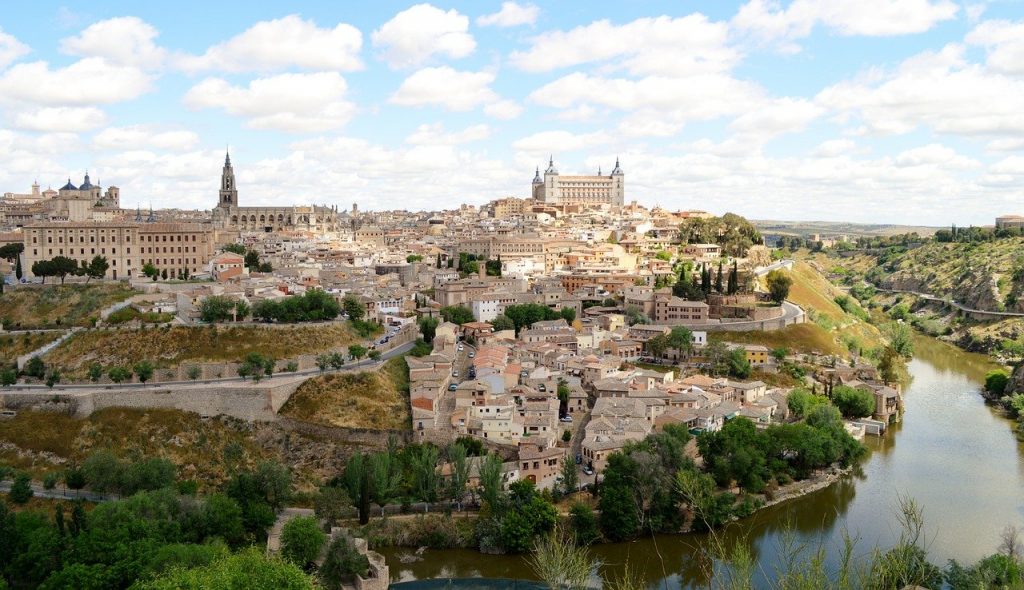
Stop off at Toledo
We recommend you stay three nights in Madrid before beginning the journey to the South. On your way, make sure to take a detour in the beautiful city of Toledo less than an hour’s drive from Madrid. Surrounded by stunning views of the country, Toledo is the perfect place to get some fresh air. Head to the Mirador de Valle and take in the breath-taking city from this spectacular vantage point. You can also visit the amazing Imagination Station, where you can explore the exciting range of interactive science exhibitions that are certain to keep them busy for a few hours! Alongside these, you can also visit the city’s Alcazar and art museum for a sense of the city’s UNESCO protected culture.

Visit Cordoba
Once you’ve explored the rich culture of Toledo, you can begin the 3hr 30 minute drive to Cordoba. This is your first stop in Andalusia, the beautiful region of Southern Spain that should be included in every family road trip itinerary through Spain. Cordoba is littered with great historical monuments like the Mezquita, which with its mixture of Islamic and Cristian design, is unlike any other historical monument you’ll encounter in Spain. Walking under the famous red and white arches, you can wonder at the amazing architecture! If you travel in summer, make sure to check the beautifully flowered patio displays which are unique to the area. This will be something entirely new for the kids to see! We recommend staying one night in Cordoba before heading to sunny Seville.

Spend three days in Seville
Seville is the capital of Andalusia and one of the warmest cities in Europe. As a result, it’s a hugely popular tourist destination with enough to keep you busy and entertained for at least three days. Some of the best activities for kids are visiting the Royal Alcazar and Plaza de Espana. On day one, you could visit both of these famous locations , known for their depiction infilm and television. The Royal Alcazar was used for Game of Thrones and the Plaza de Espana was used for Star Wars, so the kids and teenagers will love exploring these fantasy worlds in reality. Next to the Plaza de Espana is the Maria Luisa park, where there’s ample space for running around and family picnics. For something fun and interactive, take the kids to the Plaza de America where they can feed the many doves that reside there.
Are you an adventurous family? On Day two, you could try paddle surfing or kayaking ! Seville has many water sports on the river Guadalquivir suitable for all ages. Or take a thrilling horse-riding experience ! You can ride through Andalusia’s beautiful countryside and the kids can pretend to be the hunted outlaws of days of old. Their imagination can run wild as well as learning a new skill. There are also no shortages of flamenco dance lessons for those little ones who can’t stop moving. On day three, immerse yourself in the local Sevillian culture! Little kids will love getting dressed up and learning the basic steps from a beautiful flamenco artist. Make sure to catch a show on your last evening after enjoying some of the city’s delicious tapas. We’re sure they’ll be ready for bed at the end of such an energetic day!
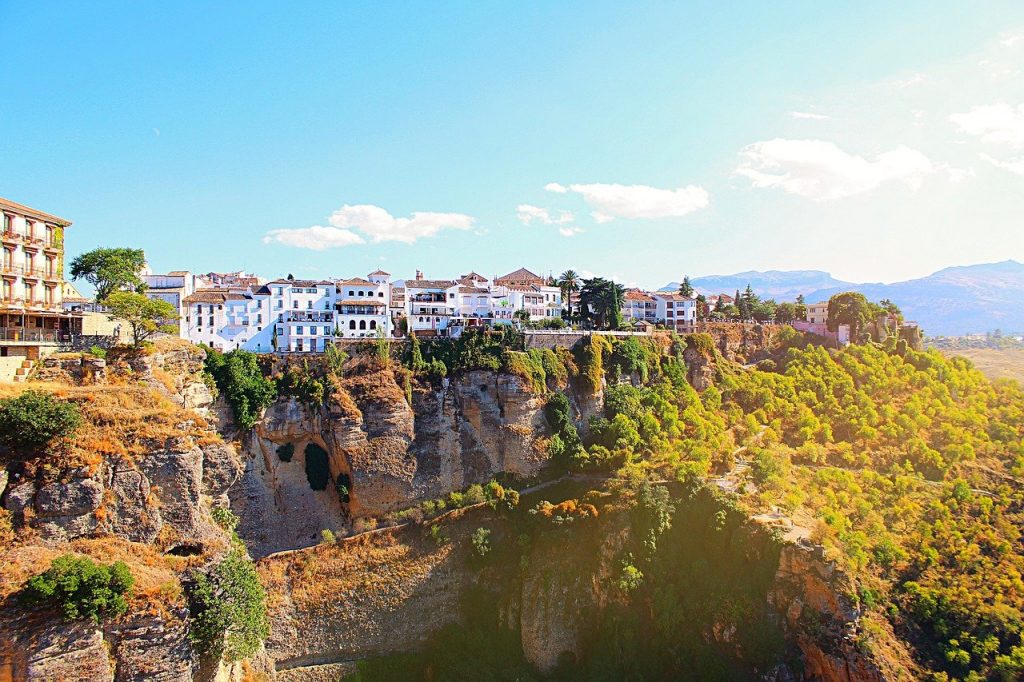
Take a Day Trip to Ronda
Seville is ideally located a short drive from many beautiful Andalusian locations. So, if you want to make the most of your time in the city, why not take a day trip? This is entirely optional but we highly recommend taking a trip to see the white villages of Andalusia. There are many beautiful and popular villages like Zahara de la Sierra, Arcos de la Frontera and Grazalema. However, we recommend visiting Ronda if you are on a tight schedule!
Ronda is an hour and forty minutes drive from Seville. It’s renown for its breath-taking beauty, (Hemingway wrote that it was the most romantic town in Spain) something that the whole family can appreciate. To spend your day there most efficiently, we have created this itinerary so that you and the family can discover its romantic charm with ease.
After arrival, head straight to the Puente Nuevo, the bridge that offers magnificent views of the El Tajo gorge! You’ll be amazed at the drop, but you can even get a closer look by walking into the gorge along the Camino de Los Molinos. Moving on you could take the kids to see the bullring, home to a historic Andalusian tradition of bullfighting. Ronda is said to be the home of this tradition which makes it the perfect stop on any Best Family Road Trip through Spain itinerary! Introducing kids to a new culture at a young age is very important, so we strongly recommend this experience. Other fun activities include: visiting the Mondragon Palace and the Miardor de Aldehuela viewpoints. With jaw-dropping views, you’ll be left with open mouthed wonder on your return.
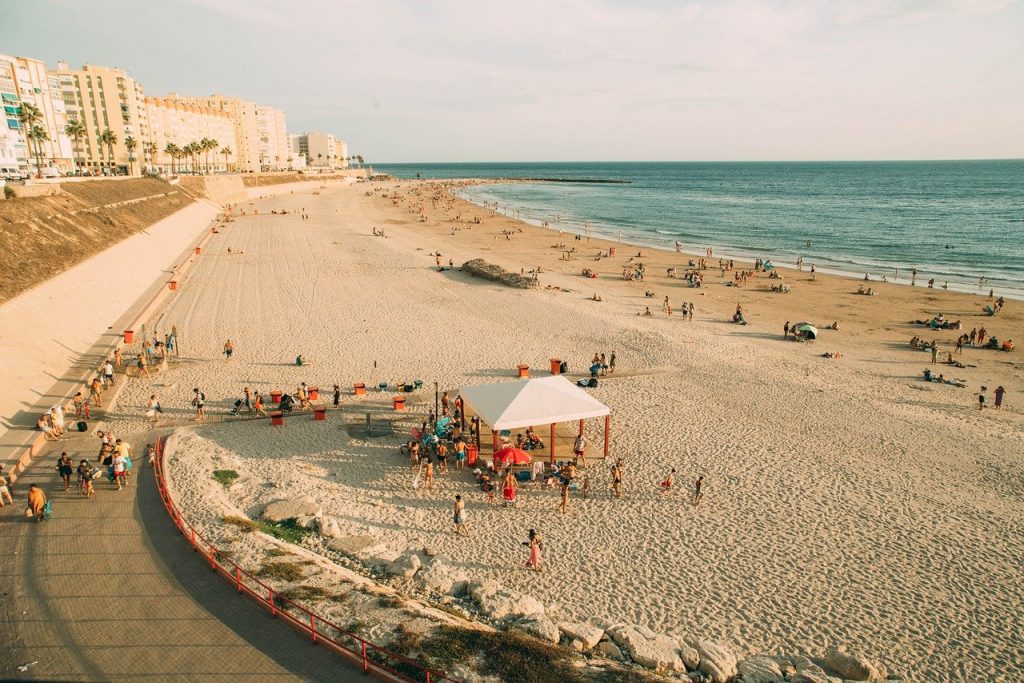
Jerez and Cadiz
No family road trip itinerary through Spain would be complete without a beach. A one hour drive from Seville will take you to Cadiz, a naval port that boasts multiple beautiful beaches. What better way to pass a sunny day in Spain? Let the kids build sandcastles and swim in the sea whilst you relax with a book. If you’re still hungry for culture, there’s also a beautiful cathedral in the central square to admire! Don’t miss the chance to enjoy the exquisite seafood fresh from the coast and use this city to truly relax.
Before you get to Cadiz, you may want to make a pit stop in Jerez. This will be hugely popular for the adults in the group due to their popular sherry production. Sample a tasting so that you’ll know exactly which traditional Spanish wine compliments tapas the best. You can also take the kids to visit the Alcazar as well as watch one of the thrilling dressage shows. The whole family will be mesmerised as the horses leap and gallop to the music. This road trip provides fun and education for parents and kids alike!
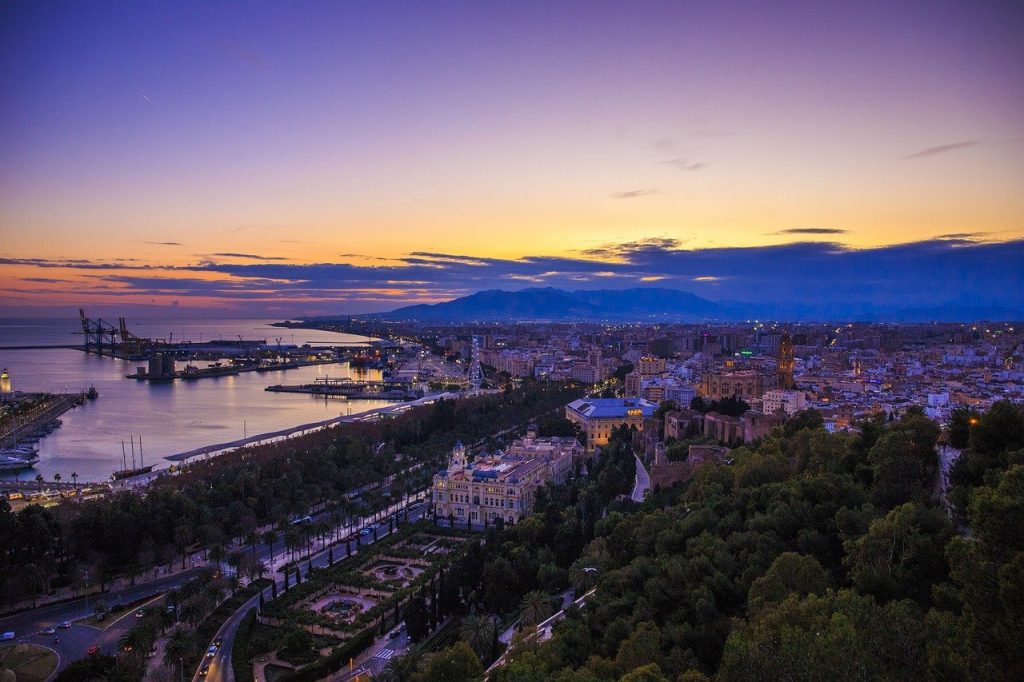
Finish the tour in Malaga
The last tour on this trip is the wonderful city of Malaga! A two and a half hour’s drive from Cadiz, Malaga is another city that offers easy access to a plethora of beaches. However, there’s so much more to this city than that. Although Malaga is best known for its nightlife, it has a range of family friendly activities . There’s another Museum of Imagination, an interactive music museum for the younger ones as well as cool historical attractions to explore. You can visit the Roman Theatre, Museum of Malaga and botanical gardens! Before you go, make sure to watch the sunset over Malaga bay. What better image to finish your fantastic road trip through Spain?
We can arrange for you to drop off your car before heading on your return flight home, so there really aren’t any details you need to worry about! Our family road trip itinerary through Spain is a guide and you can make changes to your destinations or duration as you please. Get in touch and we can work together to create a family holiday that will be treasured forever.
Post written by: Rhiannon Morris
Leave a Reply Cancel reply
Your email address will not be published. Required fields are marked *
- Panoramic Walking Tour- 2 hours
- Panoramic Walking Tour- 4 hours
- From the Rooftop
- Seville, a city of queens, nuns, prostitutes and witches
- Seville Photography Walking Tour
- Off the Beaten Path Seville Tour
- Private Guided Visit of Alcazar and Cathedral
- Alcazar & Cathedral Tickets
- Off the Beaten Path Tapas Tour
- Triana Tapas Tour
- Tapas and Flamenco Night
- Seville’s Highlights Bike Tour
- Highlights Electric Bike Tour
- Horse Riding Tour
- Hiking day trip from Seville
- Seville Stand up Paddle Surf
- A Local Friend in Sevilla
- Intimate Flamenco Show
- Eat at Home
- Walk and Talk – Learn Spanish on a Walking Tour
- Flamenco Box Percussion
- Online Gypsy Flamenco Party and Dance Lesson ⭐
- Online tour of Mediterranean diet & Hercules
- Flamenco Dance Lesson
- Seville April Fair Tour
- Holy Week Tour
- Living a Dream
- Wellness Experience
- Drinks at the Waterfront on a Boat Trip
- Chill out at Doñana
- Sunset with Music
- Champagne with a View
- Horseback Riding Tour
- Granada Day Trip
- The Kingdom of Cordoba & Carmona
- White Villages & Ronda
- Cadiz & Jerez Sherry Tasting Day Trip
- Iberian Ham Tasting & Cave of Aracena
- A Rock called Gibraltar
- Andalusia’s Best Beaches Day Trip
- Shore Excursion Cadiz Seville
- Doñana & El Rocio
- Olive Oil Tasting & Carmona
- Sherry & Wine Tasting at the ocean
- Diving in Tarifa
- Tangier day trip from Seville
- Chefchaouen day trip from Seville
- 2-day Morocco Trip
- 3-day Morocco Trip
- Traverse Granada’s Skyline
- Rags to Riches: Old Town, Albaicin and The Alhambra Ultimate Private Tour
- Private Guided Visit of the Alhambra
- Hiking Granada’s River
- Online Discovery of Spain with a Day in Granada ⭐
- Granada Tapas Trail & Gypsy Flamenco
- Walk, Talk and Devour Tapas From Granada’s Old Town To The Albaicin
- Granada Market tour & Food Tasting
- Hike The Caminito del Rey
- Travel Through Time to Torcal De Antequera & Dolmenes
- The White Village Ronda from Granada
- Complete Cordoba Daytrip
- The Villages of Alpujarra
- The Caves of Nerja & Frigiliana
- The Sierra Nevada Adventure Daytrip
- Horseriding in Granada
- Transfer from Seville to Lisbon Via Evora or Algarve
- Transfer from Lisbon to Seville Via Evora or Algarve
- Transfer From Algarve To Seville
- Transfer to Cordoba & Granada
- Private Transfer from Granada to Seville Via Ronda
- Transfer to Malaga & Ronda
- Transfer to Ronda & Granada
- Transfer to Tarifa & Morocco
- Custom Made Tours
- Seville & Andalusia Blog
- Morocco & Portugal
The Alhambra is in high demand and so it is not possible to make an immediate booking. Please contact us through our contact form with your preferred dates and number of people, and we will do our utmost to secure one of your chosen dates. Thanks!
The availability of these monuments for fixed time slots is not guaranteed. Please leave half a day free so we can accommodate you in the best possible time slot.
In case of cancelation the 3.5% credit card fee will not be refunded.
Username or email address *
Password *
Remember me Log in
Lost your password?
Email address *

Travel To Spain From UK
What You Need To Know
Travel to Spain From the UK
When it comes to travelling from the UK to Spain, there are several options available to suit different preferences and budgets. Whether you're looking for a quick flight, a scenic road trip, or a leisurely ferry ride, Spain is easily accessible from the UK.
There are also a few other things that you should prepare before your trip commences such as medical cover, travel insurance and the new Etias Visa Waiver system
In this article, we'll explore the main travel options, including air travel, road trips, and ferry crossings, plus provide you with all the information you need to plan your journey.
Air Travel:

One of the most popular and convenient ways to reach Spain from the UK is by air.
With numerous flights operating between major cities, you can easily find direct flights to popular Spanish destinations such as Barcelona , Madrid, Malaga, Palma de Mallorca, Alicante and Valencia.
Airlines such as British Airways, Ryanair, EasyJet, and Iberia offer regular flights from various UK airports. Try checking for low-cost flights via the Cheap Flights website , which often has special flight deals to Spain.
Flying to Spain provides the advantage of saving time and reaching your destination quickly. It's an excellent option for those looking for a hassle-free journey and limited travel time.
Additionally, many airports in Spain are well-connected to the city centers, making it convenient to explore your desired destination upon arrival.
Road Trips:

For those who enjoy the adventure of a road trip, driving from the UK to Spain offers a unique experience. The journey can be divided into several stages, allowing you to explore different countries and landscapes along the way.
The most common route is through France, where you can drive through scenic regions such as the Loire Valley, Bordeaux, and the Pyrenees.
Travelling by road provides the freedom to stop at charming towns, explore hidden gems, and take in breathtaking landscapes.
It's an opportunity to create your own itinerary and discover the beauty of multiple countries en route to Spain.
However, it's important to plan your journey in advance, considering factors like driving regulations, tolls, and accommodation options along the way.
Ferry Crossings:

If you prefer a more relaxed and scenic mode of transportation, ferry crossings offer a delightful way to travel from the UK to Spain.
Several ferry operators, such as Brittany Ferries and P&O Ferries , offer regular sailings from ports like Portsmouth, Plymouth, and Southampton to destinations including Santander and Bilbao in northern Spain.
Taking a ferry allows you to bring your car, giving you the freedom to explore Spain at your own pace once you arrive.
Onboard facilities like restaurants, bars, and entertainment options ensure a comfortable and enjoyable journey. Moreover, you can enjoy breathtaking views of the sea and coastline during the crossing, adding a touch of adventure to your travel experience.
Considerations and Tips:

Travel Documents: Ensure you have valid passports and any necessary visas for your trip.
Booking in Advance: To secure the best deals and availability, it's advisable to book flights, ferries, or accommodations in advance, especially during peak travel seasons. Our travel resources page will help you find deals and help you plan your Spanish holiday.
Travel Insurance: Don't forget to obtain comprehensive travel insurance that covers any potential emergencies or medical needs during your trip.
Local Regulations: Familiarise yourself with the local driving regulations if you plan to drive in Spain and ensure your vehicle meets the necessary requirements.
Itinerary Planning: Research your destination thoroughly and plan your itinerary to make the most of your time in Spain.
ETIAS Visa Waiver: The new ETIAS visa waiver system takes effect in November 2023.
Download our comprehensive article all about travelling to Spain . You can also download our FREE E-Guides , to help you plan your next holiday to Spain.
Medical Cover Whilst Visiting Spain

When you travel to Spain from UK you should be in possession of an EHIC or GHIC card and travel insurance .
- European Health Insurance Card (EHIC)
- UK Global Health Insurance Card (GHIC)
- Travel insurance with appropriate healthcare cover
An EHIC or GHIC is not a replacement for travel insurance. You should have both before you travel to Spain from the UK.
What EHIC and GHIC covers
An EHIC or GHIC provides coverage for state healthcare services and not for private treatment. With an EHIC or GHIC, you can receive the medically necessary treatment in Spain under the same conditions as a Spanish citizen. This means that you will receive healthcare services either for free or at a reduced cost.
However, it's important to note that an EHIC or GHIC is not a substitute for travel insurance. It does not cover all eventualities, such as mountain rescue or medical repatriation back to the UK. Therefore, it is recommended to have both an EHIC or GHIC and travel insurance in place before travelling to Spain .
If you do not have an EHIC, GHIC, or provisional replacement certificate (PRC), you may be required to pay the full cost for any treatment you receive within the Spanish healthcare system.
To ensure you have appropriate coverage and avoid any unexpected expenses, it is essential to carry a valid EHIC or GHIC and have comprehensive travel insurance in place before your trip to Spain. This way, you can have peace of mind and access necessary healthcare services while enjoying your time abroad.
How to apply for an EHIC or GHIC card?
You can easily apply for these cards for free on the NHS website .
How to use it
Show your EHIC or GHIC when you visit any state hospital or doctor.
Important: EHIC or GHIC cards will not cover private health care in Spain. private healthcare.
Latest Entry Requirements To Travel to Spain from the UK

Spain has dropped its ongoing Covid travel restrictions from October 2022, especially for those looking to travel to Spain from UK.
This means that vaccinated and unvaccinated travellers alike can now enjoy all that Spain has to offer without the worry of additional testing or proof of vaccination.
This should bring a sense of freedom and peace of mind to everyone looking to travel to Spain .
Travelling to Spain From The UK
The entry rules for UK citizens into Spain are the same as other EU and NON-EU citizens as far as the COVID-19 regulations are concerned, from the 21st of October 2022 you are NOT required to:
- Show proof of being fully vaccinated
- Show proof of a negative COVID-19 test
- Show proof of having recovered from COVID-19 in the last 6 months.
- No need to complete a health control form prior to travel.
Visa Requirements: The new ATIAS Visa Waiver system takes effect from November 2023.

At the moment UK citizens are not required to have prior approval or a visa to visit Spain or other EU countries. This, however, will change from November 2023 when the new ETIAS visa waiver system take effect.
UK citizens will be able to apply online for the European Travel Information and Authorisation System (ETIAS) for travelling to the Schengen area.
ETIAS is a visa waiver system that allows UK citizens to stay in the Schengen area for up to 90 days in a 180-day period.
To be eligible for ETIAS, UK citizens must have a valid passport that is valid for at least 3 months after their planned departure date from the Schengen area.
They must also have a valid debit or credit card to pay the ETIAS fee. In addition, you will need to answer a few security-related questions before submitting the application.
Applying for an ETIAS Visa Waiver
- Over 40 countries will require an ETIAS VISA
- The start date for ETIAS is November 2023
- The cost is € 7 per person.
- It is FREE for persons under 18 and over 70
- It takes approximately 1 hour for issuance once applied for.
- An ETIAS VISA will last 3 years.
To apply for the visa waiver you will need to visit the official ETIAS website which should be available close to November 2023. Hopefully, there will also be a mobile app available.
Applications will be available entirely online and all information you provide should be accurate and correct, failure to do so could result in unnecessary delays or outright rejection of your application
The process will take around 10 minutes, once complete you will receive within a short time the confirmation and authority to enter the EU.
The cost of the application is proposed to be €7 per person over the age of 18, you will need the following items to apply for ETIAS.
- A valid Biometric UK passport.
- A credit/debit card is used to pay for the ETIAS application.
- An active email address.
Please note that for Spain travel requirements your passport validity should have at least 3 months remaining before your intended departure.
For the ETIAS application, you will need to provide accurate information about you and your travel plans, including:
- Full name, place, date of birth, and gender.
- Full contact details such as your current address, email address, and phone number.
- Full passport details, date and place of issue, and your country of residence.
- Your travel plans such as which countries you plan to visit within the EU.
- There will also be a few questions relating to health and security.
Once the online application for ETIAS is launched, it is estimated that there will be an acceptance rate of approximately 95%.
In the event that your ETIAS application is rejected, you will receive an email providing detailed explanations for the decision and instructions on how to file an appeal if desired.
Once your application is approved, the ETIAS authorization will remain valid for three years, allowing you to stay in the Schengen Area for up to 90 days within a 180-day period.
Although at the moment the application process is not currently in operation you will be able to apply for an ETIAS Visa Waiver via the official EU Etias website here: https://travel-europe.europa.eu/etias_en.
Useful Phone Numbers in Spain
Emergency Services:
- Ambulance: 061
- Fire brigade: 080
- National police: 091
- Local police: 092
- Maritime Rescue 902 202 202
- National Police: 091
- Local police: 112 & 092
- Civil Guard: 062
Lost or Stolen Credit Cards
- Visa: 900 991 124
- American Express. 902 375 637
- Mastercard: 900 971 231
- United Kingdom: +34 917 146 300
- United States: +34 915 87 22 00
- France: +34 914 23 89 00
- Germany: +34 915 57 90 00
- Italy: +34 914 23 33 00
- Australia: +34 913 53 66 00
- Canada: +34 913 82 84 00
- Sweden: +34 917 02 20 00
- Denmark: +34 914 31 84 45
- Japan: +34 915 90 76 00
European Wide Emergency Number:
- Emergency services: 112
Disclosure: Please note that some of the links included in the above content may be affiliate links. We may earn a commission if you make a purchase at no extra cost to you. Rest assured, we only recommend products and services that we personally use or have used and are happy to recommend. Any commission we earn helps toward the site's running costs.

Travel Smarter - Not Harder
Download free e-guides and travel tips.
Start your Journey today and get access to exclusive FREE content.
Username or Email Address
Remember Me
- WHY VISIT SPAIN?
- TRAVELLING TO SPAIN
- SPAIN ON A BUDGET
- TRAVEL REQUIREMENTS – ETIAS
- SPAIN ENTRY REQUIREMENTS
- SPANISH CUISINE
- SPANISH FOOD
- HOLIDAY IDEAS
- PUBLIC HOLIDAYS
- TOURISM BOARDS
- AIRPORT GUIDE
- DRIVING IN SPAIN
- WEATHER IN SPAIN
- FREE WEB CAMS
- BEST BEACHES SPAIN
- FESTIVALS & FIESTAS
- MUSEUMS IN SPAIN
- CAMPING IN SPAIN
- MARINAS IN SPAIN
- SKIING IN SPAIN
- WATER PARKS
- UNESCO WORLD HERITAGE SITES
- 80 BEST ATTRACTIONS
- 71 BEST PLACES TO VISIT
- REGIONS OF SPAIN
- COSTA DEL SOL
- CANARY ISLANDS
- SAN SEBASTIAN
- Complete List:
- SAGRADA FAMILIA BARCELONA
- BARCELONA FC STADIUM TOUR
- BARCELONA FLAMENCO SHOW
- SEVILLE FLAMENCO SHOW
- SEVILLE CATHEDRAL
- GAUDI`S CASA BATLLO
- THE ALHAMBRA GRANADA
- SANTIAGO CATHEDRAL
- CITY OF ARTS & SCIENCE VALENCIA
- MOSQUE-CATHEDRAL CORDOBA
- CAMINITO DEL REY
- PRADO MUSEUM MADRID
- REINA SOFIA ART MUSEUM
- SCUBA DIVING
- BEST TAPAS TOURS
- BEST WINE TASTING TOURS
- TOUR GUIDES
- HOTELS IN SPAIN
- LUXURY HOTELS
- LUXURY BEACH HOTELS
- HOLIDAY RENTALS
- PARADOR HOTELS
- CHEAP FLIGHTS
- TRAVEL INSURANCE
- FREE TRAVEL BROCHURES
- WIN FREE HOLIDAYS


Driving a Motorhome From the UK to Spain (Read this first!)
- Post author: Roadtripbuzz
- Post published: July 26, 2022
- Post category: Uncategorized
Driving a motorhome from the UK to Spain is doable and takes 1-2 days, depending on the route. The shortest road route involves driving through France, which takes a day and costs £270 for a one-way trip. A one-way ferry trip for two adults and a motorhome will cost you between £400 and £700.
If you’re on a budget, you want to take the shortest route dotted with as many must-see places as possible. The amount of vacation time will also determine how you plan your trip.
This post will cover the possible itineraries for driving from the UK to Spain in a motorhome, the budget, and the best times to visit.
Read on to learn more.
Table of Contents
How much does it cost to drive a motorhome from the UK to Spain?
The cost of traveling from the UK to Spain in a motorhome largely depends on whether you choose to drive down through France or take a ferry from the UK.
Driving through France is the cheaper option costing £270 for a one-way trip. On the other hand, a one-way ferry trip for two adults and a motorhome costs between £400-£700 with Brittany Ferries .
Let us take a look at each of these options further.
Driving your motorhome through France into Spain
Your journey through France to Irun in a motorhome will be close to ten hours. The tolls on this route will cost you an estimated €180; it could be more if you’re driving a big motorhome of upwards of 3,500 kgs.
If you’re planning a more extended vacation, like a month, consider taking the longer but more-scenic non-toll roads through France into Spain.
Familiarize yourself with the road rules of France and Spain before embarking on your road trip.
Itinerary #1: Travel from the UK to Spain through the historical sites in France
Best time of the year to attend: March to June during spring and autumn when the weather is perfect for a road trip.
Suitable for: The entire family and those with a short vacation period as it is the shortest route from the UK to Spain. This route passes through historic sites and will prove a big hit for lovers of historical monuments.
Duration: An 11-hour non-stop drive from Calais, South of the UK, through France, and into San Sebastian in northern Spain.
Things to see:
- Historical castles
- Mountain roads
- Beautiful cities like Bordeaux, Orleans, Toulouse, and San Sebastian.
Distance: 685 miles or 1,100 kms.
Take the tunnel from the UK to Northern France.
The trip takes you through the following places: Tours, Bordeaux, and road N10. The road gets you to the border crossing and then brings you to the town of San Sebastien.
You can drive for two days to enjoy the historical sites along the way and spend the night at Poitiers.
However, this route includes several tolls that can cost about €160 one-way if you’re driving a motorhome. Plan well for the expense.
Itinerary #2: Travel the toll-free route through France
Best time of the year to attend: March to June
Suitable for: For younger people who love a longer route for the adventure. The best way to use if you’re keen on saving as it avoids all the tolls.
Duration: A 14-hours non-stop drive from Calais, through the towns of Rouen, Le Mans, Poitiers, and Bordeaux in France, and into San Sebastian in northern Spain.
- National parks
- The wine region of Bordeaux
- Historical buildings
Distance: 669 miles or 1076 km from Calais to San Sebastian.
Take note that this route can be slow as there are sections with a single driving lane.
You may also like: 17 Reasons Why Road Trips Are Good For You
Itinerary #3: Travel the scenic course through Paris, Limoges, to Bilbao.
Best time of the year to attend: April to October
Suitable for: lovers of picture-perfect landscapes. The route takes you through the city of Paris.
Duration: 13hr 30 minutes on a non-stop drive.
- Medieval buildings in Limoges
- Museums and castles
Distance: 771 miles or 1240 km from Calais to Bilbao in Spain.
Itinerary #4: Taking a ferry from the UK to Spain for those who love traveling by sea
If you are driving a motorhome from the UK to Spain, a one-way ferry trip for two adults and a motorhome costs between £400-£700. The 24-hour ferry journey starts from the ports of Plymouth or Portsmouth in the UK to Santander or Bilbao in Spain without going into France.
Suitable for: Everyone who loves traveling by sea. If you easily fall seasick over long journeys on water, you may want to consider the other itineraries.
Duration: The journey by ferry takes between 21-32 hours, depending on the weather conditions, distance covered, and the type of vessel.
You can save by using Brittany Ferries , which offers an economical sailing option on weekends.
If you fall sea sick, be warned of the rough waters at the Bay of Biscay, particularly if you are traveling in winter (mid-Dec to March) or at night.
On the ferry, you can spend the night on the reclining seats that can get squeaky over the journey. Alternatively, book a cabin and enjoy a good night’s rest as you sail.
For some, the prospect of missing out on France in their itinerary makes the ferry ride unattractive. Besides, it typically costs more than a drive through France.
Check out the ferry schedules on the various routes if you plan to use the ferry crossing.
The ferries offer cabins that allow for pets. Nonetheless, you need to book in advance as the pet-friendly cabins are limited in number.
You may also like: Should I go to Valencia or Barcelona? (Answered!)
BONUS: Flying into Spain and hiring a motorhome
If you find driving a motorhome from the UK to Spain unaffordable or the journey too tedious, you can fly to Spain and hire a motorhome.
Flying from London to Madrid takes 2hrs 25 mins and costs $140-$150 per person. On average, hiring a motorhome in Spain costs $100 to $250 a night.
There are multiple motorhomes and campervan hire companies across Spain’s major cities. If you don’t own a motorhome, you can still enjoy the ride with your family and explore Spain fully.
Major Motorhome hire companies like the Motorhome Republic, SouthCamper Rental Vehicles, Auto Europe, and Flamenco Campers Rental Vehicles have offices in cities like Madrid, Bilbao, Seville, Barcelona, La Coruna, and Santander.
Hiring a motorhome has its benefits. You don’t have to focus on the heavy lifting when planning the trip, maintenance of the motorhome, or incurring costly tolls. You fly in, hire a motorhome, and hit the road running.
You may also like: Why road trips are better than flying? (Answered!)
Motorhome rules in Spain
Driving a motorhome from the UK to Spain is relatively easy because other road users are considerate and the roads are also in excellent condition.
You can expect traffic jams in the main cities such as Barcelona, Madrid, and Paris but this is well compensated for by the clear roads that stretch through the countryside.
For motorhomes weighing below 3,500 kg, the speed limit in urban areas is 30km/h, 80km/h outside urban areas, and 100km/h on highways.
For motorhomes that weigh more than 3,500kg, the speed limits are 30km/h in urban areas, 80km/hr outside areas, and 90km/h in autopistas.
How long can you stay in Spain?
You can spend two weeks to a few months exploring Spain. Note that you will take 1-3 days from the UK to Spain on a motorhome. Beware that the journey eats up a chunk of your vacation stay in Spain. Ultimately, the length of your stay depends on where you want to visit.
Your budget also dramatically affects how long you can stay in Spain.
Requirements to drive from the UK to Spain
Acquaint yourself with the speed limits for motorhomes in Spain and adhere to them to avoid hefty fines.
- You must be 21 years or more
- You need to have a minimum of 3 months remaining on your passport on the date when you plan to leave Spain.
- At a minimum, your motorhome must have a 3rd party insurance cover.
- You should own the vehicle logbook and a trailer certification where required.
- You should have medical and personal travel insurance.
- You do not require an International Driving License if you already have a US or UK driving license.
- For those coming with pets, carry an Animal Health Certificate.
You may also like: 3 Week European Road Trip Itinerary (11 Options)
We have explored the various routes you can use to drive your motorhome for the UK to Spain, how much it costs, and how long you can stay in Spain. If you appreciate sightseeing landscapes and historical sites, then drive through France.
If you love traveling by sea, the ferry is an option that can get you from the UK to Spain. If you’re planning to embark on a road trip from the Uk to Spain on a motorhome, then check out this video.
You Might Also Like

Top 7 Best Motorcycles for the Pan-American Highway

Is the Pan-American road paved?

Can You Rent a U-Haul for a Road Trip?
Join our Adventure: Get all my insider tips for motorhoming & road trips

Motorhoming & Campervanning in Spain- The Ultimate Guide
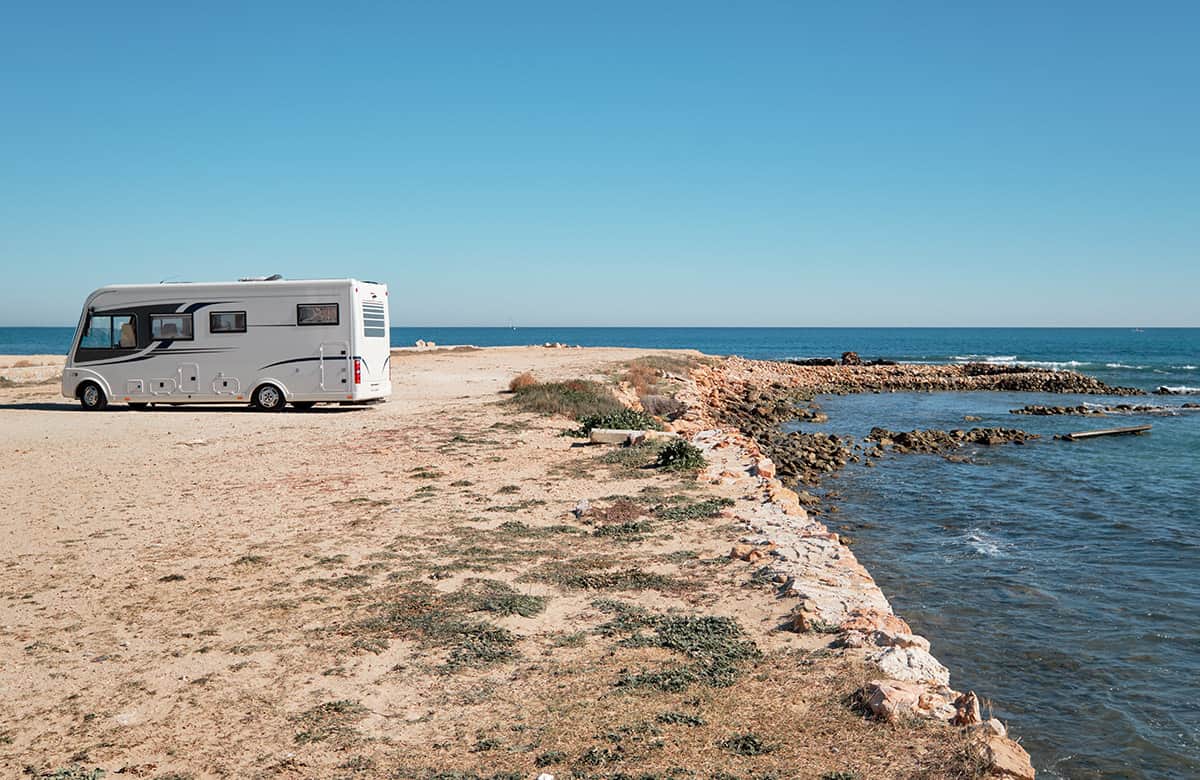
Planning to tour Spain with a motorhome or campervan? There are some essential things you need to know before your trip, including important paperwork and kit to bring with you. Here’s everything you need to know about campervanning or motorhoming in Spain.
Don’t forget to grab your FREE motorhoming in Europe checklist below to help you stay organised and remember everything you need.
*We work hard to make this the best motorhome travel blog and road trip website possible, full of helpful content for you. The website is supported by our readers, so if you buy through links on this site we may earn a commission- at no extra cost to you. All opinions remain our own .
If you find this post useful, you can also treat us to a coffee – we promise to enjoy it while creating more useful content like this- we might even indulge in a biscuit (or two!)
JUMP AHEAD TO...
Motorhoming in Spain- why you should go!
When you think of Spain, many people think of overcrowded beaches in Benidorm, drunken teenagers and possibly Sangria. But, I promise you, there is much more to Spain than the Costa del Sol, especially if you’re travelling and touring in a motorhome or camper.
The landscape changes from the rugged north, with mountains and scenic views to rival anywhere else in Europe, to the desert and arid areas, to the sparkling azure blue of the Mediterranean. There is history and culture everywhere you look, as well as friendly and welcoming people, delicious food and SUNSHINE- even in winter.
Planning to take your motorhome to Europe?

GUIDE: Stop the overwhelm with our step-by-step guide. Contains eBook, checklists and more. Complete Europe Motorhome Travel Toolkit
CHECKLIST: Don’t forget to grab your FREE Europe motorhome travel checklist HERE
GEAR – If you need any motorhome gear for touring Europe, here’s what we recommend.
Campervanning in Spain- Where to go
When planning a motorhome tour of Spain, the first thing you need to do is to figure out where you’re going (and how long you have for your road trip!)
If you’re driving from the UK to Spain (we’ll cover that shortly), you need to allow the time it will take to drive through France to Spain (and back again!) Of course, if you only have a week for your holiday, travelling from the UK and back leaves only a few days to explore the country, and the further south you go, the less exploring time you have.
On the other hand, if you have 10-14 days or longer, you can get a lot further south, certainly as far as Costa Blanca or Andalucia and possibly even get to enjoy motorhoming in Portugal if you’re happy to drive every day.
When to go motorhome touring in Spain
Touring spain in winter.
In our opinion, southern Spain is the perfect European winter destination. It’s warm for one thing, and there’s nothing like a little sunshine to chase away those winter blues. It’s one of the warmest places in Europe in February – average temperatures in Malaga are 18°c (but only 12°c in Madrid- that extra bit south does make a big difference)
In the past, Spain has been VERY crowded during the winter months, especially in the south. Many Northern Europeans (like us Brits!) head to that area to get some winter sunshine.
However, now that BREXIT has happened and rules have changed (more on that later too!), you might find things a little quieter, certainly with British vans.
READ MORE: Discover the best & warmest places to enjoy winter in Spain
Northern Spain is mountainous and you can expect snow during winter- and it will be cold, even on a sunny day (just like in the Alps or any other mountain range.) If you’re planning to stay to the north, you’ll need to bring warm clothing.
Spain Motorhome Touring in Summer
Of course, Spain is a classic summer destination, and it can be CROWDED, especially at the UNESCO world heritage sites in Spain and on the beaches. For us, we find it too hot during high summer, especially as we travel with a dog and keeping a dog cool on a road trip is never easy (especially when they’re a cocker spaniel who doesn’t understand the meaning of the word ‘chill’…!)
If you are going to be travelling to Spain during summer, we highly recommend you have an awning- you’ll definitely need the shade and protection from the sun. You’ll probably also want some form of air conditioning or at least a fan in your camper- temperatures can get up to 40+°c
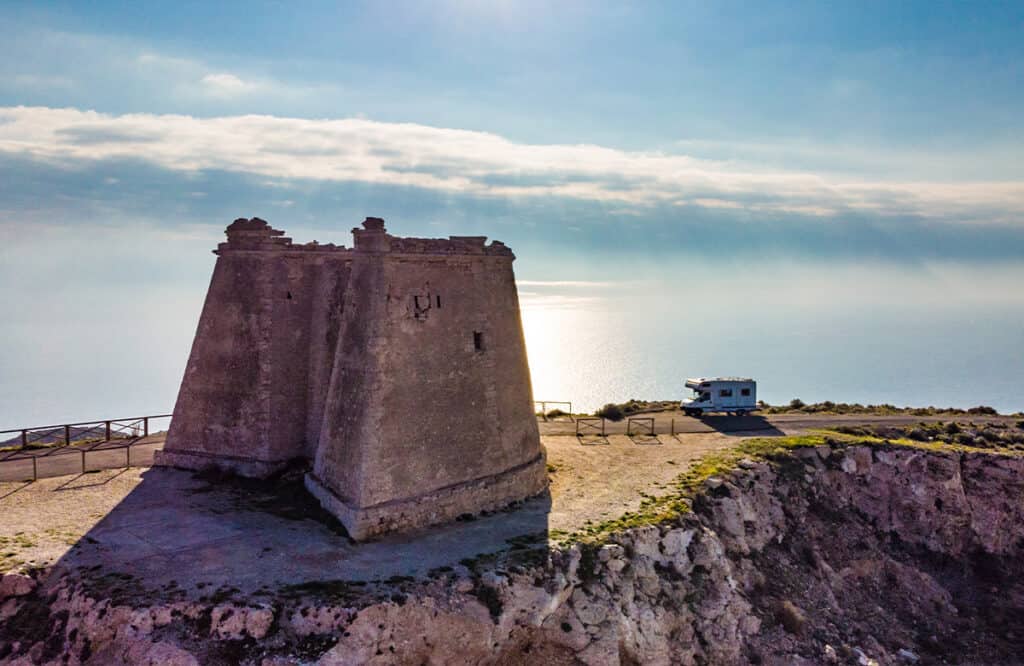
Road tripping Spain in Spring and Autumn
The best times to visit are probably the shoulder seasons of Spring and Autumn. Temperatures are still warm enough to enjoy the beaches and swimming in the sea, but there are much fewer tourists and you will be able to find motorhome parking without booking in advance.
TOP TIP: If you are travelling outside of peak season, definitely get an ACSI CampingCard – you’ll save a fortune on campsites all over Europe, including Spain
Planning a driving route from UK to Spain
For some reason, driving from the UK to Spain seems to confuse people.
Perhaps it’s because there are several options, or perhaps because there’s a mountain range in the way, but it’s something which gets asked over and over again in Facebook groups and forums (feel free to join our motorhoming Facebook group here)
Ferry or driving from UK to Spain?
The first question to ask yourself if whether you want to drive from the UK through France and down to Spain, or whether you want to take a ferry direct from the UK and sail around the coast and down to northern Spain.
Generally, taking a ferry from the UK to Spain is much more expensive than driving through France (depending on time of year and type of cabin).
New to motorhome or camper travel in Europe? You might find these posts helpful:
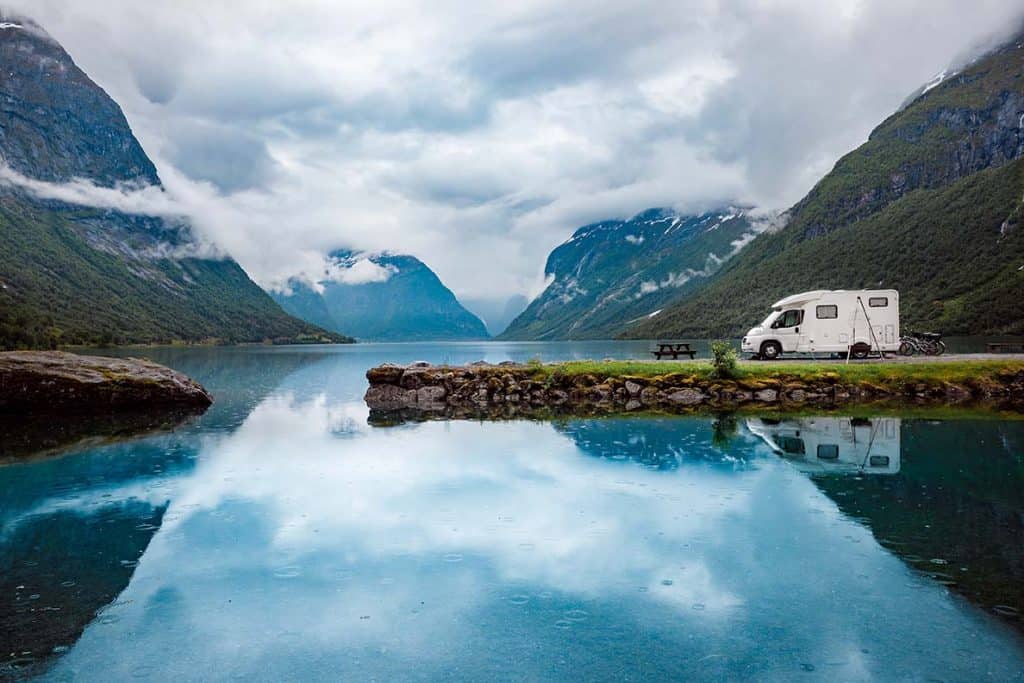
See all our Europe motorhoming posts here
NEED GEAR? If you need any kit or essentials for motorhoming in Europe, here’s what we recommend and where to find it
Ferry with a motorhome direct to Spain
You can travel with Brittany Ferries from Portsmouth or Plymouth and go to either Santander or Bilbao (both on the north coast of Spain)
A one-way trip takes about 24 hours and booking a cabin is recommended. They also have dog kennels onboard but you CANNOT keep your dog in the ferry cabin with you (like you can from Portsmouth to Caen).
The biggest consideration to this ferry (apart from the cost), is the weather. You will be crossing the notorious Bay of Biscay- and it can get ROUGH. Even in the middle of summer. As someone who gets seasick (hilarious considering I’m ex-Navy and lived on boats for 15 years) , I avoid this crossing and prefer to drive from the UK through France to Spain, but it’s entirely up to you.
Driving through France to Spain
If you decide that you want to drive your motorhome or camper down to Spain, you first need to decide if you’re going to take the ferry or tunnel from UK to France (there are pros and cons to both).
Then you have two main routes through France to Spain. Each route takes about a day to drive, so take this into account when planning your Spanish road trip itinerary.
Route 1 is via Tours, Bordeaux and down the Atlantic coast on the N10 until you cross the border between Biarritz and San Sebastian. You can join this route easily if you decide to come over on a ferry to Caen, Le Havre, Dieppe or Cherbourg.
This is our favourite route for a France road trip as you pass some incredible places (including some of the most historic places in France! )
Route 2 is straight south from Calais, skirting around Paris and then down to Clermont Ferrard and Perpignan on the A75 (which is largely free from tolls). The huge highlight from this route is crossing the Millau Viaduct in your motorhome or camper- it’s well worth the experience.
Of course, you can always drive down one route and back up another!
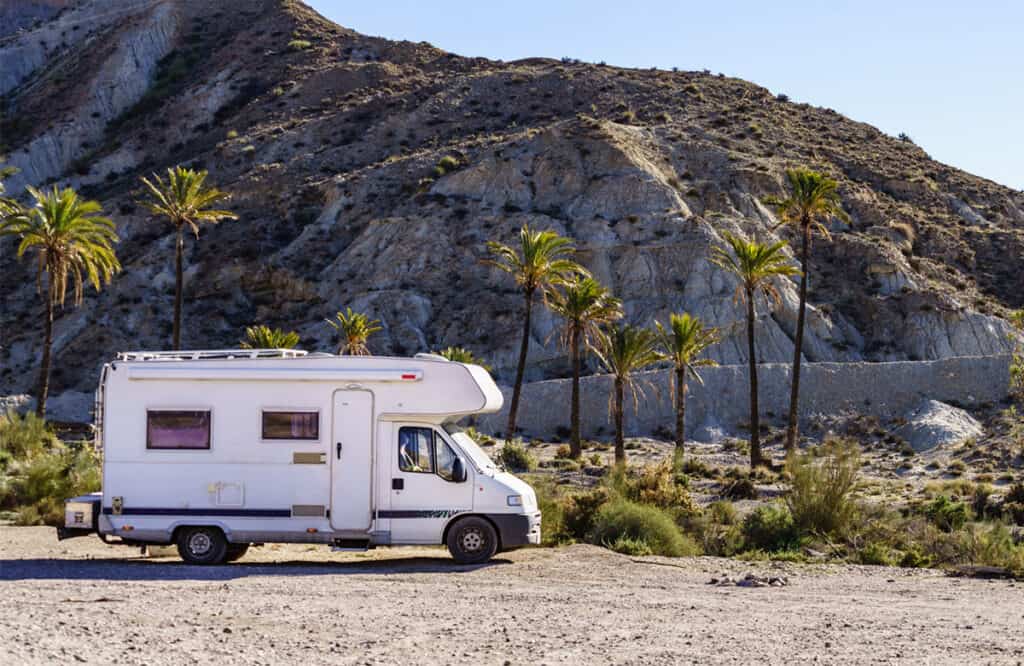
Can I drive to Spain in the Winter?
Yep. I know there are those HUGE mountains called the Pyrenees, but the routes are all open, unless you happen to be really unlucky and hit it in the middle of a snowstorm (do check the weather forecast before travelling.)
If this happens, then we recommend stopping for the night somewhere safe (the beauty of travelling in a motorhome) and then continuing on when the snow has stopped and the roads have been cleared. Don’t forget you will need snow chains and make sure you have fitted all-weather tyres.
Hiring a motorhome or camper to tour Spain
If you don’t have your own vehicle, you can easily fly into Spain and hire one. Just make sure to ask how to get from the airport to the rental agency- not all of them are at the airport itself and you might need to book a taxi.
Don’t forget, it is YOUR responsibility to make sure the vehicle has the required safety equipment. The on-the-spot fines apply to you as the driver, not the company. Check in advance with the company what kit they will provide with the vehicle and what you will need to bring.
Take a list of what is legally required with you and check it off one by one as you are given the handover. Do not drive until you are happy you comply with the local laws.
Make sure you have proof that you can take the vehicle across a border into another country if that’s what you’re planning to do. Read the article below for other things to check as well before you agree to hire.
Want to rent a vehicle for your road trip?
These might help:
- Discover incredible deals for motorhome/ camper rentals
- Find the best deals for car rental
READ: 10 essential questions to ask before you rent a motorhome
Daytime Motorhome Parking in Spain
You can park a motorhome during the day anywhere parking is allowed (as long as there are no signs banning motorhome parking) and as long as you aren’t overhanging a space or blocking the road.
Many places have a sign saying NO motorhome overnight parking, but you are fine to park during the day. You can pull over into a rest stop and eat and drink within your vehicle, but setting up a table and chairs next to the road is not allowed.
Nor is getting out the awning and putting up your TV aerial. (Yes, you will see other people do it- some areas are stricter than others. If everyone else is, feel free to join them but remember you may be asked to move on.) Remember, this is for daytime parking for motorhomes- let’s move on to overnight parking…
Campervanning in Spain- motorhome overnight parking
As with most countries in Europe, you have four options when it comes to where to park your motorhome or camper overnight:
- Motorhome campsites
- Approved motorhome overnight parking places/ aires
- Free approved overnight parking spots/ schemes
- Motorhome wild camping spots
Sadly, Spain is getting tougher about free overnight motorhome parking spots and many places now ban them completely. Legally, you’re only allowed to stay on approved overnight motorhome spaces or campsites. Wild camping is not allowed in any of the Spanish National Parks.
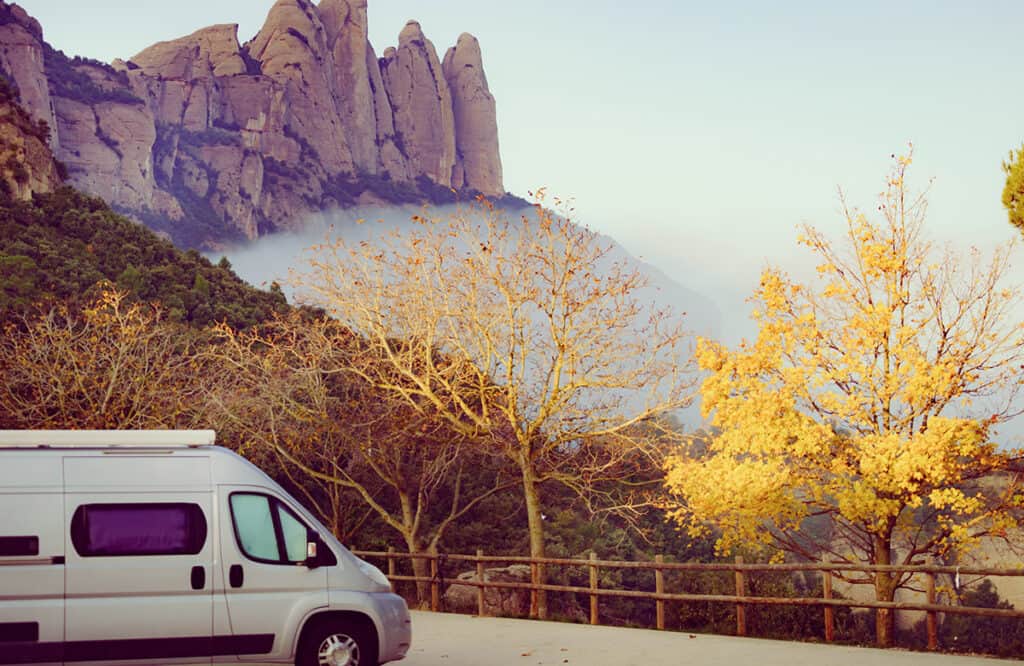
Motorhome campsites in Spain
It’s easy to find motorhome campsites in Spain and they’re much like campsites anywhere else in Europe. Some are rustic and have basic facilities, while others are designed for long-term visitors and have entertainment, clubs, pools and bars! Expect to show your passport or identification on arrival and many places require you to leave one passport behind the reception.
If you’re travelling out of high season and are planning to use campsites, we highly recommend buying an ACSI CampingCard membership , but be aware that many campsites either shut during the winter or are booked up entirely months in advance, so you may wish to book one too. Also, many campsites put ACSI users on ‘lesser’ pitches (either bad view or no electric or drainage). You can ask for a different pitch, but will usually need to pay a supplement which wipes out the ACSI discount!
At some campsites, you will need to pay extra for shower or electric usage. Be warned- the hot water in the shower is on a timer- usually between 3-5 minutes per token. Water is regulated in much of the country, especially in the south, and many sites provide de-salinated water instead of potable.
We recommend you don’t drink this water and also clean out your motorhome freshwater tank thoroughly before refilling it to get rid of the particles found in de-salinated water.
TOP TIP : If you’re planning to stay in one area for a long time (30+ days), negotiate a special rate with the campsite directly. Most of them have some sort of discount- some are as little as £10/ day, including electric.
Motorhome Aires in Spain
Aires are just approved motorhome overnight parking places- often provided and maintained by the local commune. If you’ve been motorhoming in Italy , you might surprised to learn that aires are called Aires in Spain, just like in France (they’re called Sostas in Italy).
There aren’t quite as many aires in Spain as in France and they’re often a little more out of the way, but the network is still very useful and easy to use.
READ MORE: Learn how we find and use aires and approved free overnight motorhome stopovers across Europe
You cannot book motorhome aires in advance- it’s first-come, first-served, so if you’re visiting at peak times you might feel happier booking a campsite so you’re assured of somewhere to stay.
A good tip is to try and arrive AT your destination just before lunchtime. Many people move on after. a lazy morning, and stop en-route, so you have the best chance of finding a spot around this time, but that’s when the day is at its hottest, so be careful.
It’s always worth investing in a book of aires, as well as an online app- just in case you find yourself without internet in your motorhome (or without a wifi signal). Of course, the downside with any book is that it goes out of date, but don’t worry if it’s only a year or two out- most information about aires won’t change too much.

Wild camping in a motorhome in Spain
Like much of Europe, wild camping in Spain for motorhomes and campers is ‘tolerated’ in many places but not strictly legal and it’s certainly not a right. Many people seem to think they can turn up and park wherever they want, but this is not the case.
Motorhome wild camping guides for the UK & Europe

For information on how to find good wild camping places, WHAT to do when you’re there and how to stay safe, check out our step-by-step guide for motorhome wild camping in the UK and Europe, complete with database of 250+ overnight spots we’ve stayed with our motorhome.
Don’t forget to grab your free wild camping checklist here
In practicality, you’ll find that the further from civilisation and the beach you are, the better your chances of finding a quiet, free overnight parking spot will be. If in doubt, you can always ask at the tourist office or town hall- many places are happy to allow you in their car park for the night.
However, with a little common sense and staying within the restrictions, it’s often possible to stay off-grid with your motorhome or campervan.
- Don’t try and wild camp on the coast unless you’re somewhere REALLY remote (more likely to be allowed in the North and centre of Spain)
- Don’t try and wild camp in busy/ popular areas- like the Costa del Sol- unless you’re visiting in the lowest of low season. Anywhere near the beach will be tough all year.
- Get the permission of the landowner if possible
READ MORE: There are some basic rules to follow whilst motorhome wild camping – here’s everything you need to know to stay safe and find free spots.
Can you wild camp with a motorhome in the Spanish National Parks?
No- wild camping is not permitted in any of Spain’s National Parks.
Other Motorhome stopovers in Spain
If you’d like to avoid campsites and aires, but don’t want to risk staying off-grid, there is a scheme which connects business owners to people motorhoming or campervanning in Spain, called Espana Discovery .
You can buy an annual guide for just 27€ (in 2023) and it gives you access to over 200 businesses which allow motorhomes to park up overnight in exchange for buying a meal in their restaurant or a few bottles of wine at the vineyard. Some spots are even right on the beach!
Motorhoming in Spain- what gear do you need to carry?
Just like motorhoming in France , there are certain things you MUST carry with you in your motorhome or campervan whilst touring in Spain.
Don’t forget, if you are driving through France to get to Spain, you need all the kit required by France as well as the kit for that country.
Grab your FREE France travel checklist so you remember it all!
Planning a trip to France with your motorhome or camper?
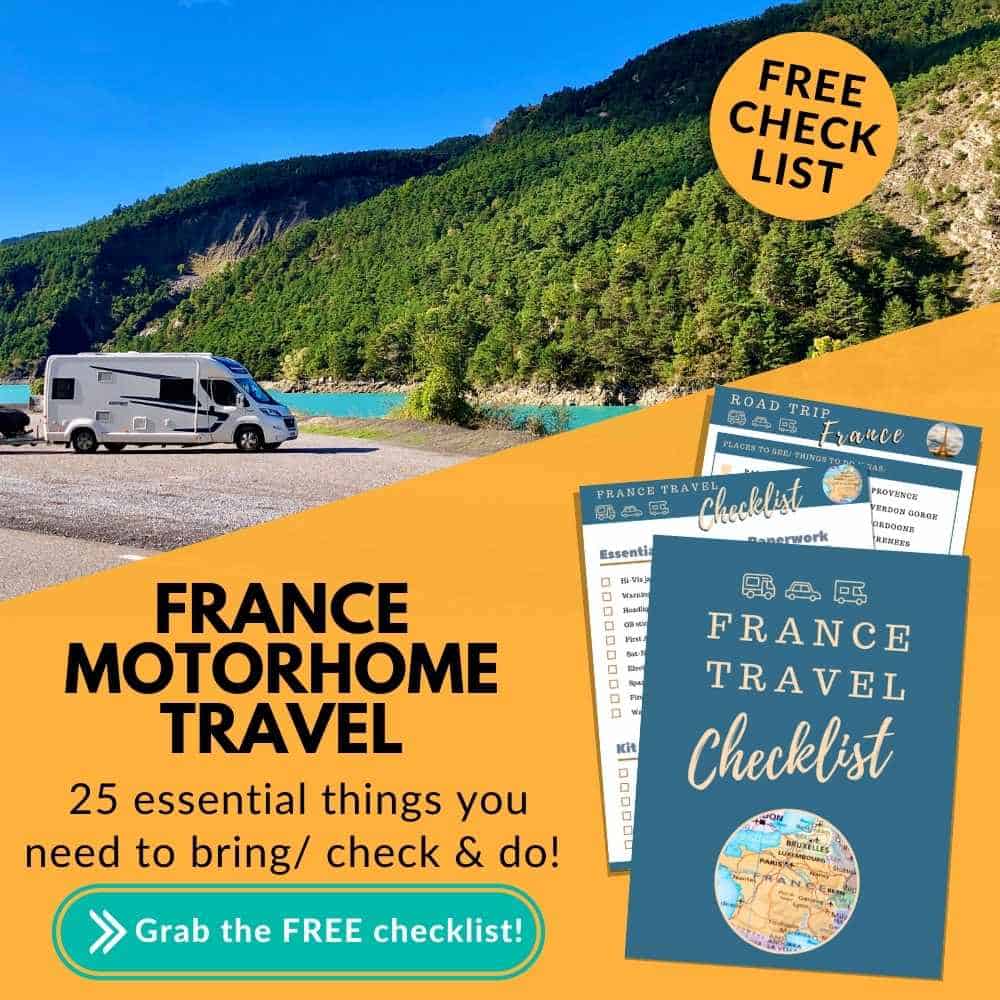
GUIDE – For a step-by-step guide, with video walkthroughs of aires, motorhome set up, checklists and more, grab our France Road Trip & Motorhome Travel Planner
CHECKLIST – Don’t forget to grab your FREE France motorhome travel checklist HERE
GEAR – And if you need any motorhome gear for touring France or Europe, here’s what we recommend.
Things you need to drive in Spain- safety gear
These are the things you MUST have with you when you’re motorhome or campervan touring in Spain.
- Hi-vis reflective jackets – not as strict as in France, but you must wear them on the side of the road or hard shoulder or risk being fined.
- Warning triangle
- Headlight beam converters – must be fitted before you drive in Europe. Some vehicle allow you to adjust the beam automatically so you won’t need these.
- UK sticker attached to the back of vehicle or reg plates (and trailer if you have one)
- A spare wheel (and tools to change it!), or a tyre repair kit.
- If you wear glasses you MUST carry a spare pair!
- If you’re towing with your motorhome or campervan in Spain and the overall train length is 12m or more you must have at least one yellow reflector on the rear, sized 130cm x 25cm (or two sized 50cm x 25cm).
- Red/ white warning board sign – for bike racks or anything overhanging the end of the motorhome or campervan. Lines must point into the middle of the road.
TOP TIP: Buy these essentials for driving in Spain in advance. One of the cheapest places is on Amazon . If you wait until you’re at the ferry/ tunnel, you could spend THREE times as much!

Road trip accessories you MIGHT need when campervanning in Spain
The following kit are things you might need to carry in your car, motorhome, caravan or campervan, depending on when you are planning your road trip in Spain.
- If you are travelling between 15 October and 15 April and driving near the mountains, you will need to have winter/ all- season tyres and carry snow chains. Make sure you check them in advance! If you’re not sure, read THIS
- First aid kit – not compulsory in Spain (unlike many countries in Europe) but worth carrying. Find out what we carry in our European first aid kit here
- Spare bulbs for all lights in the vehicle
- Fire extinguisher
- Road Trip snacks and water- just in case!

Motorhomes or campers with a total train length of over 12m
If you’re travelling in Spain and your outfit exceeds 12m, you need to have marker boards fitted to the back of your vehicle. You can either have two small boards or one large board but they must be placed at the back of the outfit between 50cm and 150cm off the ground.
Your marker board must:
- be yellow in the centre with a red outline
- be made out of aluminium
- be manufactured to ECE70 standard
What documents do you need to drive in Spain?
If you’re driving in Spain, you need to carry the following documents:
- Passport (or identity card)
- Driving licence (check it is in date!)
- Motorhome Insurance documents- check you are covered for driving in Europe
- Breakdown cover
- Vehicle V5 logbook (which must show your correct address)
- Vehicle must be legally taxed and MOT’d
- Trailer certification
- International Driving Permit if required
- Personal travel insurance
Do I need a green card to drive in Spain?
Most UK vehicles do not need a green card to drive in Spain. You may need one if you are towing a trailer- please check with your insurer to be safe.
Do I need an international driving permit to drive in Spain?
Most UK citizens do not need an IDP to drive in Spain, as long as you have a card driving licence issued in the UK (in date, of course!)
You might need one if you have:
- a paper driving licence only
- a licence issued in Gibraltar, Guernsey, Jersey or the Isle of Man
(If you do need an IDP, here’s an in-depth guide on how to get an International Driving Permit and which one(s) you need from a UK post office.
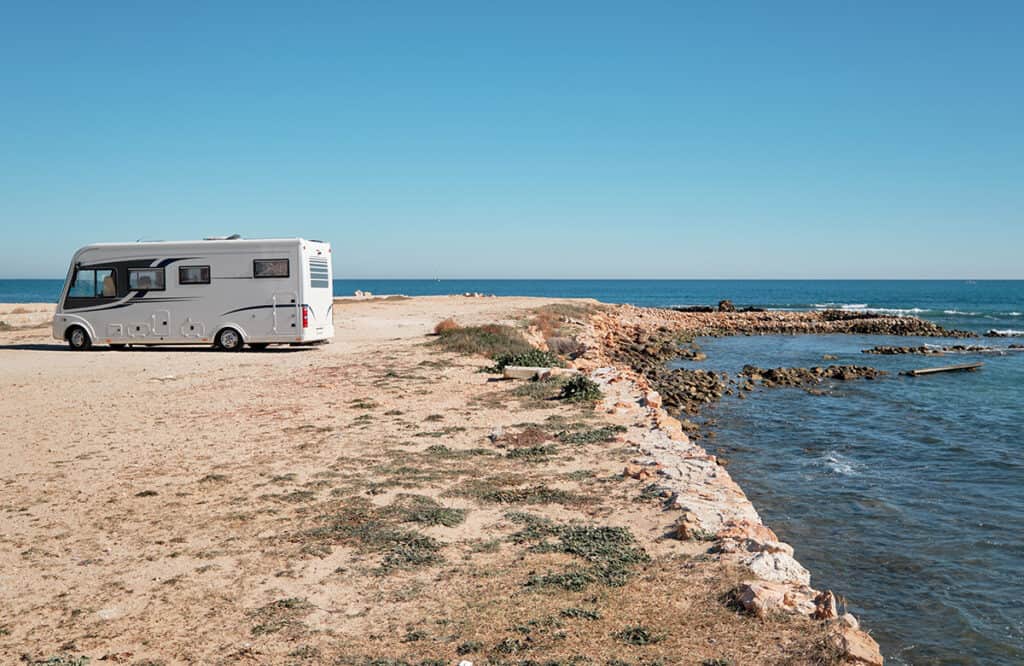
Motorhome touring in Spain- Other useful things you might need
We’ve been touring Europe in our motorhome for several years. We’ve tried all sorts of kit- some useful, some not so much.
Here is a list of things we highly recommend when motorhoming in Spain, but which are NOT essential:
- Motorhome WiFi – learn our favourite way to get internet on the road
- Toll pass (see below)
- TV- If you’d like TV in your motorhome or camper , here’s how to get it.
- Motorhome sat-nav – get one you can enter your motorhome dimensions into, like these
- Motorhome security camera – this thing is GOLD for allowing us to go exploring and leave the van for a short time.
- Solar panel- perfect if you want to wild camp in Spain with your motorhome
- Inverter- a motorhome wild camping essential
- An awesome motorhoming logbook to record and remember your adventures!
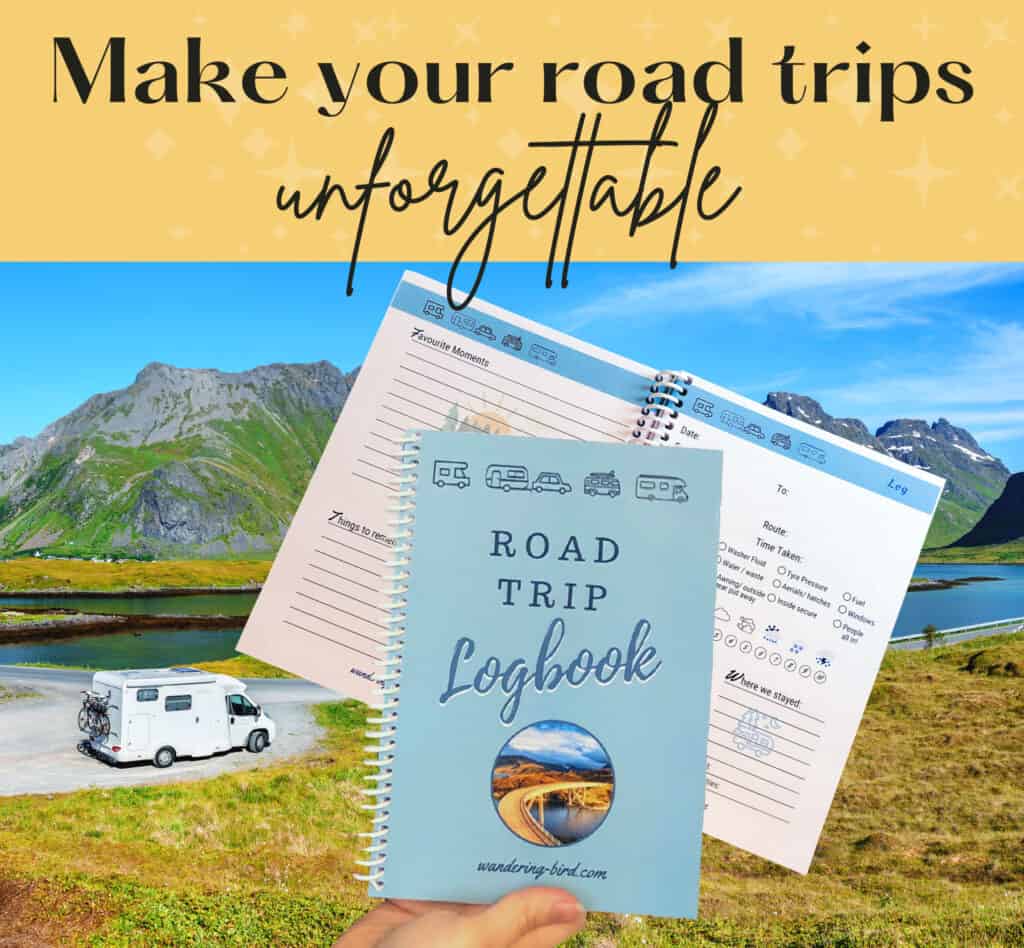
Driving tips for Spain
Ok, let’s deal with the basic rules and some tips for motorhoming and road tripping in Spain:
- Spain drives on the right
- Seatbelts are compulsory
- Driving in flip-flops or open-backed shoes is illegal
- Speeds are in km/h, not mph (you might want to change the setting on your sat-nav)
- You cannot touch a screen while driving (television, video, DVD etc.) This also includes a motorhome sat-nav- program it before you leave and don’t touch it unless you’re parked up safely.
- You need lights on in the tunnels (there are signs to remind you)
- Road surfaces are generally pretty good and, unlike France, they try to avoid 10,0000000 road works on a bank holiday weekend.
- On hills, use the crawler lanes to get out of the way of faster-moving traffic.
- Avoid cities if you’re driving in a motorhome- many of them are too crowded and the streets are just not cut out for large vehicles. Park outside and use public transport to get in.
- Yellow diamond signs mean you have priority. Diamonds with a black line through mean you no longer have priority ( this is usually on roundabouts.)
- Trams always have priority everywhere- keep eyes in the back of your head if you’re driving near a tram network.
- If you are driving in the mountains, you MUST sound your horn before a blind bend, but it’s illegal to use a horn in built-up areas.
- You may carry a load, such as bikes on a rack, extending by up to 10% of the length of the vehicle to the rear. The load must be indicated by a board/ panel with diagonal red and white stripes
- The use of winter tyres in Spain is regional. Look out for traffic signs indicating that winter tyres or snow chains are compulsory where you are.
- IMPORTANT: Drivers do NOT have to stop at a zebra crossing for pedestrians IF there are no lights. So don’t walk out into the road thinking traffic will stop for you.
- Some places have flashing amber lights before a normal traffic light. If you are travelling at or below the speed limit, the red traffic light will change in your favour. If not, the light will remain on red to slow you down!
- In some places, to turn left across a dual carriageway you need to pull-in on the right and wait until it is clear in both directions.
- If you are overtaking a cyclist or a group of cyclists, you must leave at least 1.5m of clearance, and also reduce speed by 20kmh (WHY Spain, WHY?) You are allowed to cross a white line to overtake a cyclist AS LONG AS nothing (not even another cyclist) is coming the other way.
Roads in Spain
The Spanish road network is pretty good and has a mixture of paid and free roads.
- ‘Peaje’ or ‘AP’ is a toll road. Autopistas are marked red on the map and they will have the letter ‘P’ next to the number
- Toll-free motorways are marked with the letter ‘A’ and are marked blue on the map
- Main routes /dual carriageways (green on the map)
- An “autovía” is like a motorway, except that bicycles and agricultural vehicles can use it.
Restricted driving days in Spain
Spain has certain days when driving is restricted. You can find out more about them here
Restricted Zones in Spain
Some of the bigger cities in Spain have environmental zones which only residents are allowed to drive in. These zones are indicated with ‘Area de prioridad residencial‘ and are banned to anyone without a permit (or special exemption.)
Toll roads in Spain
If you choose to use the Autopista toll roads while motorhoming in Spain, here are some tips for you:
- The weight of your motorhome no longer matters- all motorhomes are charged the same.
- Just like other tolls in Europe, you’ll usually get a ticket when you enter the toll route, then have to pay when you exit at either a manned or automatic toll booth. Occasionally, some sections of road have a fixed fee, so you pay when you enter.
- Tolls can be paid for in cash (Euros) or cards at selected booths. American Express is rarely accepted but UK credit or debit cards should work (but not always, so carry cash to be safe!)
- Alternatively, get a toll pass/ payment tag so you can use the ‘Telepeaje’, ‘VIA-T’ or ‘T’ lanes. We use e-Movis and it’s well worth it- especially on busy days where you can drive right on by the queues.
Bizarrely, some toll roads in Spain are being ‘demoted’ to free routes, but are still marked as AP on the map. This site has more information about tolls in Spain and what you might expect to pay on the various Autopistas.
Speed Limits in Spain (unless otherwise signed!)
Cars and vehicles under 3.5 tonnes:
- 120 km/h (74mph) on motorways/ autovias and many dual carriageways
- 90 km/h (56 mph) on secondary roads (out of town)- can increase to 110km/h to overtake
- 50km/h (31 mph)- on roads with two or more lanes in the same direction
- 30 km/h (19 mph) on roads with one lane in each direction
- 20km/h on small lanes where road & pavement are the same level
Motorhomes and Campervans weighing over 3.5 tonnes:
- motorways 90 km/h (55 mph)
- major out-of-town roads 80 km/h (50 mph)
- minor out-of-town roads 70 km/h (43 mph)
- urban areas- 50 km/h (31 mph)
- 25km/h in signposted residential zones
Motorhomes with trailers or caravans (over 750kg)
- motorways 80 km/h (50 mph)
- minor out-of-town roads 70 km/h (44 mph)
- built-up areas- 50 km/h (31 mph)
Speed Cameras in Spain
Many roads have automatic speed cameras on in Spain and they’re quite happy to send tourists a fine through the mail.
You might also find random traffic lights, which turn to red in the middle of nowhere if you’re speeding and make you wait for a couple of minutes before turning to green so you can move off again. These are surprisingly effective!
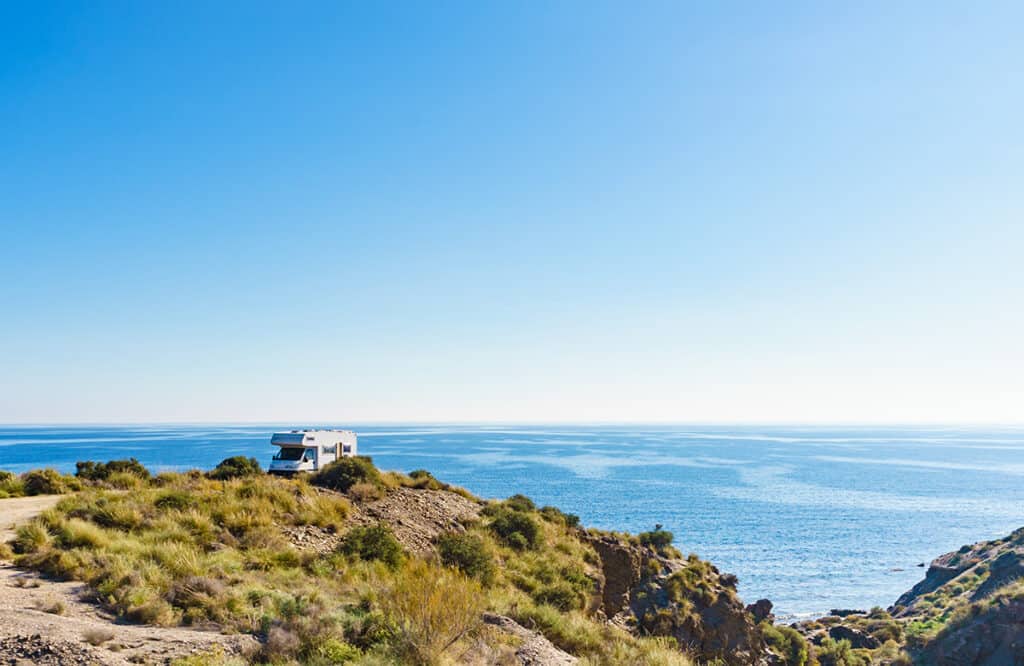
Driving in Spain- what to do in the event of a road traffic accident
You should have a European Claim Form provided by your insurer before you leave. In the event of an accident, all parties complete and sign the form at the scene and then send a copy to your insurer for assessment.
What to do at the scene:
- Stop your vehicle immediately but safely- out of the flow of traffic if possible.
- If a vehicle is blocking the road, use hazard lights and put the red warning triangle 30 metres from the scene to warn approaching traffic
- Name and address of all the people involved in the accident
- Vehicle registration numbers of all parties
- Insurance company details of all parties
- Take photos of damage using a camera, GoPro or phone
For more details, read our step-by-step guide on dealing with a road traffic accident in Europe
Other essential tips for campervanning in Spain
Petrol and diesel.
Petrol and diesel are widely available. Many fuel stations are 24h on the main roads and are self-service with card machines.
If you have refillable gas bottles in your motorhome, you can find LPG pretty easily while touring around Spain. Spain uses the Euroconnector adapter.
NOTE: Gas bottles can be tough to get- and it’s forbidden to fill foreign gas cylinders. Don’t forget you will need to bring a different nozzle to connect the Spanish gas bottle fitting to your UK system. If you’re not sure what we mean, read more about getting gas in Europe:
READ MORE: How we find motorhome LPG or bottles while touring Europe
Motorhome Service Points in Spain
You will find some petrol stations with additional facilities for motorhomes, like waste disposal, water (NOT always drinkable!) and washdown areas.
Campervanning in Spain- security
We highly recommend paying extra attention to your motorhome security when travelling in Spain.
You might even wish to fit an extra camper habitation door lock and never leave your vehicle unattended in an unsecure area.
Touring Spain with a dog
Spain surprised us with their attitude towards dogs. They’re not often allowed on public transport, even with a muzzle, which made visiting places difficult. (PLEASE do not leave a pet in a van or car while you go sightseeing, especially on a hot day.)
Now that BREXIT has happened and the UK pet passport scheme is no longer valid, you will need to get an Animal Health Certificate before you leave the UK.
READ MORE: How to get a UK Animal Health Certificate after BREXIT
You will need to get a worming treatment done by a registered vet before you leave Spain, or between 24 hours and 5 days before re-entering the UK. Sandflies, fleas and ticks are common in Spain, so get a collar or treatment which protects against these.
More tips for travelling with a dog:
- The most useful dog road trip accessories
- How to keep a dog cool while travelling
See all our dog travel and road trip tips
More useful things to know when motorhoming in Spain
Emergency Numbers: 112 will get you everything
Language – There are several local variations of Spanish. Castilian is most common, but there is also Basque, Catalan and some smaller dialects. English usually spoken in campsites and in tourist areas, but not often elsewhere
Currency – Euro
Cards – most major credit and debit cards are accepted. American Express is only taken in large stores (not at tolls and often not at fuel stations)
Timezone – GMT+1 (or one hour ahead in BST)
Mobile Phone and Internet – It’s usually possible to use your UK phone and data in Spain, but do check with your provider about any charges you might incur. Alternatively, 1p Mobile SIM cards are widely available and a cheap option for phone calls.
Tipping – Service is usually included in a restaurant, but do check. It’s common to tip other services, like taxi drivers
Shops – Food prices are pretty inexpensive. Many shops close on Sundays. Bigger supermarkets may be open, but will close at lunchtime. If bakeries open on Sundays, they are often closed on Mondays instead. Many shops and businesses also shut for a long lunch (between 12-2pm) and some will not open on Wednesday afternoons.
Other posts you might find useful:
- Campervanning in Portugal- everything you need to know
- The best road trips in France
- Unmissable road trip ideas for Europe
- Essential motorhome checks to do before you travel
See all our Europe travel tips and ideas
DISCLAIMER: This post was last updated in October 2021. We try to keep it as up to date as possible, but cannot be held responsible for any changes made to the law since the last update. If you do find any discrepancies, please do let us know. Thanks.
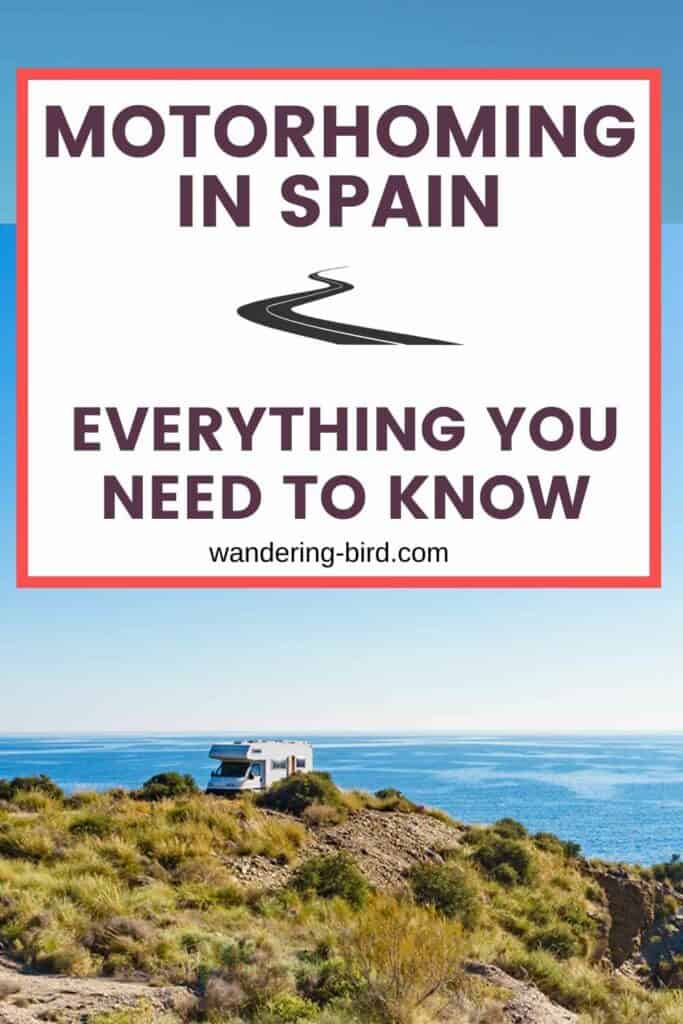
Kat never planned to buy a motorhome. She also never planned to quit her job as an air traffic controller, go touring around Europe in said motorhome, start one of the UK’s largest motorhome travel websites… or get a cocker spaniel.
Find out how she went from stuck in the rat race to being a digital nomad and inspiring thousands of people to have their own epic adventures here.
If you’d like to connect with Kat, send her an email or follow her adventures on social media.
Last update on 2024-04-10 / Affiliate links / Images from Amazon Product Advertising API
Sharing is caring!
Similar Posts
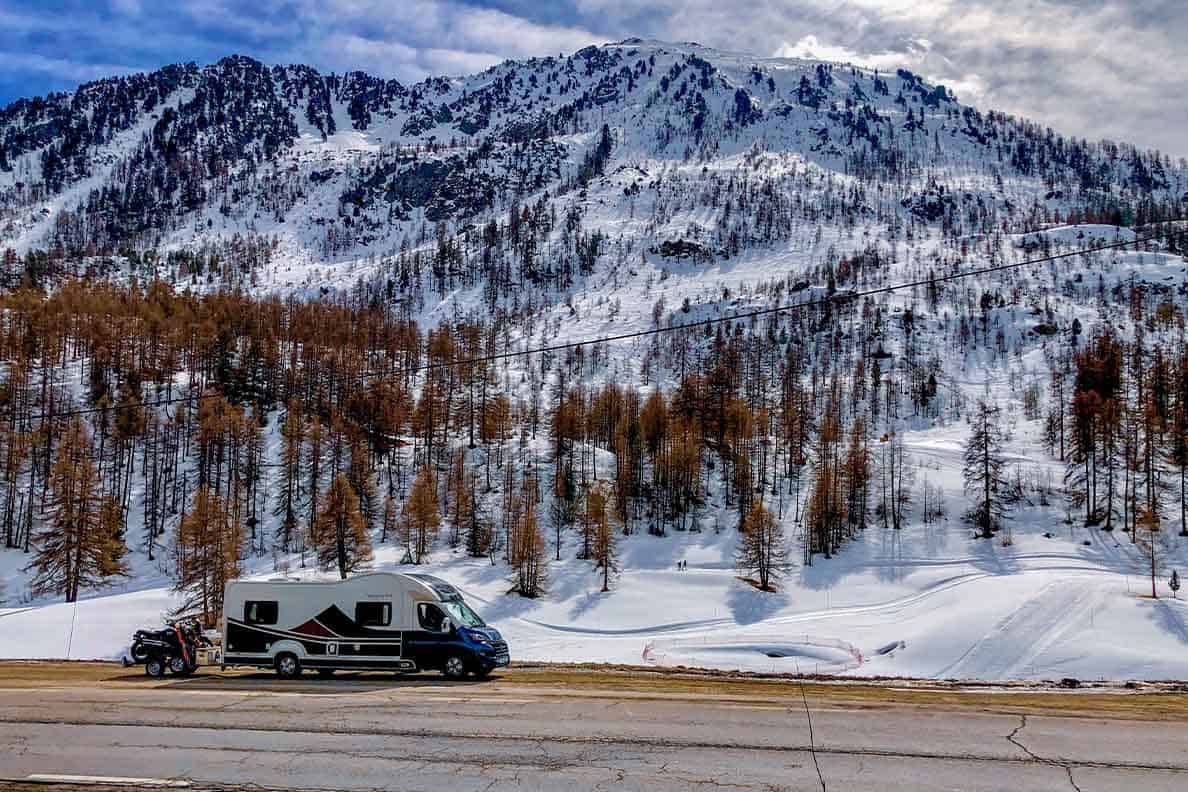
Motorhome Skiing & winterising your van- 10 ESSENTIAL tips you need to know
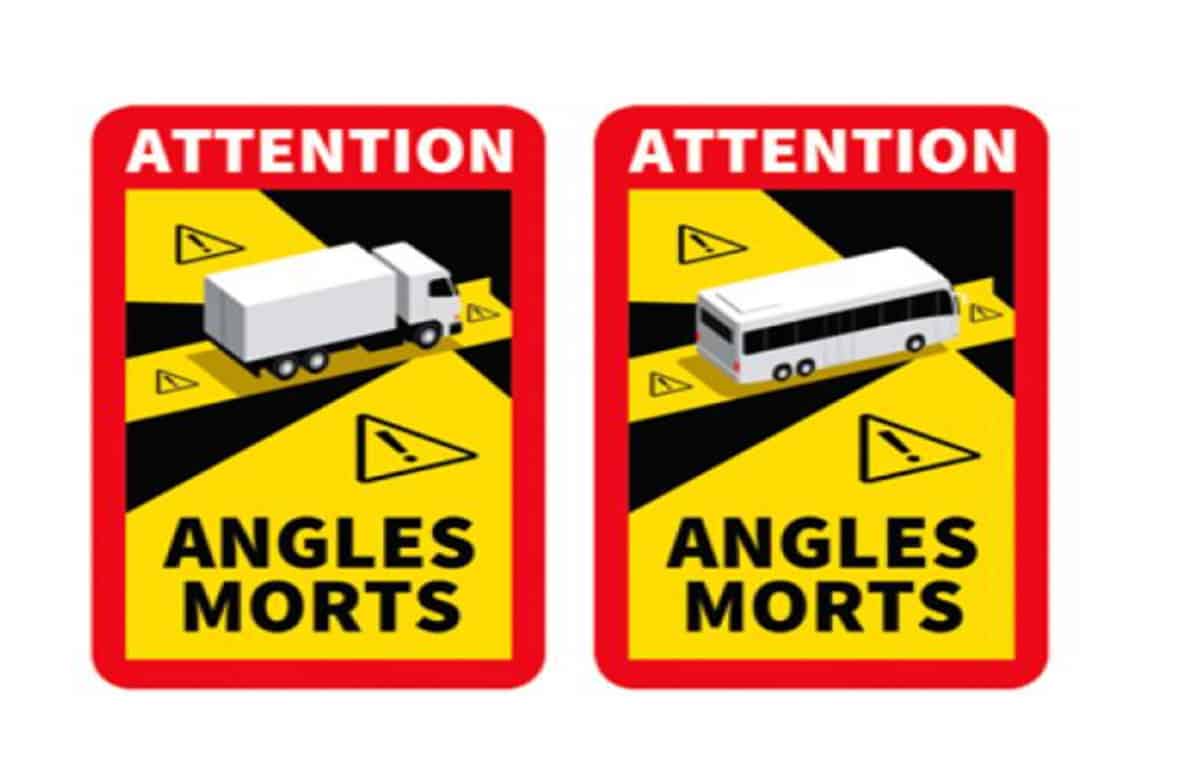
Angles Morts Stickers- Does Your Motorhome or Camper Need one?
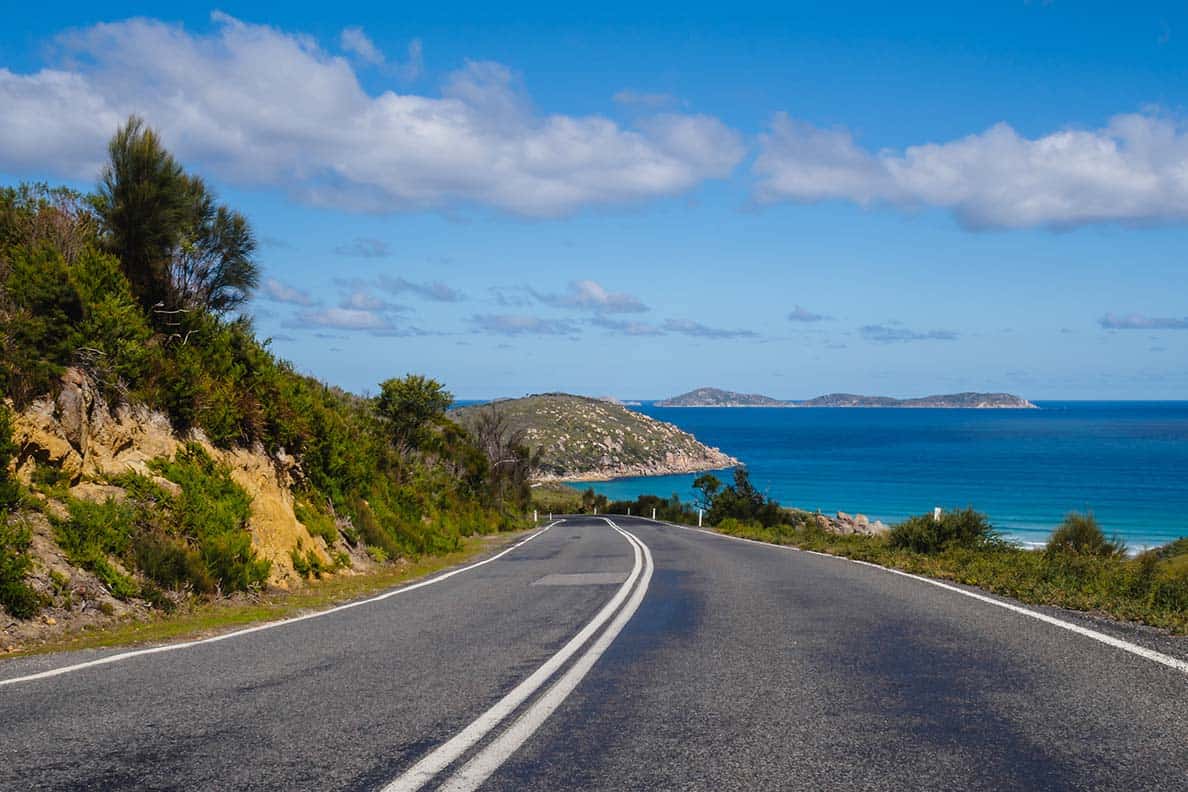
Left hand drive vs Right hand drive – which is better for Europe road trips?

Portugal EasyCamp – an alternative to motorhome wild camping in portugal
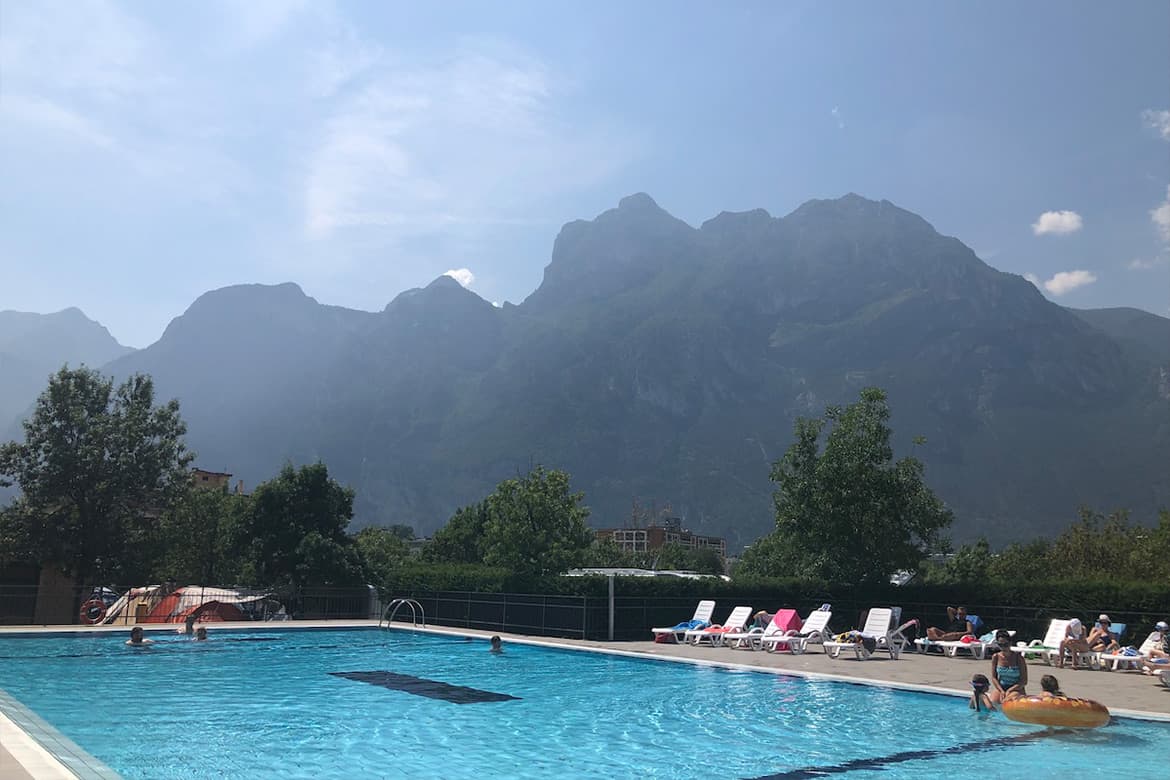
5 best motorhome campsites in Northern italy
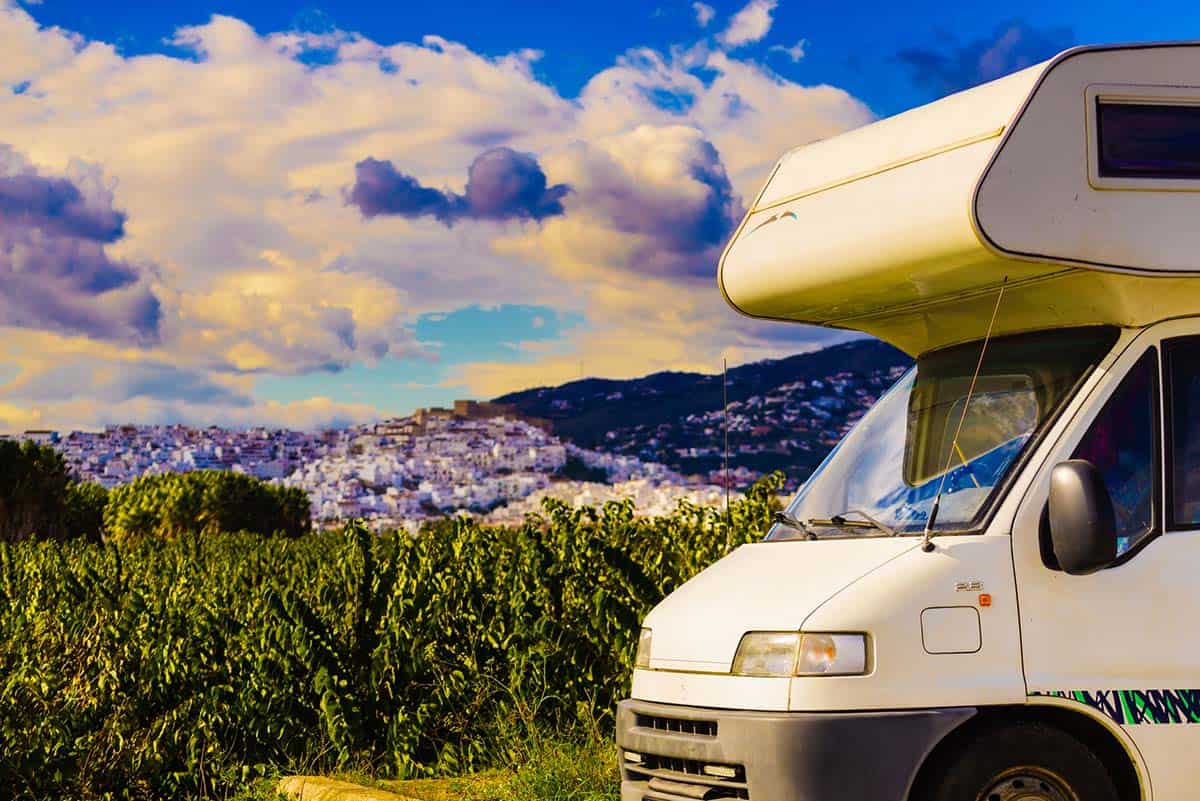
Low Emission Zones in Europe- READ THIS before you go!
Leave a reply cancel reply.
Your email address will not be published. Required fields are marked *
Save my name, email, and website in this browser for the next time I comment.
- TV & Film
- Say Maaate to a Mate
- First Impressions - The Game
- Daily Ladness
- Citizen Reef
To make sure you never miss out on your favourite NEW stories , we're happy to send you some reminders
Click ' OK ' then ' Allow ' to enable notifications
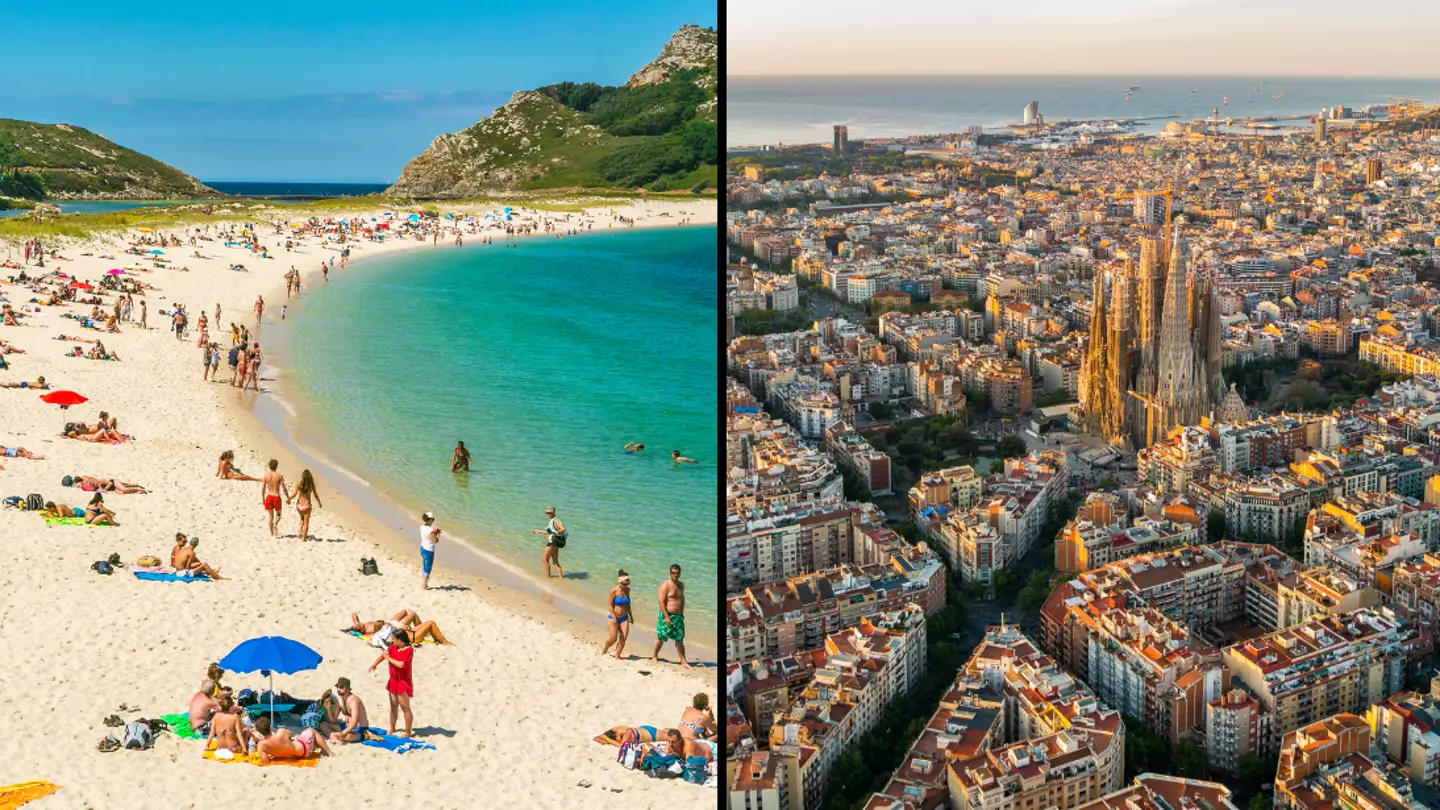
Brits warned they must follow new £97 rule if going on holiday to Spain this summer
Pay attention to the new law.
Tom Earnshaw
This article contains affiliate links and LADbible Group might make a commission on anything purchased.
A new travel warning has been issued to Brits as the summer season approaches, with millions of us setting our eyes on a holiday in Spain.
And it all revolves around something called a '£97 rule'.
The introduction of new rules is not a new thing when it comes to Spain, with specific rules in place for some of the country's most popular destinations .
And if you don't obey them you, could quickly find yourself paying hefty fines for breaking local laws .
With more than 15 million UK residents leaving British shores last year for a holiday in the Spanish sun, this new law is also one that we reckon you should pay close attention to.
It's all to do with Brexit and new border rules that were brought in to play following the UK exiting the European Union (EU).
Because of changes, it means Brits are going to have to show an extra two additional documents if they want to enter Spain.

It's all to do with the EU's Schengen Area, with new rules already meaning you could get banned from Europe for three years for not following them .
There are 27 countries in the Schengen Area: Austria, Belgium, Czechia, Croatia, Denmark, Estonia, Finland, France, Germany, Greece, Hungary, Iceland, Italy, Latvia, Lithuania, Liechtenstein, Luxembourg, Malta, Norway, the Netherlands, Poland, Portugal, Slovakia, Slovenia, Spain, Sweden and Switzerland
Now, the UK Foreign Office has issued residents with a warning if they're heading to anywhere in Spain, from Mallorca to Madrid.
Britons have to now show proof that they have at least €113.40 (£97) per person per day during their holiday stay.
This means that a family of four staying in Spain for a week have to show they'll have cash of at least £2,716 to hand.
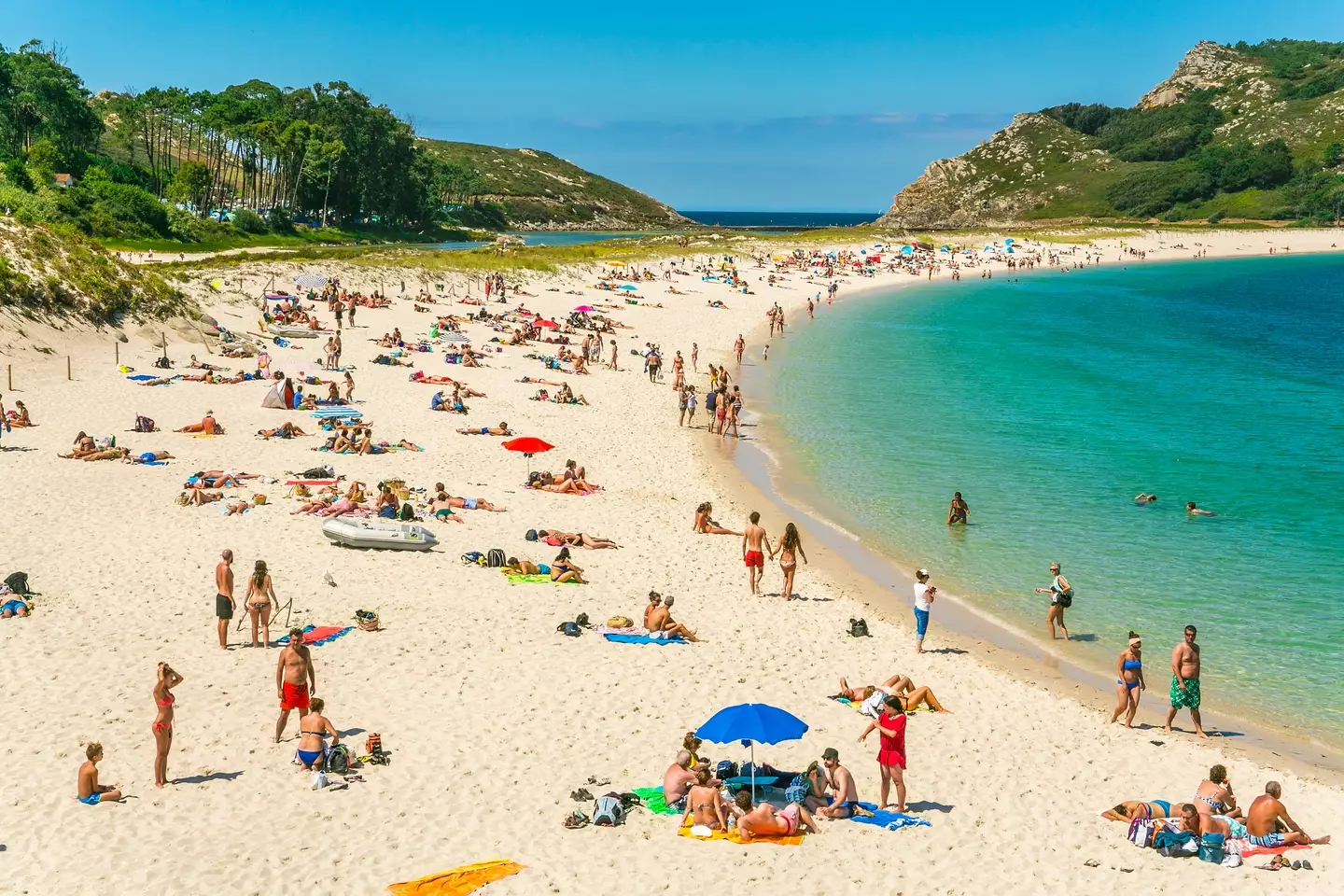
The Foreign Office has said Brits could be stopped by officials in Spain and asked to prove 'you have enough money for your stay'.
Other rules brought in to play include proof of return to show you plan on leaving the country.
You could also be asked for proof of where you are staying, such as a booking reference.
The Foreign Office says: “If you enter the Schengen area as a tourist, you may need to provide additional documents at the border.
“As well as a valid return or onward ticket, when travelling to Spain you could be asked to show you have enough money for your stay."
Topics: Travel , Holiday , Money , UK News , World News
Tom joined LADbible in 2024, specialising in SEO and trending content. He moved to the company from Reach plc where he enjoyed spells as a content editor and senior reporter for one of the country's most-read local news brands, LancsLive. When he's not in work, Tom spends his adult life as a suffering Manchester United supporter after a childhood filled with trebles and Premier League titles. You can't have it all forever, I suppose.
@ TREarnshaw
Choose your content:
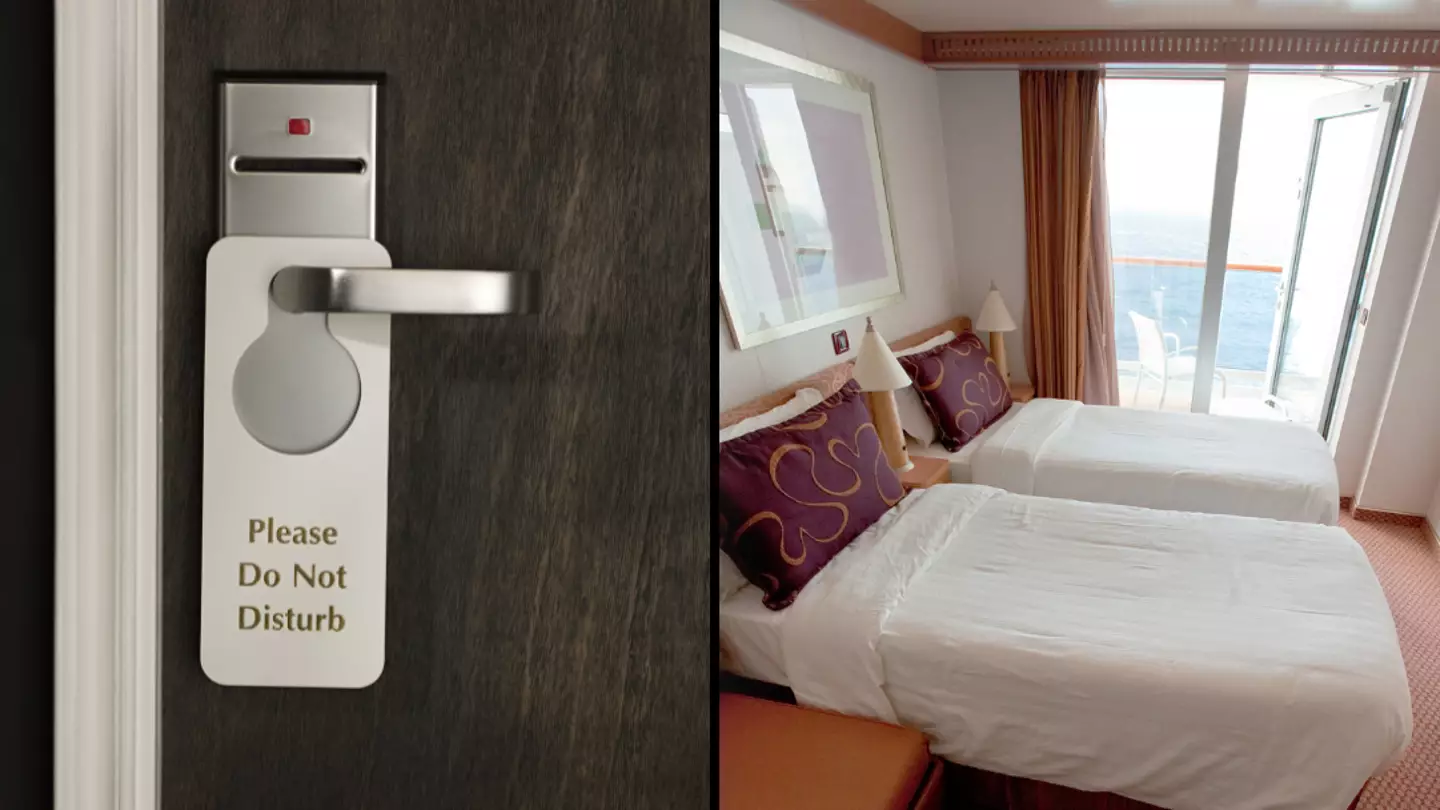
Cruise ship boss explains why staff will ignore cabin 'do not disturb' signs after 24 hours
Your 'do not disturb' sign means nothing after a certain while.

Cruise ship passenger captures moment total solar eclipse turns ocean in to darkness
An amazing moment on the open seas under the path of totality.

Mystery stag do holidays launched where you could be taken to any one of 71 European destinations
Would you book a stag do where you didn't know the destination.
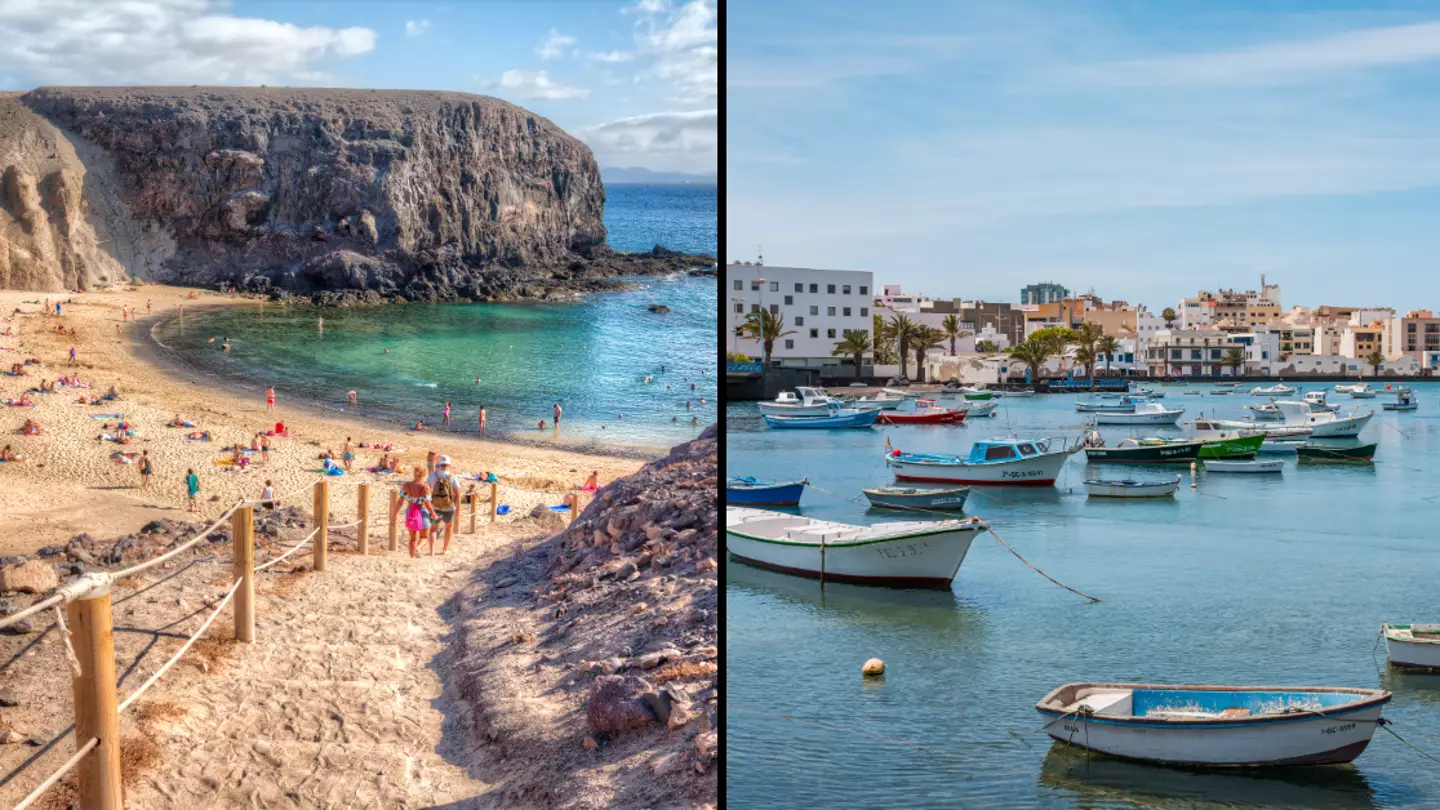
Idyllic island loved by Brits 'at risk of collapse' as tourists given stern warning
A growing movement against tourism is gathering pace on the spanish island.
- British tourists warned about new rule before booking summer holiday to Greece
- Brits issued major travel warning if they're flying this Easter
- Brits going to Spain warned of unknown rule that requires them to prove they have enough spending money
- Brits warned over renewing passport as almost one million make costly £9m mistake
Taking the train in Spain - all you need to know

Apr 3, 2024 • 15 min read
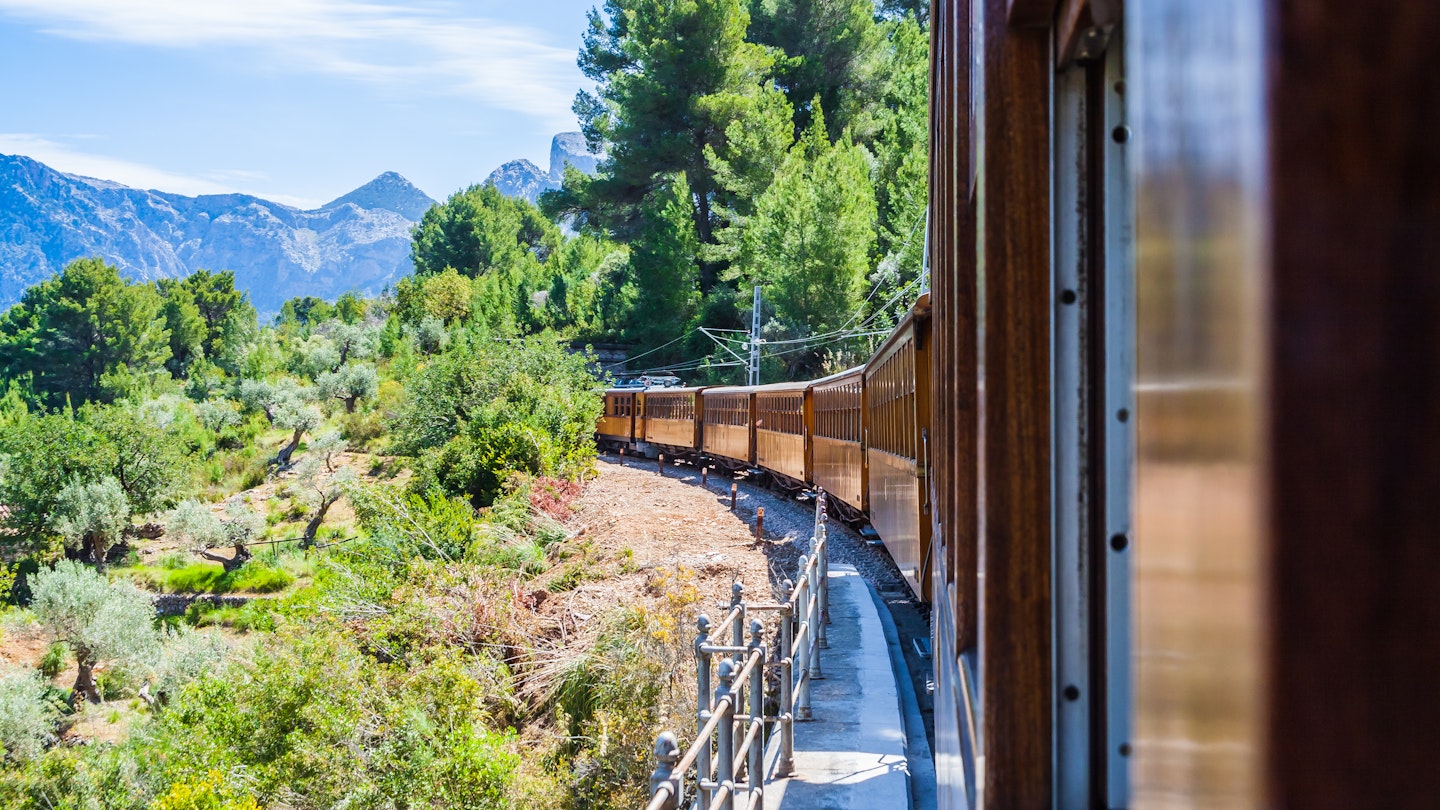
The vintage train from Sóller to Palma de Mallorca is one of the most scenic rail routes in Spain © Shutterstock
Spain boasts Europe’s longest high-speed rail network, second only to China globally, and its trains are exceptional and far-reaching. In one day, you could gawp at Gaudí’s architectural genius in Barcelona , be whisked by rail to Madrid ’s museums, and still arrive in Seville for a sunset flamenco show.
Not that it’s all A to B whirlwind rail routes. There are some outstanding scenic train journeys to slow down and enjoy the Spanish pace of life, whether trundling along the northern coast’s narrow-gauge tracks or meandering into the mountains. And with some new low-cost operators now on the scene, exploring Spain by train has never been more affordable.
With over a thousand stations and thousands more daily departures, getting around Spain by train is a straightforward joy rather than a stressful necessity. Seat reservations on most services guarantee uncrowded carriages, Rioja-serving cafe cars provide perfectly wine-paired panoramic views, and electric-powered trains make journeys even more sustainable. What’s not to love? Here’s everything you need to know to plan a train trip in Spain like a pro.
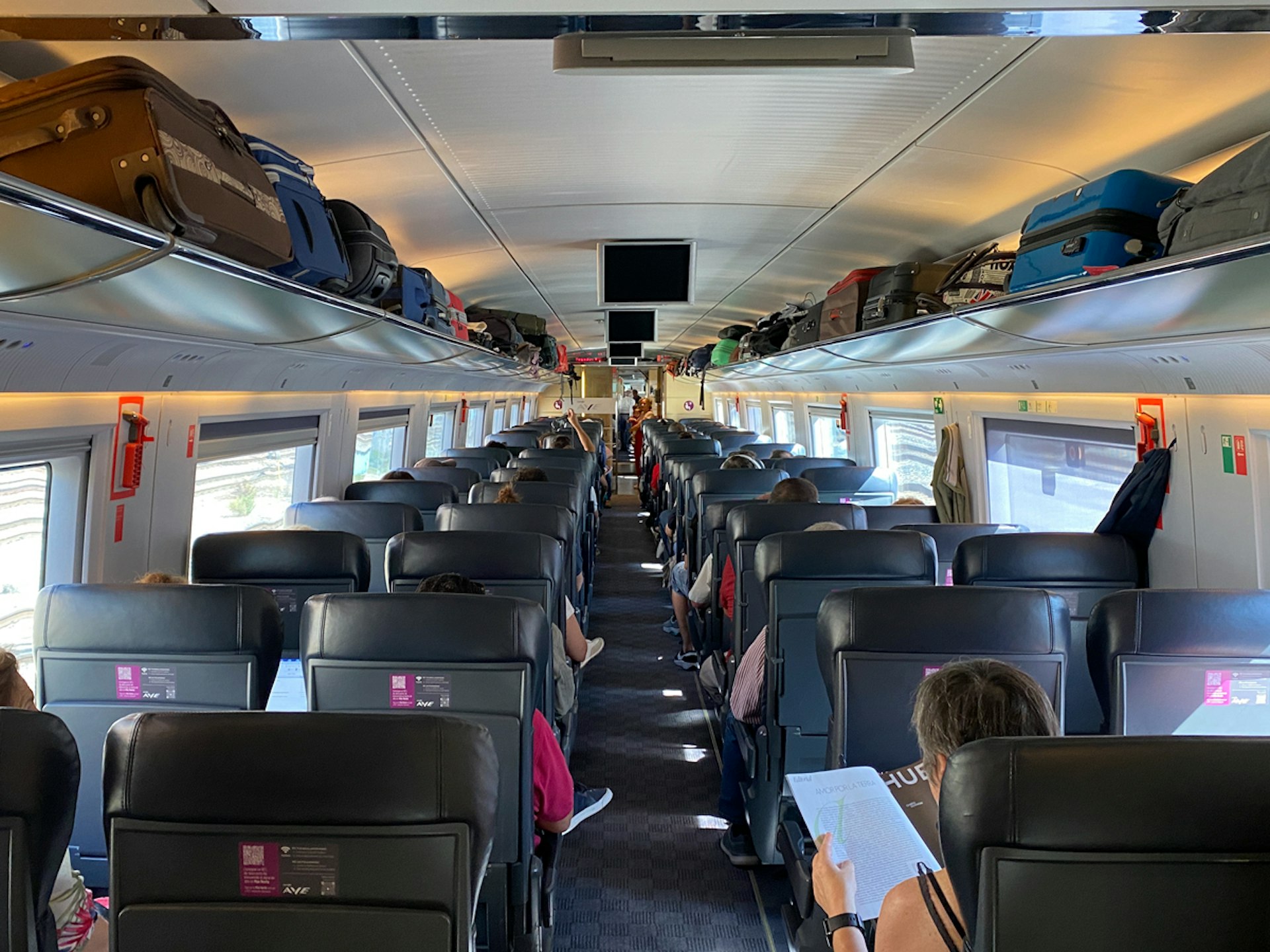
Train services are generally excellent in mainland Spain
You can traverse all four corners of Spain by train, usually on swift, reliable, well-maintained carriages. Few areas aren’t covered by at least a regional service. And where there are coverage gaps, buses will usually take you the final stretch to that pretty medieval village. While strikes can occur, they are rare, and minimum service levels are generally guaranteed. Compensation payments are offered for delays over one hour, which helps keep timetables on track.
Renfe is Spain’s national railway company, operating everything from non-stop regional capital connections to short-hop commuter services. Iryo and Ouigo provide low-cost competition on the main high-speed intercity lines, with the latter’s double-decker trains being a welcome addition.
While the numerous names for differing service and train types can be confusing, the trains in Spain can generally be divided into three categories:
- High-speed, mainly long-distance (larga distancia) services link many major cities, mainly via Madrid. These full-service trains can reach 310km/h (193mph) and include Renfe’s AVE (Alta Velocidad Española), its new no-frills Avlo counterpart, and Iryo and Ouigo. There’s an ever-growing network of high-speed routes , including the popular Barcelona–Madrid, Madrid–Seville, and Madrid–Valencia lines.
- Mid-distance services – although they can sometimes cover long distances and reach speeds of 250km/h (155mph) – make up the majority of other major routes. Renfe services these under names including Media Distancia, Avant and Alvia. Intercity and Regional Exprés services are somewhat slower but only call at major stations. Popular routes include Madrid– Toledo , Granada–Seville, and the Euromed coastal service between Barcelona and Alicante . Nearly all long and mid-distance services use sleek, modern carriages.
- Slower trains , including Regional, Proximidad, and Cercanías commuter services (Rodalies in Catalonia), complete the network. The older Cercanías AM trains, previously FEVE, mainly operate on the northern coast’s picturesque narrow-gauge tracks.
Nearly all large and medium-sized train stations are staffed and contain shops or cafes. High-speed train stations operate similarly to airports, with luggage security scanners and boarding gates. It’s advisable to arrive 20–30 minutes early, especially as boarding can close five minutes before departure. The bonus is you’ll have time to admire the stations. Some, like Toledo’s Mudejar-style ticket hall and art nouveau Bilbao Concordia , are attractions in their own right.
There are tourist trains and unique rail services too
In addition to standard train services, Spain has an exceptional selection of specialist rail routes known as “ tourist trains .” These range from seasonal, short routes, such as the scenic Tren dels Llacs in the Pre-Pyrenees, to indulgent, multiday sojourns like the luxury Transcantábrico train hotel. There are currently no standard domestic night trains.
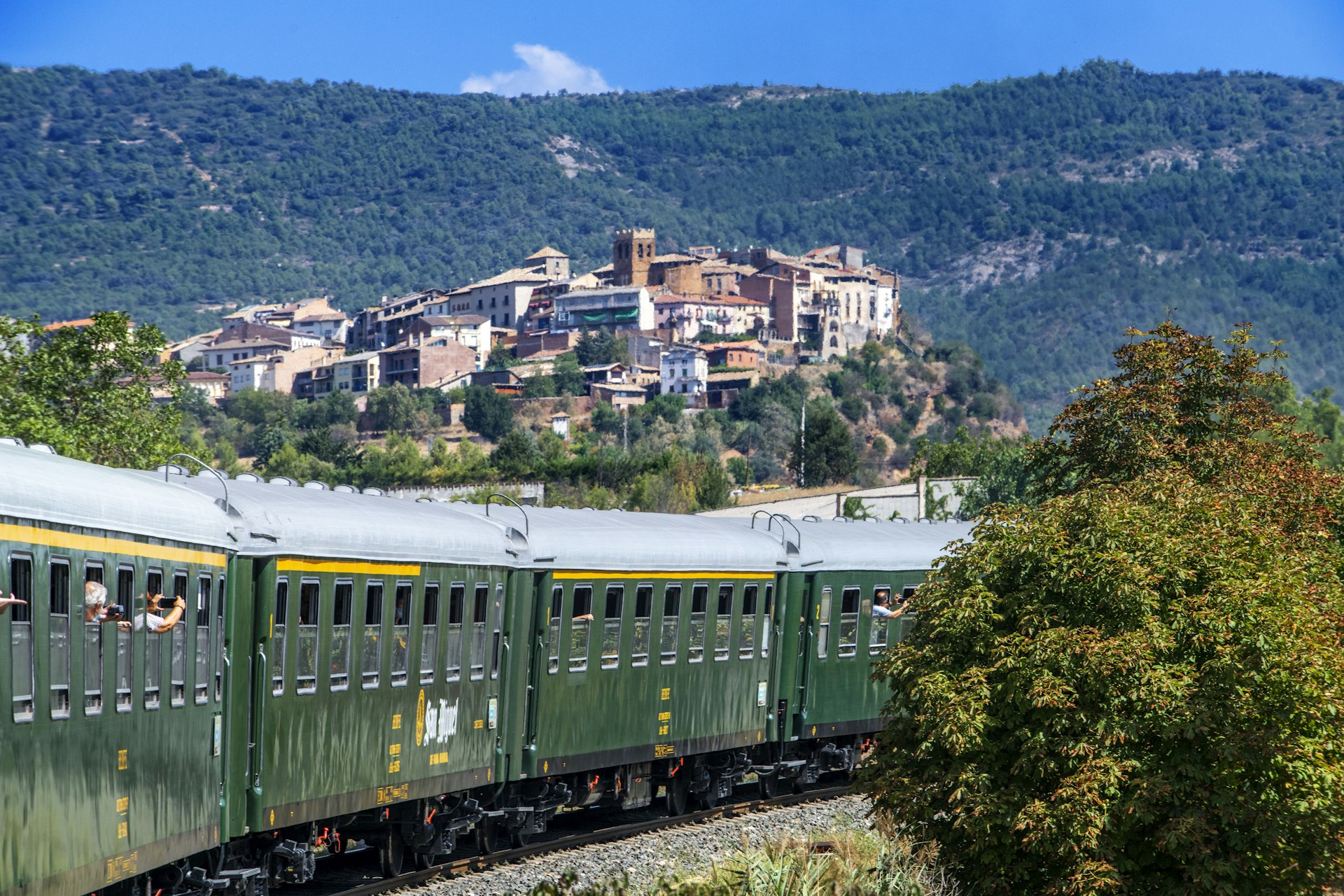
International and island rail routes are limited
Away from the mainland, the rail situation is starkly different. The Canary Islands have no train services, and only Mallorca in the Balearic Islands has limited rail connections . These consist of three short, modern lines and the vintage Sóller train.
Traveling to and from France by train is possible on France’s TGVs (from Paris) and Renfe’s International AVE services to Marseille and Lyon . Fares start from €29. You can also cross via Hendaye in the Basque Country or take the slower, scenic sleeper service via the Pyrenees . The Trenhotel (night service) between Madrid and Lisbon has been discontinued, leaving the Tren Celta between Vigo and Porto and the slow route to Lisbon via Badajoz as the only connections with Portugal . Work continues on improving the tracks to accommodate a direct, high-speed link between the two Iberian capitals.
Book ahead to save money and guarantee your seat
Spain’s rail operators all use dynamic pricing for high-speed and long-distance services. Therefore, early booking is advised, especially as seat reservations are mandatory. Advanced Avlo tickets between Madrid and Barcelona start from €7, with Ouigo and Iryo also offering competitive pricing on primary routes. A same-day ticket can sometimes cost more than 10 times more than booking in advance. Prices are less competitive on routes solely operated by Renfe.
When booking tickets online to or from major cities, use the dropdown city name followed by todos (all) to check for direct and affordable tickets from all stations. Provide the Passport or ID number of the photo document you’ll be traveling with, as tickets are personal. The second surname can be left blank – Spanish people take both their father's and mother’s surnames. Tickets can be printed, collected at self-service machines, or displayed as QR codes on mobile devices. Overall, Ouigo and Iryo's websites are easier to navigate than Renfe's, which can be glitchy. While most people would recommend using a third-party booking service – handy for comparing prices between all operators – direct reservations avoid booking fees.
Even short-distance, popular services with fixed fares (some mid-distance and regional trains) can fill up. I’ve previously struggled to get last-minute weekend tickets on the Madrid to Toledo route. Secure all tickets ahead if your vacation coincides with a major holiday such as Easter (Semana Santa) or Christmas, including around Three Kings Day on January 6.
Iryo and Ouigo release tickets many months ahead. Renfe’s tickets should be available at least 60 days ahead, but this isn’t always true. Check regularly in the months leading up to your departure and sign up for newsletters on the three websites to receive ticket availability and discount updates.
Occasionally, two single fares (ida) can be cheaper than a return (vuelta) . Reservations can also be made at station ticket machines (in English) or staffed desks. Larger stations may have separate sales points for particular types of tickets.
You’ll always be assigned a mandatory seat reservation. However, if you’d prefer to select your own to guarantee a window, you can change it for a nominal fee. Confusingly, Renfe’s website has this step after choosing a payment method.
Cercanías and Cercanías AM tickets can’t be purchased in advance and should be purchased at the ticket office, self-service machine, or onboard from the conductor when traveling from the tiniest unstaffed stations. This is the only time you’re allowed to board a train without a ticket.
If you wish to upgrade from basic class (básico) on high-speed routes, you can choose from Elige, Elige Confort and Prêmium on Renfe, or similar options on Iryo. Upgrades can include access to premium station lounges, at-seat food service, and more spacious seats. Solo travelers may want to upgrade to enjoy an individual seat in the 2+1 configured carriages. Ouigo allows these seats as a paid add-on without upgrading.
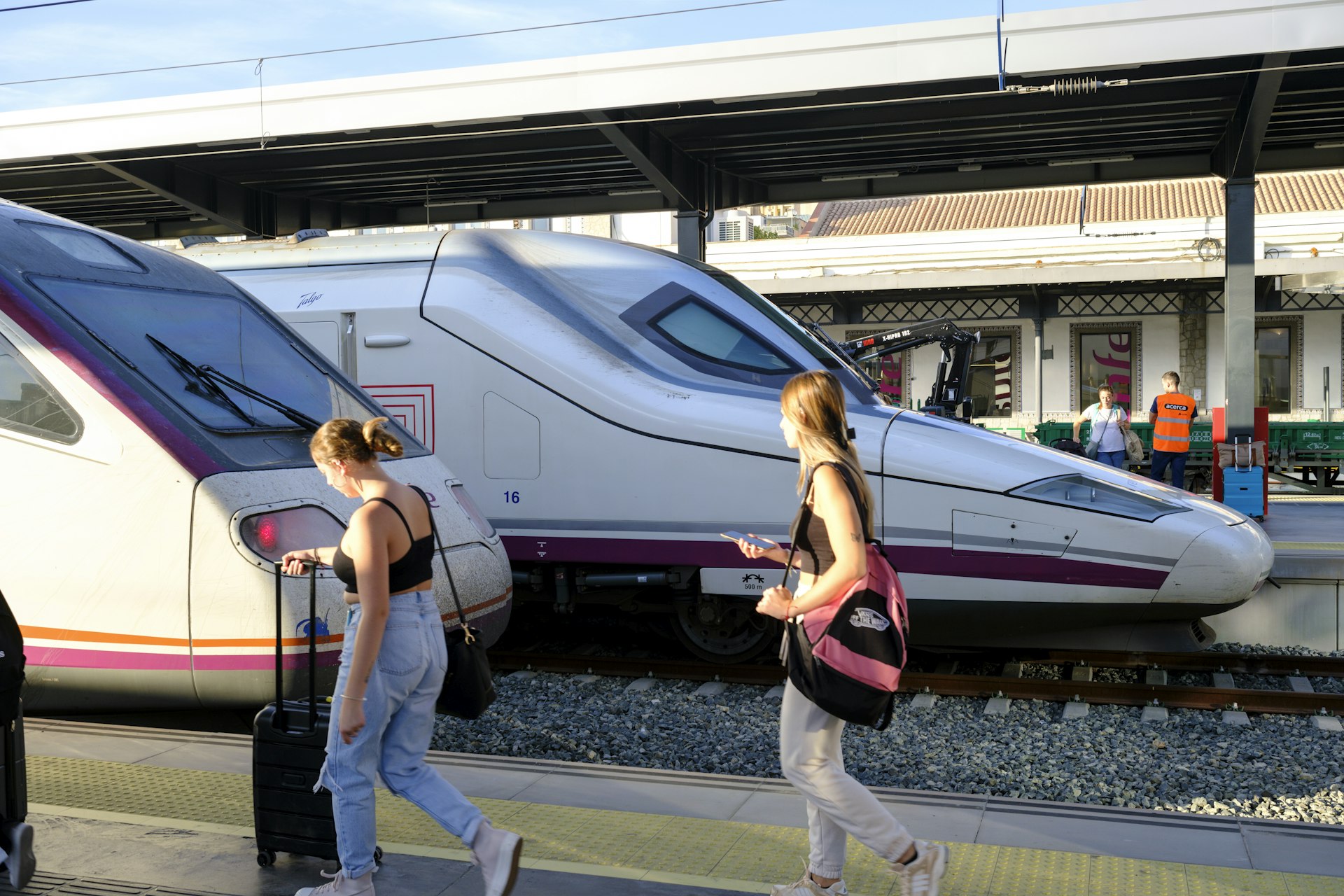
Discounts and offers: know your benefits and bring ID
Much noise was made about the launch of Spain’s fixed-price travel pass . Yet this system, established to offer discounted fares on repeat return trips, is primarily aimed at locals and commuters.
Renfe does offer a Spain Rail Pass for travelers , covering between four and ten journeys. However, depending on the routes you plan to take, pre-booking discounted, advanced fares can be cheaper. Some region-specific options exist, such as the better value three-day Galica Rail Pass .
Other discounts available on Renfe include:
- Small group discount when booking four or more travelers together.
- Seniors discount, up to 40%, for over 60s. However, this requires purchasing a card ( La Tarjeta Dorada ) in person before making the reservation. Advanced, discounted fares can be better value.
- Youth Discounts for under 25s with a European Youth Card or suitable International Student Card. A digital card can be purchased online by citizens of most countries.
- Babies travel for free, as do children, although the age cap varies between operators.
Considering an Interrail or Eurail pass? Check on any savings first. All high-speed trains in Spain require seat reservations, an additional cost not included in these passes. Avlo, Iryo, and Ouigo are likewise excluded, and these cheaper advanced tickets may be better value than using the pass, though there is less flexibility.
Money-saving tip: high-speed trains include a free local ticket
If you’re traveling on a high-speed AVE or long-distance service operated by Renfe or Iryo, Combinado Cercanías is included. This allows for free use of local Cercanías trains to reach your departure station and again on arrival. Scan the QR code at barriers, or use the PDF code to get a zero-priced ticket at Cercanías’ self-service machines.
Seat reservations ensure most train journeys don’t feel crowded
Traveling by train in Spain is so enjoyable because all long and mid-distance services require a seat reservation. With no congested corridors or jostling vestibules, these trains never feel crowded, even when full. However, some regional and Cercanías services can be packed, particularly around commuter hours and Friday and Sunday evenings. You might want to avoid peak times or, when available, pay for a regional service seat reservation.
Plan around major events and regional holidays during your trip, such as Semana Santa, when ticket demand and crammed suburban trains are common. Trains in Spain operate every day of the year, though some services may finish earlier on public holidays. If you’re traveling on weekends or during holidays, check onward public transport in advance as small, rural stations may have a reduced weekend bus service.
Train can be the fastest, most affordable transport method
Using the train in Spain can be quicker and cheaper than flying. For example, a flight from Madrid to Barcelona takes 1¼ hours compared with 2½ hours by high-speed rail. But once you factor in security checks, out-of-city airport transfers, and runway taxi times, the overall journey length by plane becomes longer.
Driving distances are considerable. The same journey by car will take closer to seven hours. It’s unquestionably worth renting a car if you’re planning a road trip , but generally, long-distance jaunts are best by rail.
Most train terminuses are connected to city buses and, in larger metropolises, commuter rail or metro systems. Barcelona-El Prat Airport and Madrid–Barajas Airport are on the train network. If you wish to visit smaller towns or villages that are not on the train network, consider other ways to get around Spain .

Onboard facilities differ between service types
All of Spain’s high-speed train services are spacious, comfortable, clean and well cared for. Carry-on luggage can be placed in overhead racks, while storage areas at either end of the carriage accommodate bulkier luggage. Popular services (especially on Friday and Sunday evenings) can quickly fill, and train staff will usually assist in rearranging suitcases to fit. Cercanías services can be more dated and crowded and often lack enough dedicated luggage space.
If you’re traveling by bicycle, check the luggage policies of Renfe and Iryo . In some instances, bikes must be disassembled or an additional fee paid.
The dining carts on Spain’s trains are typically stand-up, cafe-style rather than seated dining carriages. They’re good for stretching your legs or getting an alternative window view, but dining at your seat table is often more comfortable. A selection of hot meals, snacks and drinks – usually all of decent quality – are available, and certain ticket types offer pre-ordered meals served at your seat. Iryo has particularly impressive dining options .
On some routes, a trolley service may be provided in addition or as an alternative. Mid-distance and Avlo services have vending machines rather than dining carts. Bringing your own food and even alcohol onboard Renfe’s services isn’t a problem.
Complimentary (sometimes patchy) wi-fi is provided on Iryo and Renfe’s high-speed services, alongside entertainment portals accessible on your device. Ouigo charges per connection. Plug sockets (F-type) are available at seats on high-speed and mid-distance trains. Nearly all trains, except commuter services, have toilets.
Plan the perfect train trip with these scenic routes and tips
The most popular train routes for travelers in Spain are the high-speed connections that rocket between Seville, Madrid, Barcelona and Valencia. But riding the rails in Spain isn’t only about barrelling between urban sprawl. These are some of our favorite scenic rail routes worth planning into your trip.
- Santander to Oviedo : Cross the lush landscapes of Northern Spain on this slow, scenic rail route using Cercanías AM’s narrow-gauge tracks. This six-hour journey provides some of the expensive Transcantábrico Train’s panoramas for a bargain €16.55. There are no seat reservations, which is handy, as you can switch sides to marvel at both the sparkling Bay of Biscay and the mighty Cantabrian Mountains , Spain’s answer to the Dolomites.
- Barcelona to A Coruña : Once served by the discontinued sleeper Trenhotel, this is one of Spain’s longest rail routes, taking nearly 14 hours. The 9:05am Alvia departure can be affordable to cross seven of Spain’s autonomous communities. Pack snacks and pay for a window seat (ideally on the right) to see the full scope of Spain’s landscapes, from arid pastures and fertile farmlands to the verdant Galician Massif . Consider hopping off a few stops early in Ourense to use the town’s free-to-access thermal pools the following morning.
- Granada to Almería : Leaving the magnificent Moorish Alhambra behind, set off across western Andalucía towards the coastal city of Almería. It’s a showstopping three-hour journey traversing the foothills of the Sierra Nevada, snow-capped peaks looming beyond, before cutting through carpets of cork trees. Book a late afternoon departure for ethereal golden light, or take two single tickets to plan a lunch pause at Guadix, best known for its cave houses.
- Palma de Mallorca to Sóller: Step onboard the rickety, wooden carriage of Ferrocarril de Sóller , constructed in 1912, for a one-hour-long trundle from Mallorca's capital to the pretty port town of Sóller. En route, you’ll wend through the Tramuntana Mountains, unlit tunnels, and citrus groves close enough to touch. All seats are excellent, but you might want to stand in the open-air platforms between carriages.
- Zaragoza to Canfranc : A one-way ticket on this twice-a-day, 2½-hour regional train costs just €16.90, and you’ll get plenty of panoramas for your money, especially after Huesca when the tracks slowly climb up into the Pyrenees. Our resident rail expert, Tom Hall, calls it one of Europe’s best train routes , partly because the landmark Canfranc Station has recently been reborn as a grandiose hotel .

Station tips when traveling Spain by train
Most large cities have multiple train stations, so always confirm departure points. When traveling to dedicated AVE stations outside major cities, check the station’s distance from the city center and pre-plan your connecting travel. Some stations, such as Antequera ’s Santa Ana, can be as far as 15km (9 miles) from the Old Town.
Spain’s largest stations, such as Madrid Atocha and Barcelona Sants, can be confusing due to split-level and separated boarding areas for different services. Don’t be afraid to ask for help navigating the station. A quick flash of your ticket will soon have you pointed in the right direction.
All major stations have cafes and kiosks where you can pick up food, although preparing a train picnic from a delicatessen might be preferable. Still, a quick tapas in Atocha's Tropical Garden, even if the pond-residing turtles have now been rehomed, is a solid start to any journey. If you’re on a connecting service with time to explore beyond the station, most larger terminals have lockers or left luggage desks (consigna) .
Many stations are accessible, but there’s room for improvement on older services
Adif, the agency in charge of Spain’s rail infrastructure, provides in-station and boarding assistance for travelers with accessibility needs via the Acerca service, offered at 145 stations.
When booking tickets online, H seats – accessible spaces that can anchor a wheelchair – can be requested on the opening screen, and Acerca assistance can be requested later in the booking process. A minimum of 12–48 hours' notice is stipulated, depending on the operator. However, in larger stations, staffed service centers can usually provide support without pre-booking if you arrive and register at the desk ahead of travel. Check which facilities are available at each station on Adif’s website .
In addition to offering boarding support (many train types require a stair-climber lift, not just a ramp, while others like Avlo have level boarding), Acerca can provide technical aids for hearing and a guided sight service. Contact Adif Acerca for information on induction loop systems or to discuss alternative routes should your planned journey include a non-accessible station without in-person assistance. Tactile paving, step-free access, and elevators are installed at most major stations, and nearly every train has a conductor or staff member onboard who can assist.
On high-speed, long-distance, and most other services, wheelchair-accessible bathrooms are located in carriages with H seats. Ouigo trains have a call button on adapted seats to provide food and drink service, as the cafe is located on the top deck. Cercanías AM carriages have no H seats but offer a dedicated space for wheelchair users with tie-downs. However, many older, narrow-gauge trains lack accessible bathrooms.
Explore related stories
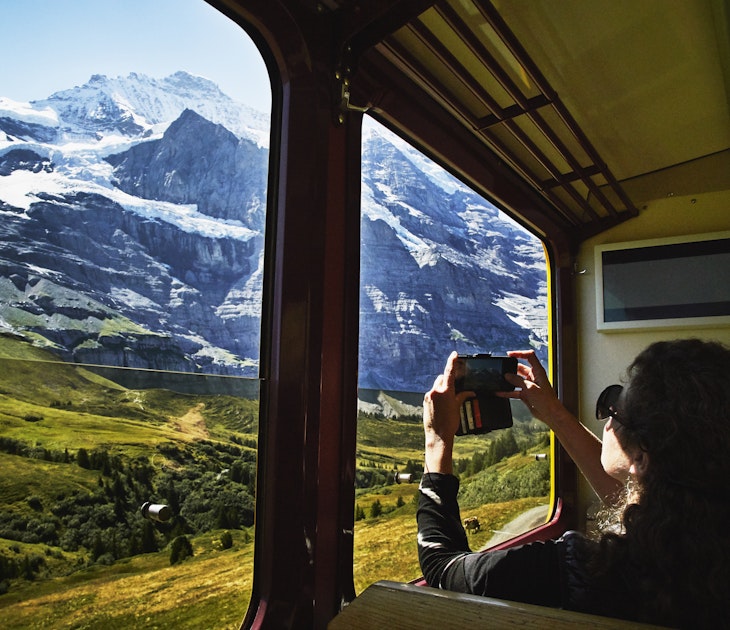
Sustainable Travel
Jan 16, 2024 • 8 min read
Rolling forests, saw-toothed mountains, bridges spanning river gorges - these European train rides put on quite a show.

Dec 25, 2023 • 11 min read

Dec 19, 2023 • 6 min read

Nov 1, 2023 • 4 min read

Oct 19, 2023 • 8 min read

Oct 6, 2023 • 8 min read

Jun 26, 2023 • 5 min read

Jun 18, 2023 • 6 min read

May 19, 2023 • 12 min read
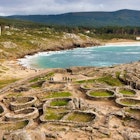
May 5, 2023 • 7 min read

IMAGES
VIDEO
COMMENTS
Toll Costs: €0. Fuel Costs: €122. Driving to Spain from UK avoiding tolls is very possible. You will still travel down the western side of the country, with the route relying heavily on the A28, N10 and A63 toll free roads. Make sure to set your sat nav to avoid tolls.
The Quickest Route (Calais - Rouen - Bordeaux - San Sebastian) If you're looking for the most direct route from A to B, the drive to Spain can be done in less than a day. However, that's not to say that you can't stop off along the way and make the most of some great towns and cities. From Calais, take the A16/A28 to Rouen, the ...
Toll costs for driving from the UK to Spain (as of May 2020): My last trip driving from the UK to Spain was in July 2019, so I gathered the exact toll road costs for the journey. These amounts are for Malaga - San Sebastian - Bordeaux - Cherbourg - Poole and Portsmouth - Santander - Madrid - Malaga routes.
9. Road trip around Mallorca. 5 days, 175 miles. Lazy. 10. The full circle - A complete road trip around Spain. 35 days, 2,800 miles. Challenging. Whether you want a relaxing drive along the coast or drive around the entire country of Spain, here are the 10 amazing options for a Spain road trip to pick from.
4. Work out the best route. All routes to Spain involve a trip across the English Channel to Calais, you can take the ferry from Dover which is about 1hour 30 minutes or use the Channel Tunnel, which is around 35 minutes, but costs more. There are many ways to drive through France and we list a few options below.
From Calais to Malaga is approximately 18 hours. Calais to Alicante driving time of around 16 hours. Calais to Barcelona around 12 hours driving time. Cherbourg to Malaga is around 17 and half hours driving. Roscoff to Alicante takes around 15 hours to drive. Bilbao to Malaga takes around 8 and half hours of driving.
Roads & cross-channel connections from the UK to Spain. European Route E15 is the main road from Britain to Spain - it stretches all the way from Inverness in Scotland down to Algeciras in Spain and on the UK side, features roads you'll be familiar with like the M90, A9, A720, M8, A1, A1 (M), A282, M25, and M20.
Spain Road Trip Itinerary. Day 1: Fly from London to Malaga and pick up rental car. Day 2 - 4: Malaga and some gems of Andalucia. Day 5: Drive to Valencia via Granada. Day 6 - 7: Explore Valencia and get bruised by tomatoes in Bunol and coloured by red wine in Valencia. Day 8: Drive to Figueres.
Fuel in Spain is usually cheaper than both the UK and France, and the cost of tolls is much less pricey. So travelling in Spain is easy. Here are some tips for driving in Spain: You must always carry your driving license when driving. You will need a green card to prove that you and your vehicle are ensured.
The final stretch of your drive to Spain from the UK covers 362km, taking about four hours. From the border you're only a couple of hours from Barcelona. Continue south on the A75/E11 until you reach the A9, where you turn right to carry on south. The A9 takes you to the border with Spain (you're now on the E15 route).
2. Monestir de Montserrat. One of the most epic drives Catalonia has to offer, this charming mountain route - the Montserrat Mountain Road - from Barcelona to the Montserrat mountain, has spectacular cinematic views to offer. Expect twists and turns, making this a more challenging road, perfect for a day trip.
The Ultimate Spain Road Trip Itineraries: Routes, Sights, Guides, Maps And More. Last Updated: January 2, 2024. From San Sebastian's world-famous food scene and the attractions of Barcelona, to the incredible museums of Madrid, history of Granada and beaches on the Costa del Sol, this Spain road trip has it all!
This Southern Spain 5 day road trip is perfect if you are traveling out of the Summer season and still want some warmth. Approx 590km and 7 hours total driving time. Fly to Seville, malaga, Gibraltar, marbella. Day 1: fly to Seville. Day 2: Malaga. Day 3: Gibraltar, stopping in Marbella on the way. Day 4: Cadiz.
Northern Spain Road Trip Itinerary. Road Trip Through Tenerife (Canary Islands) Road Trip Through Catalonia (Catalunya) Road Trip Through Central Spain. Driving the Balearic Islands. Road Trip Along Spain's East Mediterranean Coast. Road Trip Across Galicia. Road Trip Around the Basque Country.
Road-trip 2 - January 2017, Bilbao to Dénia. After Christmas in UK this second road-trip was the infamous ' Storm in Denia ' moment. If you haven't seen Myles two weather report videos, then they're worth a watch. Weather Report from Spain 1 and 2. This was a speedy trip south from Bilbao to Dénia, our favourite 'go to' place ...
Prepare for your trip in advance with our useful information on entrance requirements, money, safety, healthcare, opening times, etc. How to get to Spain Find information on our airports and cruise ports and discover what the flight times are from different points across the world.
Once you've explored the rich culture of Toledo, you can begin the 3hr 30 minute drive to Cordoba. This is your first stop in Andalusia, the beautiful region of Southern Spain that should be included in every family road trip itinerary through Spain. Cordoba is littered with great historical monuments like the Mezquita, which with its mixture ...
The cheapest way to get from Uk to Spain costs only €425, and the quickest way takes just 31¼ hours. ... The distance between Uk and Spain is 7218 km. The road distance is 8171.6 km. ... Find all the transport options for your trip from Uk to Spain right here. Rome2Rio displays up to date schedules, route maps, journey times and estimated ...
Travel to Spain From the UK. When it comes to travelling from the UK to Spain, there are several options available to suit different preferences and budgets. Whether you're looking for a quick flight, a scenic road trip, or a leisurely ferry ride, Spain is easily accessible from the UK.
July 26, 2022. Uncategorized. Driving a motorhome from the UK to Spain is doable and takes 1-2 days, depending on the route. The shortest road route involves driving through France, which takes a day and costs £270 for a one-way trip. A one-way ferry trip for two adults and a motorhome will cost you between £400 and £700.
If you're towing with your motorhome or campervan in Spain and the overall train length is 12m or more you must have at least one yellow reflector on the rear, sized 130cm x 25cm (or two sized 50cm x 25cm). Red/ white warning board sign - for bike racks or anything overhanging the end of the motorhome or campervan.
Britons have to now show proof that they have at least €113.40 (£97) per person per day during their holiday stay. This means that a family of four staying in Spain for a week have to show they ...
Using the train in Spain can be quicker and cheaper than flying. For example, a flight from Madrid to Barcelona takes 1¼ hours compared with 2½ hours by high-speed rail. But once you factor in security checks, out-of-city airport transfers, and runway taxi times, the overall journey length by plane becomes longer.